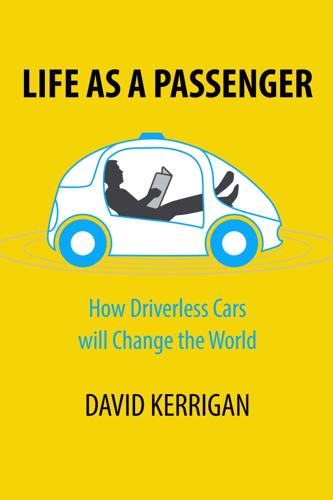
Life as a Passenger: How Driverless Cars Will Change the World
by
David Kerrigan
Published 18 Jun 2017
And while the machine learning abilities that underpin driverless car decision making will continue to improve, waiting for a completely demonstrably fool-proof system would likely delay the introduction of driverless cars by many years. To help deliver the benefits that driverless cars can bring in the majority of everyday driving scenarios, we need a solution to help the driverless cars make decisions in unfamiliar conditions. Just as we insist that learner drivers are accompanied by an experienced driver, companies are working to create similar backup advisors for driverless cars. In the event that a driverless car encounters a situation it cannot safely navigate, it will be able to call on the services of a remote contact centre for support.
…
While humans are quite adept at identifying traffic lights and their state (if not always excellent at acting legally in accordance with their state), computers can struggle to pick out traffic lights and discern their colour, especially in difficult conditions, e.g. strong sunshine behind the light. Driverless car makers have put a lot of effort into solving this seemingly simple problem. There is also the risk of a computer being confused by signs like this, which they could mistake for an actual traffic signal: Could a driverless car mistake these signs for a traffic signal? However, driverless cars are being taught through deep learning to identify this and similar signs so as not to confuse them with traffic lights. The best solution to date is for driverless car manufacturers to create a prior map of traffic signals, enabling the driverless cars and its perception systems to anticipate the locations of traffic lights and improve detection of the light state.[270] Thus the vehicle can predict when it should expect traffic lights and concentrate its search.
…
Volvo[280] have already announced that the first 100 vehicles they will make available for trialists will not be visibly marked as driverless cars. This is to avoid situations where human motorists might slam on their brakes or drive erratically to force the driverless cars into submission. As driving regulations are updated, it is likely they will be amended to cater for these challenges and make the intentional interference with the progress of a driverless car an offense - one which will of course be captured in HD by the driverless car’s cameras. AV Phone Home Given the unpredictable nature of scenarios that a driverless car could ultimately find itself in, it is likely to be virtually impossible to pre-programme a suitable course of action for every instance.

Driverless: Intelligent Cars and the Road Ahead
by
Hod Lipson
and
Melba Kurman
Published 22 Sep 2016
Insurance companies already quantify the potential costs of many aspects of our lives. Driverless cars need to have a nearly perfect driving record to be safe enough. The benefits of driverless cars will begin as soon as they have a safety record that exceeds the average human driver. Waiting until driverless cars have a flawless safety record will unnecessarily maintain our society’s high death toll from car accidents. Driverless cars should be made legal not when they’re perfect, but when they’re twice as safe as an average human driver. The adoption of driverless cars will be abrupt. Some people like to ask for the “year” when driverless cars will take over the roads.
…
We predict that Google’s first sales of driverless cars will be not to consumers for everyday driving, but more likely to corporations and some municipalities as a niche transportation solution. At some point there will be a quiet crossing over, and the autonomous vehicles will venture outside their enclosed territories and onto city highways. Another aspect of the transition to driverless cars is location, that is, where the first driverless cars will come into everyday use. Some countries will adopt driverless cars sooner than others. Within countries, some states or provinces will agree to legalize driverless cars before others.
…
Regulators must resist the temptation to wait until driverless cars are perfect drivers, since that day may never come. Instead, federal regulators need to set a practical new goal line for safety: as we discussed earlier, driverless-car technology should be considered viable when a driverless car drives twice as safely as a human. Another way this hypothetical new agency, the AVA, could help would be to generate public and corporate excitement about driverless cars. To ensure that more minds than just those employed by Google, Apple, and car companies are thinking about driverless cars, the AVA should earmark funding for regular competitions where teams from industry and universities compete to create better solutions to the hard technical problems.
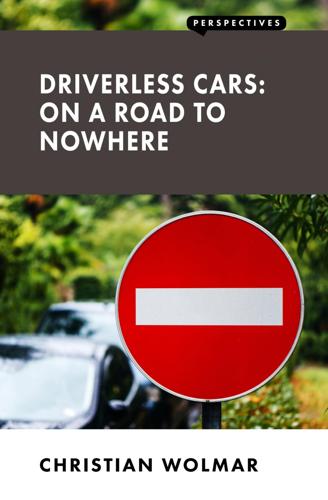
Driverless Cars: On a Road to Nowhere
by
Christian Wolmar
Published 18 Jan 2018
There was a tone of inevitability in all this coverage that soon began to permeate through to the politicians. Phrases such as ‘the upcoming driverless car revolution’ and ‘the disappearance of the privately owned car’ started to pepper their speeches. Some even assumed that the advent of driverless cars was imminent and that transport policies therefore needed to be adapted urgently. The driverless car revolution was upon us, and those who ignored it were simply doing the three monkeys trick. They were Luddites, losers. Had not the PC, the smartphone and the internet already changed our lives? ‘Smart cities’ were all the rage and driverless cars were one of their obvious key building blocks.
…
The implication of his statement is that driverless cars would, by contrast, have no accidents: When Google started working on self-driving vehicles over seven years ago, our goal was to transform mobility by making it safer, easier, and more enjoyable to get around. What drives our team is the potential that this technology has to make our roads safer.9 Figure 1. Google’s driverless car. (Photo by Grendelkhan. Note: full photo credits for all figures appear on pages 119 and 120.) The other carrot is to increase access to vehicles for people with disabilities, like the blind girl in the Shanghai 17 Driverless Cars: On a Road to Nowhere film.
…
That junction could be dealt with now, with the right transport planning and regulatory policies, potentially saving lives. Despite all the hype, despite the millions of words written about driverless cars, despite the billions of dollars being invested by the auto manufacturers and tech companies, and despite all the tests and trials across the world, nothing is really known about how this will pan out. Driverless cars could remain as purely theoretical 109 Driverless Cars: On a Road to Nowhere as teleportation or personal jetpacks. The wise Lords on the Science and Technology Committee summed it up admirably: There is little hard evidence to substantiate the potential benefits and disadvantages of CAV because most of them are at a prototype or testing stage.

The Long History of the Future: Why Tomorrow's Technology Still Isn't Here
by
Nicole Kobie
Published 3 Jul 2024
Uber has since ended its research into driverless cars, selling its technology to driverless trucking startup Aurora, led by ex-Waymo engineer Chris Urmson – though Uber also kept its fingers in the pie with a $400 million investment. * * * Here’s where we get into semantics: does a driverless car have a driver? I have been in truly driverless cars – no one at the wheel – and I’ve been in those with safety drivers just in case, or to take the wheel for parts of the route the vehicle couldn’t manage, or wasn’t allowed to by law. But in all cases, the driverless cars (and buses) are operated in controlled, limited conditions.
…
‘You do not need to use your horn (with which your car is equipped for local roads) on this motorway because you never have to pass a car,’ he wrote. Of course, all Bel Geddes did was imagine driverless cars, as sci-fi films have done many times since. Bel Geddes didn’t build a driverless car – though he very much thought it was not only possible but also practical. And he was right. Though interrupted by the war, the daydreaming ideas on show at Futurama were put into practical development, and in 1957 the first driverless car was tested just outside Lincoln, Nebraska. After the war ended, Bel Geddes’ idea of removing human mistakes from motorways via automotive automation was revived by General Motors, alongside staff from the labs at the Radio Corporation of America (RCA) and the Nebraska Department of Roads.
…
* * * Perhaps the best way to understand how driverless cars work is to see what happens when they fail. The most significant failure to date is unquestionably the crash of Uber’s driverless car in March 2018, killing Elaine Herzberg in Tempe, Arizona. The 49-year-old woman was the first pedestrian to be killed by a self-driving car, sparking an investigation by the American National Transport Safety Board (NTSB).23 Herzberg was struck by the car while walking across the road. She wasn’t using a designated pedestrian crossing and it was dark out, neither of which should prevent a driverless car from spotting her, as radar and lidar see well without ambient light.

The Road to Conscious Machines
by
Michael Wooldridge
Published 2 Nov 2018
Although there have been a range of experiments in this field since the 1940s, it is only since the emergence of microprocessor technologies in the 1970s that they really began to be feasible. But the challenge of driverless cars is immense: and the fundamental problem is perception. If you could find a way for a car to know precisely where it was and what was around it, then you would have solved the problem of driverless cars. The solution to this problem was to be modern machine learning techniques: without them, driverless cars would not be possible. The PROMETHEUS project, funded by the pan-governmental EUREKA research funding organization in Europe, is widely seen as a forerunner of today’s driverless car technology. PROMETHEUS, which ran from 1987 to 1995, led to a demonstration in 1995, in which a car drove itself from Munich in Germany to Odense in Denmark and back.
…
Well, the first conclusion we can draw, from the relatively poor performance of automobile giants like BMW, Mercedes and Volkswagen, is that a historical track record in the automotive industry is not the key requirement for success in driverless car technology. On reflection, this should come as no surprise: the key to driverless cars is not the internal combustion engine, but software – AI software. No surprise, then, that the US automobile giant General Motors acquired driverless car company Cruise Automation for an undisclosed (but obviously very large) sum in 2016, while Ford invested one billion dollars in self-driving start-up company Argo AI. Both companies made public, very ambitious claims about the roll-out of commercial driverless cars: Ford predicted they would have a ‘fully autonomous vehicle in commercial operation’ by 2021.10 Of course, we don’t know the precise criteria that companies use to decide when a disengagement occurs.
…
Some of these guidelines are in clear contrast to what some of the participants in the Moral Machines experiments indicated that the software should do: for example, the rule forbidding any discrimination based on personal characteristics is in sharp contrast to an internationally held preference revealed by the Moral Machine for saving young people. Imagine the outrage, then, if a driverless car followed the German guidelines and chose not to make a distinction, and as a result a child was killed rather than an elderly terminal cancer patient. My example is tasteless – apologies for that – but you get the point. Intriguing and ingenious though it undoubtedly is, the Moral Machine experiment and the Trolley Problem upon which it is based do not, I think, have much of value to tell us about AI software for driverless cars. I don’t believe that the driverless cars we are likely to encounter in the coming decades will do ethical reasoning of this type.
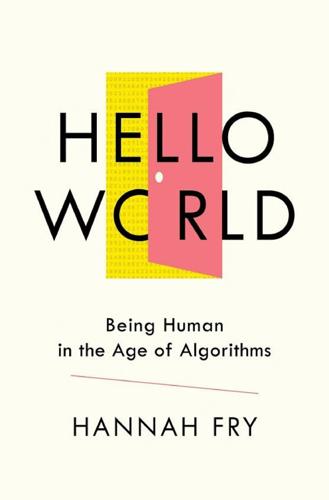
Hello World: Being Human in the Age of Algorithms
by
Hannah Fry
Published 17 Sep 2018
In late 2017, Philip Hammond, the British Chancellor of the Exchequer, announced the government’s intention to have fully driverless cars – without a safety attendant on board – on British roads by 2021. Daimler has promised driverless cars by 2020,15 Ford by 2021,16 and other manufacturers have made their own, similar forecasts. Talk in the press has moved on from questioning whether driverless cars will happen to addressing the challenges we’ll face when they do. ‘Should your driverless car hit a pedestrian to save your life?’ asked the New York Times in June 2016;17 and, in November 2017: ‘What happens to roadkill or traffic tickets when our vehicles are in control?’
…
‘ambiguous images 211n13’ 23andMe 108–9 profit 109 promises of anonymity 109 sale of data 109 volume of customers 110 52Metro 177 abnormalities 84, 87, 95 acute kidney injuries 104 Acxiom 31 Adele 193 advertising 33 online adverts 33–5 exploitative potential 35 inferences 35 personality traits and 40–1 political 39–43 targeted 41 AF447 (flight) 131–3, 137 Afigbo, Chukwuemeka 2 AI (artificial intelligence) 16–19 algorithms 58, 86 omnipotence 13 threat of 12 see also DeepMind AI Music 192 Air France 131–3 Airbnb, random forests 59 Airbus A330 132–3 algebra 8 algorithmic art 194 algorithmic regulating body 70 algorithms aversion 23 Alhambra 156 Alton Towers 20–1 ALVINN (Autonomous Land Vehicle In a Neural Network) 118–19 Alzheimer’s disease 90–1, 92 Amazon 178 recommendation engine 9 ambiguous images 211n13 American Civil Liberties Union (ACLU) 17 Ancestry.com 110 anchoring effect 73 Anthropometric Laboratory 107–8 antibiotics 111 AOL accounts 2 Apple 47 Face ID system 165–6 arithmetic 8 art 175–95 algorithms 184, 188–9 similarity 187 books 178 films 180–4 popularity 183–4 judging the aesthetic value of 184 machines and 194 meaning of 194 measuring beauty 184–5 music 176–80 piano experiment 188–90 popularity 177, 178, 179 quality 179, 180 quantifying 184–8 social proof 177–8, 179 artifacts, power of 1-2 artificial intelligence (AI) see AI (artificial intelligence) association algorithms 9 asthma 101–2 identifying warning signs 102 preventable deaths 102 Audi slow-moving traffic 136 traffic jam pilot 136 authority of algorithms 16, 198, 199, 201 misuse of 200 automation aircraft 131–3 hidden dangers 133–4 ironies of 133–7 reduction in human ability 134, 137 see also driverless cars Autonomous Emergency Braking system 139 autonomy 129, 130 full 127, 130, 134, 138 autopilot systems A330 132 driverless cars 134 pilot training 134 sloppy 137 Tesla 134, 135, 138 bail comparing algorithms to human judges 59–61 contrasting predictions 60 success of algorithms 60–1 high-risk scores 70 Bainbridge, Lisanne 133–4, 135, 138 balance 112 Banksy 147, 185 Baril, David 171–2 Barstow 113 Bartlett, Jamie 44 Barwell, Clive 145–7 Bayes’ theorem 121–4, 225n30 driverless cars 124 red ball experiment 123–4 simultaneous hypotheses 122–3 Bayes, Thomas 123–4 Bayesian inference 99 beauty 184–5 Beck, Andy 82, 95 Bell, Joshua 185–6 Berk, Richard 61–2, 64 bias of judges 70–1, 75 in machines 65–71 societal and cultural 71 biometric measurements 108 blind faith 14–16, 18 Bonin, Pierre-Cédric ‘company baby‘ 131–3 books 178 boost effect 151, 152 Bratton, Bill 148–50, 152 breast cancer aggressive screening 94 detecting abnormalities 84, 87, 95 diagnoses 82–4 mammogram screenings 94, 96 over-diagnosis and over-treatment 94–5 research on corpses 92–3 ‘in situ’ cancer cells 93 screening algorithms for 87 tumours, unwittingly carrying 93 bridges (route to Jones Beach) racist 1 unusual features 1 Brixton fighting 49 looting and violence 49–50 Brooks, Christopher Drew 64, 77 Brown, Joshua 135 browser history see internet browsing history buffer zone 144 Burgess, Ernest W. 55–6 burglary 150–1 the boost 151, 152 connections with earthquakes 152 the flag 150–1, 152 Caixin Media 45 calculations 8 calculus 8 Caldicott, Dame Fiona 223n48 Cambridge Analytica 39 advertising 42 fake news 42 personality profiles 41–2 techniques 41–2 whistleblowers 42 CAMELYON16 competition 88, 89 cameras 119–20 cancer benign 94 detection 88–9 and the immune system 93 malignant 94 ‘in situ’ 93, 94 uncertainty of tumours 93–4 see also breast cancer cancer diagnoses study 79–80 Car and Driver magazine 130–1 Carnegie 117 Carnegie Mellon University 115 cars 113–40 driverless see driverless cars see also DARPA (US Defence Advanced Research Projects Agency) categories of algorithms association 9 classification 9 filtering 9–10 prioritization 8 Centaur Chess 202 Charts of the Future 148–50 chauffeur mode 139 chess 5-7 Chicago Police Department 158 China 168 citizen scoring system 45–6 breaking trust 46 punishments 46 Sesame Credit 45–6, 168 smallpox inoculation 81 citizen scoring system 45–6 Citroen DS19 116, 116–17 Citymapper 23 classification algorithms 9 Clinical vs Statistical Prediction (Meehl) 21–2 Clinton Foundation 42 Clubcard (Tesco) 26 Cohen’s Kappa 215n12 cold cases 172 Cold War 18 Colgan, Steyve 155 Commodore 64 ix COMPAS algorithm 63, 64 ProPublica analysis accuracy of scores 65 false positives 66 mistakes 65–8 racial groups 65–6 secrecy of 69 CompStat 149 computational statistics 12 computer code 8 computer intelligence 13 see also AI (artificial intelligence) computer science 8 computing power 5 considered thought 72 cookies 34 Cope, David 189, 190–1, 193 cops on the dots 155–6 Corelogic 31 counter-intuition 122 creativity, human 192–3 Creemers, Rogier 46 creepy line 28, 30, 39 crime 141–73 algorithmic regulation 173 boost effect 151, 152 burglary 150–1 cops on the dots 155–6 geographical patterns 142–3 gun 158 hotspots 148, 149, 150–1, 155 HunchLab algorithm 157–8 New York City subway 147–50 predictability of 144 PredPol algorithm 152–7, 158 proximity of offenders’ homes 144 recognizable patterns 143–4 retail 170 Strategic Subject List 158 target hardening 154–5 see also facial recognition crime data 143–4 Crimewatch programme 142 criminals buffer zone 144 distance decay 144 knowledge of local geographic area 144 serial offenders 144, 145 customers data profiles 32 inferred data 32–4 insurance data 30–1 shopping habits 28, 29, 31 supermarket data 26–8 superstore data 28–31 cyclists 129 Daimler 115, 130 DARPA (US Defence Advanced Research Projects Agency) driverless cars 113–16 investment in 113 Grand Challenge (2004) 113–14, 117 course 114 diversity of vehicles 114 GPS coordinates 114 problems 114–15 top-scoring vehicle 115 vehicles’ failure to finish 115 Grand Challenge (2005) 115 targeting of military vehicles 113–14 data 25–47 exchange of 25, 26, 44–5 dangers of 45 healthcare 105 insurance 30–1 internet browsing history 36–7, 36–8 internet giants 36 manipulation and 39–44 medical records 102–7 benefits of algorithms 106 DeepMind 104–5 disconnected 102–3 misuse of data 106 privacy 105–7 patterns in 79–81, 108 personal 108 regulation of America 46–7 Europe 46–7 global trend 47 sale of 36–7 Sesame Credit 45–6, 168 shopping habits 28, 29, 31 supermarkets and 26–8 superstores and 28–31 data brokers 31–9 benefits provided by 32 Cambridge Analytica 39–42 data profiles 32 inferred data 32–4, 35 murky practices of 47 online adverts 33–5 rich and detailed datasets 103 Sesame Credit 45–6 unregulated 36 in America 36 dating algorithms 9 Davies, Toby 156, 157 decision trees 56–8 Deep Blue 5-7, 8 deep learning 86 DeepMind access to full medical histories 104–5 consent ignored 105 outrage 104 contract with Royal Free NHS Trust 104 dementia 90–2 Dewes, Andreas 36–7 Dhami, Mandeep 75, 76 diabetic retinopathy 96 Diaconis, Pesri 124 diagnostic machines 98–101, 110–11 differential diagnosis 99 discrimination 71 disease Alzheimer’s disease 90–1, 92 diabetic retinopathy 96 diagnosing 59, 99, 100 disease (continued) hereditary causes 108 Hippocrates’s understanding of 80 Huntington’s disease 110 motor neurone disease 100 pre-modern medicine 80 see also breast cancer distance decay 144 DNA (deoxyribonucleic acid) 106, 109 testing 164–5 doctors 81 unique skills of 81–2 Dodds, Peter 176–7 doppelgängers 161–3, 164, 169 Douglas, Neil 162–3 driver-assistance technology 131 driverless cars 113–40 advantages 137 algorithms and 117 Bayes’ red ball analogy 123–4 ALVINN (Autonomous Land Vehicle In a Neural Network) 118–19 autonomy 129, 130 full 127, 130, 134, 138 Bayes’ theorem 121–4 breaking the rules of the road 128 bullying by people 129 cameras and 117–18 conditions for 129 cyclists and 129 dealing with people 128–9 difficulties of building 117–18, 127–8 early technology 116–17 framing of technology 138 inevitability of errors 140 measurement 119, 120 neural networks 117–18 potential issues 116 pre-decided go-zones 130 sci-fi era 116 simulations 136–7 speed and direction 117 support for drivers 139 trolley problem 125–6 Uber 135 Waymo 129–30 driverless technology 131 Dubois, Captain 133, 137 Duggan, Mark 49 Dunn, Edwina 26 early warning systems 18 earthquakes 151–2 eBureau 31 Eckert, Svea 36–7 empathy 81–2 ensembles 58 Eppink, Richard 17, 18 Epstein, Robert 14–15 equations 8 Equivant (formerly Northpointe) 69, 217n38 errors in algorithms 18–19, 61–2, 76, 159–60, 197–9, 200–201 false negatives 62, 87, 88 false positives 62, 66, 87, 88 Eureka Prometheus Project 117 expectant mothers 28–9 expectations 7 Experiments in Musical Intelligence (EMI) 189–91, 193 Face ID (Apple) 165–6 Facebook 2, 9, 36, 40 filtering 10 Likes 39–40 news feeds experiment 42–3 personality scores 39 privacy issues 25 severing ties with data brokers 47 FaceFirst 170, 171 FaceNet (Google) 167, 169 facial recognition accuracy 171 falling 168 increasing 169 algorithms 160–3, 165, 201–2 2D images 166–7 3D model of face 165–6 Face ID (Apple) 165–6 FaceFirst 170 FaceNet (Google) 167, 169 measurements 163 MegaFace 168–9 statistical approach 166–7 Tencent YouTu Lab 169 in China 168 cold cases 172 David Baril incident 171–2 differences from DNA testing 164–5 doppelgängers 161–3, 164, 169 gambling addicts 169–70 identical looks 162–3, 164, 165 misidentification 168 neural networks 166–7 NYPD statistics 172 passport officers 161, 164 police databases of facial images 168 resemblance 164, 165 shoplifters 170 pros and cons of technology 170–1 software 160 trade-off 171–3 Youssef Zaghba incident 172 fairness 66–8, 201 tweaking 70 fake news 42 false negatives 62, 87, 88 false positives 62, 66, 87, 88 FBI (Federal Bureau of Investigation) 168 Federal Communications Commission (FCC) 36 Federal Trade Commission 47 feedback loops 156–7 films 180–4 algorithms for 183 edits 182–3 IMDb website 181–2 investment in 180 John Carter (film) 180 novelty and 182 popularity 183–4 predicting success 180–1 Rotten Tomatoes website 181 study 181–2 keywords 181–2 filtering algorithms 9–10 Financial Times 116 fingerprinting 145, 171 Firebird II 116 Firefox 47 Foothill 156 Ford 115, 130 forecasts, decision trees 57–8 free technology 44 Fuchs, Thomas 101 Galton, Francis 107–8 gambling addicts 169–70 GDPR (General Data Protection Regulation) 46 General Motors 116 genetic algorithms 191–2 genetic testing 108, 110 genome, human 108, 110 geographical patterns 142–3 geoprofiling 147 algorithm 144 Germany facial recognition algorithms 161 linking of healthcare records 103 Goldman, William 181, 184 Google 14–15, 36 creepy line 28, 30, 39 data security record 105 FaceNet algorithm 167, 169 high-paying executive jobs 35 see also DeepMind Google Brain 96 Google Chrome plugins 36–7 Google Images 69 Google Maps 120 Google Search 8 Google Translate 38 GPS 3, 13–14, 114 potential errors 120 guardian mode 139 Guerry, André-Michel 143–4 gun crime 158 Hamm, John 99 Hammond, Philip 115 Harkness, Timandra 105–6 Harvard researchers experiment (2013) 88–9 healthcare common goal 111–12 exhibition (1884) 107 linking of medical records 102–3 sparse and disconnected dataset 103 healthcare data 105 Hinton, Geoffrey 86 Hippocrates 80 Hofstadter, Douglas 189–90, 194 home cooks 30–1 homosexuality 22 hotspots, crime 148, 149, 150–1, 155 Hugo, Christoph von 124–5 human characteristics, study of 107 human genome 108, 110 human intuition 71–4, 77, 122 humans and algorithms opposite skills to 139 prediction 22, 59–61, 62–5 struggle between 20–4 understanding the human mind 6 domination by machines 5-6 vs machines 59–61, 62–4 power of veto 19 PredPol (PREDictive POLicing) 153–4 strengths of 139 weaknesses of 139 Humby, Clive 26, 27, 28 Hume, David 184–5 HunchLab 157–8 Huntington’s disease 110 IBM 97–8 see also Deep Blue Ibrahim, Rahinah 197–8 Idaho Department of Health and Welfare budget tool 16 arbitrary numbers 16–17 bugs and errors 17 Excel spreadsheet 17 legally unconstitutional 17 naive trust 17–18 random results 17 cuts to Medicaid assistance 16–17 Medicaid team 17 secrecy of software 17 Illinois prisons 55, 56 image recognition 11, 84–7, 211n13 inferred data 32–4, 35 personality traits 40 Innocence Project 164 Instagram 36 insurance 30–1 genetic tests for Huntington’s disease 110 life insurance stipulations 109 unavailability for obese patients 106 intelligence tracking prevention 47 internet browsing history 36–8 anonymous 36, 37 de-anonymizing 37–8 personal identifiers 37–8 sale of 36–7 Internet Movie Database (IMDb) 181–2 intuition see human intuition jay-walking 129 Jemaah Islam 198 Jemaah Islamiyah 198 Jennings, Ken 97–8 Jeopardy!
…
They would openly invite any interested people across the country to design their own driverless cars and race them against each other on a long-distance track, with a prize of $1 million for the winner.6 It would be the first event of its kind in the world, and a quick and cheap way to give DARPA a head start in pursuing their goal. The course was laid out over 142 miles, and DARPA hadn’t made it easy. There were steep climbs, boulders, dips, gullies, rough terrain and the odd cactus to contend with. The driverless cars would have to navigate dirt tracks that were sometimes only a few feet wide. Two hours before the start, the organizers gave each team a CD of GPS coordinates.7 These represented two thousand waypoints that were sprinkled along the route like breadcrumbs – just enough to give the cars a rough sense of where to go, but not enough to help them navigate the obstacles that lay ahead.
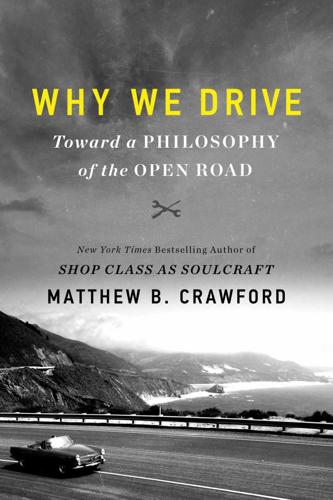
Why We Drive: Toward a Philosophy of the Open Road
by
Matthew B. Crawford
Published 8 Jun 2020
President Barack Obama himself wrote an op-ed on behalf of driverless cars in the Pittsburgh Post-Gazette the same day. President Donald Trump affirmed these priorities early in his administration.1 Driverless cars will finally solve the problem of moving people around with maximum efficiency, by ceding human control to impersonal algorithms. They promise to bring a messy, dangerous domain of life under control at last. Traffic jams will likely become a thing of the past, and accidents will be greatly reduced. So we are told, at any rate. In this we can detect a familiar pattern. Driverless cars are one instance of a wider shift in our relationship to the physical world, in which the demands of competence give way to a promise of safety and convenience.
…
Notes INTRODUCTION: DRIVING AS A HUMANISM 1.Uber’s then chief executive Travis Kalanick was named to the president’s Strategic and Policy Forum, and Trump selected Elaine Chao for transportation secretary. The driverless car industry is “salivating over Elaine Chao’s light touch when it comes to regulations and her vocal support for the ride-sharing economy,” according to the Hill. Paul Brubaker, a spokesperson for the industry, said, “She has a keen understanding that technology presents a great opportunity to . . . create new mobility paradigms.” Melanie Zanona, “Driverless Car Industry Embraces Trump’s Transportation Pick,” Hill, December 4, 2016, http://thehill.com/policy/transportation/308590-driverless-car-industry-embraces-trumps-transportation-pick. 2.See Neal E.
…
For self-driving cars to realize their full potential to reduce traffic and accidents, we can’t have rogue dissidents bypassing the system of coordination that they make possible.6 Their inherent logic presses toward their becoming mandatory—if not by fiat of the state, then by the prohibitive calculations of insurance companies, who will have to distribute risk among fewer human drivers. Or by the portioning out of scarce road surface, with preference given to driverless cars. At bottom, the all-colonizing character of driverless cars derives from the fact that robots are a very awkward fit with human drivers, and are likely to remain so. The prospects for these two kinds of intelligence to share the road gracefully are quite dim, as we will learn from the literature on “human factors” in automation.
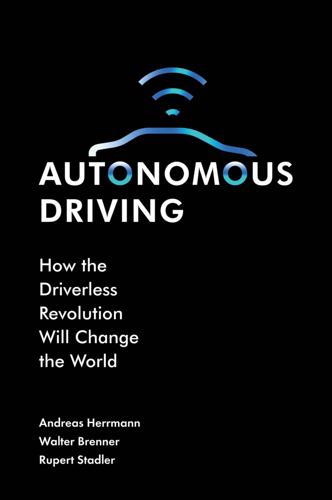
Autonomous Driving: How the Driverless Revolution Will Change the World
by
Andreas Herrmann
,
Walter Brenner
and
Rupert Stadler
Published 25 Mar 2018
Furthermore, self-driving cars are designed to improve the flow of traffic and reduce the number and duration of traffic jams. In the eyes of commuters around the world, this is a particularly critical argument for driverless cars, especially in megacities [64]. It is also linked to the hope of reducing fuel consumption and emissions of carbon dioxide and particulate matter. Amidst all of the euphoria about driverless cars, study respondents repeatedly asked about an issue touched upon in Chapter 7: What will autonomous cars do to the pleasure of driving? All over the world, there are plenty of people who actively enjoy driving regardless of the increasing Customers’ Expectations 205 Table 19.1.
…
Mobility, freedom and independence, as well as social status are all advantages that many drivers associate with their cars [83]. Although the automobile gives people control and power over a machine and the feeling of freedom, movement, pride and pleasure the desire for autonomous vehicles is not something new [116]. Driverless cars have been described in some detail for several decades now: at first as science fiction and later in scientific publications. In some fictional cases, the authors’ fantasies stretch to self-driving cars living lives of their own and taking on human traits by independently setting a route or even expressing emotions.
…
A similar argument is presented by Jen-Hsun Huang, CEO of Nvidia, who demands accuracy of 99.999999 per cent in the development of autonomous cars, whereby the last percentage point can only be achieved at very great expense. Toyota and Rand Corporation have published calculations of the number of miles self-driving cars have to be tested before they can be assessed as roadworthy because the algorithms required for driverless cars undergo self-learning in multiple road traffic situations. The more traffic situations these algorithms are exposed to, the better prepared they are to master a new situation. Designing this training process so that the accuracy demanded by Jen-Hsun Huang is obtained will be the crucial challenge in the development of autonomous vehicles.

Are Trams Socialist?: Why Britain Has No Transport Policy
by
Christian Wolmar
Published 19 May 2016
The twin revolution of driverless cars and common ownership may well prove to be a myth, or at least not deliverable in the sort of time frame that would allow today’s policymakers to consider it. The key issue is whether driverless cars will result in an increase or a reduction in mileage. If driverless cars live up to their promise, it appears logical that they would attract people out of public transport given their flexibility and the fact that they provide private space – all the current attractions of driving without the need to waste time controlling the damn thing. Driverless cars may well, then, replicate the failed transport policies of the past and exacerbate, rather than solve, the fundamental problem of the commons, i.e. the overuse of communal road space that is provided free.
…
In particular, they do not address the fundamental issue of the shortage of road space, nor of the environmental degradation caused by existing vehicles – not only pollution but the land use taken up by roads and parking. Even if cars used no energy and created no polluting gases, they would still be a blight on urban areas. The driverless car: a game changer? Source: photo by Grendelkhan (see page 115 for full details). In any case, despite the billions being invested in them, robot cars so far remain a highly experimental concept that is nowhere near coming to fruition in any meaningful way. While aspects of driverless cars such as cruise control and automatic parking have been introduced to today’s car fleet, the technology of allowing autonomous control of a car while the driver sits and reads her copy of the Financial Times or plays with his tablet is nowhere near ready.
…
Moreover, they have had a disproportionately high number of crashes, albeit minor ones. The cars in California had accumulated eleven such accidents by the middle of 2015, and in February 2016 a prang with a bus was actually caused by the ‘driverless car’. While the earlier incidents were not the fault of the automation, it may be that human drivers find the behaviour of driverless cars less predictable. Most of these accidents were rear-end shunts and the excessive caution of the robot cars is thought to have been a contributory cause. They slowed down or stopped in a situation that the driver behind did not perceive as being dangerous.
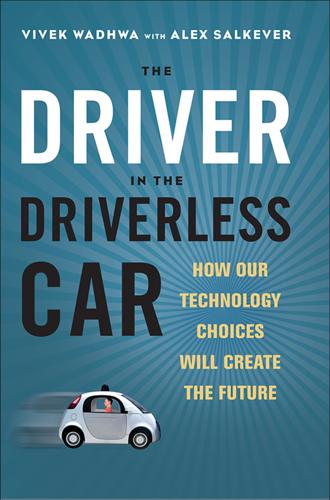
The Driver in the Driverless Car: How Our Technology Choices Will Create the Future
by
Vivek Wadhwa
and
Alex Salkever
Published 2 Apr 2017
THE DRIVER IN THE DRIVERLESS CAR VIVEK WADHWA WITH ALEX SALKEVER THE DRIVER IN THE DRIVERLESS CAR HOW OUR TECHNOLOGY CHOICES WILL CREATE THE FUTURE The Driver in the Driverless Car Copyright © 2017 by Vivek Wadhwa and Alex Salkever All rights reserved. No part of this publication may be reproduced, distributed, or transmitted in any form or by any means, including photocopying, recording, or other electronic or mechanical methods, without the prior written permission of the publisher, except in the case of brief quotations embodied in critical reviews and certain other noncommercial uses permitted by copyright law.
…
The automated vehicle takes the initiative and smoothly accelerates through the intersection. The passenger, I notice, appears preternaturally calm. I am both amazed and unsettled. I have heard from friends and colleagues that my reaction is not uncommon. A driverless car can challenge many assumptions about human superiority to machines. Though I live in Silicon Valley, the reality of a driverless car is one of the most startling manifestations of the future unknowns we all face in this age of rapid technology development. Learning to drive is a rite of passage for people in materially rich nations (and becoming so in the rest of the world): a symbol of freedom, of power, and of the agency of adulthood, a parable of how brains can overcome physical limitations to expand the boundaries of what is physically possible.
…
Pedestrians will stop worrying about getting hit by cars in intersections. Let me paint a picture of what streets will look like in an age of driverless cars. We will no longer need traffic lights: robot cars will synchronize wirelessly to time mass movements across city intersections and entries onto freeways or balletic dances around four-way stop signs. Having no human eyes behind the wheel will obviate much of the need for signaling and signage. When all the driverless cars are talking to each other, there will be no need for them to ever come to a complete halt and waste all their kinetic energy. So we will be able to forget traffic lights—and stop signs, yield signs, lighting on freeways, and dozens of other transportation-infrastructure elements catering to human drivers.

Street Smart: The Rise of Cities and the Fall of Cars
by
Samuel I. Schwartz
Published 17 Aug 2015
In some ways, the driverless car is a natural next step following all the technological and demographic changes that contributed to the original Millennial-led driving revolution that is the subject of this book, especially the information oversupply that made smartphones into a tool for transportation planning. Driverless cars are also, in their way, a new army on the battlefield over which the original war for right-of-way was fought nearly a century ago, in which roads were transformed from multipurpose commercial and social real estate into single-use arteries for automobile travel. Driverless cars are unarguably transportation anywhere, and anytime.
…
Driverless cars are unarguably transportation anywhere, and anytime. And, to the degree that driverless cars will be available to all levels of society, they’re transportation for everybody, too. They can even coexist, peacefully and profitably, with streetcars, commuter rail, bike paths, and subways. Still, it isn’t clear whether that new army of driverless cars is a Street Smart ally or opponent. There are any number of potential benefits to be found in a world dominated by driverless cars, including the possibility of turning nine out of every ten vehicles currently on the road into planters. As hardly needs underlining, the environmental and social benefits of taking 90 percent of existing cars off the streets are almost incalculably high.
…
The rosiest scenarios for autonomous driving, the ones that forecast a precipitous drop in the number of cars on the road, assume that most of those cars won’t be personal vehicles but part of fleets of what we might call A-taxis. This means that virtually all of them will be in motion, virtually all of the time. In cities, particularly the densest parts of cities, driverless cars may be a recipe for constant gridlock. However, even if driverless cars can, theoretically, reduce traffic delays because more of them can travel safely on a given stretch of road, this doesn’t mean that they will. One reason for the anticipated appeal of driverless cars is that they are expected to mimic travel by train: smooth enough for reading, or working, or Internet gaming. But in order to do this, they would have to also mimic the (slower) acceleration profile of trains—and when they do, according to a recent simulation by a group of researchers at University College London, they don’t improve travel times.
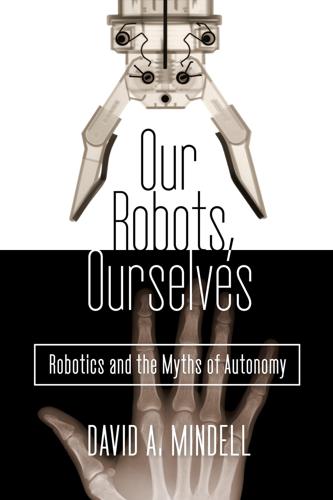
Our Robots, Ourselves: Robotics and the Myths of Autonomy
by
David A. Mindell
Published 12 Oct 2015
What have we learned from extreme environments that might shed light on possible futures for autonomous cars? We know that driverless cars will be susceptible to all of the problems that surround people’s use of automation in the environments we have examined—system failures, variability of skills among users, problems of attention management, the degradation of manual skills, and rising automation bias as people come to rely on automated systems. The most challenging problem for a driverless car will be the transfer of control between automation and the driver—what we might call “the Air France 447 problem.”
…
Google discovered that “people are lazy”: Tom Simonite, “Lazy Humans Shaped Google’s New Autonomous Car,” MIT Technology Review (May 30, 2014), http://www.technologyreview.com/news/527756/lazy-humans-shaped-googles-new-autonomous-car/. Will Knight, “Driverless Cars Are Further Away Than You Think,” MIT Technology Review (October 22, 2013), http://www.technologyreview.com/featuredstory/520431/driverless-cars-are-further-away-than-you-think/. “kick back, relax, and enjoy the ride”: Chris Urmson, “Just Press Go: Designing a Self-Driving Vehicle,” Google official blog, May 27, 2014, http://googleblog.blogspot.com/2014/05/just-press-go-designing-self-driving.html, accessed July 9, 2014.
…
Abbott, Kathy, 75–76 ABE (autonomous benthic explorer), 54, 191–96 acoustic communications and, 195–96 geological mapping by, 192–93, 194 loss of, 191–92 nature of autonomy of, 194–97 original mission of, 192 acoustic communications, and AUVs, 195–96 acoustic transponder networks, for navigation, 29 Afghanistan, 139 Airbus, 86–87 A-310, 82 Flight QF32, 71–72, 77 aircraft/aviation, 69–111, 226–29 adding unmanned automation technology to, 215–18 Automated Labor In-cockpit System (ALIAS), 217–18 drones (See drones) FAA survey of technology and pilot skill, 2013, 75–76 future of, 110–11 heads-up display (HUD) and, 88–108, 225 history of, 77–84 landings and, 84–88 optionally piloted aircraft (OPAs), 213–15 pilots role in flying modern aircraft, 69–72, 75–77 synthetic vision and, 108–9, 225 technological change and increasing automation, effect of, 72–75 unmanned helicopters, 210–13 Air France Flight 447, 1–2, 1–4, 69–70, 72, 73, 81, 162, 196 Akers, Thomas, 170, 171–72 Alaska Airlines, 92 Alvin (deep-sea submersible), 26–30, 33–34, 35, 45–51, 57, 59–66, 176, 194, 197, 225 ABE’s geological mapping and, 192–93, 194 acoustic navigation system of, 29 arguments and justifications for new, 63–65 hydrogen bomb recovery effort using, 27 Jason, differences between and rivalry with, 59–62 plate tectonics evidence gathered by, 28–29 Titanic wreck and, 45–51 Amber, 126 amphoras, 23–24 AMUVS (Advanced Maneuverable Underwater Vehicle System), 43–44 ANGUS (Acoustically Navigated Geologic Underwater Survey System), 30–34 Apollo missions, 225 Apollo 11, 159–61 Apollo 13, 72 Apollo 15, 178 Apollo 17, 177, 179 field geology and, 176–79 Argo (tethered sled), 35–36, 41–43 Armstrong, Neil, 77, 78, 159–61, 221 Asiana Airlines, 106–7 Flight 214, 72, 106 Association for Unmanned Vehicle Systems International (AUVSI), 219 Atlantis II (research vessel), 45 Aurora Flight Sciences, 211, 214, 217 Automated Labor In-cockpit System (ALIAS), 217–18 automatic landing systems (autoland) Apollo landings and, 159–61 in commercial aviation, 86–88, 94, 97 space shuttles and, 161–63 automation, 4–6, 10, 11 automation bias, 74 automation dependency, 74 automation surprise, 74 automobiles, driverless. See driverless cars AutoNav, 186 autonomous underwater vehicles (AUVs), 2–3, 12, 66 ABE (See ABE [autonomous benthic explorer]) acoustic communications and, 195–96 nature of autonomy of, 194–97 autonomy/autonomous systems, 4–6 adding unmanned automation technology to airplanes and, 215–18 Automated Labor In-cockpit System (ALIAS), 217–18 automation, distinguished, 11 Crawford’s critique of, 222–23 defined, 11–12, 220–21 driverless cars and, 198–210 full autonomy myth and, 9–10 human approvals and intervention and, 4–5, 8, 221–22, 224–26 human intentions and assumptions built into, 10 increasing, 12 Mars rovers and, 186 optionally piloted aircraft (OPAs) and, 213–15 problem of, in human settings, 223–24 terminology of, 219–20 transition from lab to field, tempering effect of, 221–22 underwater vehicles (See autonomous underwater vehicles (AUVs)) unmanned helicopters and, 210–13 Aviation Week & Space Technology, 213 Ballard, Robert, 18, 20, 26–30, 33–34, 59, 176 Alvin and, 27–30 Argo, development and first uses of, 41–43 Deep Submergence Laboratory founded and staffed by, 37–40 early conception of Argo/Jason and commitment to project from ONR, 35–36 Jason Jr., development of, 44–45 naval career of, 26 as naval liaison to Woods Hole, 26–27 telepresence vision of, 26, 43, 57 Titanic, discovery and exploration of, 42–43, 45–51 bathyscaphe, 35 bathysphere, 35 Beebe, William, 35 Benthos, 39, 40 Big Safari, 129, 130, 136, 138–39 Bin Laden, Osama, 137, 138 Blair, Dave, 155 Boeing, 86–87 707, 82 747, 87 757, 82 767, 82 Bonestell, Chesley, 164, 165 Bonin, Pierre Cedric, 1–2 Bowen, Martin, 39–41, 46, 47, 48–49, 55–56, 57 Bowersox, Ken, 169–70, 171 Bradley, Al, 192 British Airways, 86 Bryant, Brandon, 152–53 Buck, Robert, 79, 84 Bush, George W., 139, 172 Cameron, James, 51 Camilli, Rich, 195 Cape Cod Times, 45 Carolyn Chouest (ship), 17–18, 22 cars, driverless.
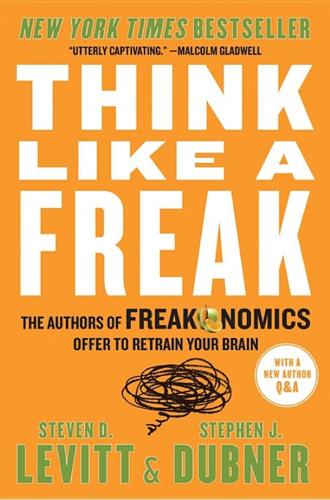
Think Like a Freak
by
Steven D. Levitt
and
Stephen J. Dubner
Published 11 May 2014
People could drink without hesitation when they go out at night—good news for restaurants, bars, and the alcohol industry. Since a driverless car can flow through traffic more efficiently, road congestion and pollution would likely fall. And if driverless cars could be summoned to pick us up or drop us off, we’d no longer need to park at our destination, freeing up millions of acres of prime real estate. In many U.S. cities, 30 to 40 percent of the downtown surface area is devoted to parking. Well, that all sounds pretty perfect, doesn’t it? But of course no new technology is perfect, especially something as vast as a driverless-car revolution. So if you want your argument to be taken seriously, you’d do well to admit the potential downsides.
…
Nearly every major automaker in the world, as well as Google, has successfully tested cars that use an onboard computer, GPS, cameras, radar, laser scanners, and actuators to do everything a human driver can do—but better. And since roughly 90 percent of the world’s 1.2 million traffic deaths each year—yes, 1.2 million deaths, every year!—are the result of driver error, the driverless car may be one of the biggest lifesavers in recent history. Unlike humans, a driverless car won’t drive drowsy or drunk, or while texting or applying mascara; it won’t change lanes while putting ketchup on french fries or turn around to smack its kids in the backseat. Google has already driven its fleet of autonomous cars more than 500,000 miles on real roads throughout the United States without causing an accident.* But safety isn’t the only benefit.
…
Furthermore, an opponent who feels his argument is ignored isn’t likely to engage with you at all. He may shout at you and you may shout back at him, but it is hard to persuade someone with whom you can’t even hold a conversation. Think back to the driverless car that just mowed down a flock of schoolchildren. Is there any value in pretending that such accidents won’t happen? None that we can think of. The death of these children would horrify everyone who heard about it; for the victims’ parents, the very idea of a driverless car would become repugnant. But let’s consider a different set of parents: the ones whose children are currently dying in traffic accidents. Around the world, some 180,000 kids are killed each year, or roughly 500 a day.

Virtual Competition
by
Ariel Ezrachi
and
Maurice E. Stucke
Published 30 Nov 2016
That means that the more cars Google puts on the road compared to its competitors, the greater its learning advantage.”30 Unlike Uber, the super-platforms do incur a significant upfront cost for developing the driverless car. But Google and Apple can spread that cost over many passengers. And, unlike Uber, the super-platforms would not have to pay for the expensive recruitment of drivers; nor would they need to pay 80 percent of each fare to drivers. Nor would Google and Apple have to impose heft y surcharges to entice drivers onto the roads when demand exceeds supply: their algorithms could simply summon available driverless cars from local parking lots. Thus, as the cost of driverless car technology decreases, and the technology improves through learning by doing, the super-platforms could enjoy a significant cost advantage over Uber and become a powerful enemy.
…
Google, by virtue of its calendar and e-mail apps, could anticipate when you need a car and where you need to go. As your Nest Labs smart thermostat lowers the heat when you leave your home, a Google driverless car pulls up to your front door. Even for those who prefer to drive their own cars, Google could nonetheless leverage its driverless car technology. Given the scale benefits of learning by doing, car manufacturers might prefer (or be forced) to license Google’s technology (including the daily or hourly updates from the millions of Google cars on the road). (If Apple did not license its driverless car technology, then it would lack the scale, and its quality would lag.) The car manufacturers also see a potential relationship in which they manufacture the car’s “dumb” commoditized parts (like Foxconn Technology Group for Apple), while the super-platforms earn the lion’s share of profits from technology and design.
…
The possible leveraging of market power to push out an “as efficient” operator downstream, and clear the way for the super-platform’s own operation downstream, is worrying.29 The Dynamic Interplay among Frenemies 153 Beyond the super-platforms’ ability to leverage their power to support car-sharing ser vices, the true game changer is likely to be their driverless car technology. Google and Apple could in the future enjoy a significant cost advantage over Uber. The super-platforms’ algorithms for their driverless cars will also benefit from learning by doing, which provides important scale. As Forbes has noted, “unlike human drivers who must rely on their own experience for learning, Google’s cars will learn from every Google car’s experience.

The AI Economy: Work, Wealth and Welfare in the Robot Age
by
Roger Bootle
Published 4 Sep 2019
I will start by discussing the positive case and reviewing the potential impact, before moving on to the criticisms and problems. The potential and the promise Driverless cars are not a fantasy: they are already working – admittedly only, so far, in restricted areas, such as parts of the city of Phoenix, Arizona. The state of California has recently approved new rules allowing driverless cars to operate without a human driver sitting behind the wheel. In the UK the Chancellor of the Exchequer, Philip Hammond, told the BBC that he aimed to have “fully driverless cars” in use by 2021. About 50 companies, including Alphabet, Apple, Ford, GM, Toyota, and Uber, are already testing self-driving cars in California.
…
A joint study by the World Economic Forum and the Boston Consulting Group sees substantial scope for the sharing of rides in driverless cars, thereby undermining the market for public transport.6 Elon Musk has said that “owning a human-driven vehicle will be similar to owning a horse – rare and optional.7 The results would include fewer cars needing to be built (as well as sold, repaired, insured, etc.). Additionally, there would be less demand for space to park cars that remain idle most of the time. While they are waiting for users, driverless cars can be parked end to end and stacked. This could potentially transform urban landscapes and free up much scarce space for other uses.
…
Despite the claims of the manufacturers and developers of driverless vehicles that they are ultrasafe, a 2015 study from the University of Michigan discovered that the crash rate is higher for driverless vehicles.9 The study suggested that, when they occur, crashes are almost always not the fault of the driverless cars. The problem seems to be that human drivers find it difficult to interact with other vehicles when the latter are driverless. This is such a problem that some tech companies are trying to make driverless cars less robotic, even inducing them to cut corners, be aggressive, and inch forward at junctions. In fact, things aren’t quite so simple as even this might seem to imply. For all the boasts about what their autonomous vehicles can do and the reports that their vehicles have passed so many tests with flying colors, the claims of the manufacturers and developers of autonomous vehicles cannot be taken seriously.
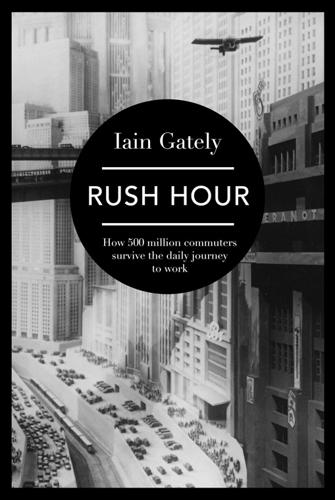
Rush Hour: How 500 Million Commuters Survive the Daily Journey to Work
by
Iain Gately
Published 6 Nov 2014
Pisarski, ‘Commuting in the 21st Century’, Final Data, 29 June 2011. 314 ‘planners who dream of a future’, see Brad Edmondson, ‘Personal Travel’. 314 ‘fuel based transportation’, Financial Times, 7 November 2013: http://www.ft.com/cms/s/0/1edaf8f6-479a-11e3-9398-00144feabdc0.html#axzz2k4AdHGQz. 315 ‘Driverless, it will start its own motor,’ Milwaukee Sentinel, 8 December 1926. 319 ‘Google’s first car on YouTube: http://www.youtube.com/watch?v=CqSDWoAhvLU. 319 /326 For Google and Mercedes driverless cars, see Dan Neil, ‘Driverless Cars for the Road Ahead’, Wall Street Journal, 27 September 2013. 320 ‘We take machines and stuff ’em with information until they’re smarter than we are’, International Movie Database online: http://m.imdb.com/title/tt0064 603/quotes?qt=qt0375405. 320 For Chunka Mui and driverless cars, see: http://www.forbes.com/sites/chunkamui/. 321 ‘typical commuter arteries’, Chris Knapman, ‘Large-scale trial of driverless cars to begin on public roads’, Daily Telegraph, 2 December 2013: http://www.telegraph.co.uk/motoring/news/10484839/Large-scale-trial-of-driverless-cars-to-begin-on-public- roads.html. 321 For KPMG and driverless cars, see ‘Self-driving cars: the next revolution’: https://www.kpmg.com/US/en/IssuesAndInsights/ArticlesPublications/Documents/self-driving-cars-next-revolution.pdf. 326 ‘Something suddenly falls off a truck ahead of the car.
…
qt=qt0375405. 320 For Chunka Mui and driverless cars, see: http://www.forbes.com/sites/chunkamui/. 321 ‘typical commuter arteries’, Chris Knapman, ‘Large-scale trial of driverless cars to begin on public roads’, Daily Telegraph, 2 December 2013: http://www.telegraph.co.uk/motoring/news/10484839/Large-scale-trial-of-driverless-cars-to-begin-on-public- roads.html. 321 For KPMG and driverless cars, see ‘Self-driving cars: the next revolution’: https://www.kpmg.com/US/en/IssuesAndInsights/ArticlesPublications/Documents/self-driving-cars-next-revolution.pdf. 326 ‘Something suddenly falls off a truck ahead of the car. Can the system react faster’, Dan Neil, ‘Driverless Cars’. 328 A ‘bold commitment to modernisation’, Jim Pickard, ‘Mandelson fears HS2 will prove an “expensive mistake”’, Financial Times, 2 July 2013. 328 ‘live in a rail bubble’, Matt Ridley, ‘Hadrian’s wall was a marvellous mistake; so is HS2’, 26 July 2013: http://www.rationaloptimist.com/blog/hadrian%27s-wall-was-a-marvellous-mistake-so- is-hs2.aspx. 329 For ‘reached the end of its life’, see: http://www.businessweek.com/articles/2013-07-12/french-wreck-reveals-hidden-danger-in-its-vaunted-train-system. 331 For ‘barf ride’, see: http://pedestrianobservations.wordpress.com/2013/08/13/loopy-ideas-are-fine-if- youre-an-entrepreneur/. 333 For population estimates and the world’s carrying capacity, see World Population Monitoring 2001, United Nations, Department of Economic and Social Affairs, Population Division, New York, 2001, pp. 31ff. 333 ‘occasional vertical and random horizontal low speed vehicular or moving-belt travel’, John Heaver Fremlin, ‘How Many People Can the World Support?’
…
The Defense Advanced Research Projects Agency (DARPA), part of the US Department of Defense – hoping to inspire the creation of autonomous vehicles that might have martial applications – staged the DARPA Grand Challenges of 2004 and 2005, and the Urban Challenge of 2007, which offered million-dollar prizes and grants to teams who could create effective driverless cars. Various universities built entries, and while none met the challenge in 2004, four succeeded in 2005 and there were as many winners in the urban event. The grand challenges advanced autonomous technology by leaps and bounds, and also created a pool of engineering expertise, eager to take the concept further. The potential that the DARPA challengers had demonstrated revived commercial interest in driverless cars. Companies including Nissan, GM, Lexus, Google, Mercedes Benz, Ford, Skoda, Audi and Volvo are now researching or building vehicles with varying degrees of autonomy.

Ghost Road: Beyond the Driverless Car
by
Anthony M. Townsend
Published 15 Jun 2020
Kerry and Jeff Karsten, “Report: Gauging Investment in Self-Driving Cars,” Brookings Institution, October 16, 2017, https://www.brookings.edu/research/gauging-investment-in-self-driving-cars/. 8first truly self-driving taxi service, in Chandler, Arizona: John Krafcik, “Waymo One: The Next Step on Our Self-Driving Journey,” Waymo (blog), Medium, December 5, 2018, https://medium.com/waymo/waymo-one-the-next-step-on-our-self-driving-journey-6d0c075b0e9b. 8set aside more than $10 billion: “Waymo CEO on Future of Autonomous Vehicles,” Bloomberg, video, September 13, 2017, https://www.bloomberg.com/news/videos/2017-09-14/waymo-ceo-on-future-of-autonomous-vehicles-video. 8“There is hardly a task that horse-drawn vehicles”: “Practical Automobiles: This Type to Form Large Portion of Coming Exhibition,” New York Times, January 12, 1903, https://timesmachine.nytimes.com/timesmach ine/1903/01/12/101965824.pdf. 9“I was ready to make a leap into the future”: David Leonhardt, “Driverless Cars Made Me Nervous. Then I Tried One,” Opinion, New York Times, October 22, 2017, https://www.nytimes.com/2017/10/22/opinion/driverless-cars-test-drive.html. 960 million people were killed: Death: A Self-Portrait, 2012, Richard Harris Collection, London, UK: Wellcome Collection, exhibition. 9time wasted in traffic: “INRIX Global Traffic Scorecard,” INRIX, accessed February 15, 2018, http://inrix.com/scorecard. 1025 million people have disabilities that limit travel: Stephen Brumbaugh, Travel Patterns of Americans with Disabilities (Washington, DC: Bureau of Transportation Statistics, 2018), https://www.bts.gov/sites/bts.dot.gov/files/docs/explore-topics-and-geography/topics/passenger-travel/222466/travel-patterns-american-adults-disabilities-9-6-2018_1.pdf. 10By 2030 . . . tens of millions: BlackRock Investment Group, Future of the Vehicle: Winners and Losers: From Cars and Cameras to Chips (BlackRock Investment Institute, 2017), 8. 10two billion human-driven cars and trucks: Daniel Sperling and Deborah Gordon, Two Billion Cars: Driving toward Sustainability (New York: Oxford University Press, 2009). 10“The future is already here”: Marianne Trench, Cyberpunk (New York: Intercon Production, 1990), YouTube video. 11a mix of both worlds: Bern Grush and John Niles, The End of Driving: Transportation Systems and Public Policy Planning for Autonomous Vehicles (Cambridge, MA: Elsevier, 2018). 11Half will end up in China: “Autonomous Vehicle Sales to Surpass 33 Million Annually in 2040, Enabling New Autonomous Mobility in More Than 26 Percent of New Car Sales, IHS Markit Says,” IHS Markit, January 2, 2018, https://technology.ihs.com/599099/autonomous-vehicle-sales-to-surpass-33-million-annually-in-2040-enabling-new-autonomous-mobility-in-more-than-26-percent-of-new-car-sales-ihs-markit-says. 11$2 trillion global auto-manufacturing industry: Roger Lanctot, Accelerating the Future: The Economic Impact of the Emerging Passenger Economy (Strategy Analytics, June 2017), https://newsroom. intel. com/newsroom/wp-content/uploads/sites/11/2017/05/passenger-economy.pdf; roughly the size of the entire EU economy: “The Economy,” European Union (website), accessed April 11, 2019, https://europa.eu/european-union/about-eu/figures/economy_en. 11capture a $1.7 trillion annual share by 2030: Author’s calculation based on Peter Campbell, “Waymo Forecast to Capture 60% of Driverless Market,” Financial Times, May 10, 2018, https://www.ft.com/content/3355f5b0-539d-11e8-b24e-cad6aa67e23e. 11of many shapes and sizes will have replaced them: Scott Corwin et al., “The Future of Mobility: What’s Next?”
…
Cheape, Moving the Masses: Urban Public Transit in New York, Boston, and Philadelphia 1880–1912 (Cambridge, MA: Harvard University Press, 1980), 1. 175companies merely joined forces: Cheape, Moving the Masses, 172. 175the most powerful, reviled traction monopoly: Walt Crowley, “City Light’s Birth and Seattle’s Early Power Struggles, 1886–1950,” History Link, April 26, 2000, https://www.historylink.org/File/2318. 175enjoyed decades of unrivaled power: Owain James, “We Miss Streetcars’ Frequent and Reliable Service, Not Streetcars Themselves,” Mobility Lab, April 17, 2019, https://mobilitylab.org/2019/04/17/we-miss-streetcars-frequent-and-reliable-service-not-streetcars-themselves/; combination of technological change and federal intervention: “Jersey Trolley Merger,” Wall Street Journal, May 13, 1905, 2. 176$100 billion Vision Fund: Katrina Brooker, “The Most Powerful Person in Silicon Valley,” Fast Company, January 14, 2019, https://www.fastcompany.com/90285552/the-most-powerful-person-in-silicon-valley. 176its total commitment to some $9 billion: Pavel Alpeyev, Jie Ma, and Won Jae Ko, “Taxi-Hailing Apps Take Root in Japan as SoftBank, Didi Join Fray,” Bloomberg, July 19, 2018, https://www.bloomberg.com/news/articles/2018-07-19/softbank-didi-to-roll-out-taxi-hailing-business-in-japan. 177$2 billion into Singapore-based Grab: Yoolim Lee, “Grab Vanquishes Uber with Local Strategy, Billions from SoftBank,” Bloomberg, March 26, 2018, https://www.bloomberg.com/news/articles/2018-03-26/grab-vanquishes-uber-with-local-strategy-billions-from-softbank. 177Ola downloaded $2 billion: Saritha Rai, “India’s Ola Raises $2 Billion from SoftBank, Tencent,” Bloomberg, October 2, 2017, https://www.bloomberg.com/news/articles/2017-10-02/india-s-ola-is-said-to-raise-2-billion-from-softbank-tencent. 17715 percent stake in Uber: Alison Griswold, “SoftBank—not Uber—Is the Real King of Ride-Hailing,” Quartz, January 23, 2018, https://qz.com/1187144/softbank-not-uber-is-the-real-king-of-ride-hailing/. 177Uber picked off Dubai-based Careem: Adam Satariano, “This Estonian Start-Up Has Become a Thorn in Uber’s Side,” New York Times, April 23, 2019, https://www.nytimes.com/2019/04/23/technology/bolt-taxify-uber-lyft.html. 177The damage to consumers: Justina Lee, “Singapore Fine Is ‘Minor Bump’ in Grab’s Ride-Hailing Dominance,” Nikkei Asian Review, September 25, 2018, https://asia.nikkei.com/Spotlight/Sharing-Economy/Singapore-fine-is-minor-bump-in-Grab-s-ride-hailing-dominance. 177Grab cornered more than 80 percent: Ardhana Aravindan, “Singapore Fines Grab and Uber, Imposes Measures to Open Up Market,” Reuters, September 23, 2018, https://www.reuters.com/article/us-uber-grab-singapore/singapore-fines-grab-and-uber-imposes-measures-to-open-up-market-idUSKCN1M406J. 177all launched antitrust investigations: Mai Nguyen, “Vietnam Says Eyeing Formal Antitrust Probe into Uber-Grab Deal,” Reuters, May 16, 2018, https://www.reuters.com/article/us-uber-grab-vietnam-idUSKCN1IH0XNiAikaRey, “Antitrust Watchdog Fines Grab P16 Million over Uber Deal,” Rappler, October 17, 2018, https://www.rappler.com/business/214502-philippine-competition-commission-fines-grab-philippines-over-uber-deal; Yoolim Lee, “Singapore Watchdog Fines Uber, Grab $9.5 Million over Merger,” Bloomberg, September 24, 2018, https://www.bloomberg.com/news/articles/2018-09-24/singapore-fines-uber-grab-s-13-million-for-merger-infringement. 177another fare-slashing battle with Ola: “Steering Group: A Bold Scheme to Dominate Ride-Hailing,” The Economist, May 10, 2018, https://www.economist.com/briefing/2018/05/10/a-bold-scheme-to-dominate-ride-hailing. 177“SoftBank is playing the ride-hailing”: Alison Griswold, “Softbank Has Spread Its Ride-Hailing Bets and Didi Looks Like an Early Win,” Quartz, April 24, 2018, https://qz.com/1261177/softbanks-winner-in-ride-hailing-is-chinas-didi-chuxing-not-uber/. 177“driver incentives, passenger discounts”: Tim O’Reilly, “The Fundamental Problem with Silicon Valley’s Favorite Growth Strategy,” Quartz, February 5, 2019, https://qz.com/1540608/the-problem-with-silicon-valleys-obsession-with-blitzscaling-growth/. 178“locked in a capital-fueled deathmatch”: O’Reilly, “The Fundamental Problem.” 178The Vision Fund’s biggest investor: Brooker, “The Most Powerful Person.” 178the proceeds of an earlier liquidation: Catherine Shu, “Saudi Arabia’s Sovereign Fund Will Also Invest $45B in SoftBank’s Second Vision Fund,” Tech-Crunch, October 2018, https://techcrunch.com/2018/10/07/saudi-arabias-sovereign-fund-will-also-invest-45b-in-softbanks-second-vision-fund/. 178Uber’s multi-billion-dollar quarterly losses: “Aramco Value to Top $2 Trillion, Less Than 5 Percent to Be Sold, Says Prince,” Reuters, April 25, 2016, https://www.reuters.com/article/us-saudi-plan-aramco-idUSKCN0XM16M. 178the House of Saud: Brooker, “The Most Powerful Person.” 178thwart municipal officials’ attempts at enforcement: Mike Isaac, “How Uber Deceives the Authorities Worldwide,” New York Times, March 3, 2017, https://www.nytimes.com/2017/03/03/technology/uber-greyball-program-evade-authorities.html. 179“Even if that means paying money”: Dara Khosrowshahi, “The Campaign for Sustainable Mobility,” Uber, September 26, 2018, https://www.uber.com/newsroom/campaign-sustainable-mobility/. 180Five-cent nickel fares: Cheape, Moving the Masses, 174–75. 180cities . . . grant a ride-hail monopoly: “Free Exchange: The Market for Driverless Cars Will Head towards Monopoly,” The Economist, June 7, 2018, https://www.economist.com/finance-and-economics/2018/06/07/the-market-for-driverless-cars-will-head-towards-monopoly. 180“corrupt and contented”: Cheape, Moving the Masses, 177. 180Jay Gould’s Manhattan Railway Company: Terry Golway, Machine Made: Tammany Hall and the Creation of Modern American Politics (New York: Live-right, 2014), 135. 180took over Puget Sound’s streetcar: Crowley, “City Light’s Birth.” 181Public transit was the competition: United States Securities and Exchange Commission, Registration Statement under the Securities Act of 1933: Uber Technologies, April 11, 2019, 25, https://www.sec.gov/Archives/edgar/data/1543151/000119312519103850/d647752ds1.htm#toc. 181deploy predatory pricing: United States Securities and Exchange Commission, Registration Statement. 182“have been created based on cash flows”: “Asset-Backed Security,” Investo-pedia, accessed December 7, 2018, https://www.investopedia.com/terms/a/asset-backedsecurity.asp. 183Amazon’s body-tracking technology: “The Learning Machine: Amazon’s Empire Rests on its Low-Key Approach to AI,” The Economist, April 11, 2019, https://www.economist.com/business/2019/04/13/amazons-empire-rests-on-its-low-key-approach-to-ai. 8.
…
Just One Thing Might Stand in Their Way,” MIT Technology Review, December 19, 2018, https://www.technologyreview.com/s/612598/chinas-tech-giants-want-to-go-global-just-one-thing-might-stand-in-their-way/. 199“sheds with beds”: Citi GPS and Oxford Martin Programme on Technology and Employment, Technology at Work v. 3.0: Automating E-commerce from Click to Pick to Door, Global Perspectives and Solutions (Citigroup, 2017), 83. 202synergy of software trains and compact neighborhoods: John Markoff, “Urban Planning Guru Says Driverless Cars Won’t Fix Congestion,” New York Times, October 27, 2018, https://www.nytimes.com/2018/10/27/technology/driverless-cars-congestion.html. 202Switzerland’s Les Vergers Ecoquartier: “Venir aux Verges,” Les Vergers Ecoquartier, accessed May 23, 2019, https://www.lesvergers-meyrin. ch/ecoquartier/venir-aux-vergers. 202Micromobility, as this emerging sector is called: Joe Cortright, “What Drives Ride-Hailing: Parking, Drinking, Flying, Peaking, Pricing,” City Commentary, February 19, 2018, http://cityobservatory.org/what-drives-ride-hailing-parking-drinking-flying-peaking-pricing/; under-five-mile journeys: “Disrupting the Car: How Shared Cars, Bikes, Scooters, Are Reshaping Transportation and Cannibalizing Car Ownership,” CB Insights Research Briefs, September 5, 2018, https://www.cbinsights.com/research/disrupting-cars-car-sharing-scooters-ebikes/. 202more rides via its Jump bike-share: Tony Bizjack, “What’s More Popular Than Uber?

Give People Money
by
Annie Lowrey
Published 10 Jul 2018
I spent hours at a recent show, ducking in and out of new models and talking with auto executives and sales representatives. I sat in an SUV as sleek as a shark, the buttons and gears and dials on its dashboard replaced with a virtual cockpit straight out of science fiction. A race car so aerodynamic and low that I had to crouch to get in it. And driverless car after driverless car after driverless car. The displays ranged in degrees of technological spectacle from the cool to the oh-my-word. One massive Ford truck, for instance, offered a souped-up cruise control that would brake for pedestrians and take over stop-and-go driving in heavy traffic. “No need to keep ramming the pedals yourself,” a representative said as I gripped the oversize steering wheel.
…
If so, mass unemployment might be a result—and a UBI might be a necessary salve. But the argument emanating from Silicon Valley feels speculative and distant at the moment. Those driverless cars are miraculous, and stepping into one does feel like stepping into the future. Those AI systems are amazing, and watching them work does feel like slipping into a sci-fi novel. Yet people remain firmly behind the wheel of those driverless cars. And those AI systems remain far removed from most people’s jobs and lives. Opening a discussion about a UBI as a solution to a world with far less demand for human labor feels wise, but insisting the discussion needs to happen now and on those terms seems foolish and myopic.
…
It came up in books, at conferences, in meetings with politicians, in discussions with progressives and libertarians, around the dinner table. I covered it as it happened. I wrote about that failed Swiss referendum, and about a Canadian basic-income experiment that has provided evidence for the contemporary debate. I talked with Silicon Valley investors terrified by the prospect of a jobless future and rode in a driverless car, wondering how long it would be before artificial intelligence started to threaten my job. I chatted with members of Congress on both sides of the aisle about the failing middle class and whether the country needed a new, big redistributive policy to strengthen it. I had beers with European intellectuals enthralled with the idea.
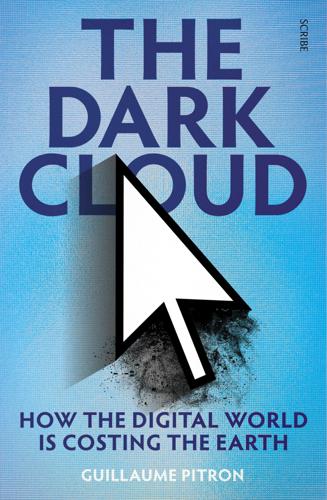
The Dark Cloud: How the Digital World Is Costing the Earth
by
Guillaume Pitron
Published 14 Jun 2023
A report by US consulting firm McKinsey & Company states that by 2030 a driverless car will require some 300 million lines of code to function.48 The final frontier of the connected car is the driverless car, even if nothing suggests that they will one day find their way onto the road in their millions. ‘Everyone realised that it’s more complicated than we thought. Even Google and Uber keep postponing [the roll-out of these vehicles]’, says Mathieu Saujot, a researcher at IDDRI, a sustainable-development think tank.49 But if driverless cars do one day go mainstream, they will produce, on account of their lidars and ultra-high-definition cameras, up to one gigabyte of data per second.50 In the words of the head of a big tech company, ‘A million autonomous cars represent as much data as the entire world population connected to the web.’51 And what will these vehicles use to communicate with?
…
Road signs, smart roads, and other driverless cars connected to ‘edge data centres’ that offer the lowest possible latency. Paradoxically, the more ‘autonomous’ the car, the more it will depend on the surrounding infrastructure … There is nothing less autonomous than an autonomous vehicle. ‘It’s an oversight in terms of innovation’, says Mathieu Saujot, ‘and that’s the physical reality in which they’ll find themselves.’52 Some observers reassure us that only shreds of the data produced will leave the vehicle to communicate with the outside world.53 Others add that the driverless car is meant to be a shared vehicle, which should limit the number of cars on the road (a point that is indeed up for debate).54 One thing we can be sure of is that it will use far more electricity — up to 1,500 additional watts.55 How will that affect the range of the electric car?
…
Will the volume of its battery need to be increased, or will hybrid engines be the key to compensate for the surplus in energy consumption?56 Furthermore, the data produced by a driverless car will result in carbon dioxide emissions from the infrastructure used to transmit, store, and process the data needed to better understand our consumer behaviours, to propose adapted car insurance plans (known as ‘pay as you drive’), and to design targeted advertising. Accordingly, every kilometre travelled by a driverless car could indirectly increase average car emissions by over 20 per cent … at a time when, worldwide, vehicle-emission standards are becoming stricter and more widespread.57 Who’s to be held accountable?
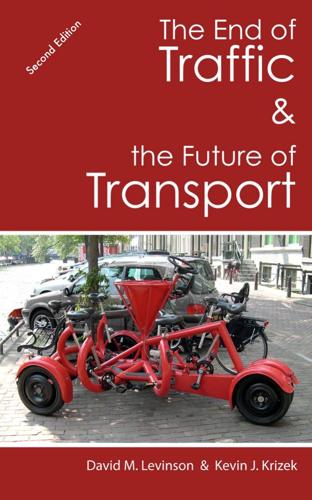
The End of Traffic and the Future of Transport: Second Edition
by
David Levinson
and
Kevin Krizek
Published 17 Aug 2015
Networks Physical Networks Digital Networks Nouns Things [almost all focus has been here] Travel, Goods Delivery 3D printing Data Mail, Books, Newspapers, CDs, DVDs Streaming music or movies 7. Autonomous Autos Set in the Mojave Desert straddling the Nevada/California border — in the middle of nowhere — DARPA153 hosted the first Grand Challenge on vehicle automation in March 2004. With the potential of $1 million going to the winner, the objective was for driverless cars to complete a 150 mile (240 km) route. Carnegie Mellon University's robot vehicle made it the furthest, completing almost 5 percent of the route, but was ultimately not awarded the prize. A second run of the event saw five vehicles completing the course in October 2005 with Stanford University's team winning with a time of just under 7 hours.154 Within 18 months, vehicle automation technology rapidly improved.
…
The share of ownership versus MaaS is thus an, if not the most, important predictor of travel demand in the coming years. But two seemingly contradictory, but complementary, outcomes are likely as vehicular automation and Mobility-as-a-Service play out. We label these scenarios "Up" and "Out." Up: Less vehicle ownership with increased use of MaaS in cities, raising the value of cities. Driverless cars which can be summoned on demand allow people to avoid vehicle ownership altogether. This will reduce vehicle travel, as people will pay more to rent by the minute than exploit the sunk costs of vehicular ownership. By saving total expenditures on transport, more funds are available to pay for rent in cities, and more trips are by walk, bike, and transit.
…
People who seek the set of urban amenities (entertainment, restaurants, a larger dating pool) will find these amenities increasing in response to the population. The greater value in cities with the new more convenient technology leads to more and taller development. (Hence the use of the word 'Up.') Out: More vehicle travel with increased exurbanization. Fast, driverless cars that allow their passenger to do other things than steer and brake and find parking impose fewer requirements on the traveler than actively driving the same distance. Decreases in the cost of traveling (i.e., availability of multitasking) makes travel easier. Easier travel means increases in accessibility and subsequently increases in the spread of development and a greater separation between home and work, (pejoratively, sprawl), just as commuter trains today enable exurban living or living in a different city.250 This reinforces the disconnected, dendritic suburban street grid and makes transit service that much more difficult (as if low density suburbs weren't hard enough).

The Industries of the Future
by
Alec Ross
Published 2 Feb 2016
Innovation in robotics will produce advances in degree—robots doing things faster, safer, or less expensively than humans—and also in kind: they’ll be doing things that would be impossible for humans to do, like allowing a sick, homebound 12-year-old to go to school, or giving those who are deaf and mute the power of speech. STEP ON IT, ROBOTIC JEEVES People have been thinking about building driverless cars for almost as long as cars have been around. General Motors introduced the modern concept of the driverless car at the 1939 World’s Fair in New York, conceiving of a radio-guided car that could be developed alongside a modern highway system. Then in 1958, GM developed the first driverless test car, the Firebird, which would connect to a track wired with electrical cable.
…
Any time not spent behind the wheel is time you can spend using a Google product. But will it work? There is ample reason to think that robodrivers will be safer than we are now. Accidents are caused by the four Ds: distraction, drowsiness, drunkenness, and driver error. The driverless car promises to reduce all of these significantly. Chris Gerdes, a Stanford professor of engineering, cautions that driverless cars won’t fully wipe out human error, but rather will shift it from driver to programmer; that’s in all likelihood a significant step forward, especially if a human driver and the programmer can work together. A similar process has unfolded over the years with airplanes, which are now largely driven by autopilot with the pilot still stepping in during crucial times.
…
I met the CEO of a company that develops high-tech access control systems (like the new parking garage system at the airport that tells you how many open spaces are available on each floor) and asked him what worries him about the future. He cited a disruption that I’d never considered before: what driverless cars might mean for parking garages. Would the cars just drive themselves back home and come back when needed? Why have your car sit in a garage and have to pay for it? The degree to which delivery drones fill the sky or driverless cars fill the streets will eventually be determined not by whether it is feasible technologically and economically—at some point it will be—but by whether humans accept the changes they bring about.
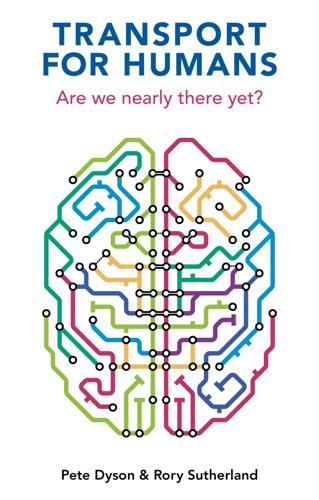
Transport for Humans: Are We Nearly There Yet?
by
Pete Dyson
and
Rory Sutherland
Published 15 Jan 2021
Agreeing a common language can be a smart behavioural solution to addressing optimism. Driverless cars would warrant this treatment. This amorphous technology divides opinion. Christian Wolmar’s Driverless Cars: On a Road to Nowhere? (from the Perspectives series in which this book appears) makes the case that technological change at the level of the vehicle may not be practical, it might not offer benefits that are meaningful to us, and it may fail to make society better.28 Wolmar argues that empty rhetoric about technology benefits is being used to sell us new cars. We are just as interested in the behavioural effects. How would driverless cars coexist with human drivers and pedestrians?
…
A Manifesto for an Intelligent Transport Policy — David Metz Britain’s Cities, Britain’s Future — Mike Emmerich Before Babylon, Beyond Bitcoin: From Money That We Understand To Money That Understands Us — David Birch The Weaponization of Trade: The Great Unbalancing of Politics and Economics — Rebecca Harding and Jack Harding Driverless Cars: On a Road to Nowhere? — Christian Wolmar Digital Transformation at Scale: Why the Strategy Is Delivery — Andrew Greenway, Ben Terrett, Mike Bracken and Tom Loosemore Gaming Trade: Win–Win Strategies for the Digital Era — Rebecca Harding and Jack Harding The Currency Cold War: Cash and Cryptography, Hash Rates and Hegemony — David Birch Catastrophe and Systemic Change: Learning from the Grenfell Tower Fire and Other Disasters — Gill Kernick Transport for Humans: Are We Nearly There Yet?
…
International hub airports have historically been most reliant on retail concessions from high-end shopping. In a world of more discretionary travel (and more online shopping), they will be the first to diversify their offering to satisfy a wider range of passenger needs. A travelling bathroom The case for driverless cars could be strengthened if it was possible to put in-vehicle time to new uses. Being able to sleep, shower and dress en route would transform commuting behaviours and long-distance trips as it would free up time elsewhere in the day. By pioneering autonomous RVs or caravans, large countries like the United States could transform the many long journeys of over eight hours, on smooth and uncomplicated highways, that their vast expanses afford.

The Fourth Industrial Revolution
by
Klaus Schwab
Published 11 Jan 2016
Apart from serving as a mouthpiece for the city to tell residents about food hazards, the collaboration is potentially a way to shame repeat-offender restaurants into complying with health standards.” Source: http://www.citylab.com/cityfixer/2015/04/3-cities-using-opendata-in-creative-ways-to-solve-problems/391035/ Shift 12: Driverless Cars The tipping point: Driverless cars equalling 10% of all cars on US roads By 2025: 79% of respondents expected this tipping point to have occurred Trials of driverless cars from large companies such as Audi and Google are already taking place, with a number of other enterprises ramping up efforts to develop new solutions. These vehicles can potentially be more efficient and safer than cars with people behind the steering wheel.
…
Source: http://www.wired.com/2015/07/hackers-remotely-kill-jeep-highway/ The first state in the United States (Nevada) to pass a law allowing driverless (autonomous) cares did so in 2012. Source: Alex Knapp, 22 June 2011, “Nevada Passes Law Authorizing Driverless Cars”, Forbes: http://www.forbes.com/sites/alexknapp/2011/06/22/nevada-passes-law-authorizing-driverless-cars/ Shift 13: Artificial Intelligence and Decision-Making The tipping point: The first Artificial Intelligence (AI) machine on a corporate board of directors By 2025: 45% of respondents expected this tipping point to have occurred Beyond driving cars, AI can learn from previous situations to provide input and automate complex future decision processes, making it easier and faster to arrive at concrete conclusions based on data and past experiences.
…
Implantable Technologies 2. Our Digital Presence 3. Vision as the New Interface 4. Wearable Internet 5. Ubiquitous Computing 6. A Supercomputer in Your Pocket 7. Storage for All 8. The Internet of and for Things 9. The Connected Home 10. Smart Cities 11. Big Data for Decisions 12. Driverless Cars 13. Artificial Intelligence and Decision-Making 14. AI and White-Collar Jobs 15. Robotics and Services 16. Bitcoin and the Blockchain 17. The Sharing Economy 18. Governments and the Blockchain 19. 3D Printing and Manufacturing 20. 3D Printing and Human Health 21. 3D Printing and Consumer Products 22.
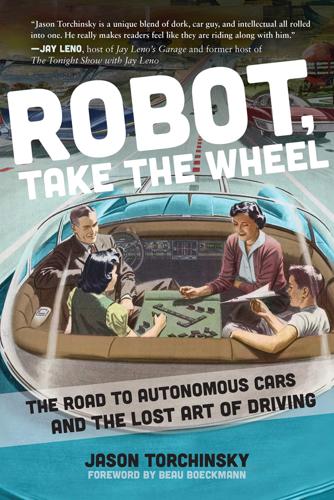
Robot, Take the Wheel: The Road to Autonomous Cars and the Lost Art of Driving
by
Jason Torchinsky
Published 6 May 2019
HowStuffWorks.com, https://auto.howstuffworks.com/da-vinci-car1.htm. 3 Milford, Frederick J., “US Navy Torpedoes,” Submarine Review, April 1996, http://www.webcitation.org/5kmz4U6ZZ. 4 Kirby, Geoff, “Navies in Transition,” Journal of the Royal Navy Scientific Service, Vol 27, No 1, https://archive.is/DIiw. 5 Felton, Ryan, “The Man Who Tested the First Driverless Car in 1925 Had a Bizarre Feud with Harry Houdini,” Jalopnik, https://jalopnik.com/the-man-who-tested-the-first-driverless-car-in -1925-had-1792312207. 6 New York Times, “Radio-Driven Auto Runs Down Escort,” July 28, 1925, https://timesmachine.nytimes.com/timesmachine/1925/07/28/99984359.html?pageNumber=28. 7 Google Patents, Sperry, E. A., “Gyroscopic Apparatus,” Patented June 13, 1916, https://patents.google.com/patent/US1186856. 8 Exo Cruiser, “‘Mechanical Mike’ (The Evolution of the Modern Airplane Autopilot),” https://dodlithr.blogspot.com/2013/07/mechanical-mike-1930s-forefather-of.html. 9 Lehman, Staci, “The Pigeon-Guided Missiles and Bat Bombs of World War II,” Gizmodo, https://gizmodo.com/the-pigeon-guided-missiles-and-bat-bombs-of-world-war-i-1477007090. 10 Moore, James and Nero, Paul, “Pigeon-Guided Missiles,” Military History Matters, November 10, 2010, https://www.military-history.org/articles/pigeon-guided-missiles.htm. 11 Donnelly, Jim, “Ralph R.
…
Teetor,” Hemmings Classic Car, July 2009, https://www.hemmings.com/magazine/hcc/2009/07/Ralph-R--Teetor/1846418.html. 12 Sears, David, “The Sightless Visionary Who Invented Cruise Control,” Smithsonian.com, March 8, 2018, https://www.smithsonianmag.com/innovation/sightless-visionary-who-invented-cruise-control-180968418/. 13 Old Car Brochures,“GM Corporate and Concepts, 1956 GM Firebird II,” http://www.oldcarbrochures.com/static/NA/GM%20Corporate%20and%20Concepts/1956_GM_Firebird_II/1956%20Firebird%20II-12-13.html. 14 Hicks, Nancy, “Nebraska tested driverless car technology 60 years ago,” Lincoln Journal Star, September 12, 2017, http://journalstar.com/news/local/govt-and-politics/nebraska-tested-driverless-car -technology-years-ago/article_a702fab9-cac3-5a6e-a95c -9b597fdab078.html. 15 Reynolds, John, “Cruising into the future,” Telegraph, May 26, 2001, https://www.telegraph.co.uk/motoring/4750544/Cruising-into-the -future.html. 16 General Motors, Key to the Future, https://www.youtube.com/watch?
…
* * * 35 “Full Self-Driving Hardware on All Cars,” Tesla.com, https://www.tesla.com/autopilot. 36 Thatcham Research Press Release, “Automated Driving Hype is Dangerously Confusing Drivers,” October 18, 2018, https://news.thatcham.org/pressreleases/autonomous-driving-hype-is-dangerously -confusing-drivers-study-reveals-2767283. 37 Felton, Ryan, “Tesla Says Autopilot Was On Before Fatal Model X Crash, But That Driver Didn't Abide Warnings,” Jalopnik, March 30, 2018, https://jalopnik.com/tesla-admits-autopilot-was-on-before-fatal -model-x-cras-1824224176. 38 Noyes, Dan, “Victim Who Dies in Tesla Crash Had Complained About Autopilot,” ABC7 News, March 28, 2018, http://abc7news.com/automotive/i-team-exclusive-victim-who-died-in-tesla-crash-had -complained-about-auto-pilot/3275600/. 39 Westbrook, Justin, “Tesla Blames Driver in Fatal Model X Autopilot Crash As Family Considers Legal Action,” Jalopnik, April 11, 2018, https://jalopnik.com/tesla-blames-driver-in-fatal-model-x-autopilot -crash-as-1825193432. 40 “Discover Cadillac,” Super Cruise, https://www.cadillac.com/world -of-cadillac/innovation/super-cruise. 41 King, Alanis, “Stop Doing This Shit with Autonomous Cars,” Jalopnik, January 15, 2018, https://jalopnik.com/stop-doing-this-shit -with-semi-autonomous-cars-1822090627. 42 Davies, Alex, “Ford’s Working on a Remote Control for Your Car,” Wired, January 26, 2015, https://www.wired.com/2015/01/fords-working-remote-control-car/. 43 Coxworth, Ben, “Full Size Remote-Control Cars - Coming Soon to a Road Near You?” New Atlas, July 30, 2013, http://www.gizmag.com/remote-control-cars/28521/. 44 Hawkins, Andrew J., “Elon Musk Still Doesn’t Think Lidar is Necessary for Fully Driverless Cars,” The Verge, February 7, 2018, https://www.theverge.com/2018/2/7/16988628/elon-musk-lidar-self -driving-car-tesla. 45 Orlove, Raphael, “Angry Owners Sue Tesla for Using Them as Beta Testers of ‘Dangerously Defective’ Autopilot,” Jalopnik, April 20, 2017, https://jalopnik.com/angry-owners-sue-tesla-for-using-them -as-beta-testers-o-1794503348.

User Friendly: How the Hidden Rules of Design Are Changing the Way We Live, Work & Play
by
Cliff Kuang
and
Robert Fabricant
Published 7 Nov 2019
But “he has to a high degree a sense of the ultimate use to which commodities will be put, a feeling for the comfort of the man who is going to use the fountain pen for writing more than as a decorative adjunct to his desk.” (Emphasis mine.) This is the spine of the user-friendly world, unchanged whether you’re talking about smartphones or toothbrushes or driverless cars: a deference to the complexity of understanding people as they live. Dreyfuss was gleeful when describing what miracles might come from a life made easier at the edges: a peanut butter jar with sloped shoulders so that every last bit could be scooped out with a spoon; a shaving brush with a handle of the right proportions so as not to mess your hand with lather; and a stove with cleverly shielded handles so that the users never burned their hands.
…
All the nuances of designing new products can be reduced to one of two basic strategies: either finding what causes us pain and trying to eliminate it, or reinforcing what we already do with a new object that makes it so easy it becomes second nature. The truest material for making new things isn’t aluminum or carbon fiber. It’s behavior.30 Tesla Model S steering wheel (2012) 4 Trust It was January of the year 2016, which would prove to be a breakthrough year in mainstream media coverage of driverless cars. We were rolling eastward across the San Mateo Bridge in an Audi A7, picking our way through traffic. One of the car’s engineers was driving, while I was riding in the passenger seat. There was another engineer in the back seat, monitoring the car from a laptop. Traffic was getting thick as the workday drew to a close on all the area’s tech campuses.
…
(By 2019, European Audi A8s came with an optional “traffic jam pilot” that allowed limited hands-free operation; that option couldn’t be offered in America, because of the inconsistency in federal and state laws.)1 The supervising engineer piped up, “The first three minutes you’re thinking, This is crazy, this is the future! Then you get bored.” We all laughed. But the very fact of the drive’s boringness was a feat. Boringness implied ease rather than fear, a comfort with what was happening even if it was totally novel. Amid all the headlines about driverless cars, it’s easy to miss just how far they have come, and how fast. We can already buy cars that park themselves or swerve to avoid accidents or brake to avoid surprise obstacles. Look a little closer and you can see how awkward the adjustment has been at times. There’s a slapstick viral video on YouTube from 2015, with more than 7 million views.

Age of Context: Mobile, Sensors, Data and the Future of Privacy
by
Robert Scoble
and
Shel Israel
Published 4 Sep 2013
Lots of cars have sensors that start wipers when they sense water. Some now automatically send and receive messages to other cars. At Toyota, they told us of cars talking with traffic lights to avoid bottlenecks and collisions at intersections. Some experts are more optimistic about when driverless cars will arrive in a showroom near you. Bob Lutz, GM’s retired vice chairman, predicts that driverless cars would be ubiquitous in about 20 years. We think it will be more like ten years before the vehicles are technically ready and affordable. In the time it took us to write this chapter, our friend John Markoff, a New York Times technology reporter, may have witnessed a technological breakthrough when he was a passenger in a driverless, lidar-less Audi A7 that zipped down an Israeli highway at 65 miles an hour.
…
Software will be easier to keep current. A broken device will be easier to replace than a damaged windshield. The issues of regulation and adoption bring us to what may be the most significant and controversial changes in car making since horsepower replaced horses. We refer, of course, to the driverless car. Chapter 5 Driving Over the Freaky Line People are so bad at driving cars that computers don’t have to be that good to be much better. Marc Andreessen, investor Picture this: It is not very far into the future and you have just arrived in a big city. You summon an Uber car via a mobile app and a nice-looking upscale sedan soon pulls up to the curb in front of you.
…
Then, no one at all maneuvers city traffic and delivers you safely to your destination, where you leave without paying as your transaction takes place automatically online. Even Robert Scoble, a legendary lover of new technologies, says that this scenario freaks him out; yet some time in the next 5 to 50 years, this will be commonplace. Once people get past their discomfort, they will discover that driverless cars are safer than those driven by people. They are also more energy efficient and don’t wander over lanes like people do. The pilots don’t daydream, or get competitive with other vehicles or demonstrate road rage because the last passenger didn’t tip. Instead of driving, people will be able to do some work, catch up on their social networks, grab a few winks or watch a video.

The People vs Tech: How the Internet Is Killing Democracy (And How We Save It)
by
Jamie Bartlett
Published 4 Apr 2018
Get up nice and early, based on the auto-set alarm that knows your calendar and average getting ready time (factoring for typical traffic). A data-driven breakfast would be proposed after a quick analysis of the health stats of you and thousands of others like you, to ensure the perfect balance of nutrients you might need today. (Plus: a small reduction in your health insurance premiums, if you take its advice.) Hop in your driverless car, which is just returning from a night shift earning money for you as an autonomous taxi. And, as you relax into the journey, your personal AI assistant bot will advise you on what to say in today’s key sales meeting, based on previous performance and who else will be present. Before being whisked back home . . .
…
.* In 2004, respected AI-researchers from the Massachusetts Institute of Technology (MIT) concluded that autonomous vehicles were a pipedream, driving being a skill that required too much human intuition and motor skills.1 But we should never underestimate the speed at which digital technology can advance. Millions of dollars of investment are now pouring in from Uber, Google, Tesla, Mercedes, Volvo, Starsky and others. Several countries (including the UK) are encouraging ‘real world’ testing, and the British Chancellor expects that driverless cars will be on the road by 2021. The way it’s going, regulations and insurance issues are more likely to slow this down than the technology. A world without work? Driverless vehicles are just one application of an artificial intelligence revolution that is sweeping through the global economy.
…
Apple splashed out $200 million for Turi, a machine learning start-up, in 2016, and Intel has invested over $1 billion in AI companies over the past couple of years.7 Market leaders in AI like Google, with the data, the geniuses, the experience and the computing power, won’t be limited to just search and information retrieval. They will also be able to leap ahead in almost anything where AI is important: logistics, driverless cars, medical research, television, factory production, city planning, agriculture, energy use, storage, clerical work, education and who knows what else. Amazon is already a retailer, marketing platform, delivery and logistics network, payment system, credit lender, auction house, book publisher, TV production company, fashion designer and cloud computing provider.8 What next?

Deep Medicine: How Artificial Intelligence Can Make Healthcare Human Again
by
Eric Topol
Published 1 Jan 2019
Detection of the emotional state or sleepiness level of the driver via voice and facial cues could also be used to promote safety.56 Still, with more than 40,000 fatal car accidents in the United States in 2017, nearly all due to human error, the biggest payoff of AI in cars might be in driving them for us. Clearly, we’re in need of some help.57 DRIVERLESS CARS You’d have to be living in a cave in recent years to avoid being barraged with grandiose claims about driverless cars. Especially if you watch YouTube videos of Tesla “drivers” playing games, writing, jumping into the back seat, and reading, it would be easy to have the sense that they are just around the corner.58 While it’s the pinnacle achievement to date for AI, it’s not exactly how it seems.
…
There are two fundamental levels of the ethics of AI: machine ethics, which refers to the AI systems per se, and the wider domain, not specific to the algorithms. The prototypical example of machine ethics involves how driverless cars handle the dilemma of choosing between evils in the case of an impending accident, when no matter how it responds, people are going to die. It’s the modern-day version of the trolley problem introduced more than fifty years ago. Jean-Francois Bonnefon and colleagues examined the driverless car dilemma in depth using simulations and input from more than 1,900 people.59 In each of the three scenarios (Figure 5.1), there is no good choice; it’s just a matter of who and how many people are killed, whether the car’s passenger, a pedestrian, or several of them.
…
At the top layer, the neurons have now fully differentiated the features and are ready for output—predicting what the chest X-ray shows, based on its training.23 DNNs, with this structural backbone, can functionally be regarded as a general-utility, or a general-purpose, technology, much like the steam engine or electricity.24 And, much like those technologies, these neural networks can be applied to all sorts of problems. Before medicine, these networks were applied principally to four major areas: games, images, voice and speech, and driverless cars. Each has lessons for us as we explore what deep learning can do for medicine. GAMES Even before the historic 1997 Deep Blue–Kasparov chess match, AI had prevailed over human experts in other games including Othello, checkers (which has 500 billion-billion possible positions), and Scrabble.25 But for all of these, AI used rules-based algorithms, sometimes known as GOFAI, for “good old-fashioned AI.”

Genius Makers: The Mavericks Who Brought A. I. To Google, Facebook, and the World
by
Cade Metz
Published 15 Mar 2021
It didn’t actually build the stuff that needed the Next Big Thing in artificial intelligence. As he recovered from the first surgery on his hip, Lu urged the Microsoft brain trust to embrace the idea of a driverless car. Myriad tech companies and carmakers had a long head start with their autonomous vehicles, and Lu wasn’t exactly sure how Microsoft would enter this increasingly crowded market. But that wasn’t the issue. His argument wasn’t that Microsoft should sell a driverless car. It was that Microsoft should build one. This would give the company the skills and the technologies and the insight it needed to succeed in so many other areas.
…
They had built what was called a neural network, a mathematical system modeled on the web of neurons in the brain, and it could identify common objects—like flowers, dogs, and cars—with an accuracy that had previously seemed impossible. As Hinton and his students showed, a neural network could learn this very human skill by analyzing vast amounts of data. He called this “deep learning,” and its potential was enormous. It promised to transform not just computer vision but everything from talking digital assistants to driverless cars to drug discovery. The idea of a neural network dated back to the 1950s, but the early pioneers had never gotten it working as well as they had hoped. By the new millennium, most researchers had given up on the idea, convinced it was a technological dead end and bewildered by the fifty-year-old conceit that these mathematical systems somehow mimicked the human brain.
…
Alongside a small group of other scientists—spread across those same four companies, one more American Internet giant, and, eventually, a new upstart—Hinton and his students soon pushed this single idea into the heart of the tech industry. In doing so, they suddenly and dramatically accelerated the progress of artificial intelligence, including talking digital assistants, driverless cars, robotics, automated healthcare, and—though this was never their intention—automated warfare and surveillance. “It changed the way that I looked at technology,” Alan Eustace says. “It changed the way many others looked at it, too.” Some researchers, most notably Demis Hassabis, the young neuroscientist behind DeepMind, even believed they were on their way to building a machine that could do anything the human brain could do, only better, a possibility that has captured the imagination since the earliest days of the computer age.
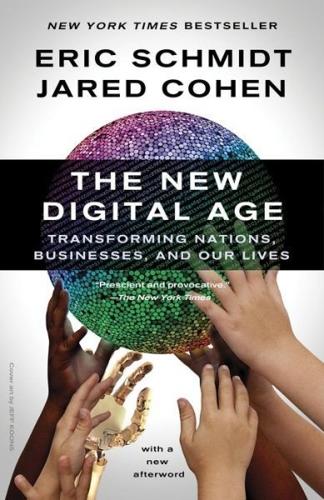
The New Digital Age: Transforming Nations, Businesses, and Our Lives
by
Eric Schmidt
and
Jared Cohen
Published 22 Apr 2013
in 2012, Nevada became the first state to issue licenses to driverless cars: Chris Gaylord, “Ready for a Self-Driving Car? Check Your Driveway,” Christian Science Monitor, June 25, 2012, http://www.csmonitor.com/Innovation/Tech/2012/0625/Ready-for-a-self-driving-car-Check-your-driveway. California also affirmed their legality: James Temple, “California Affirms Legality of Driverless Cars,” The Tech Chronicles (blog), San Francisco Chronicle, September 25, 2012, http://blog.sfgate.com/techchron/2012/09/25/california-legalizes-driverless-cars/; Florida has passed a similar law. See Joann Muller, “With Driverless Cars, Once Again It Is California Leading the Way,” Forbes, September 26, 2012, http://www.forbes.com/sites/joannmuller/2012/09/26/with-driverless-cars-once-again-it-is-california-leading-the-way/.
…
While some of the very exciting new possibilities in transportation, like supersonic tube commutes and suborbital space travel, are still far in the distance, ubiquitous self-driving cars are imminent. Google’s fleet of driverless cars, built by a team of Google and Stanford University engineers, has logged hundreds of thousands of miles without incident, and other models will soon join it on the road. Rather than replacing drivers altogether, the liminal step will be a “driver-assist” approach, where the self-driving option can be turned on, just as an airline captain turns on the autopilot. Government authorities are already well versed on self-driving cars and their potential—in 2012, Nevada became the first state to issue licenses to driverless cars, and later that same year California also affirmed their legality.
…
Imagine having the holodeck from the world of Star Trek, which was a fully immersive virtual-reality environment for those aboard a ship, but this one is able to both project a beach landscape and re-create a famous Elvis Presley performance in front of your eyes. Indeed, the next moments in our technological evolution promise to turn a host of popular science-fiction concepts into science facts: driverless cars, thought-controlled robotic motion, artificial intelligence (AI) and fully integrated augmented reality, which promises a visual overlay of digital information onto our physical environment. Such developments will join with and enhance elements of our natural world. This is our future, and these remarkable things are already beginning to take shape.

Machines of Loving Grace: The Quest for Common Ground Between Humans and Robots
by
John Markoff
Published 24 Aug 2015
In our current economy, how robots—both machines and intelligent systems—are designed and how they are used is overwhelmingly defined by cost and benefit, and costs are falling at an increasingly rapid rate. In our society, economics dictate that if a task can be done more cheaply by machine—software or hardware—in most cases it will be. It’s just a matter of when. The decision to come down on either side of the debates is doubly difficult because there are no obvious right answers. Although driverless cars will displace millions of jobs, they will also save many lives. Today, decisions about implementing technologies are made largely on the basis of profitability and efficiency, but there is an obvious need for a new moral calculus. The devil, however, is in more than the details. As with nuclear weapons and nuclear power, artificial intelligence, genetic engineering, and robotics will have society-wide consequences, both intended and unintended, in the next decade. 2|A CRASH IN THE DESERT On a desert road near Florence, Arizona, one morning in the fall of 2005, a Volkswagen Touareg was kicking up a dust cloud, bouncing along at a steady twenty to twenty-five miles per hour, carrying four passengers.
…
They had even been the stuff of TV series like Knight Rider, a 1980s show featuring a crime fighter assisted by an artificially intelligent car. There was also a dark-side vision of automated driving, perhaps best expressed in Daniel Suarez’s 2009 sci-fi thriller Daemon, in which AI-controlled cars not only drove themselves, but ran people down as well. Still, the general perception was a deep well of skepticism about whether driverless cars would ever become a reality. However, Sebastian Thrun had made his point abundantly clear that humans are terrible drivers, largely the consequence of human fallibility and inattention. By the time his project was discovered, Google cars had driven more than a hundred thousand miles without an accident, and over the next several years that number would rise above a half-million miles.
…
Like it or not, we are no longer in a biblical world, and the future is not about geographical territory, but rather about a rapidly approaching technological wonder world. Machines that will begin as golems are becoming brilliant and capable of performing many human tasks, from physical labor to rocket science. Google had a problem. More than three years into the company’s driverless car program, the small research team at the Mountain View–based Internet search company had safely driven more than a half-million miles autonomously. They had made startling progress in areas that had been generally believed impossible within the traditional automotive industry. Google cars could drive during the day and at night, could change lanes, and could even navigate the twisty Lombard Street in San Francisco.

The Patient Will See You Now: The Future of Medicine Is in Your Hands
by
Eric Topol
Published 6 Jan 2015
A. Salkever, “What Google’s Driverless Car Future Might Really Look Like,” Read Write, May 28, 2014, http://readwrite.com/2014/05/28/googles-driverless-car-future?awesm=readwr.it_p20r-awesm=~oFWmYrlzbbCpi0. 27. C. C. Miller, “When Driverless Cars Break the Law,” New York Times, May 14, 2014, http://www.nytimes.com/2014/05/14/upshot/when-driverless-cars-break-the-law.html. 28. G. Sullivan, “Google’s New Driverless Car Has No Brakes or Steering Wheel,” Washington Post, May 28, 2014, http://www.washingtonpost.com/news/morning-mix/wp/2014/05/28/googles-new-driverless-car-has-no-brakes-or-steering-wheel//?
…
As in every other sector in our lives, when data becomes eminently portable and granular, when there’s so much more of it and it’s free flowing, fully transparent, and there’s seemingly unlimited computing power to process it, historic change takes place. Just think of the impact of Google or Amazon. But searching and purchasing anywhere, anytime is old stuff. The ability to share data and contextually compute it led the nonmedical world to progress many could not have even imagined, leading to advances like driverless cars. The shake-up of medicine will be just as strong. Driverless Cars and Doctorless Patients? When I’m driving in back of a big truck and can’t see anything in front of me except the truck, I feel vulnerable because I’m lacking critical information about the traffic and road conditions. The parallels to health care are irresistible.
…
Lawler, “Google X Built a Fully Self-Driving Car from Scratch, Sans Steering Wheel and Pedals,” TechCrunch, May 27, 2014, http://techcrunch.com/2014/05/27/google-x-introduces-a-fully-self-driving-car-sans-steering-wheel-and-pedals/. 30. L. Gannes, “Google’s New Self-Driving Car Ditches the Steering Wheel,” Recode, May 27, 2014, http://recode.net/2014/05/27/googles-new-self-driving-car-ditches-the-steering-wheel/. 31. R. W. Lucky, “The Drive for Driverless Cars,” IEEE Spectrum, June 26, 2014, http://spectrum.ieee.org/computing/embedded-systems/the-drive-for-driverless-cars. 32. C. Smith, “‘I No Longer Have to Go to See the Doctor’: How the Patient Portal is Changing Medical Practice,” Journal of Participatory Medicine 6 (2014): e6. 33. L. Collar, “Are Physicians Still Relevant?,” Sapphire Equinox, April 5, 2014, http://sapphireequinox.com/blog/are-physicians-still-relevant/. 34.
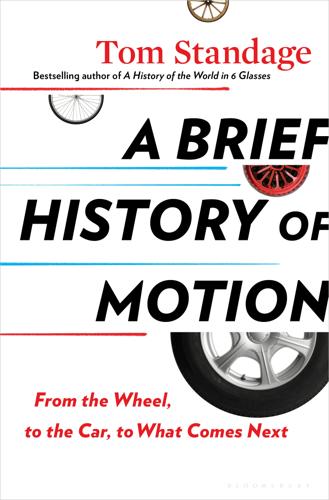
A Brief History of Motion: From the Wheel, to the Car, to What Comes Next
by
Tom Standage
Published 16 Aug 2021
But full autonomy on public roads, with no safety driver, still seems a distant dream. Perhaps the industry will steadily inch its way toward fully driverless vehicles. But without some kind of breakthrough, self-driving cars are still not quite safe enough to be let loose on public roads without supervision. THE DREAM OF THE DRIVERLESS CAR Proponents of driverless cars have not given up on the dream. They argue that if AVs could be deployed in large numbers, they would offer enormous benefits. Mary Barra, the chief executive of General Motors, has declared that her company’s goal “is a future with zero crashes, zero emissions, and zero congestion” made possible by “autonomous, electric shared and connected vehicles.”
…
“Drivers could bowl along with their hands off the wheel, free to enjoy the scenery or hug their girls.” With self-driving cars there would be no traffic and no accidents—claims that are once again being made by proponents of autonomous vehicles today. Are they right? We may soon find out because driverless cars are no longer the figment of a designer’s imagination. Fittingly, just as the modern automotive era began with the Paris–Rouen race of 1894, recent efforts to build autonomous cars also began with an unusual competition. Known as the Grand Challenge, it was organized by DARPA, America’s main military-research agency, and took place in March 2004 in the Mojave Desert.
…
Fifteen vehicles made it through to the race itself, which was held on March 13, 2004. Just as in Paris in July 1894, the lineup of vehicles at the starting line was a motley assortment of very different-looking machines. A 1957 advertisement for America’s Electric Light and Power Companies depicts a driverless car. “One day your car may speed along an electric super-highway, its speed and steering automatically controlled by electronic devices embedded in the road. Travel will be more enjoyable. Highways will be made safe—by electricity! No traffic jams … no collisions … no driver fatigue.” Sandstorm, built by Red Team, from Carnegie Mellon University, was a bright red Humvee, its upper half sheared off and replaced by a metal frame supporting a collection of cameras and sensors.
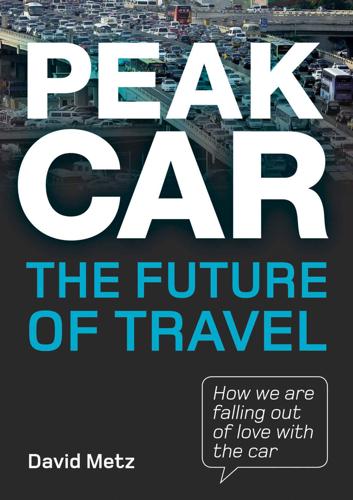
Peak Car: The Future of Travel
by
David Metz
Published 21 Jan 2014
Technologies that forgive us our errors are always helpful, especially in later life, although there will be the need to settle tricky questions of responsibility for crashes. However, it is hard to see any radical change for road users generally, given continued unconstrained access to the road system. You might think it would be useful to send your driverless car travelling around the block while you go into a shop. But then the streets would be jammed with ‘parked’ cars on the move, which evidently could not be permitted. A segregated highway would allow platoons of driverless cars to operate in synchrony, thus increasing the capacity of the road. There have been successful experimental trials of platooning, but both wide practical implementation and economic attractiveness seem problematic.
…
At present we have examples of digital technologies improving journeys with Satnav and smartcard ticketing, and of allowing travel substitution, as when we work at home with access to the full range of information and contacts that we would have in our workplace. But these are not radical innovations. Are there disruptive innovations on the horizon for the transport sector? Consider the driverless cars that are being developed by some manufacturers as well as by Google. The technologies required have been worked on for some years and those already introduced include adaptive cruise control, lane detection, pedestrian recognition, emergency braking and automated parking assistance. Hands‑free driving is the logical extension.
…
This is an chicken-and-egg situation: investment in a segregated highway could only be justified if there were a sufficient number of autonomous vehicles wiling to pay tolls for use, but investment in these vehicles could only be justified if the segregated highway existed. My expectation is that driverless cars, to the extent they penetrate the market, will amount to an incremental improvement, not a disruptive innovation—best regarded as robot chauffeurs. One possible application of this technology would be to taxis, if lower fares increased their attraction to passengers (in which case the innovation would be disruptive to taxi drivers).

The Upstarts: How Uber, Airbnb, and the Killer Companies of the New Silicon Valley Are Changing the World
by
Brad Stone
Published 30 Jan 2017
“This will be because of carpooling services like UberPool and Lyft Line? Or driverless cars?” I asked. A few weeks before, the company had begun testing fourteen Ford Fusions tricked out with autonomous vehicle technology on the streets of Pittsburgh. It had also recently announced a partnership with Volvo to develop driverless-car technology and had acquired Otto, a San Francisco–based startup run by former Google engineers that was working on driverless trucks.1 “All these things that are going to happen, whether it’s human-driven transportation, carpooling, commuting with carpooling, driverless cars,” Kalanick said, “cars are coming off the road.
…
So one evening in August 2013, Kalanick checked into a suite at the Four Seasons Hotel in East Palo Alto, paid for by Google, and woke up the next morning for a ten o’clock meeting with the most powerful man in Silicon Valley. Krane had orchestrated an experience that would blow Kalanick’s mind. When Uber’s CEO came down to the lobby, a prototype driverless car from the Google X lab idled in front of the hotel, waiting to ferry him to Mountain View. Sitting in the front seat was a Google engineer who could answer all his questions. It was Kalanick’s first ride in a self-driving car on real roads. At the Google campus, Kalanick met with Page, Google senior lawyer David Drummond, and Krane’s boss at GV at the time, Bill Maris.
…
After the round closed, Kalanick climbed aboard TPG’s Gulfstream jet with Bonderman, TPG co-founder James Coulter, and Trujillo, as well as investor Shervin Pishevar and his partner Scott Stanford, to visit countries in Asia and gauge the company’s expansion opportunities there. The world seemed wide open. Yet nearly every assumption Kalanick and his investors were making about the future in the fall of 2013 turned out, in the end, to be at least partially incorrect. Google was reluctant to cede the results of its driverless car research to another company and would soon look more like Uber’s mortal enemy, not its ally. Within a year, David Bonderman would leave the board of General Motors, which in 2016 would make a sizable investment in archrival Lyft. And remarkably, according to multiple people familiar with the transaction, when the time came for TPG to purchase its second $88 million allotment of Uber shares at the same valuation, the private equity firm wavered and waited until the last possible moment before attempting to exercise the option.
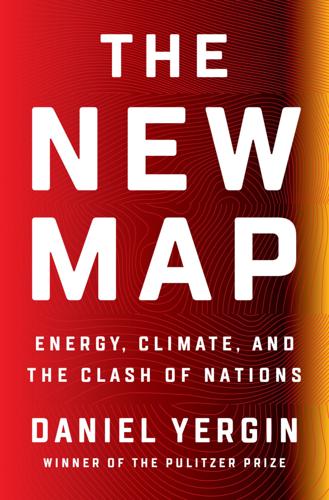
The New Map: Energy, Climate, and the Clash of Nations
by
Daniel Yergin
Published 14 Sep 2020
Unfortunately, things went a little awry. As the New York Times reported in a story headlined “Radio-Driven Auto Runs Down Escort,” the driverless car “careened from left to right down Broadway, around Columbus Circle, and south on Fifth Avenue.” It barely missed two trucks and a milk wagon, collided with a car filled with photographers, and then almost hit a fire engine at 43rd Street. Decades later, in the 1950s, Nebraska’s Department of Roads experimented with driverless cars that would be guided by electric circuits embedded in the road. In the 1980s and 1990s, research groups in the United States and Europe investigated driverless concepts to improve road safety.
…
While operators were in the cars just in case, the key interaction was through the cars’ informational tether back to Google’s enormously powerful data centers.8 The word was out. Google—with its scale and capabilities—had put a stamp on the viability of the driverless car. Google was hardly alone. By then, a host of other tech companies and entrepreneurs were jumping in to tackle the driverless car. Technological advances and falling costs were making it all possible. “There was no way, before 2000, to make something interesting,” Thrun said. “The sensors weren’t there, the computers weren’t there, and the mapping wasn’t there.
…
The sensor data needs to be constantly processed with instant decision following, and that requires a very big brain, exponentially more powerful computing power than found in today’s cars. Software is key; and here the rapid advances in AI—artificial intelligence—and machine learning for image recognition have propelled the driverless car forward more rapidly than might have been expected a few years ago. At lightning speed, the computer has to barrel through vast amounts of data coming from the sensing devices to identify a stop sign or a dog and instantaneously come to a stop. This big brain computer also has to manage the electronic systems units that control braking and steering and ensure that the car swerves around pedestrians who obliviously step into the street without looking up from their smartphones.

The Stack: On Software and Sovereignty
by
Benjamin H. Bratton
Published 19 Feb 2016
Sebastian Thrun, “Google's Driverless Car,” TED, March 2011, http://www.ted.com/talks/sebastian_thrun_google_s_driverless_car. The relative “autonomy” of the car from the driver is a gradient. The design problem is not one of full autonomy of the car replacing full autonomy of the driver, but of varying degrees of cyborgization, drawing on those with which car culture is already comfortable. 56. Steven Levy, In the Plex: How Google Thinks, Works, and Shapes Our Lives (New York: Simon & Schuster, 2011). 57. For those who honestly don't know, the Google driverless car project is a research initiative to develop cars that can autonomously navigate all roads without human steerage (or much of it), using a combination of laser-guided mapping, video cameras, radar, motion sensors, on-board computing, and other tools.
…
From this, other applications are easy to imagine, from the mundane (videoconferencing) to the whimsical (site-specific virtual flora and fauna superimposed over the passing outlines of the landscape) to the ugly (advertising-supported toll routes). See also Ryan Lawler, “Dispatch from the Future: Uber to Purchase 2,500 Driverless Cars from Google,” TechCrunch, April 25, 2013, http://techcrunch.com/2013/08/25/uberauto/. Chunka Mui, “Dispatch from 2023: Google Considers Buying 250,000 Driverless Cars from Tesla, but Buys Tesla Instead,” Forbes, August 29, 2013, http://www.forbes.com/sites/chunkamui/2013/08/29/dispatch-from-2023-google-considers-buying-250000-driverless-cars-from-tesla-but-buys-tesla-instead/. 61. Gary Marcus, “Moral Machines,” New Yorker, November 24, 2012, http://www.newyorker.com/news/news-desk/moral-machines. 62.
…
As Marcus puts it, “These driverless cars will be safer, but when accidents do happen, they may be on the scale of airline disasters” though he may be off by an order of magnitude or two, depending on how deep and pervasive the Cloud vehicle platform does or does not become. 67. From User-Centered Design to the Design of the User These three models for the design of posthuman User—the animal User, as exemplified by the design of reciprocal interfaces between species; the AI User, by the design of idiosyncratic companion personalities; and the machine User, by the infrastructural driverless car platform—in no way exhaust the range of problems and opportunities, but they are instructive in several important ways.

The Second Machine Age: Work, Progress, and Prosperity in a Time of Brilliant Technologies
by
Erik Brynjolfsson
and
Andrew McAfee
Published 20 Jan 2014
This was necessary and valuable, but the real learning, and the real fun, started when we went out into the world. We spoke with inventors, investors, entrepreneurs, engineers, scientists, and many others who make technology and put it to work. Thanks to their openness and generosity, we had some futuristic experiences in today’s incredible environment of digital innovation. We’ve ridden in a driverless car, watched a computer beat teams of Harvard and MIT students in a game of Jeopardy!, trained an industrial robot by grabbing its wrist and guiding it through a series of steps, handled a beautiful metal bowl that was made in a 3D printer, and had countless other mind-melting encounters with technology.
…
But articulating this knowledge and embedding it in software for all but highly structured situations are at present enormously difficult tasks. . . . Computers cannot easily substitute for humans in [jobs like driving]. So Much for That Distinction We were convinced by Levy and Murnane’s arguments when we read The New Division of Labor in 2004. We were further convinced that year by the initial results of the DARPA Grand Challenge for driverless cars. DARPA, the Defense Advanced Research Projects Agency, was founded in 1958 (in response to the Soviet Union’s launch of the Sputnik satellite) and tasked with spurring technological progress that might have military applications. In 2002 the agency announced its first Grand Challenge, which was to build a completely autonomous vehicle that could complete a 150-mile course through California’s Mojave Desert.
…
These videos had been viewed more than 250 million times, and the Academy’s students had tackled more than one billion automatically generated problems.15 Khan Academy was originally aimed at primary-school children, but similar tools and techniques have been also applied to higher education, where they’re known as massive online open courses, or MOOCs. One of the most interesting experiments in this area came in 2011 when Sebastian Thrun, a top artificial intelligence researcher (and one of the main people behind Google’s driverless car), announced with a single email that he would be teaching his graduate-level AI course not only to students at Stanford but also as a MOOC available for free over the Internet. Over 160,000 students signed up for the course. Tens of thousands of them completed all exercises, exams, and other requirements, and some of them did quite well.

Architects of Intelligence
by
Martin Ford
Published 16 Nov 2018
MARTIN FORD: I usually tell people a 10-15-year time frame when they ask me about self-driving cars. Your estimate of five years seems quite optimistic. STUART J. RUSSELL: Yes, five years is optimistic. As I said, I think we’ll be lucky if we see driverless cars in five years, and it could well be longer. One thing that is clear, though, is that many of the early ideas of fairly simple architectures for driverless cars are now being abandoned, as we gain more experience. In the early versions of Google’s car, they had chip-based vision systems that were pretty good at detecting other vehicles, lane markers, obstacles, and pedestrians.
…
I’d recently become engaged, and I had also received an offer from McKinsey to join them in Silicon Valley; and I thought it would be a brief, interesting detour, to go to McKinsey. At the time, like many of my friends and colleagues, such as Bobby Rao, who had also been in the Robotics Research Lab with me, I was interested in building systems that could compete in the DARPA driverless car challenge. This was because a lot of our algorithms were applicable to autonomous vehicles and driverless cars and back then, the DARPA challenge was one of the places where you could apply those algorithms. All of my friends were moving to Silicon Valley then. Bobby was at that time a post-doc at Berkeley working with Stuart Russell and others, and so I thought I should take this McKinsey offer in San Francisco.
…
GARY MARCUS: That’s right, and for the principal reason that if you’re talking about driving in a very heavy metropolitan location like Manhattan or Mumbai, then the AI will face a lot of unpredictability. It’s one thing to have a driverless car in Phoenix, where the weather is good and the population is a lot less densely packed. The problem in Manhattan is that anything goes at any moment, nobody is particularly well-behaved and everybody is aggressive, the chance of having unpredictable things occur is much higher. Even simple road elements like barricades to protect people can cause issues for an AI. These are complex situations that humans deal with by using reasoning. Right now, driverless cars navigate by having highly detailed maps and things like LIDAR, but no real understanding of the motives and behavior of other drivers.
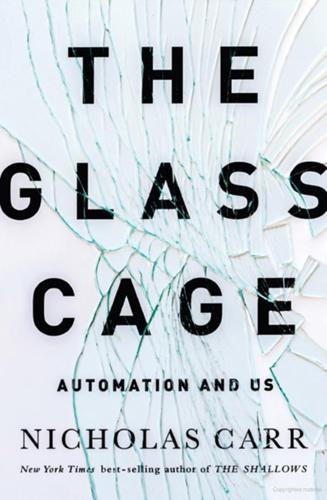
The Glass Cage: Automation and Us
by
Nicholas Carr
Published 28 Sep 2014
The emphasis is Latour’s. 33.Bernhard Seefeld, “Meet the New Google Maps: A Map for Every Person and Place,” Google Lat Long (blog), May 15, 2013, google-latlong.blogspot.com/2013/05/meet-new-google-maps-map-for-every.html. 34.Evgeny Morozov, “My Map or Yours?,” Slate, May 28, 2013, slate.com/articles/technology/future_tense/2013/05/google_maps_personalization_will_hurt_public_space_and_engagement.html. 35.Kirkpatrick, Facebook Effect, 199. 36.Sebastian Thrun, “Google’s Driverless Car,” speech at TED2011, March 2011, ted.com/talks/sebastian_thrun_google_s_driverless_car.html. 37.National Safety Council, “Annual Estimate of Cell Phone Crashes 2012,” white paper, 2014. 38.See Sigfried Giedion, Mechanization Takes Command (New York: Oxford University Press, 1948), 628–712. 39.Langdon Winner, Autonomous Technology: Technics-out-of-Control as a Theme in Political Thought (Cambridge, Mass.: MIT Press, 1977), 285.
…
Many technical challenges remain to be met, such as navigating snowy or leaf-covered roads, dealing with unexpected detours, and interpreting the hand signals of traffic cops and road workers. Even the most powerful computers still have a hard time distinguishing a bit of harmless road debris (a flattened cardboard box, say) from a dangerous obstacle (a nail-studded chunk of plywood). Most daunting of all are the many legal, cultural, and ethical hurdles a driverless car faces. Where, for instance, will culpability and liability reside should a computer-driven automobile cause an accident that kills or injures someone? With the car’s owner? With the manufacturer that installed the self-driving system? With the programmers who wrote the software? Until such thorny questions get sorted out, fully automated cars are unlikely to grace dealer showrooms.
…
They don’t, they haven’t, and they won’t. Artificial intelligence is not human intelligence. People are mindful; computers are mindless. But when it comes to performing demanding tasks, whether with the brain or the body, computers are able to replicate our ends without replicating our means. When a driverless car makes a left turn in traffic, it’s not tapping into a well of intuition and skill; it’s following a program. But while the strategies are different, the outcomes, for practical purposes, are the same. The superhuman speed with which computers can follow instructions, calculate probabilities, and receive and send data means that they can use explicit knowledge to perform many of the complicated tasks that we do with tacit knowledge.

No Ordinary Disruption: The Four Global Forces Breaking All the Trends
by
Richard Dobbs
and
James Manyika
Published 12 May 2015
Thanks to the growing number of people who check the “organ donation” box on their driver’s licenses, fatal automobile accidents have become a significant source of donor organs used in transplants. Should they work as advertised, then, driverless cars might indirectly disrupt the brilliant system through which a tragic accident winds up saving a life. How many of us would be able to make the link between the technology behind driverless cars and the fourth-order impact on the need for artificial hearts, and then plan for the scenario? It may seem far-fetched, but this is how our world works. Like a stone tossed into a placid pond, a breakthrough or innovation in one sector will create ripples that spread outward.
…
Rajat Gupta, Shirish Sankhe, Richard Dobbs, Jonathan Woetzel, Anu Madgavkar, and Ashwin Hasyagar, From poverty to empowerment: India’s imperative for jobs, growth, and effective basic services, McKinsey Global Institute, February 2014. 23. Justin Pritchard, “California pushes to finish driverless car rules,” Associated Press, March 12, 2014, bigstory.ap.org/article/california-pushes-finish-driverless-car-rules. 24. “Striking back: Germany considers counterespionage against US,” Spiegel Online International, February 18, 2014, www.spiegel.de/international/germany/germany-considers-counterespionage-measures-against-united-states-a-953985.html. 25.
…
Their application extends beyond industry to services, robotic surgery, and even human augmentation. Autonomous vehicles are another disruptive technology that has made dramatic advances in a single decade. In 2004, DARPA (Defense Advanced Research Projects Agency) funded the Grand Challenge, a competition that offered $1 million to the first driverless car that could drive 150 miles across the Mojave Desert. Nobody won the prize money; the best-performing car (from Carnegie Mellon) managed a little over 7 miles. Ten years later, Google’s fleet of self-driving cars has already logged 700,000 miles in city streets—with the only accident occurring when a human was operating one of the Toyota Prius cars.

Physics of the Future: How Science Will Shape Human Destiny and Our Daily Lives by the Year 2100
by
Michio Kaku
Published 15 Mar 2011
Like transistors, you could conceivably pack millions of lasers onto a chip the size of your fingernail. DRIVERLESS CAR In the near future, you will also be able to safely surf the Web via your contact lens while driving a car. Commuting to work won’t be such an agonizing chore because cars will drive themselves. Already, driverless cars, using GPS to locate their position within a few feet, can drive over hundreds of miles. The Pentagon’s Defense Advanced Research Projects Agency (DARPA) sponsored a contest, called the DARPA Grand Challenge, in which laboratories were invited to submit driverless cars for a race across the Mojave Desert to claim a $1 million prize.
…
(Some examples of Pentagon projects include the Internet, which was originally designed to connect scientists and officials during and after a nuclear war, and the GPS system, which was originally designed to guide ICBM missiles. But both the Internet and GPS were declassified and given to the public after the end of the Cold War.) In 2004, the contest had an embarrassing beginning, when not a single driverless car was able to travel the 150 miles of rugged terrain and cross the finish line. The robotic cars either broke down or got lost. But the next year, five cars completed an even more demanding course. They had to drive on roads that included 100 sharp turns, three narrow tunnels, and paths with sheer drop-offs on either side.
…
At first, it was a bit eerie noticing that the steering wheel and accelerator pedal were moving by themselves. It felt like there was an invisible, ghostlike driver who had taken control, but after a while I got used to it. In fact, later it became a joy to be able to relax in a car that drove itself with superhuman accuracy and skill. I could sit back and enjoy the ride. The heart of the driverless car was the GPS system, which allowed the computer to locate its position to within a few feet. (Sometimes, the engineers told me, the GPS system could determine the car’s position to within inches.) The GPS system itself is a marvel of modern technology. Each of the thirty-two GPS satellites orbiting the earth emits a specific radio wave, which is then picked up by the GPS receivers in my car.
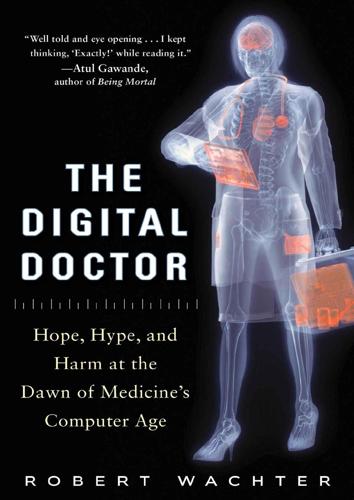
The Digital Doctor: Hope, Hype, and Harm at the Dawn of Medicine’s Computer Age
by
Robert Wachter
Published 7 Apr 2015
More important, as recently as a decade ago, some very smart and savvy computer engineers and economists believed that another seemingly intractable problem, building a driverless car, was beyond the reach of modern technology. Just consider the challenges: a kid running into the street after a soccer ball; a texting teenager swerving in the middle lane; a traffic light on the fritz. And the left turn. “Executing a left turn across oncoming traffic,” two highly respected economists, MIT’s Frank Levy and Harvard’s Richard Murnane, wrote in 2004, “involves so many factors that it is hard to imagine the set of rules that can replicate a driver’s behavior.” Yet six years later, Google’s unveiling of its driverless car demonstrated that this “insoluble problem” had been solved.
…
As of April 2014, the Google car had clocked nearly 700,000 miles and been involved in two accidents. One reportedly occurred after a human took over the wheel, and the other when the Google car was rear-ended by, one presumes, another human driver. The driverless car might well be safer than one controlled by a fallible Homo sapiens. If the driverless car weren’t enough of a challenge to human superiority, who could have watched IBM’s Watson supercomputer defeat the Jeopardy Hall of Famers in 2011 and not fretted about the future of physicians, or any highly skilled workers, for that matter? “Just as factory jobs were eliminated in the twentieth century by new assemblyline robots,” wrote all-time (human) Jeopardy champion Ken Jennings soon after the lopsided match ended, “Brad [Rutter, the other defeated champ] and I were the first knowledge-industry workers put out of work by the new generation of ‘thinking’ machines.
…
Interestingly, this bite-sized approach may ultimately prove to be the best path to the more ambitious goal of the fully digital doctor. While the Google car might technically be ready for a road near you, there’s no shortage of hurdles to surmount, including existing laws that insist on human drivers and the absence of driverless car insurance. But, observed technology journalist Alexis Madrigal in 2014, while it may be many years before our highways are packed with driverless cars, most of us will encounter autonomous driving “in little autopilot moments when we cede temporary control to a computer” as we move from the familiar wonder of cruise control to new features that nudge us back into our lane when we wander or help us parallel park in a tight space.
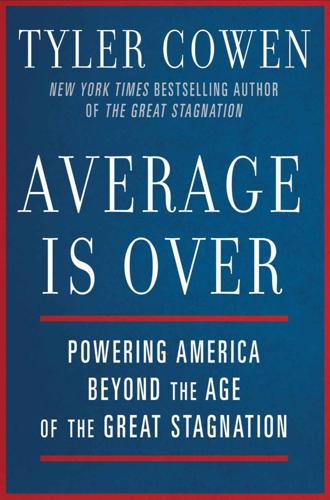
Average Is Over: Powering America Beyond the Age of the Great Stagnation
by
Tyler Cowen
Published 11 Sep 2013
Robot-guided mechanical arms are common in the operating room, and computers spend more time flying our planes than do the pilots. South Korea is experimenting with robotic prison wardens that patrol when the inmates do something wrong and report the misdeeds. Driverless cars are already operating on the streets of Berlin and Nevada, and Florida and California have passed bills to legalize computer-commanded “driverless cars” on their roads. Google’s team has test-driven hundreds of thousands of miles with these cars, so far without an accident or major incident; the one reported five-car pileup happened after a human took over from the computer.
…
Health care is an ethical minefield and arguably we should be especially cautious when evaluating new medical and institutional breakthroughs. In any case, we can expect slower progress. When it comes to mechanized intelligent analysis, patent law can be a problem but for the most part the paths forward are relatively free of regulatory obstacles. Some applications, such as driverless cars, do face potential lawsuits; for instance, imagine the first time an out-of-control driverless car runs down a child. The parents would likely sue the deep-pocketed company that made the car, in addition to suing the owner of the car and maybe also the person who programmed the software of the car. Given this likelihood, there may be delays in turning the cars into marketable products.
…
Mistakes, including moral mistakes, will be ignored and covered up, or possibly never rooted out in the first place. We are again back to that scary world without much accountability for some very important decisions. In other contexts we will not be able to avoid making some very direct moral judgments. Let’s say for instance that you own a driverless car. How should such a car be programmed in case an accident is imminent? Should the car swerve away from hitting a baby carriage, but at the risk of running into two elderly people? Should the car be programmed to crash you into a telephone pole, rather than run a p = 0.6 chance of knocking over a pedestrian?

Road to Nowhere: What Silicon Valley Gets Wrong About the Future of Transportation
by
Paris Marx
Published 4 Jul 2022
Self-Driving Cars Did Not Deliver 1 James Niccolai, “Self-driving Cars a Reality for ‘Ordinary People’ within 5 Years, Says Google’s Sergey Brin,” Computer World, September 25, 2012, Computerworld.com. 2 John Paczkowski, “Google’s Self-Driving Cars Now Legal in California,” All Things D, September 25, 2012, Allthingsd.com. 3 Nicholas Carlson, “Uber Is Planning for a World Without Drivers—Just a Self-Driving Fleet,” Business Insider, May 28, 2014, Businessinsider.com. 4 Kara Swisher, “Self-Driving into the Future: Full Code Conference Video of Google’s Sergey Brin,” Recode, June 11, 2014, Vox.com. 5 Ibid. 6 Adrienne LaFrance, “Your Grandmother’s Driverless Car,” Atlantic, June 29, 2016, Theatlantic.com. 7 Doc Quigg, “Reporter Rides Driverless Car,” Press-Courier, June 7, 1960, News.google.com. 8 “A Brief History of Autonomous Vehicle Technology,” Wired, n.d., Wired.com. 9 Robert D. Leighty, “DARPA ALV (Autonomous Land Vehicle) Summary,” U.S. Army Engineer Topographic Laboratories, March 1986, Apps.dtic.mil. 10 Robert A.
…
But this was hardly the first time that we had been told that autonomous vehicles were going to revolutionize automotive mobility. As vehicles were swamping urban streets and racking up a high death toll through the 1920s and 1930s, demonstrations of “phantom autos” were stunning audiences across the United States. A newspaper in Ohio remarked in 1932 that, “it is true that the driverless car will travel about the city through the heaviest traffic—starting, stopping, sounding its horn, turning right or left, making U-turns and circles, and proceeding thus as though there were an invisible driver at the wheel.”6 They were “one of the most amazing products of modern science,” piloted not by a computer system, but by remote control.
…
The Radio Corporation of America, better known as RCA, started testing a system of wires buried in the pavement to guide vehicles along highways in the 1950s. The “electronic chauffeurs” were designed to eliminate accidents and make the roads safer. When the system was demonstrated for journalists in 1960 using GM vehicles with coils in their front ends to pick up the electromagnetic fields, the Press-Courier declared that RCA had “put the driverless car on the road” and that riding in one “tends to be scary as the ghost, until you get used to it. But someday we may have to live with it.”7 Sixty years later, we still do not have to live with any such thing, but development on the self-driving car continued in the United States and abroad. In 1977, Tsukuba Mechanical showed off its own autonomous vehicle in Japan that improved upon earlier experiments by using two cameras that could detect street markings with a maximum speed of twenty miles per hour.

Future Politics: Living Together in a World Transformed by Tech
by
Jamie Susskind
Published 3 Sep 2018
Peter Campbell, ‘Ford Plans Mass-market Self-driving Car by 2021’, Financial Times, 16 August 2016 <https://www.ft.com/content/ d2cfc64e-63c0-11e6-a08a-c7ac04ef00aa#axzz4HOGiWvHT> (accessed 28 November 2017); David Millward, ‘How Ford Will Create a New Generation of Driverless Cars’, Telegraph, 27 February 2017 <http://www.telegraph.co.uk/business/2017/02/27/ford-seeks- pioneer-new-generation-driverless-cars/> (accessed 28 November 2017). 5. Wei Xiong et al.,‘Achieving Human Parity in Conversational Speech Recognition’, arXiv, 17 February 2017 <https://arxiv.org/abs/ 1610.05256> (accessed 28 November 2017). 6. Yannis M. Assael et al.,‘LipNet: End-to-End Sentence-level Lipreading’, arXiv, 16 December 2016 <https://arxiv.org/abs/1611.01599> (accessed 6 December 2017). 7.
…
Alison Sander and Meldon Wolfgang, ‘The Rise of Robotics’, BCG Perspectives, 27 August 2014 <https://www.bcgperspectives.com/ content/articles/business_unit_strategy_innovation_rise_of_robotics/> (accessed 30 November 2017). 87. Winfield, Robotics, vii. 88. Susskind and Susskind, Future of the Professions, 50. 89. Waymo, Google <https://www.google.com/selfdrivingcar/> (accessed 30 November 2017). 90. Danielle Muoio, ‘Here’s Everything We Know About Google’s Driverless Cars’, Business Insider, 25 July 2016 <http://uk.businessinsider.com/google-driverless-car-facts-2016-7?r=US&IR=T/#thecars-have-been-in-a-few-minor-accidents-only-one-of-whichcould-be-argued-to-have-been-the-google-cars-fault-11> (accessed 30 November 2017). 91. Wallach, Dangerous Master, 220; Bryant Walker Smith, ‘Human Error as a Cause of Vehicle Crashes’, Stanford Center for Internet and Society, 18 December 2013 <http://cyberlaw.stanford.edu/blog/ 2013/12/human-error-cause-vehicle-crashes> (accessed 30 November 2017). 92.
…
Future of Work Hub, 4 Apr. 2017 <http://www.futureofworkhub.info/comment/2017/4/4/numbers-data-and-algorithmswhy-hr-professionals-and-employment-lawyers-should-take-data- science-seriously> (accessed 1 Dec. 2017). Millward, David. ‘How Ford Will create a new generation of driverless cars’. Telegraph, 27 Feb. 2017 <http://www.telegraph.co.uk/business/ 2017/02/27/ford-seeks-pioneer-new-generation-driverless-cars/> (accessed 28 Nov. 2017). Milton, John. Paradise Lost. London: Penguin, 2003. Misra,Tanvi.‘3 Cities Using Open Data in Creative Ways to Solve Problems’. CityLab, 22 Apr. 2015 <http://www.citylab.com/cityfixer/2015/04/3cities-using-open-data-in-creative-ways-to-solve-problems/391035/> (accessed 29 Nov. 2017).

Robot Rules: Regulating Artificial Intelligence
by
Jacob Turner
Published 29 Oct 2018
Kazuo Yano, “Enterprises of the Future Will Need Multi-purpose AIs”, Hitachi Website, http://www.hitachi.co.jp/products/it/it-pf/mag/special/2016_02th_e/interview_ky_02.pdf, accessed 1 June 2018. 41UK Department of Transport, “The Pathway to Driverless Cars: Detailed Review of Regulations for Automated Vehicle Technologies”, UK Government Website, February 2015, https://www.gov.uk/government/uploads/system/uploads/attachment_data/file/401565/pathway-driverless-cars-main.pdf, accessed 1 June 2018. 42When in 2017 the UK’s House of Lords Science and Technology Select Committee published a report entitled “Connected and Autonomous Vehicles: The Future?”
…
Gaikwad, Edmond Awad, Sohan Dsouza, Iyad Rahwan, Pradeep Ravikumar, and Ariel D. Procaccia, “A Voting-Based System for Ethical Decision Making”, arXiv:1709.06692v1 [cs.AI], accessed 1 June 2018. 43Oliver Smith, “A Huge Global Study On Driverless Car Ethics Found the Elderly Are Expendable”, Forbes, 21 March 2018, https://www.forbes.com/sites/oliversmith/2018/03/21/the-results-of-the-biggest-global-study-on-driverless-car-ethics-are-in/#7fbb629f4a9f, accessed 1 June 2018. 44Joel D’Silva and Geert van Calster, “For Me to Know and You to Find Out? Participatory Mechanisms, the Aarhus Convention and New Technologies”, Studies in Ethics, Law, and Technology, Vol. 4, No. 2 (2010). 45Strictly speaking, DeepMind is UK based, though it is a subsidiary of Alphabet, the US-based parent of Google. 46“Homepage”, Website of the Partnership on AI , https://www.partnershiponai.org/, accessed 1 June 2018.
…
However, these will be autonomous in the relevant sense so long as the software within the vehicles, which may come from a single central hub and be sent to the individual vehicles via the Internet, contains features which would qualify as AI within this book’s definition. See, for example, Joel Achenbach, “Driverless Cars Are Colliding with the Creepy Trolley Problem”, Washington Post, 29 December 2015, https://www.washingtonpost.com/news/innovations/wp/2015/12/29/will-self-driving-cars-ever-solve-the-famous-and-creepy-trolley-problem/?utm_term=.30f91abdad96, accessed 1 June 2018; Jean-François Bonnefon, Azim Shariff, and Iyad Rahwan, “The Social Dilemma of Autonomous Vehicles”, Cornell University Library Working Paper, 4 July 2016, https://arxiv.org/abs/1510.03346, accessed 1 June 2018. 107The scenario involving a criminal pedestrian was posed by researchers at MIT, in their “Moral Machine” game, which is described by its designers as “A platform for gathering a human perspective on moral decisions made by machine intelligence, such as self-driving cars.
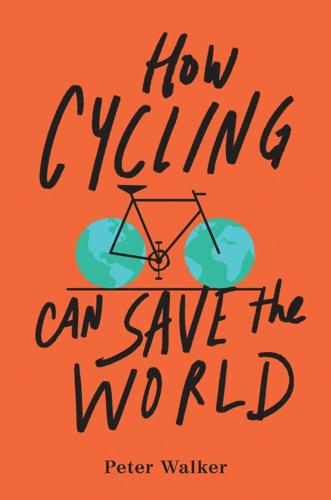
How Cycling Can Save the World
by
Peter Walker
Published 3 Apr 2017
Rechargeable lights now fit into a pocket, and the main issue is trying not to dazzle or hypnotize drivers with the multiple flashing LEDs. So all praise to innovation. But sometimes the benefits come in less obvious ways—for example, the advent of bar-code keys for cycle-share systems, or improved batteries in e-bikes. Elsewhere cycling can be the almost indirect beneficiary of other tech upheavals. The imminent arrival of driverless cars and automated traffic systems is likely to reshape our cities in ways we can barely imagine, but around which the bike seems likely to play a crucial role. The revolution has arrived. It’s just not always the one you expected. But How Do You Move a Fridge? Technology also plays a big role in answering one of the most common arguments you hear against making over more of a city’s road space to bikes.
…
“Just now the walking distances don’t allow the metro systems to penetrate very far into residential districts. A bicycle-sharing system extends that by about three times.”11 Anand Babu, meanwhile, is imagining bikes having a key role to connect with a more high-tech transport system—high-speed driverless cars. Babu, formerly head of special projects for Google, is now chief operating officer of Sidewalk Labs, a new and vastly ambitious Google spin-off that has as its modest intention to reshape cities through the conjunction of clever planning and high-tech solutions. Sidewalk Labs has so far devised LinkNYC, a project to turn New York City’s defunct pay-phone booths into digital hubs, where people can either access Wi-Fi or, if they don’t have a smartphone or similar device, find information directly.
…
He does, however, predict that in transport terms there are likely to be big changes in what he calls the “20–100 mph range,” taking in cars and what might replace them, and the “10–20 mph range,” covering cycling and other short-range travel modes. Not surprisingly for someone whose parent company is at the forefront of developing driverless car technology, Babu expects such creations to be in use soon. They could have a huge and immediate impact, he believes, especially on spread-out US cities, where some suburbs have become neglected, in part because of the time it takes to travel to and from them. Since existing cars would take time to be replaced, Babu says, the near future could see lanes of freeways reserved for driverless vehicles, transporting people between distant points at high speed.
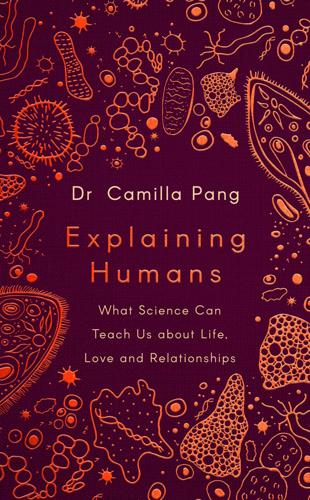
Explaining Humans: What Science Can Teach Us About Life, Love and Relationships
by
Camilla Pang
Published 12 Mar 2020
Compared to traditional machine learning, a neural network is more independent and requires less input from the programmer to define what it should be searching for, since, through internal layers of logic, it is able to create its own connections. All of the more radical examples of artificial intelligence you may have read about – from fully driverless cars to mass automation of people’s jobs – ultimately rely on deep learning, the closest we have so far got to developing a computer program that can think (within considerable limitations) like a human. Deep learning is also responsible for applications, including criminal checks, drug design, and the computer programs that rival the most competent chess players, all of which depend on an ability to simulate the connective capability of the human mind.
…
Deep learning is also responsible for applications, including criminal checks, drug design, and the computer programs that rival the most competent chess players, all of which depend on an ability to simulate the connective capability of the human mind. Modelled on the brain, a neural network is made up of neurons – in this case, the various data inputs. These come in three layers: input, output and in the middle what is called ‘hidden’, the place where the algorithm does its thinking. For example, if we take a driverless car, inputs will include the angle of the road, the speed of the car, proximity to other vehicles, the weight of passengers, and any obstacles on the road – all factors that determine the nature of the outputs, which are the decisions the algorithm makes about how to drive safely. It is the connections between these neurons, and how they fire, that really matter.
…
The crucial aspect to a neural network is that the connections have a virtual ‘weight’ assigned to them, affecting their influence on the network and output. It’s by comparing and calculating the weights of these inputs that the program reaches its decisions, learning which inputs to trust as most indicative of a particular result. With our driverless car example, it’s likely to be speed and proximity of obstacles (which could be pedestrians or other vehicles) that have the heaviest weighting and the greatest influence on decisions. The ultimate aim of a neural network is, over time and extensive trial and error, to assign the most accurate values to these weighted connections, so it can consider new inputs with the priority (high or low) that they deserve.

Alchemy: The Dark Art and Curious Science of Creating Magic in Brands, Business, and Life
by
Rory Sutherland
Published 6 May 2019
Hillary thinks like an economist, while Donald is a game theorist, and is able to achieve with one tweet what would take Clinton four years of congressional infighting. That’s alchemy; you may hate it, but it works. Some scientists believe that driverless cars will not work unless they learn to be irrational. If such cars stop reliably whenever a pedestrian appears in front of them, pedestrian crossings will be unnecessary and jaywalkers will be able to march into the road, forcing the driverless car to stop suddenly, at great discomfort to its occupants. To prevent this, driverless cars may have to learn to be ‘angry’, and to occasionally maliciously fail to stop in time and strike the pedestrian on the shins. If you are wholly predictable, people learn to hack you.
…
Among heavy drinkers, the brain doesn’t wait for the booze to kick in – it shortcuts straight to the expected level of drunkenness. *Respectively a kind of supercharged jet engine and a form of high-speed land travel through tunnels from which all air, and hence air-resistance, has been removed. *Before we get too excited by the economic prospects of the driverless car, it is worth considering what this technology might offer to terrorists, for instance. A driverless car is effectively a cruise missile on wheels. *Goldfinger. In the film, Bond tracks Auric Goldfinger’s Rolls-Royce to his Alpine lair using an animated map installed in his Aston Martin. *I’m largely with Thomas – I don’t do much DIY, but I would acknowledge that my principal interest in cooking is not primarily the preparation of food: it’s an excuse to buy kitchen gadgetry.
…
If that is the case, the good news for the vaping industry is that one common objection to it can be rejected, though the bad news is that e-cigarette sales may shrink as they run out of former smokers to convert. 1.3: Psychological Moonshots Alphabet, the parent company of Google, runs a division that is now simply called ‘X’. It was founded as Google X, with the aim of developing what the company calls ‘moonshots’. A moonshot is an incredibly ambitious innovation; instead of pursuing change by increments, it aims to change something by a factor of ten. For instance, X funds research into driverless cars, with the explicit aim of reducing road-accident fatalities by at least 90 per cent. The argument for X is that the major advances in human civilisation have come from things that, rather than resulting in modest improvement, were game-changers – steam power versus horse power, train versus canal, electricity versus gaslight.

System Error: Where Big Tech Went Wrong and How We Can Reboot
by
Rob Reich
,
Mehran Sahami
and
Jeremy M. Weinstein
Published 6 Sep 2021
The World Health Organization estimates that there were 1.25 million road traffic deaths globally in 2013. In 2017, 37,133 people were killed in motor vehicle crashes in the United States alone, and more than 90 percent of those crashes involved human error. Of course, in assessing the question of safety, we need to ask how safe is safe enough for driverless cars to become the norm. It’s important to remember that a driverless car need not be perfect, it just needs to be better than a human driver. And as the statistics indicate, humans aren’t such great drivers—we are error prone, sometimes piloting vehicles while overly tired, distracted by text messaging, or drunk. Numerous other arguments have been made for the benefits of driverless vehicles, including making commuting time more productive (estimated to save hundreds of billions of dollars annually in the United States alone), reducing fuel consumption by having cars “platoon” or flock together by coordinating their movements, increasing the throughput of existing roads (since self-driving cars won’t need as much space separating them while they drive), and even reducing the need for parking spaces.
…
Numerous other arguments have been made for the benefits of driverless vehicles, including making commuting time more productive (estimated to save hundreds of billions of dollars annually in the United States alone), reducing fuel consumption by having cars “platoon” or flock together by coordinating their movements, increasing the throughput of existing roads (since self-driving cars won’t need as much space separating them while they drive), and even reducing the need for parking spaces. So what could possibly be the downside of deploying driverless cars? Well, first we need to figure out whether they work, and that turns out to be a tough question to answer. Beyond demonstrating that driverless cars can make low-level decisions, such as following the rules of the road and avoiding accidents, we need to understand how they make more complex high-level decisions. For example, when confronted with a choice about whether to swerve into a bicycle lane to protect the car’s driver or to harm parents bicycling with their children, what should the autonomous system that pilots the car be programmed to do?
…
Hal Varian: Aaron Smith and Janna Anderson, “AI, Robotics, and the Future of Jobs,” Pew Research Center, August 6, 2014, https://www.pewresearch.org/internet/2014/08/06/future-of-jobs/. dentists and clergy remain relatively safe: Ibid. More than 40 percent: Mark Fahey, “Driverless Cars Will Kill the Most Jobs in Select US States,” CNBC, September 2, 2016, https://www.cnbc.com/2016/09/02/driverless-cars-will-kill-the-most-jobs-in-select-us-states.html. automation may have beneficial effects: Daron Acemoglu and Pascual Restrepo, “Artificial Intelligence, Automation and Work” (NBER Working Paper Series Working Paper 24196, January 2018), 43.

On the Future: Prospects for Humanity
by
Martin J. Rees
Published 14 Oct 2018
We are already seeing the hackability of the ever more sophisticated software and security systems found in automobiles. Can we confidently protect brakes and steering against hacking? An oft-quoted benefit of driverless cars is that they will be hired and shared rather than owned. This could reduce the amount of parking space needed in cities—blurring the line between public and private transport. But what is not clear is how far this will go—whether the wish to possess one’s own car will indeed disappear. If driverless cars catch on, they will boost road travel at the expense of traditional rail travel. Many people in Europe prefer taking the train for a 200-mile journey; it is less stressful than driving and opens up time to work or read.
…
But for interactions with humans, or even with the complex and fast-changing environment encountered by a driverless car on an ordinary road, processing power is not enough; computers would need sensors that enable them to see and hear as well as humans do, and the software to process and interpret what the sensors relay. But even that would not be sufficient. Computers learn from a ‘training set’ of similar activities, where success is immediately ‘rewarded’ and reinforced. Game-playing computers play millions of games; photo-interpreting computers gain expertise by studying millions of images; for driverless cars to achieve this expertise, they would need to communicate with one another, to share and update their knowledge.
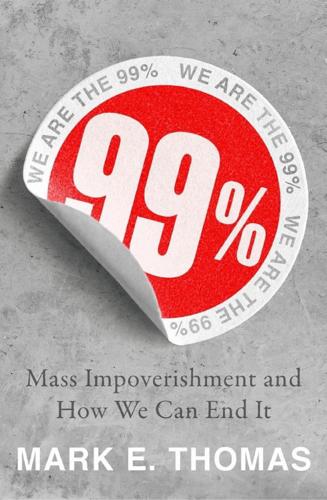
99%: Mass Impoverishment and How We Can End It
by
Mark Thomas
Published 7 Aug 2019
Many commentators believe that the first commercially available self-driving cars will hit the market before 2020.9 The heads of automakers General Motors and Nissan have both confirmed that they expect driverless cars on the roads by 2020. Widespread adoption is harder to predict but the CEO of Uber has said that he expects his entire fleet to be driverless by 2030.10 Initially, like many other innovations in the automotive sector, driverless cars may be more expensive but the costs are likely to fall over time until – like automatic gearboxes, electric windows and in-car entertainment systems – they become commonplace. So commonplace that sometime in the 2020s, you will find yourself riding in a driverless car. Full AI As Professor Nick Bostrom of Oxford University has written: … expert opinions about the future of AI vary wildly.
…
Currently, for example, around 13 per cent of the US population are employed in the Retail and Transportation industries.25 There are signs that many of these jobs will not exist in a few years’ time – we have self-service checkouts in supermarkets; some fast food restaurants have introduced screen-based ordering; driverless trains are a reality today; driverless cars have already reached a high level of technical proficiency, and cars with some degree of autonomy (e.g. motorway driving) are already on the market; warehouses increasingly use automated picking and packing technologies. In these areas alone, we could see tens of millions of jobs disappear. But this is just the beginning.
…
Appendix I – What Current Policies Would Mean for 2050 (Supporting analysis for Chapter 1) Appendix II – Comparison of Golden Age and Market Capitalism (Supporting analysis for Chapter 2) Appendix III – Mass Impoverishment (Supporting analysis for Chapter 3) Appendix IV – The Impact of Poverty Appendix V – Automation (Supporting analysis for Chapter 5) Appendix VI – How Current Policy Sustains Mass Impoverishment (Supporting analysis for Chapter 7) Appendix VII – Myth Busting (Supporting analysis for Chapters 9 to 12) Appendix VIII – What Makes a Happy Society (Supporting analysis for Chapter 13) Appendix IX – Two Stories of Value Creation Appendix X – Bibliography (Full details and website links for data and citations) Endnotes How This Book Came About 1 McKinsey Global Institute, 2016 2 Tatlow, 2017 3 Wearden & Fletcher, 2017 4 Monaghan, 2017 5 Bulman, 2017 Chapter 0: Economics – The Five Things You Need to Know 1 Wren-Lewis, 2014 2 Ghizoni, 1971 3 McLeay, Radia, & Thomas, 2014 4 If you are curious, the paper by McLeay, Radia, & Thomas does an excellent job of explaining it 5 ONS, 2015 6 Credit Suisse, 2015 7 OECD, 2015 8 OECD, 2015 Part 1: The Burning Platform 1 Machiavelli, Niccolò, The Prince, 1532 2 Conner, 2012 Chapter 1: The Age of Anxiety 1 Benarde, 1973 2 Stanley, 2017 3 CNBC, 2014 4 Shelter, 2016 5 Centres for Disease Control and Prevention, 2017 6 Jivanda, 2014 7 Centre for Poverty Research, University of California, Davis, 2018 8 Centre for Poverty Research, University of California, Davis, 2018 9 US Census Bureau, 2018 10 Deaton, 2018 11 Again, Appendix I contains the basis for these estimates 12 US Census Bureau, 2018 13 O’Brien, 2014 Chapter 2: A Tale of Two Systems 1 Dickens, Charles, A Tale of Two Cities, London, 1859 2 Macrotrends, 2018 3 Spence, 2018 4 Lawson, 1992 5 Duncan, 2010 6 BBC, 2009 7 Pfanner, 2008 8 Financial Crisis Inquiry Commission, 2011 9 Evans, 2018 10 Campbell, Denis, ‘Hidden toll of ambulance delays at A&E revealed’, The Guardian, 2 April 2018 11 Campbell, Denis , Marsh, Sarah and Helm, Toby, ‘NHS in crisis as cancer operations cancelled due to lack of beds’, The Guardian, 14 January 2017 12 Bureau of Economic Analysis, 2015 / St Louis Federal Reserve Bank, 2015 Chapter 3: Mass Impoverishment – Coming to a Street Near You 1 Córdoba & Verdier , 2007 2 Robbins, 1935 3 Mankiw, 2009 4 Federal Reserve Bank of St Louis, 2018 5 St Louis Federal Reserve, 2016 6 Anderson & Pizzigati, 2018 7 Bureau of Labor Statistics, 2015 8 Food and Agriculture Organization of the United Nations, 2017 9 World Hunger, 2016 10 Sen, 2001 11 Federal Reserve Bank of St Louis, 2018 12 Statista, 2018 13 See the full analysis in Appendix III 14 May, We can make Britain a country that works for everyone, 2016 15 World Bank, 2018 16 OECD, 2018 17 Glasmeier, 2015 18 Centre for Research in Social Policy, 2015 19 Tiplady, 2017 20 Buffett, 2015 21 OECD, 2015 Chapter 4: An Alternative Morality 1 Wilde, Oscar, Lady Windemere’s Fan; London, 1893 2 Oxford Dictionaries, 2018 3 Soros, George, The Crisis of Global Capitalism: Open Society Endangered, New York, 1998 4 Melin, 2017 5 Ziprecruiter.com, 2018 6 Morningstar.com, 2018 7 Davidson, James Dale and Rees-Mogg, William, The Sovereign Individual (London, 1997), p. 131 8 Sohn, 2014 9 Romney, Full Transcript Mitt Romney, 2012 10 Davidson, James Dale and Rees-Mogg, William, The Sovereign Individual (London, 1997), p. 310 11 Davidson, James Dale and Rees-Mogg, William, The Sovereign Individual (London, 1997), p. 393 12 Thiel, 2009 13 Davidson, James Dale and Rees-Mogg, William, The Sovereign Individual (London, 1997), p. 140 14 Cowen, 2013 15 Mason, Rowena, ‘Benefit freeze to stay for working people costing typical family £300 a year’, The Guardian, 27 November 2017. 16 Tighe & Rovnick, 2018 17 Morley N., 2017 18 Greenfield & Marsh, 2018 19 Fleming, 2018 20 Wikipedia, 2018 Wikipedia, 2018 21 Mayer, 2016 22 Freedland, 2017 Chapter 5: The Fork in the Road 1 Carney, Mark, ‘Keeping the patient alive: Monetary policy in a time of great disruption’, World Economic Forum, 6 December 2016 2 Miller, 2014 3 US Census Bureau, 2015 4 Rigby, 2016 5 Royal Academy of Engineering, 2013 6 University of Manchester, 2016 7 Walsh, 2016 8 Kirkpatrick & Light, 2015 9 Driverless car market watch, 2016 10 Yadron, 2016 11 Bostrom, Superintelligence: paths, dangers, strategies, 2014 12 United Nations, 2016 13 ITER, 2016 14 Culham Centre for Fusion Energy, 2016 15 Noakes, 2016 16 Hudson, 2013 17 Murgia, 2016 18 Rajesh, 2015 19 Smart Cities Council, 2016 20 The Ellen MacArthur Foundation, 2016 21 Andersen, 2006 22 Allen R.

The Innovation Illusion: How So Little Is Created by So Many Working So Hard
by
Fredrik Erixon
and
Bjorn Weigel
Published 3 Oct 2016
He should know because he has analyzed 158,000 early companies, and almost two-thirds of them experienced one or more consecutive years of decline in the third to fifth year of existence.19 Behind those numbers hides an army of entrepreneurs battling with market complexity every single day. Take driverless cars. Listening to the current hype may make you think you will be able to own and be driven by one soon. But the technological development of driverless cars has been going on for decades and, from a market perspective, it has not come particularly far. Not more than 20 percent of the cars sold in 2015 had embedded connectivity solutions. Industry analysts believe it will take many years for the necessary infrastructure to be in place before they become commonplace.
…
The world, as The Economist put it, will be a “planet of phones.”7 Advances in technology are not just confined to the mobile sector. Many discoveries and innovations coming out of science labs are astonishing. In 1964 Isaac Asimov predicted a world of robots, and cars with “robot brains”; this no longer seems like science fiction.8 Driverless cars can be seen on American roads, and the flying car may not be far behind. Commercial and affordable space flights could be a reality in the next decade. Our generation, born in the 1970s, may live to see the first human mission to Mars. Medical devices are also experiencing a revolution. Advanced surgery can now be performed by robots, observed and managed remotely by a surgeon.
…
The coordination required to make the various regulations bearing on intelligent vehicles interoperable can easily fail, squandering a substantial part of their promise. In several countries, there have to be regulatory and legal innovations to circumvent the potential effects of such a basic legal provision as the assignment of liability in the event of accidents. Or, to put it differently: if a driverless car crashes or causes an accident, who should be blamed – the owner of the car or the producer of the car, or perhaps the company producing its software? Some companies are experimenting with different solutions, but it is a highly contentious issue. As two leading experts in transportation in the United States soberly note, “the major obstacle to motorists and firms from adopting them as soon as possible is whether the government will take prudent and expeditious approaches to help resolve important questions about assigning liability in the event of an accident, the availability of insurance, and safety regulations.”21 Prudent and expeditious approaches, however, are not the main characteristics of Western regulators and their political masters.
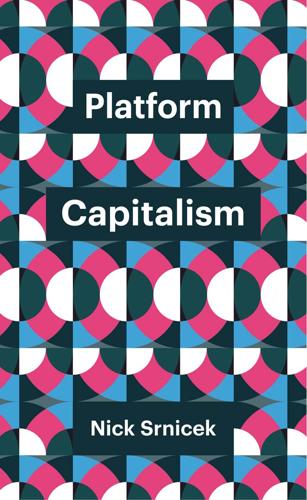
Platform Capitalism
by
Nick Srnicek
Published 22 Dec 2016
By 2015, global mergers and acquisitions had shot up more than 40 per cent above pre-crisis levels,30 and the leading platforms have all made major moves in acquiring the resources needed to compete with their rivals. Ultimately, we see convergence – and therefore competition – across the field: smartphones, e-book readers, consumer IoT, cloud platforms, videochat services, payment services, driverless cars, drones, virtual reality, social networking, interfaces, network provision, search, and probably much more in the future. A third dominant tendency is the funnelling of data extraction into siloed platforms. When extensive means are not sufficient for competitive advantage, this approach tries to tie users and data to the platform by locking them in through various measures: dependency on a service, inability to use alternatives, or lack of data portability, for instance.
…
Combined with stagnant wages and rising inequality, this future depicts a world with a massively increased digital divide. Finally, in the event of a major cutback on advertising, these platforms could be forced to cut back on all extravagant spending on long-shot ventures (drones, virtual reality, driverless cars, etc.), and to return to their core businesses. The cross-subsidisation of these ventures would come to an end, as would their ability to compete with other major platforms. In any case, the capitalist imperative to generate a profit means that these platforms will be forced either to develop novel means of extracting a surplus from the general economic pie or to fold their expansive cross-subsidising monopolies into much more traditional business forms.
…
Platforms continue to expand across the economy, and competition drives them to enclose themselves increasingly. Platforms dependent on advertising revenues are compelled to transition more into direct payment businesses. Meanwhile lean platforms dependent on outsourcing costs and on venture capital largesse either go bankrupt or shift into product platforms (as Uber is attempting to do with driverless cars). In the end, it appears that platform capitalism has inbuilt tendencies to move towards extracting rents by providing services (in the form of cloud platforms, infrastructural platforms, or product platforms). In terms of profitability, Amazon is more the future than Google, Facebook, or Uber.

The Internet Is Not the Answer
by
Andrew Keen
Published 5 Jan 2015
According to the consultancy Booz, the market for connected cars is about to explode, with demand expected to quadruple between 2015 and 2020 and generate revenues of $113 billion by 2020.27 But even today’s connected car is a data machine, with the onboard cameras from Mercedes-Benz’s new S-Class saloon already generating 300 gigabytes of data per hour about the car’s location and speed and the driver’s habits.28 And then there’s Google’s driverless car, an artificially intelligent, networked car that is driven by software called Google Chauffeur. The idea of driverless cars might sound as science fictional as the idea of augmented reality glasses—but Nevada and Florida have already passed laws permitting their operation and the sight of trial versions of Google’s automated cars driving themselves up and down Route 101 between San Jose and San Francisco is not an uncommon one. While there’s no doubt that driverless cars do have enormous potential benefits, particularly in terms of safety and convenience, not to mention the potential environmental benefits of much lighter and thus more energy-efficient vehicles, Google’s pioneering role in them is deeply problematic.
…
In the mid-1990s, it was the original Web 1.0 revolution of free websites like Netscape, Yahoo, and Craigslist. In 2005, it was Tim O’Reilly’s Web 2.0 user-generated-content revolution of Google, Wikipedia, and YouTube. And today, in 2014, it’s the “Internet of Things” revolution of 3-D printing, wearable computing, driverless cars, and intelligent drones. To learn more about today’s revolution, I had returned to the scene of my original disenchantment with the Internet. I’d once again come to the O’Reilly Media offices in Sebastopol, the little town up in Sonoma County, California, some fifty miles north of San Francisco.
…
The software that powers their cars, Google Chauffeur, is essentially the automotive version of Google Glass, a “free” product designed to track everywhere we go and to feed all that data back to the main Google database so that it can connect the dots of our lives. As the Wall Street Journal columnist Holman Jenkins notes about these so-called autonomous driverless vehicles, “they won’t be autonomous at all,” and they may “pose a bigger threat to privacy than the NSA ever will.”29 After all, if Google links the data collected from its driverless cars with data amassed from the rest of its ubiquitous products and platforms—such as the smartphone it is developing that uses 3-D sensors to automatically map our physical surroundings so that Google always knows where we are30—then you have a surveillance architecture that exceeds even anything that Erich Mielke, in his wildest imagination, ever dreamed up.

The New Class Conflict
by
Joel Kotkin
Published 31 Aug 2014
Jeff Foust, Twitter post, October 16, 2013, 8:24am, https://twitter.com/jeff_foust/status/390498497428209664; Jaclyn Trop and Diane Cardwell, “Tesla Plans $5 Billion Battery Factory for Mass-Market Electric Car,” New York Times, February 27, 2014. 77. Tim Worstall, “Google To Build Its Own Driverless Cars,” Forbes, August 24, 2013, http://www.forbes.com/sites/timworstall/2013/08/24/google-to-build-its-own-driverless-cars; Jennifer Booton, “Google, Apple Tackle the Next Digital Frontier: Cars,” FOX Business, January 06, 2014, http://www.foxbusiness.com/technology/2014/01/06/google-apple-tackle-next-digital-frontier-cars; Neal E. Boudette and Daisuke Wakabayashi, “Google, Apple Forge Auto Ties,” Wall Street Journal, December 29, 2013. 78.
…
As they gather huge technical and financial resources, firms such as Google have begun to utilize their dominance of critical software niches, including but not limited to Internet search, to gather enormous financial and technical resources. This has allowed them to move into a host of fields, such as robotics, energy, mapping, driverless cars, and aging, that have great potential but which are not directly related to their core business. Other tech firms, such as Apple, have made similar forays.67 In many ways, the shift of resources from social media and advertising to such fields as robotics and space travel has to be considered a basically positive development.
…
Other tech firms, such as Apple, have made similar forays.67 In many ways, the shift of resources from social media and advertising to such fields as robotics and space travel has to be considered a basically positive development. The social media revolution may thrill people with games and virtual community, but it appears to have done relatively little to enhance the overall productivity of the economy. Viewed this way, investing in more significant breakthroughs, such as space travel or driverless cars, certainly represents a significant improvement in the potential returns to society of the top tech firms.68 This is not to say that these firms’ investments will all work out well. Microsoft and Google, for example, have had their share of failures as they have sought to break out of their core businesses.

Restarting the Future: How to Fix the Intangible Economy
by
Jonathan Haskel
and
Stian Westlake
Published 4 Apr 2022
Why doesn’t productivity growth remain unchanged until the new wave boosts it again? The answer lies in how we measure productivity. Think of the driverless car. Very large amounts of money have been spent on the software, hardware, and testing of driverless cars. But at the time of this writing, driverless cars are not in common use. Now consider the measurement of productivity, which is defined as output per unit of input. In developing driverless cars we have greatly increased our inputs, but we have not yet reaped the benefits of the output. According to the mismeasurement hypothesis, this phenomenon is fairly widespread.
…
For some, another troubling aspect of competition in the modern economy is the overwhelmingly conglomerate nature of some of our new firms. Amazon started as a bookseller. It now produces movies and sells web hosting; Google has moved from a search engine to online advertising to an email service to driverless cars. This increasingly conglomerate nature of the economy reminds many of the industrial structure of the 1960s, when large conglomerates dominated many industries. That story did not end well: conglomerates were sluggish and unproductive, and most ended up being broken up by market forces. In sum, many people see increased concentration, increased insulation of the leaders from the laggards, and the trend towards conglomerates as indications of a lack of competition.

Rise of the Robots: Technology and the Threat of a Jobless Future
by
Martin Ford
Published 4 May 2015
,” New Yorker, November 25, 2013, http://www.newyorker.com/reporting/2013/11/25/131125fa_fact_bilger?currentPage=all. 16. John Markoff, “Google’s Next Phase in Driverless Cars: No Steering Wheel or Brake Pedals,” New York Times, May 27, 2014, http://www.nytimes.com/2014/05/28/technology/googles-next-phase-in-driverless-cars-no-brakes-or-steering-wheel.html. 17. Kevin Drum, “Driverless Cars Will Change Our Lives. Soon.,” Mother Jones (blog), January 24, 2013, http://www.motherjones.com/kevin-drum/2013/01/driverless-cars-will-change-our-lives-soon. 18. Lila Shapiro, “Car Wash Workers Unionize in Los Angeles,” Huffington Post, February 23, 2012, http://www.huffingtonpost.com/2012/02/23/car-wash-workers-unionize_n_1296060.html. 19.
…
Tom Simonite, “Data Shows Google’s Robot Cars Are Smoother, Safer Drivers Than You or I,” Technology Review, October 25, 2013, http://www.technologyreview.com/news/520746/data-shows-googles-robot-cars-are-smoother-safer-drivers-than-you-or-i/. 10. See ibid. for Chris Urmson’s comments. 11. “The Self-Driving Car Logs More Miles on New Wheels” (Google corporate blog), August 7, 2012, http://googleblog.blogspot.co.uk/2012/08/the-self-driving-car-logs-more-miles-on.html. 12. As quoted in Heather Kelly, “Driverless Car Tech Gets Serious at CES,” CNN, January 9, 2014, http://www.cnn.com/2014/01/09/tech/innovation/self-driving-cars-ces/. 13. For US accident statistics, see http://www.census.gov/compendia/statab/2012/tables/12s1103.pdf; for global accident statistics, see http://www.who.int/gho/road_safety/mortality/en/. 14.
…
See Defense Advanced Research Projects Agency (DARPA) debt deflation and, 217 financial crisis and, 218–219 income inequality and consumer spending, 214 ratio to income, 199–200 Deep Blue computer, xiv, 97–98, 122 deep learning, 92–93, 121, 231 Defense Advanced Research Projects Agency (DARPA), 80, 181–183 deflation, 216–217 Delta Electronics, Inc., 10 Delta Cost Project, 140 demand, 196–197 in China, 223–227 productivity and, 207–208 Democrats, income distribution preferred by, 47n design philosophy, 254–255 developing countries, 10–12, 25, 78–79 diagnostic tool, repurposing Watson as, 102–103 digital computer, effect of, 33–34 digital divide, 78 digital economy, long-tail opportunities in, 76–78 DiNardo, Courtney, 148 disruptive technology, xviii, 66 division of labour, 73 Dow News Service, 113–114 Drexler, K. Eric, 241–242, 243, 244–245, 246, 247 driverless cars, See autonomous cars drone-based delivery, 190n drug prices, 170–171 Drum, Kevin, 188 Dunning, David, 18–19 dystopian future, automation and predictions of, 31–32, 219–220 Earned Income Tax Credit (EITC), 271, 277 eBay, 16, 76 economic argument for guaranteed income, 264–267 economic growth, 65, 212–215 economic mobility, decrease in, 46–47 economic policy, 57–58, 217–218 Economic Policy Institute, 127, 158 economic recoveries, jobs created during, 49–50 economics, mathematical models and, x, 205–206 economic trends bear market for labor/bull market for corporations, 38–41 declining incomes and underemployment for college graduates, 48–49 effect of information technology on, 58–61 income inequality, 46–48 job creation, jobless recoveries, and long-term unemployment, 43–46 labor force participation, 41–43 polarization and part-time jobs, 49–51 stagnant wages, 34–38 economists on impact of automation, 60 on income inequality, 202–206 economy complexity of, 211–212 defined, 266n effect of climate change on, 282–283 post-scarcity, 247 e-Discovery software, 124 Edison, Thomas, 234 education basic income guarantee and, 263 collaboration with machines and, 121–128 diminishing returns to, 250–253 effect on income, 48–49 nature of unemployment problem and, 249–250 See also higher education educational robots, 7 edX, 132, 133, 137 Egypt, 46 EITC.
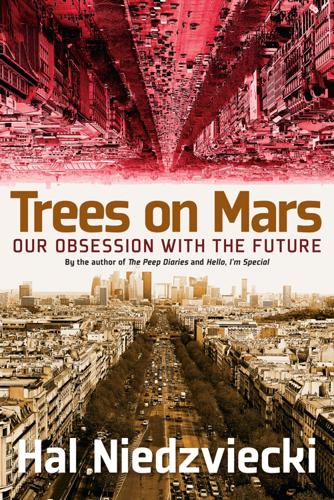
Trees on Mars: Our Obsession With the Future
by
Hal Niedzviecki
Published 15 Mar 2015
“People in tech, when they talk about why they started their company, they tend to talk about changing the world,” notes Joe Green, a roommate of Mark Zuckerberg at Harvard who now leads a Silicon Valley–funded political advocacy group. Reid Hoffman, founder of LinkedIn, describes it like this: “I can make a multibillion-dollar company with a little bit of investment. Why can’t the whole world do that?”50 Speaking about his company’s research into the driverless car, Google cofounder Sergey Brin says: “We want to fundamentally change the world with this.”51 New Yorker writer Jill Lepore notes, “The eighteenth century embraced the idea of progress; the nineteenth century had evolution; the twentieth century had growth and then innovation. Our era has disruption.”52 Or, as Jeff Bezos once told Charlie Rose: “Amazon is not happening to book selling.
…
And exhibit two is, as Mark Winter mentioned, the astonishing number of diverse departments of the United States government now running various XPrize-like challenges. At the forefront is the once-secretive but increasingly public federal agency known as the Defense Advanced Research Projects Agency (DARPA). DARPA has run a bunch of challenges already, including one on the subject of driverless cars. As I write this, the agency is developing a new challenge with a two million dollar prize. The goal of the challenge is to develop “fully automatic network defense systems. DARPA envisions teams creating automated systems that would compete against each other to evaluate software, test for vulnerabilities, generate security patches and apply them to protected computers on a network.”3 Okay, it hardly seems surprising that government departments developed expressly to be experimental in their approach and aggressive in their timelines would eagerly adopt these kinds of competitions.
…
Google has continued to acquire tech companies at a frantic pace and seems to be showing a particular interest in robotics—they have bought at least seven robotics companies so far and have put the man behind the development of their Android mobile operating system in charge of their robot division. But, argues one tech commentator, the goal isn’t really robotics and driverless cars, it’s data: “it’s all about gaining a dominant position in markets where data is about to explode. . . . Whoever provides the software that controls and manages these robots not only stands to make a fortune by selling that software; they will have access to a vast new repository of data about how we live and work.”18 Another article, about the big-data-enabled race—currently being led by Google—to map every road, river, and even footpath in the world makes the same point: “Tomorrow’s map, integrally connected to everything that moves (the keys, the tools, the car), will be so fundamental to their operation that the map will, in effect, be their operating system. . . .
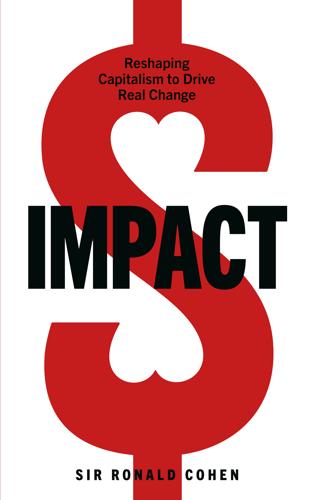
Impact: Reshaping Capitalism to Drive Real Change
by
Ronald Cohen
Published 1 Jul 2020
In April 2018, Zipline unveiled a new model that ‘flies farther, faster and with more cargo than was ever before possible – even in high altitude, heavy wind, or rain’.7 The company’s long-term mission is ‘to build instant delivery for the planet, allowing on-demand delivery of medicines and other products at low cost without using a drop of gasoline’.8 In May 2019, Zipline secured $190 million in funding from US venture capitalists and achieved a $1.2 billion valuation.9 It announced that it would expand across Africa, the Americas, South Asia and Southeast Asia, with the goal of serving 700 million people in the next five years.10 ‘Zipline wants to establish a new model for success in Silicon Valley,’ Rinaudo said, ‘by showing the world that the right technology company with the right mission and the best team can help improve the lives of every person on the planet.’11 While Rinaudo and his team have reimagined drone technology, another entrepreneurial tech-for-good venture, OrCam in Israel, has repurposed advanced technology in artificial intelligence, initially developed to guide driverless cars, to help the 39 million blind and the 250 million visually impaired people around the world. From Driverless Cars to Helping the Blind In 2016, 27-year-old Luke Hines was able to imagine going to college for the first time.12 In 2018, war veteran Scotty Smiley was finally able to read with his three sons.13 In 2019, Naim Bassa was empowered to cast his vote for the first time without someone having to accompany him.14 These three people were all visually impaired but had access to OrCam’s assistive technology, which uses a camera, computing, machine learning and deep networks to process visual information and relay it to users phonetically.
…
From Driverless Cars to Helping the Blind In 2016, 27-year-old Luke Hines was able to imagine going to college for the first time.12 In 2018, war veteran Scotty Smiley was finally able to read with his three sons.13 In 2019, Naim Bassa was empowered to cast his vote for the first time without someone having to accompany him.14 These three people were all visually impaired but had access to OrCam’s assistive technology, which uses a camera, computing, machine learning and deep networks to process visual information and relay it to users phonetically. But the story of this wearable technology began in 1999, when co-founders Professor Amnon Shashua and Ziv Aviram started Mobileye, a technology company that uses cameras and artificial intelligence to replace the human eye in driverless cars.15 Eighteen years later they sold the company to Intel for over $15 billion, the largest acquisition in Israel’s history.16 At this point, Shashua began thinking of applying the technology he had invented to assist his aunt, whose vision was worsening.17 He and Aviram co-founded OrCam in 2010 to help visually impaired people process their surroundings.
…
Aboyeji, Iyinoluwa ‘E’ 48 ABP (Dutch civil service pension fund) 74 accelerators, start-up 175–7, 197 Accenture 90 Access Foundation 175 accounts, impact-weighted financial v, 29–30, 67, 84, 107–17, 159, 183, 186, 190–1, 201 Acumen 84 Adidas 93, 101–4, 107 Adidas x Parley 102–3 Adie 162–3 Africa 1, 27, 39, 48, 49, 83, 84, 136, 148, 167–8 agriculture 36, 45–6, 78, 83, 84, 94–5 Ahrens, Andreas 105 Ailman, Christopher 77–8 Align17 80 Aliko Dangote Foundation 136 Alpert, Sharon 145 Amazon (online retailer) 14 Andela 46, 47–9 AOL 15, 48 Apax Partners 1, 2–3, 15, 18, 35, 174–5 AP funds (pension fund) 74 APG (pension fund) 73 Apple 14, 15, 77 Apposite Capital 142 Argentina 125, 164, 173, 176, 177 artificial intelligence (AI) 39, 40 Ashoka 58, 59 Asian Women’s Impact Fund 144 asset classes 7, 13, 27, 67, 187, 191 asset management 33, 63, 64, 65, 69, 70, 71, 72, 73, 74, 79–85, 172 Ather Energy 56 Australia 6, 22, 40, 124, 158, 176, 204 Avanath 143 Aviram, Ziv 40 Avishkaar 84 Bain Capital 81 Baldinger, Michael 79 Ballmer, Steve 127 Bangladesh 94 Bank of America 81, 115 Bank of Palestine 163 Bannick, Matt 148 Barby, Clara 29 Barclays 169 Bassa, Naim 39–40 Bayer 150 B Corp (Benefit Corporation) 57, 92, 96, 149, 177, 189, 197 Bedouin community, Israel 52–3, 163 Beijing, US embassy 28 Ben & Jerry’s 57 Bertelsmann Stiftung 153 Bhatia, Amit 7 Big Lottery Fund 175 Big Society Capital (BSC) v, 19, 72, 76, 160, 169–70, 171–2, 175 Big Win, The 136 Bill and Melinda Gates Foundation 149–50 Strategic Investment Fund (SIF) 149–50 biodiversity loss 16 biotechnology 45 BlackRock 32, 62, 82 Blair, Tony 160, 179 B Lab 56–7, 107 blended finance 197 Blood, David 19, 26, 49, 82 Blue Orchard Finance 80, 145 BNP Paribas 163 Bolton, Emily 20 Bombas 54 bond markets 71, 191 Bono 79 BP 111 Branson, Richard 88 Brazil 7, 41, 42, 94, 160–1, 177 Bridges Fund Management v, 18–19, 29, 53, 83, 125, 126, 127, 165 Bridges Ways to Wellness SIB 126 British Asian Trust 27, 137, 191 Brodin, Jesper 104, 106 Brown, Gordon 25, 27, 136, 179 B Team 88 Buffet, Warren 117 Burberry 54 Business for Inclusive Growth 88 Business Roundtable 87–8 Buycott 89–90 Cabinet Office 160, 161, 169 California Public Employees’ Retirement System (CalPERS) 76, 77 California State Teachers’ Retirement System (CalSTRS) 77–8 Calouste Gulbenkian Foundation 144, 153 Cameron, David 6, 19, 160, 169, 179 Camfed 137 Canada 6, 124, 144, 158, 160, 171 Capital Impact Partners 143 capitalism 3, 4, 5, 82, 117, 146, 148, 154, 181, 182, 186, 191, 193, 194, 200 impact capitalism 4, 180, 181–94, 200 see also impact investment Capricorn Investment Group 149 carbon emissions 18, 36, 55–6, 62, 66, 74, 76, 83, 90, 91, 97, 105, 106, 107, 111, 112–13, 139, 149 Carlyle Group 81 Carney, Mark 106–7 Cartigny, Gerald 73 Casa de Depositi e Prestiti (CDP) 171 Case, Steve 48, 52 Catalyst Strategies initiative 167 catalytic capital 151 Catalytic Capital Consortium 151–2 CDC (UK’s development finance institution (DFI)) 167 Central Outcome Funds 165–6 Chang, Alan 149 Chan, Priscilla 48–9, 151 Chan Zuckerberg Initiative (CZI) 48–9, 151 Charities Act (2016) 141 Charles, Prince 21–2, 191 Chiang, John 77 Children’s Investment Fund Foundation 132 Chobani 93, 98–101, 107 Clevedon Pier 173 Climate Action 100+ 76 climate change 16–17, 28, 45, 66, 73, 74–5, 76, 77, 81, 95, 104, 105, 106, 107, 139, 177, 191 Coca-Cola 90, 91, 110–11 Commission on Unclaimed Assets (2005–7) 19, 169 Community Interest Companies (CIC) 57 Cone Communications Millennial Employee Engagement Study (2016) 92 Conservative Party 160, 179 Consumer Goods Forum, Berlin (2017) 86–7, 97 contraceptive implants 150 coronary heart disease 113 corporate social responsibility (CSR) 92–3, 96 corporation, redefining purpose of 57, 87–8, 93 see also benefit corporation CRE Venture Capital 49 credit 43–4, 80, 83, 95, 144, 163 Crédit Agricole 95 crop production 45–6 CureVac 150 Daimler AG 112 Danone 57, 86, 87, 91, 93, 94–8, 107 David and Lucile Packard Foundation 144 DBL Partners 83–4 Delaney, John 179 Department for International Development (DFID) 137, 167, 168 Department for Work and Pensions (DWP) 164 Designated Utilization Foundation 170 development aid 134, 136, 166–8, 198 Development Finance Institutions (DFI) 166, 167, 198 DIBs (Development Impact Bonds) 8, 27, 68, 80, 124, 130–5, 137, 138, 153, 157, 163, 165, 167–8, 184, 198, 203, 204 Dimon, Jamie 87 dormant accounts 170, 171, 198, 205 Dormant Account Utilization Bill (2016), US 170 Dormant Assets Commission, UK 170 ‘double bottom line’ investment strategy 83–4 Dove 90, 91 Drayton, Bill 58 driverless cars 39, 40 drones 37–9, 149 Dutch SDG Investing Agenda 73 Dyson, Tasha 126 Eccles, Toby 20 Echoing Green 58–9 Edmond de Rothschild Foundation 153 Educate Girls Development Impact Bond 80, 132–4, 137 Education Commission 27, 134, 136 Education Outcomes Funds 26–7, 136, 148 Education Outcomes Fund for Africa and the Middle East (EOF) 136, 148 electric vehicles 55–6 ELMA 136 Elvis & Kresse 54–5 emerging markets 7, 13, 131, 167 Employee Retirement Income Security Act (ERISA) 157 Endeavor 59 endowment 9, 138–46, 149, 152, 153, 173, 187, 188, 202, 204 entrepreneurship 3, 4, 5, 9, 14, 15, 17, 31, 33, 83, 131, 146, 153, 154, 156, 158, 174, 175, 176, 177, 178, 183, 186, 191, 193, 194, 197 age of impact entrepreneurship 34–61, 188–9 government support for 60, 70, 174–5, 176, 177, 178 micro-entrepreneurs 83 social entrepreneurship 8, 19, 21, 82, 137, 144, 148., 176–7 tech entrepreneurship 5, 17, 55, 61, 138 environmental challenges 3, 4, 5, 8, 9, 12–13, 16, 17, 18, 27, 32, 181–2, 183, 191, 192, 193, 194, 197, 198, 199, 200, 201, 202, 203, 205 asset management and 83, 84 B Lab and 56–7 business and 88, 89, 90, 93, 97, 101, 102, 107, 108, 109–13, 114, 116 climate change 16–17, 28, 45, 66, 73, 74–5, 76, 77, 82, 95, 104, 105, 106, 107, 139, 177, 191 government and 154, 156, 159, 162, 163, 164, 166, 171, 172, 174, 176, 177–8, 179 green bonds 63, 173, 191, 199 impact philanthropy and 121, 131, 138, 139, 140, 141, 142, 143, 153 measuring impact on 28 pension funds and 72, 78 SDGs and see United Nations: Sustainable Development Goals SIBs and 68 Environmental Sustainable Governance (ESG) 63, 64, 70, 71, 72, 75, 76, 77, 78–9, 80, 81, 82, 83, 115, 145, 159, 187, 190, 198–9, 200, 203, 205 Esmée Fairbairn Foundation 23 European Bank for Reconstruction and Development 163 European Union 1, 6, 159–60, 171, 173, 176 Everplans 47 externalities 28 Exxon Mobil 111 Faber, Emmanuel 86–7, 94, 95, 96, 97 Facebook 14, 48, 83 family offices 71, 81, 146 Fawcett, Mark 74–5 FC United of Manchester 172–3 Ferrari, Sara 81 fiduciary duty 75, 145, 199 financial crisis (2008) 158–9, 185–6 financial markets, size of 71 Fink, Larry 33, 62, 82 Fink, Lord (Stanley) 19 Finland 124, 163 Fintech 42–5, 199 Flint, Michigan water crisis 54 FMO (Dutch development finance institution) 163 Fondece 176 Ford 111–13, 136, 140, 142–4, 153 Foundation 140, 142–4, 153 France 1, 6, 22, 58, 63, 75–6, 86, 88, 95, 124, 158, 159, 160, 161, 162–3, 173–4, 175–6, 177, 184, 187, 204–5 Francis, Pope 6 Freedom Bakery, Glasgow 172 Friedman, Milton 185 FTSE Blossom Japan Index 78 Fusion Housing SIB, The 126–7 Gates, Bill 55, 149–50 Gaudio, Paul 103 G8 Social Impact Investment Taskforce (G8T) v, 6, 7, 148, 160, 235 gender bond 191 generally accepted accounting principles (GAAP) 110, 115, 117 generally accepted impact principles (GAIP) 110, 114 General Mills 113 General Motors 112 Generation Investment Management 49–50, 82–3 Georgieva, Kristalina 68 Ghislane 37 Giddens, Michele 18 Gilbert, Jay Coen 108 Glencore 76 Global Family Office Report (2017) 81 Global Impact Investing Network (GIIN) 108 Global Impact Investing Rating System (GIIRS) 108 globalization 13, 16 Global Reporting Initiative (GRI): Sustainability Reporting Standards 108 Global Steering Group for Impact Investment (GSG) v, 7, 27, 29, 109, 136, 148, 158, 171, 206 Global Value Exchange 31, 162 Goldberg, Randy 54 Goldman Sachs 80, 127 Goldstein, John 80 Google 14, 49 Gore, Al 28, 49, 83 government 3–4, 30–1, 70, 154–80, 189–90 how impact investment can help governments do their job 155–8 local government 26, 125–6 measuring and valuing impact of 30–1 nine things for governments to do 158–77 Government Pension Investment Fund (GPIF), Japan 78 Grameen Danone Foods Social Business Enterprise 94–5 Great Depression vii, 185 green bond 63, 173, 191, 199 G7 166 gut microbiome, human 45 Guy’s and St Thomas’ Charity 142 GV (formerly Google Ventures) 49 Haas School of Business, University of California, Berkeley 51 Harrison, Peter 64 Harvard Business School 2, 25, 26, 29, 92–3, 109 Hawkes, Richard 191 Hayes, Lisa 40 Heath, David 54 hedge funds 13 Heron Foundation 139, 145 Hewlett Foundation 137, 153 high-net-worth individuals (HNWIs) 70, 71, 81, 145, 200 high-sustainability investments 74 Hines, Luke 39–40 Hohn, Sir Christopher 66 homelessness 30, 31, 54, 124, 125, 126, 127, 166, 170 Horn, Bernard 20 Houlahan, Bart 108 HSBC 75, 169 Hulme, Philip 19 Husain, Safeena 132 Hutchison, David 20 IBM 47, 189 IKEA 93, 103, 104–6, 107 impact capitalism 4, 180, 181–94, 200 impact economies 68, 85, 155, 157, 159, 161, 178, 180, 184, 186, 192, 200 impact investment birth/origins of 17–28 business, embedding in 86–117 defined 11–13 entrepreneurs, rising generation of 34–61 future of 9–10, 32–3, 186–94 government, role of see government impact capitalism, move from selfish capitalism to 181–94 ‘impact investing’ term coined 11 market growth 64 measuring/valuing 10, 13, 14, 28–31, 64, 67–8, 69, 107–17, 119, 120–1, 159, 183, 186, 190–1, 201 philanthropy and 9, 70, 118–53, 187–8 risk and see risk specialist impact investing firms 82–3 wholesalers 168–72, 184, 201 ‘Impact Investment: The Invisible Heart of Markets’ report (2014) 6 Impact Management Project (IMP) v, 29, 109 impact philanthropy 9, 70, 118–53, 187–8 Impact Revolution v, 1, 5, 8, 9, 10, 14, 28, 32, 33, 85, 152, 180, 182, 186, 188, 189, 235 impact unicorn 35, 188–9 impact ventures/impact enterprises 34–61, 63, 66 impact washing 30, 64 Impact-Weighted Accounts Initiative (IWAI) v, 29–30, 109–17, 201 impact-weighted financial accounts v, 29–30, 67, 107–17, 159, 183, 186, 190–1, 201 Impresa Sociale 177 Imprint Capital 80 incubator (collaborative program designed to help new start-ups grow their business) 175, 176, 202 India 7, 27, 43, 47, 53, 56, 80, 84, 94, 124, 131–4, 153 Indigo Agriculture 45–6 inequality vii, 1, 3, 14, 15–16, 58, 88, 116, 140, 154, 155, 177, 179, 181, 182, 186, 192–3, 194, 200 Ingka Group 104 inheritance, generational 65, 81 Instiglio 132 institutional investors 63, 76, 81, 85, 95, 125, 174, 202 insurance companies 69, 71, 73, 157, 170, 202 Intarcia Therapeutics 150–1 Intel 40 intermediary 22, 202 International Committee of the Red Cross Program for Humanitarian Impact Investment (PHII) 133 International Finance Corporation (IFC) 64, 68–9 ‘Operating Principles for Impact Management’ 68–9 ‘The Promise of Impact’ report 69 Investing with Impact Platform 81–2 Invest Palestine 163 ‘invisible hand’ of markets 10, 97, 184, 185 invisible heart of markets 6, 10, 185 iPhone 77 Ireland 171 Israel 7, 39, 40, 50, 52, 53, 83, 124, 152, 158, 163, 177 Italy 6, 11, 58, 133, 158, 159, 171, 173, 177 Jana Partners 77 Japan 6, 63, 78–9, 124, 144, 158, 159, 170, 171 Japan National Advisory Board 171 Jewish Vocational Services (JVS) 128–9 Jobs, Steve 55 Joby Aviation 149 Johnson, Jeremy 48 Jonathan Rose 143 JP Morgan 87, 169 J.W.

The Master Algorithm: How the Quest for the Ultimate Learning Machine Will Remake Our World
by
Pedro Domingos
Published 21 Sep 2015
Scientists everywhere use linear regression because that’s what they know, but more often than not the phenomena they study are nonlinear, and a multilayer perceptron can model them. Linear models are blind to phase transitions; neural networks soak them up like a sponge. Another notable early success of neural networks was learning to drive a car. Driverless cars first broke into the public consciousness with the DARPA Grand Challenges in 2004 and 2005, but a over a decade earlier, researchers at Carnegie Mellon had already successfully trained a multilayer perceptron to drive a car by detecting the road in video images and appropriately turning the steering wheel.
…
Most importantly, inference includes making the best decisions, guided not just by the probabilities of different outcomes but also by the corresponding costs (or utilities, to use the technical term). The cost of ignoring an e-mail from your boss asking you to do something by tomorrow is much greater than the cost of seeing a piece of spam, so often it’s better to let an e-mail through even if it does seem fairly likely to be spam. Driverless cars and other robots are a prime example of probabilistic inference in action. As the car drives around, it simultaneously builds up a map of the territory and figures out its location on it with increasing certainty. According to a recent study, London taxi drivers grow a larger posterior hippocampus, a brain region involved in memory and map making, as they learn the layout of the city.
…
Like Bayesian networks, Markov networks can be represented by graphs, but they have undirected arcs instead of arrows. Two variables are connected, meaning they depend directly on each other, if they appear together in some feature, like Ballad and By a hip-hop artist in Ballad by a hip-hop artist. Markov networks are a staple in many areas, such as computer vision. For instance, a driverless car needs to segment each image it sees into road, sky, and countryside. One option is to label each pixel as one of the three according to its color, but this is not nearly good enough. Images are very noisy and variable, and the car will hallucinate rocks strewn all over the roadway and patches of road in the sky.

The Rise and Fall of American Growth: The U.S. Standard of Living Since the Civil War (The Princeton Economic History of the Western World)
by
Robert J. Gordon
Published 12 Jan 2016
As shown in figure 17–2, there has been no response at all of TFP growth to the 2007 introduction of the smartphone or the 2010 introduction of the smart tablet.62 Driverless Cars. This category of future progress is demoted to last place because it offers benefits that are minor compared to the invention of the car itself or the improvements in safety that have created a tenfold improvement in fatalities per vehicle mile since 1950. The most important distinction is between cars and trucks. People are in cars to go from A to B, much of it for essential aspects of life such as commuting or shopping. Thus the people must be inside the driverless car to achieve their objective of getting from point A to point B.
…
Instead of listening to the current panoply of options, including Bluetooth phone calls, radio news, or Internet-provided music, drivers will be able to look at a computer screen or their smartphones, read a book, or keep up with their e-mail. The use of driverless cars is predicted to reduce the incidence of automobile accidents, continuing the steady decline in automobile accidents and fatalities that has already occurred. Driverless car technology may also help to foster a shift from nearly universal car ownership to widespread car sharing in cities and perhaps suburbs, leading to reductions in gasoline consumption, air pollution, and the amount of land devoted to parking, all of which should have positive effects on quality of life if not on productivity growth.
…
Driverless delivery trucks will not save labor unless work is reorganized so that unloading and placement of goods from the driverless trucks is taken over by workers at the destination location. The enthusiasm of techno-optimists for driverless cars leaves numerous issues unanswered. As pointed out by Autor, the experimental Google car “does not drive on roads” but rather proceeds by comparing data from its sensors with “painstakingly hand-curated maps.” Any deviation of the actual environment from the pre-processed maps, such as a road detour or a crossing guard in place of the expected traffic signal, causes the driving software to blank out and requires instant resumption of control by the human driver.63 At present, tests of driverless cars are being carried out on multilane highways, but test models so far are unable to judge when it is safe to pass on a two-lane road or to navigate winding rural roads in the dark.
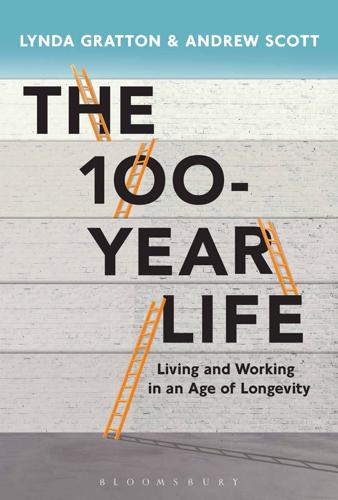
The 100-Year Life: Living and Working in an Age of Longevity
by
Lynda Gratton
and
Andrew Scott
Published 1 Jun 2016
The increase in processing power going from the 32nd chess square to the 35th is worth four times the cumulative sum of processing power across the first 32 squares. In other words, if Moore’s Law continues to function (discussed further below), then over the next eight years computational power will increase fourfold over and above the level of technology embedded, for example, in driverless cars. The hollowing out of work What will be the impact of this extraordinary trajectory? Discussions of robots and AI inevitably have a science fiction flavour to them and seem rapidly to veer into Terminator-like scenarios or lead to Bladerunner-style metaphysical considerations of the very nature of consciousness.
…
So far technology has replaced simple routine tasks, and limits to computational power have restricted the loss of jobs. Driving a car is a routine task – it is just that the list of instructions is very long and complicated. With the innovations associated with the dramatic increase in low-cost computational power, it is now possible to develop driverless cars. When this happens it will threaten a significant number of jobs in the logistics industry. Diagnosing medical conditions is another routine task which has required knowledge and pattern recognition skills that have to date proved beyond computers. However, yet again, the implications of the second half of the chessboard is that this is no longer the case.
…
So rather than worrying that robots are going to take our jobs, we should be delighted that they are arriving just in time to boost a flagging working population and maintain output, productivity and living standards. Implementation challenges There is also a view that while frontier technology is likely to advance rapidly, there will be substantial lags in its implementation. Driverless cars, for instance, face a significant number of regulatory and legal hurdles before they become an everyday reality. It is likely that there will come a day, almost certainly in Jane’s lifetime, when cars are driverless, but it will be a while before it happens. Some technologists also believe that, after fifty years, Moore’s Law is beginning to reach physical constraints and is no longer operable.

I, Warbot: The Dawn of Artificially Intelligent Conflict
by
Kenneth Payne
Published 16 Jun 2021
They seem to be taking a long time to arrive as a commercial proposition. Today, many new cars have computer assistants for parking, lane-keeping and collision avoidance. But that’s a rather limited version of driverless vehicles. Automated trucks have driven cross country, solo and in automated convoys. Driverless cars have even been used commercially by the car hire company Uber. Meanwhile, driverless cars are racking up millions of research miles on the roads and soaking up millions of dollars in investment from car and tech giants alike. Much of this driving, however, has been on broad highways in good weather. Navigating the twisting, cluttered roads of a European city in a downpour is another matter altogether.
…
Navigating the twisting, cluttered roads of a European city in a downpour is another matter altogether. But eventually that problem will be solved—better sensors and more powerful computers should do the trick. There’s an even bigger problem, one that’s really hard to code for: the unpredictability of other road users. In trials, driverless cars have found themselves being ‘bullied’ by human road users. These might in any case be aggressive, or risk-loving drivers, regardless of who is in control of the other vehicle. But machines are conservative drivers, by design. They don’t speed, and they respect braking distance. Above all, they don’t engage in a struggle of wills with other road users.
…
Might such an illusion work for players in the RAND wargame, or even in the real-life strategy games that human-machine teams may soon play? There are certainly parallels between the Jaguar AI car and military strategy—with its dance of minds, and its element of coercion. But there is an important difference too. A military AI system isn’t trying to keep everyone safe, like the driverless car. Its priority is to get its way, at an acceptable cost, whatever that might be. Unlike the car, a warbot strategist might refuse to be intimidated by humans. Perhaps if you escalate against it (like the pedestrian stepping out), it will in turn respond by escalating back. Its automated response could be devastating and happen faster than the ability of its managers to intercede.
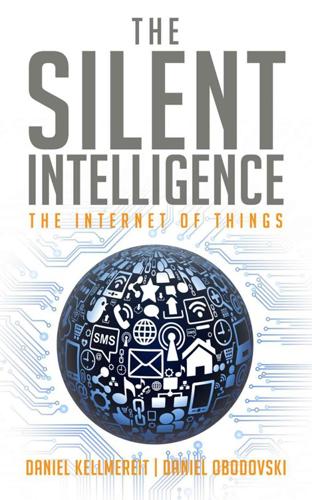
The Silent Intelligence: The Internet of Things
by
Daniel Kellmereit
and
Daniel Obodovski
Published 19 Sep 2013
Covert tracking devices help law enforcement quickly recover stolen cargo. Smart cargo packages can ensure that valuable cargo arrives on time and undamaged. And, if that’s not enough, we can talk about tracking endangered animals, Tweeting plants, body sensors as small as temporary tattoos, connected contact lenses, driverless cars, and more. All these things are possible because of M2M technology, and all these examples represent the Internet of Things. As Glenn Lurie, president of AT&T Emerging Devices Organization (EDO), says, “Any device that is connected is smart. Any device that is not connected is dumb. In the future, everything’s going to be smart.”
…
It will become irresponsible and antiquated for people to drive cars. That is absolutely going to happen in the next decade. I believe that very strongly. Whether Google does it or not, reasonable people could disagree, but whether that generally is going to happen, that I feel very strongly about. In reality, the Google-X driverless car project has demonstrated that autonomous cars can already navigate traffic and follow the speed limit. And that’s just the tip of the proverbial iceberg. Air traffic control might be another area to see more automation soon, as planes learn to communicate better with the ground and with each other, avoiding humans in the process.
…
In addition, modern cars are filled with sensors: detecting light for the mirrors and headlights and rain for the windshield wipers, tire pressure monitors, accelerometers, gyroscopes, and compasses. Going further down this path, the digitalization of mechanics in cars allows for the arrival of driverless cars or self-driving cars, which Google has successfully tested over the past few years. But connectivity offers even more: communication between cars to optimize traffic flow and make better decisions on behalf of the driver. Volvo, for example, has successfully demonstrated road trains as part of the EU’s SARTRE (Safe Road Trains for the Environment) Project, which has several cars following one another in a platoon formation; the lead car has a professional driver taking responsibility for the platoon, while following vehicles operate in a semi-autonomous mode, reducing the distance between the vehicles, and reducing drag and fuel consumption, while getting to their destination faster.23 You may be familiar with the crowd-sourced navigation application Waze, which is one of the most accurate personal navigation applications today because it uses real-time traffic and construction information provided by users.

This Is Not a Drill: An Extinction Rebellion Handbook
by
Extinction Rebellion
Published 12 Jun 2019
In particular, it requires vast shifts in subsidies to green and affordable travel and planning decisions that prohibit all new car-based activity. How we choose to get around the city is connected to a set of choices about the very future of the city itself. Driverless cars may yield some marginal emissions gains. But cities full of Google and Tesla driverless cars will not stop the descent into alienated street life, status anxiety and debt-fuelled, corporate-controlled consumerism. The driverless-car city is the next step in the great car take-over of the urban world. Putting ourselves front and centre of the car-free city is one of the most crucial but difficult tasks ahead.
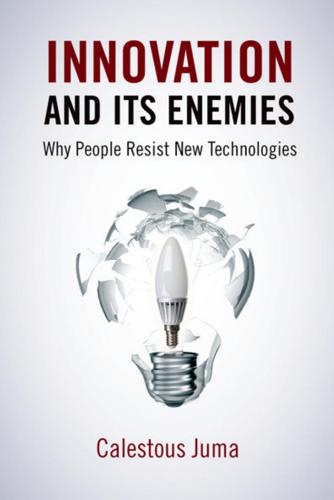
Innovation and Its Enemies
by
Calestous Juma
Published 20 Mar 2017
This is often expressed through postponement, rejection, or opposition to new products or ideas.28 There are many manifestations of such fear, but economic ones are among the most enduring. For example, in 2015 California recently proposed a law—Senate Bill 1298—that would require driverless cars to have a licensed driver present and capable of taking over if needed.29 This necessitates the presence of a steering wheel—a major drawback for Google’s cars that “famously do not include a steering wheel or pedals for human operation.”30 The bill was introduced despite the fact that driverless cars demonstrated the potential for a greater safety record than human-driven cars. The bill seemed to have been inspired by economic rather than safety concerns.
…
A similar scenario is feasible with markets without incumbent automobile industries and infrastructure leapfrogging into the driverless age for a diversity of land, air, and water vehicles. Crewless boats, for example, could become new modes of transportation in remote waterways around the world. In both cases, the intent was to stall the adoption of the new technology, mostly due to its economic ramifications. The safety record of driverless cars will likely wreck the car insurance industry. The technology also poses new challenges for policing due to uncertainties over the locus of liability. Even though the basic concerns regarding radical innovations are economic, additional fuel is provided by intellectual and sociopsychological factors.
…
See also Creative destruction Distrust communication and, 312 of gas industry, 147–148 of ice industry, 185 of institutions, 5, 8 Doctrines, established, vs. technological innovation, 26 Domestic fat laws, 114 Draft animals, economic system surrounding, 128–129 Dressed meat, shipping of, 189 Driverless cars, 13, 295, 366n29 Drones, 32 Drug delivery, technological innovation in, 300 Drunkenness, coffee drinking and, 51 DuPont, 235 Durston, Mr., 163 Dutch East India Company, 53 Dynamic social systems, nature of, 22 E. coli, 255 Earth Summit (1992), 239 East India Ice Company, 176 Eastman Chemical Company, 353n29 Eastman Kodak, 353n29 Ecogen, 232–233 Economic crisis (1873), 101 Economic renewal, 280 Economic Research Service (USDA), 140 Economics economic equilibrium, 17 economic evolution, 1, 27 economic impact studies, 37–38, 39–40 economic interests, resistance to commercialization of transgenic salmon and, 271–272 of fish farming, 260 innovation as economic transformation, 23 role in Germany’s response to coffee, 61 Economy agriculture’s contribution to GDP, 140 dependence on technological assemblies, 23 farm mechanization’s impact on GDP, 339n48 impact of differing technologies on, 142–143 inclusive economies, 284 Schumpeter on, 27 as self-organizing systems, 28 Ecosystem degradation, 257 Edison, Thomas AC, actions against, 168–169, 170–171, 297–298 on alternating current, 144, 164–165 DC adoption, attempted delays to, 144 electrical distribution system, 150–152 gas industry, emulation of, 169–170 incandescent light bulbs, improvements to, 144, 149–150 Kemmler case and, 164 new technology, stigmatization of, 169 NY State Death Commission and, 161 phonograph, creation of, 207 social acceptance, sensitivity to, 168 as technological pioneer, 145, 148 Westinghouse competition with, 144, 146, 152–158, 167 Edison Illuminating Companies, 157–158 Education by HAA, 132 importance for open societies, 290 improved support for innovation and, 307–315 role in adoption of new technologies, 23–24, 93 role in technological controversies, 119 by USDA, on cold storage, 195–196 Efendi, Sai’d, 84 Eggs, preservation of, 186 Egypt Arab Spring in, 91 Cairo, coffee in, 50, 53, 54 printed Korans in, 88 transgenic technology, opposition to, 241 Electrical engineers, 30, 170 Electric chair, 158–159, 162 Electricity, 144–173.
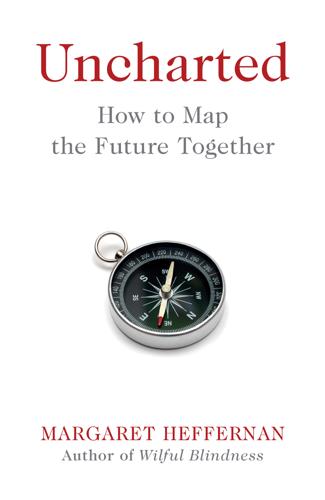
Uncharted: How to Map the Future
by
Margaret Heffernan
Published 20 Feb 2020
That’s the subtext to the by-now perennial headline declaiming this is the year for virtual reality. It isn’t true; the makers just hope, by getting you to believe it, that they can make it true. Nowhere has this subtle shift from prediction to propaganda been more prominent than in the marketing of autonomous vehicles. The driverless car, we have been told for years now, is inevitable. There’s no point even learning to drive any more, so immediately will the liberating technology be upon us. The piratical image of Google’s Sergey Brin sporting Google Glass as he struggled to explain how autonomous vehicles will both free the blind and reclaim green space from car parks shimmers with visual irony.
…
Just as bizarre, as he signs a Bill facilitating the new technology, is Governor Jerry Brown’s celebratory reference to California as the home of the gold rush – an epic of exploiting hopes and dreams if there ever was one. The real drama is the one nobody wrote about: the absence of questions. It is hard to see how the blind would use driverless cars if, as most believe, safety requires that the driver remain capable of last-minute intervention. It remains unclear why, if drivers already on the road are joined by those who currently can’t drive, the streets would be clearer. More cars in use sits oddly with the notion of needing fewer parking spaces, while promises of 100 per cent safety left thoughtful consumers wondering if there had ever, in history, been a 100 per cent safe product.
…
We call it salesmanship because there are products and money attached – automobiles are the largest manufacturing business in the world – but if the technology were correctly seen as a campaign we’d recognise it as propaganda: we are being recruited into an army of believers. Quashing pragmatic questions is not the only consequence of such grandstanding. It also discourages policy questions about the impact of AVs on the labour market, on civil liberties and on public transportation.18 In a perfect world, where everyone has easy access to a driverless car, there’s apparently no need to invest in infrastructure or to address the geographic segregation that plagues so many cities. The more we believe, the less we question, the more probable the forecast becomes. A simplistic commercial view of the future is being forced onto a world as though there are no alternative possibilities, when in fact there are many.
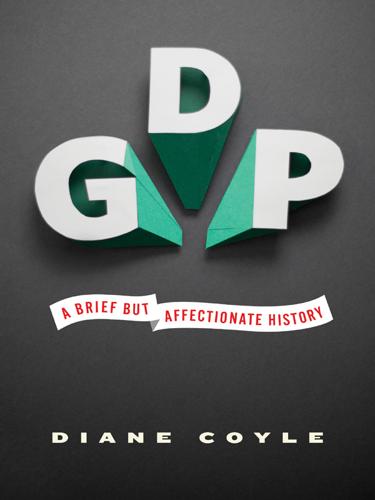
GDP: A Brief but Affectionate History
by
Diane Coyle
Published 23 Feb 2014
It also fails to record at all another increasingly important category, namely, preventive goods or services. Take driverless cars for example. One of these will increase GDP by the same amount as any other kind of car, or perhaps by more if statisticians calculate a hedonic price index to adjust for its improved quality—after all, the human can sit back and relax in a driverless car. But GDP will not capture at all the benefit of a reduction in the number of accidents as driverless cars spread, assuming they live up to the high hopes that this will be the result. In chapter 5, I noted the distinction between GDP and welfare and yet the strong link between the two.

12 Bytes: How We Got Here. Where We Might Go Next
by
Jeanette Winterson
Published 15 Mar 2021
In the smart kitchen, the toaster will remind you that today is a no-carbs day. The smart toilet will assess the contents of your initial evacuation. (I am not making this up.) * * * And what about cars? Driverless cars are a lovely idea – we can go to the pub, act like we’ve got our own chauffeur, work in the back seat. There’s no cab driver giving us his world-view of American politics, just peace and quiet, and our own private pod. But what happens when you realise that this lovely private pod isn’t private at all? Driverless cars track your movements. Random becomes predictable becomes dossier. The pods can be redirected. Police station? Your scary ex’s home? Enforced trip to hospital as your implant registers your blood-pressure risk?
…
Not the next 250 years but the next 25 years will take us into a world where intelligent machines and non-embodied AI are as much a part of everyday life as humans are. Many of the separate strings we are developing now – the Internet of Things, blockchain, genomics, 3D printing, VR, smart homes, smart fabrics, smart implants, driverless cars, voice-activated AI assistants – will work together. Google calls it ambient computing: it’s all around you. It’s inside you. This future isn’t about tools or operating systems; the future is about co-operating systems. The technology is moving fast. The Data Age will be the biggest change yet seen on Planet Earth – bigger than the first Industrial Revolution – when we came blinking out of a centuries-old rural economy, and wide-awake into the daily nightmare of the industrial economy.
…
Your scary ex’s home? Enforced trip to hospital as your implant registers your blood-pressure risk? Hijacked? Kidnapped? Autonomous isn’t anonymous. And driverless cars will have to be programmed for tricky situations. Try this game: an unavoidable crash scenario means you are going to run down a little kid or an old lady – which one? And do we favour pedestrians over passengers? The least damage to me in the pod or to you on the pavement? What if a dog runs into the road, and the car needs to brake, at the same time as I need to accelerate to stop someone shunting me from the rear? In such situations a human makes a split-second decision.
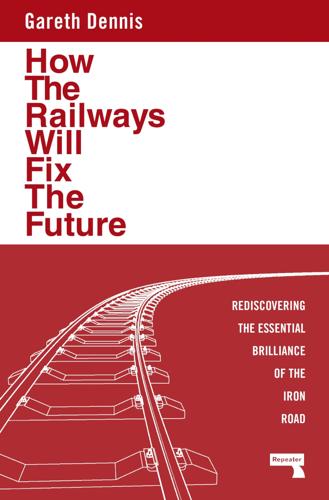
How the Railways Will Fix the Future: Rediscovering the Essential Brilliance of the Iron Road
by
Gareth Dennis
Published 12 Nov 2024
There’s no better example of tech being developed for its own sake than when autonomous transportation hits the road in the futile race to create viable driverless buses and cars. Nobody has been able to justify why driverless buses are a useful idea given the expense involved in trialling what will never functionally work. And driverless cars only make these efforts look more ridiculous — yet governments are fixated on a future where driverless cars (“autonomous vehicles”) exist and require yet another era of reshaping our urban realm. What problem are these technologies solving, other than justifying far higher sales costs per vehicle? Buses already have a highly complex and interactive system operating them (called drivers), and we already have autonomous vehicles — they are called taxis, and they exist basically everywhere.
…
The unassailable truth is that aviation is likely to account for a full fifth of human carbon emissions by 2050 — only demand reduction can make a real dent in those numbers. Meanwhile, the automotive industry is desperate to keep selling new cars at increasing rates despite the obvious and calamitous problems this causes. Autonomous car technology will never work — rather, there will never be driverless cars — but suggesting there might be is enough to distract local and national politicians from introducing congestion charging, reducing parking availability, adding bus lanes or otherwise returning street space back to non-motor traffic. The key question to ask of any novel solution, whether inventive or innovative, is “What problem is this solving?”
…
* * * 5 Josefine Fokuhl (2022) “Attack on German Rail Network ‘Targeted, Professional,’ Police Say”, Bloomberg, 9 October, available online from: https://www.bloomberg.com/news/articles/2022-10-09/attack-on-german-rail-network-targeted-professional-police PART 3 THE FUTURE CHAPTER 3.1 THINKING BIGGER A future dominated by sustainable transport is an exciting one. However, the picture painted by futurists rarely describes the best solutions to humankind’s mobility problems. Driverless cars, revamped maglev and even flying taxis seem to be the default response when someone asks, “What will the future look like?”, yet these transport modes are costly and ineffective. As with clean water and energy distribution, humans have essentially solved mass transit. There is no more efficient means of carrying things and people across land than a steel wheel on a steel rail.
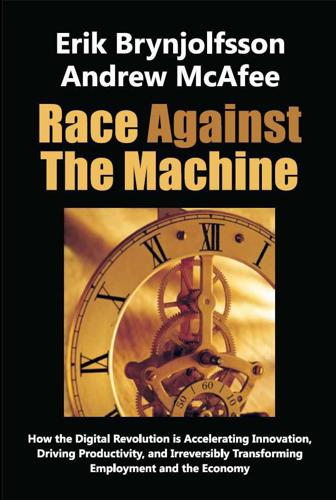
Race Against the Machine: How the Digital Revolution Is Accelerating Innovation, Driving Productivity, and Irreversibly Transforming Employment and the Economy
by
Erik Brynjolfsson
Published 23 Jan 2012
Their vehicles also collected huge volumes of real-time data using video, radar, and LIDAR (light detection and ranging) gear mounted on the car; these data were fed into software that takes into account the rules of the road, the presence, trajectory, and likely identity of all objects in the vicinity, driving conditions, and so on. This software controls the car and probably provides better awareness, vigilance, and reaction times than any human driver could. The Google vehicles’ only accident came when the driverless car was rear-ended by a car driven by a human driver as it stopped at a traffic light. None of this is easy. But in a world of plentiful accurate data, powerful sensors, and massive storage capacity and processing power, it is possible. This is the world we live in now. It’s one where computers improve so quickly that their capabilities pass from the realm of science fiction into the everyday world not over the course of a human lifetime, or even within the span of a professional’s career, but instead in just a few years.
…
After the chat session ended, both customers and employees were asked whether the automatically translated messages were useful—whether they were clear enough to allow the people to take meaningful action. Approximately 90% reported that they were. In this case, automatic translation was good enough for business purposes. The Google driverless car shows how far and how fast digital pattern recognition abilities have advanced recently. Lionbridge’s GeoFluent shows how much progress has been made in computers’ ability to engage in complex communication. Another technology developed at IBM’s Watson labs, this one actually named Watson, shows how powerful it can be to combine these two abilities and how far the computers have advanced recently into territory thought to be uniquely human.

Bike Boom: The Unexpected Resurgence of Cycling
by
Carlton Reid
Published 14 Jun 2017
Carmageddon awaits for those cities that aren’t planning for a vehicle-free future. Driverless cars will work well on grade-separated, go-faster motor roads, but they have a far less certain future in city centers where cyclists and pedestrians could easily block their progress, thanks to the knowledge that autonomous vehicles are programmed not to bully humans out of the way, resulting in what risk specialist John Adams calls “deferential paralysis.” Even if pedestrians didn’t play “chicken” in front of them, driverless cars would still be wrong for cities: if even a quarter of the 1.3 million daily commuters into central London switched to driverless cars, the roads would seize solid.
…
See also Stevenage cycleway system cycling tracks, experimental, 32–33, 33, 97–99 Cyclists’ Inferiority Phobia, 155 Cyclists’ Touring Club, 32–39, 50, 79, 87–88, 93, 99–106, 170 cyclodramas, 235 Daley, Richard J., 59–60 Darago, Vincent, 150, 152 Davis, California, 67–76, 146–148 Davis Tweed Run, 76 De Beauvoir Association, 200–201 De Pijp area (Amsterdam), 198 De Silva, Harry Reginald, 52 deferential paralysis, 15 Delft redesign, 137 Delta Works, 183–184 Denington, Evelyn, 96, 170 Department of Transportation (DOT), 136–139, 147, 148–149, 153 Design & Layout of Roads in Built-up Areas report, 79–80 Dobbins, Horace Murrell, 22 Dower, Michael, 106 Dowlin, John, 133 Drees, William, 192 driverless cars, 13–15 Driving Under the Influence, 54 Dubinsky, David, 132 Dutch Cycling Embassy, 209–210 Dutch Cyclists’ Union, 192 Dutch intersections, 71–72 Dutch system, 179–180. See also Netherlands Earth Day (1970), 112, 113 Ebert, Anne-Katrin, 186 Eckhardt, Robert C., 65 Effective Cycling (Forester), 146, 151, 151–152 Eisenhower, Dwight D., 54, 55–56, xv Ellen Fletcher Boulevard, 146 energy efficiency, 94–96 Environmental Protection Agency (EPA), 127–128, 138 environmentalism, 9–10, 89, 92–95, 111–116, 130–131 Epperson, Bruce, 72, 152, 156 Falbo, Nick, 71–72 Far to the Right law (FTR), 27, 153 Farnsworth, Dana L., 56 Fascell, Dante B., 55 Federal-Aid Highway Acts, 54, 111 Fee, Julie Anna, 137 Feilden, Richard, 96, 101 Ferguson, George, 108 Fichter, George, 57 filtered permeability, 146 Finney, Albert, 83 Fischman, Barry, 131 Fisher, Gary, 148 Flanigan, Peter, 109 Fletcher, Ellen, 146 “FoE Cycleways Campaign,” 100 Ford Maverick burial, 112–113 Forester, John, 143, 145–148, 147, 151–152, 155–160 France, 32 Frankel, Godfrey and Lillian, 17 freeways, 85, 181 Friends of Bikeology, 10, 120–122 Friends of the Earth (FoE), 9–10, 92, 94, 97–100 Fulbright, William, 62 Gaffney, Mary, 229–230 Gelinck, W.

Infinite Detail
by
Tim Maughan
Published 1 Apr 2019
Then they’re off the ramp, and Neal finally seems to cut his speed for the first time since they left Wales, easing them around pillars and parked cars—most of them looking to Anika like they’ve been here awhile, abandoned. Cars and vans much newer than the antique Ford they’re sitting in now: driverless cars, fuel-cell-powered, digitally controlled. Chinese, Korean, Brazilian designs. All useless now. Some of them have been stripped for parts, some have been burned out, others converted into what looks like living spaces; she catches the glimpse of curtain fabric in windows, notices how some of the cars have been moved to create walls, defenses.
…
For a second Rush thinks his legs will give way beneath him. Scott unhooks his legs, playfully pushes him away. “C’mon, then. We can finish this later. Let’s get you to your protest, boyfriend.” * * * They move quickly and purposefully through the city, thousands strong, shutting down traffic as they flow around it. Streets full of driverless cars are paralyzed, unable to react to this many human bodies flooding their space. The few remaining yellow cabs, artifacts from a dying age, honk in support, their human drivers reaching out of wound-down windows to high-five protestors as they pass. At Rush’s insistence both he and Scott have got their scarves and hoods up to try to mask their faces from the police drones that float constantly above their heads.
…
Jobs came and went, and then just stopped coming altogether. Even in the few short months he’d been in prison so much had changed. Shops were closing down, retail jobs disappearing. He spent a couple of weeks standing in the rain in lime-green-and-white waterproof overalls outside the service station at Tesco, plugging recharging cables into driverless cars. Then one day he came into work late to find a robot, some egg-shaped thing with a single stupid fucking arm, doing it for him. It bleeped angrily and told him it was calling the cops when he kicked it with his split, leaking, limited-edition trainers. Instead he found himself hanging around the still-standing towers, putting a new crew together, building up his rep again.
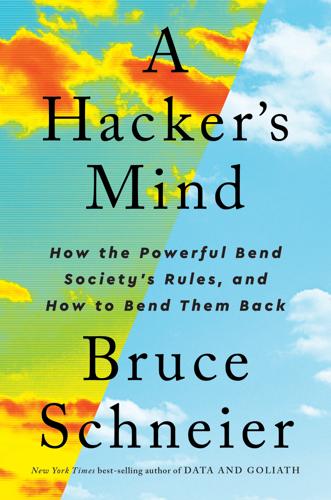
A Hacker's Mind: How the Powerful Bend Society's Rules, and How to Bend Them Back
by
Bruce Schneier
Published 7 Feb 2023
The company hasn’t had a single profitable year. In 2019, the company lost $8.5 billion worldwide, or 58 cents per dollar on each of its 5.2 billion rides. The only reason Uber exists at all is that there are still investors willing to pour capital into this sinkhole, probably waiting for the time when driverless car technology allows the company to fire all of its drivers and operate a fully autonomous fleet. WeWork has also never turned a profit, losing over $10 billion in the past three years. That particular VC-fueled bubble burst when the company tried and failed to go public in 2019. The COVID-19 work-from-home rules further hurt WeWork’s chances of success, and the company’s co-founder was ousted as CEO and chairman of the board.
…
In addition to decision-making, the relevant qualities of the AI systems I’ll be discussing are autonomy (the ability to act independently), automation (the ability to act on preset responses to specific triggers), and physical agency (the ability to alter the physical environment). A thermostat has limited automation and physical agency, and no autonomy. A system that predicts criminal recidivism has no physical agency; it just makes recommendations to a judge. A driverless car has some of all three. R2-D2 has a lot of all three, although for some reason its designers left out English speech synthesis. Def: Robot /bät/ (noun) - 1. Physically embodied objects that can sense, think, and act on their environments through physical motion. Robotics also has developed a popular mythology and a less-flashy reality.
…
AIs initially capture this understanding through the data with which they’re trained, and they continue to improve as they are used. Modern AIs are constantly evolving as they acquire new data and adjust their own internal workings accordingly. The constant flow of data continues to train the AI as it operates and adds to its expertise. This is why designers of driverless car systems brag about the number of road hours their creations have clocked. The development of AIs capable of hacking other systems gives rise to two different but related problems. First, an AI might be instructed to hack a system. Someone might feed an AI the world’s tax codes or the world’s financial regulations, in order to create a slew of profitable hacks.
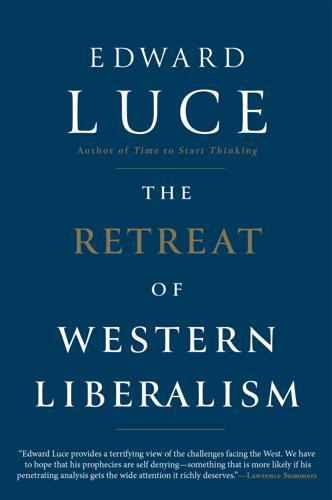
The Retreat of Western Liberalism
by
Edward Luce
Published 20 Apr 2017
His book The Rise and Fall of American Growth makes a startling forecast that did not go down well in Silicon Valley. The future is not what it used to be, he says. The peak age of high growth and disruptive technology is behind us. Forget the power of the iPhone. Stop exulting about Google’s driverless car. Such wonders pale beside the changes felt by earlier generations. They are unlikely to be matched by our age. Gordon’s thesis is not entirely new. Tyler Cowen made a similar argument with his sparkling monograph The Great Stagnation (ironically first published as an ebook). Nor is it as counterintuitive as it sounds to our app-crowded, WiFi-saturated twenty-first-century brains.
…
He pointed to the efflorescence of tech unicorns – private start-ups valued at more than $1 billion – that are working on virtual reality, artificial intelligence, gene-splicing medicine and the like. At least one will be as transformative as the iPhone, he said. In fact, the pessimists’ gloom makes ample room for the emergence of virtual headsets, driverless cars and robotic disruptions. The impact of new technologies will be significant but not game-changing, they say. Today’s medical progress is only adding to economic stagnation. Most recent advances are in the treatment of physical ailments, thus prolonging life for those who can afford them. There have been no comparable breakthroughs in curing mental illness, such as Alzheimer’s.
…
Karl Marx predicted that capitalism would push the workers of the world to unite. He got it back to front. It is the elites who are loosening their allegiances and workers who are reaching for national flags. This is hardly a vision of social peace. ‘The rich will live in gated communities, and secure compounds, that are protected by drones and connected by driverless cars,’ predict Yascha Mounk and Lee Drutman, two of the sharpest political scientists around. ‘Ever smarter surveillance technologies will help to monitor the activities of the malcontents outside . . . ’70 Elites of the world unite! You have everything to lose. —— Every January, the Davos gathering sounds a little more bemused about what is happening in the world outside.
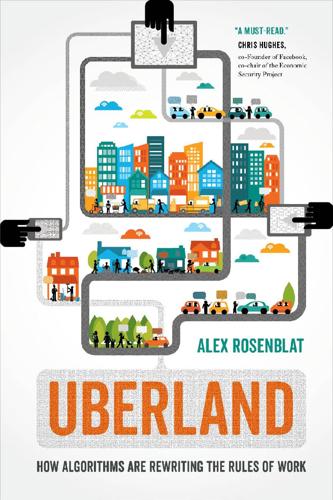
Uberland: How Algorithms Are Rewriting the Rules of Work
by
Alex Rosenblat
Published 22 Oct 2018
Bring It On: How Pittsburgh Became Uber’s Testing Ground,” New York Times, September 10, 2016, www.nytimes.com/2016/09/11/technology/no-driver-bring-it-on-how-pittsburgh-became-ubers-testing-ground.html. 36. Cecilia Kang, “Pittsburgh Welcomed Uber’s Driverless Car Experiment; Not Anymore,” New York Times, May 21, 2017, www.nytimes.com/2017/05/21/technology/pittsburgh-ubers-driverless-car-experiment.html. 37. Complaint for Permanent Injunction and Other Equitable Relief at 10–11, FTC v. Uber Techs., Inc., No. 17–261 (N.D. Cal. Jan. 19, 2017); Calo and Rosenblat, “The Taking Economy.” 38. The original blog post was located here: https://newsroom.uber.com/an-uber-impact-20000-jobs-created-on-the-uber-platformevery-month-2/.
…
You can either put up red tape or roll out the red carpet. If you want to be a 21st-century laboratory for technology, you put out the carpet.”35 The municipal government of Pittsburgh later complained that Uber failed to keep its word to the city as part of their agreement, not following through on offering driverless-car rides for free or creating jobs as promised in a high-unemployment neighborhood.36 UBER’S DOUBLESPEAK: JOB CREATION WITHOUT WORKER RIGHTS Uber is a chameleon: it utilizes the art of doublespeak, which allows it to simultaneously maintain seemingly contradictory political stances. The company’s reputation as a darling of the technology world lost some of its shine by 2015, when the aggressiveness of its tactics was beginning to give many people pause.
…
While drivers may have a viable legal claim to employee status under labor law, the culture of technology is pushing us past those considerations in more diffuse ways. Interrelated issues draw in different sets of actors, and Uber can break promises to one without necessarily hindering its relationship with another, because Uber represents more than a single actor. For instance, Uber may never create jobs in a high-unemployment neighborhood near its driverless car track in Pittsburgh, even though it promised to do so when it began operations there. Other regions, like New York State, may continue to welcome the company’s expansion as a sign of certain progression in the digital economy. Despite Uber’s mixed track record as a sometimes friend, sometimes foe, Governor Andrew Cuomo signed a bill to legalize ridehailing in the state on June 5, 2017.

Data Action: Using Data for Public Good
by
Sarah Williams
Published 14 Sep 2020
,” SSRN Scholarly Paper (Rochester, NY: Social Science Research Network, August 9, 2016), https://papers.ssrn.com/abstract=2820580. 18 Nadezhda Purtova, “Illusion of Personal Data as No One's Property,” SSRN Scholarly Paper (Rochester, NY: Social Science Research Network, October 29, 2013), https://papers.ssrn.com/abstract=2346693. 19 Mike Maciag, “How Driverless Cars Could Be a Big Problem for Cities,” Governing, 2017, https://www.governing.com/topics/finance/gov-cities-traffic-parking-revenue-driverless-cars.html. 20 Gideon Mann, “Private Data and the Public Good,” May 17, 2016, https://medium.com/@gideonmann/private-data-and-the-public-good-9c94c656ff28. https://medium.com/@gideonmann/private-data-and-the-public-good-9c94c656ff28Mann. 21 Michael Barbaro and Tom Zeller Jr, “A Face Is Exposed for AOL Searcher No. 4417749,” New York Times, August 9, 2006, https://www.nytimes.com/2006/08/09/technology/09aol.html. 22 Katie Hafner, “Researchers Yearn to Use AOL Logs, but They Hesitate,” New York Times, August 23, 2006, https://www.nytimes.com/2006/08/23/technology/23search.html. 23 Sean M.
…
“Ma3Route Is a Mobile/Web/SMS Platform That Crowd-Sources for Transport Data and Provides Users with Information on Traffic, Matatu Directions and Driving Reports.” Accessed August 1, 2019. http://www.ma3route.com/. Maciag, Mike. “How Driverless Cars Could Be a Big Problem for Cities.” Governing, 2017. https://www.governing.com/topics/finance/gov-cities-traffic-parking-revenue-driverless-cars.html. Mann, Gideon. “Private Data and the Public Good,” May 17, 2016. https://medium.com/@gideonmann/private-data-and-the-public-good-9c94c656ff28. MapMill. Image of Map Mill App Courtesy of PublicLab.Org. n.d. Website.
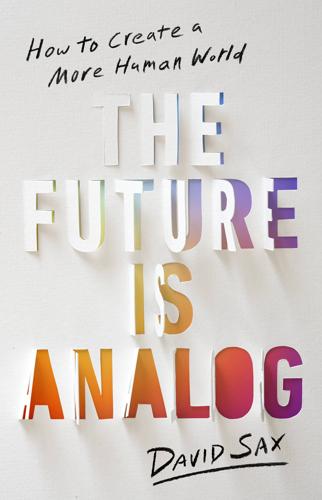
The Future Is Analog: How to Create a More Human World
by
David Sax
Published 15 Jan 2022
And in the Kansas City case, the solutions proposed from that data were so impractical and disconnected from reality (driverless cars and drones rather than buses and more police patrols) that the project quietly died after a few years. “It’s a cliché, but smart cities really prioritize tech development over anything,” Baykurt said. “All the good intentions behind trying to fix problems and treating technology to get at those big questions, it ends up over and over again as a PR performance. They rarely start from the problems.” Instead, smart cities offer digital solutions in search of an actual problem, like one Sidewalk Labs program in Columbus, Ohio, that proposed using driverless cars and ride sharing to bring patients to medical appointments as a solution to persistently high rates of infant mortality in Black neighborhoods, rather than, say, instituting better public transit, education, and prenatal services to improve maternal and infant health in a vulnerable community.
…
Robot maids, like Rosie on The Jetsons, were still decades off, but robot vacuums worked pretty well. The office wasn’t yet fully paperless, as predicted back in the 1970s, but I had built a career working remotely from home since the day I sold my first article to a newspaper in 2002. Flying cars were in development, and driverless cars were being tested in major cities, with the promise of widespread adoption before my kids got behind the wheel. “Hoverboards” arrived (though they didn’t actually hover and often caught fire), but at least I owned a digitally controlled bidet toilet seat that worked just as well as the magic seashells.
…
By 2018 many cities were cutting deals with companies like Uber and Lyft to weave private ride sharing into their transit systems, based on the widely accepted promise that rideshares easily reduced congestion, emissions, and the other drawbacks of private car ownership, and paying them would be cheaper than investing in expanded bus service or building costly subway lines. If you lived in a place like, say, Silicon Valley (a sprawl of car-centric suburbs impossible to walk around), this made perfect sense. But if you lived in an actual city, like San Francisco, it did not. “Driverless cars and electric cars are still fucking cars!! They’re cars!!!” fumed Roberta Gratz, when we spoke about Sidewalk Toronto’s plans. “They’re not going to eliminate traffic; they’re going to increase traffic.” Studies already showed that this had happened with Uber and Lyft and other ride-sharing companies worldwide: all those drivers, cruising around in their empty cars, waiting for the next ping of a pickup (an activity known as deadheading), actually added more pollution and congestion to cities, even compared to privately owned cars.
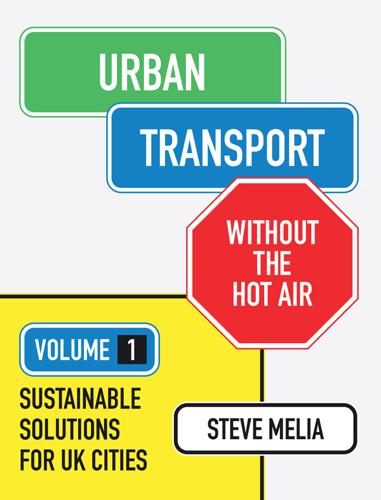
Urban Transport Without the Hot Air, Volume 1
by
Steve Melia
A mass market switch would deprive governments of the revenue from fuel taxes unless they decide to impose either a selective tax on electricity (difficult but not impossible) or a national road pricing scheme. Neither is likely to be popular. Meanwhile, the UK government has placed considerable faith in the potential for ‘driverless cars’ to reduce congestion and CO2 emissions.274 The term ‘driverless cars’ is misleading (researchers prefer ‘autonomous vehicles’) since the technologies can be applied to other types of vehicle and the transition to entirely automatic control for private cars will pass through several intermediate stages. Some automatic functions such as cruise control have been available for some time.
…
See www.openstreetmap.org for more information on this valuable resource. 272 DfT (2014) Transport statistics Table CGN0206a 273 Bristol City Council (2012) ‘Public realm and movement framework consultation draft’. On: www.bristol.gov.uk 274 Department for Business, Innovation and Skills and DfT (2014) ‘UK government fast tracks driverless cars’. Press release. 20 July. On: www.gov.uk 275 Brundtland, G.H. (1987) Our common future: World commission on environment and development. Oxford: Oxford University Press. 276 DEFRA (1999) ‘A better quality of life – strategy for sustainable development for the United Kingdom, London’. Available on the National Archives website. 277 Eurostat (2011) ‘Modal split of passenger transport’.
…
Page numbers in italic refer to figures A accessibility planning 222 air pollution 25, 30, 42, 227 airport expansion 33–4, 110 Amsterdam 62, 63, 67, 148, 158, 217 anti-collision technology 119 Ashford 81, 84, 85–6 Athens 227 autonomous vehicles 119, 214, 229–30 aviation air travel restraint policy 34 airport expansion 33–4, 111 business travel 10, 238 greenhouse gas emissions 13, 14 leisure flights 29, 33, 238 ‘tourism gap’ 29, 33–4, 34 B Baker, Norman 22 Barclays Cycle Superhighways 176 Basel 61, 62, 148 Bassam, Steve 185, 232 Bath 217 Baugruppen 157 Bayliss, David 165 Berkeley Group 56–7, 58 Big Brother Watch 27 Birmingham 99, 180 Bogotá 71 Boles, Nick 93 Bonn 63 Bordeaux 148 Bracknell 151 Bradley Stoke 94–5, 96, 96, 105, 107–8 Brighton 85, 86, 184–95, 221 bus use 186–8, 186, 189, 193, 194 car ownership 210 car-free development 189, 189 cycling 190, 191, 194 demographics 189, 192–3, 210 Green Party policies 190–2 housing development 189, 195 modal shift 192–4 park and ride 190–1 parking schemes 188 rail 194 travel patterns 185, 192–4, 193 walking 194–5 Bristol car-free development 161 cycling 63, 67, 72, 76, 78, 78 housing development 99, 99 pedestrianization 88, 208 road network 116–17, 117 trams 141 UWE transport 206–8 Bristol to Bath cycle path 72, 73, 74 British Social Attitudes Survey 59 Brown, Gordon 104, 173, 174 brownfield development 55, 98–9, 100, 101 Brundtland Commission 120–1 Buchanan report 112–16, 117–18, 150, 164, 182 bus gates 64 bus travel bus rapid transport (BRT) 40, 205, 211, 221 bus-to-bus changes, resistance to 41, 222 competitive practices 45–6 deregulation 23–4, 38, 43, 45–6, 193 diesel buses 42 European countries 43 fares 23–4, 24, 38, 44 free 41–2, 43 guided busways 90, 202, 204–5, 205 impact on car use 38, 41, 42, 106 low emission buses 42 national bus use 44 orbital bus services 41 peak-time commuting 42, 43 in permeable street networks 90 radial routes 41 real-time information 188 reregulation 223 speeds 41 ‘bus wars’ 45 business attitudes 134–5, 143–4, 147, 182, 191–2 business travel see work, travel to bypasses 113 C calculation fallacy 10–11, 37 Cambourne 105, 196 Cambridge 60, 76, 184, 192, 195–206, 219 bus use 204–5, 206 Cambridge Core Traffic Scheme 197–200, 197, 202, 204, 221, 235 car ownership 210 cycling 196, 200–4, 201, 202, 203 demographics 210 filtered permeability 202, 203 Holford report (planning strategy) 195–6 political consensus 206 public transport 204–6 rail 204 travel patterns 185, 200 Campaign to Protect Rural England (CPRE) 17–18, 232 car clubs 52, 155, 159, 222, 224, 227 car ownership Buchanan report forecasts 112–13, 112 demographics 162, 222 income and 53, 57 ‘normality’ of 26, 28, 238 parking restraints, impact of 49, 54, 55, 57–9, 110, 218, 219 predictor of car use 49, 50–3, 50, 229 public transport, impact of 58 reasons for not owning 53–4, 57, 180 rural areas 224 car purchase tax 21 car sharing 52 car use adults without cars 52–3, 52, 229 cost trends 21, 21, 24, 24 income and 53 measuring 51 ‘peak car’ 28, 211 personal freedom issues 25 public transport improvements, impact of 38, 39, 110 social costs 25 time savings 35 see also shared space car-free choosers 27, 28, 53–4, 161–2, 237–8 car-free developments 149–62, 219–20 parking overspill 157–8, 160 social benefits 159 see also under Brighton; Cologne; Freiburg; London; Louvain-la-Neuve carbon emissions 42, 119, 229 carbon trading systems 37 Cardiff 184 cars carbon emissions 14, 16, 19, 24–5 environmental-related problems 16 see also autonomous vehicles; electric cars casualties cycling and 27–8, 67, 69, 70, 75–6, 78 legal liability for 75–6 pedestrian 79 speed and 26, 27, 36 catchment populations 96 Churchill, Winston 24 climate change 13, 14, 110, 229, 236, 237 cost–benefit analysis (CBA) and 37 Climate Change Act 2008 14 Climate Change Committee 14, 15, 226, 229 cognitive dissonance 237 Collomb, Gérard 144 Cologne 148 Stellwerk 160 (car-free development) 158–61, 158, 159, 160 combined local authorities 181 commercial development 55, 56 Commission for Integrated Transport (CfiT) 50–1 Competition Commission 45 Confederation of British Industry (CBI) 30, 215 congestion 42, 211–14, 229 economic costs 215 options for dealing with 113–22, 212–14, 229–30 rich cities 215 tolerance of 118, 214 congestion charging 77, 122, 171, 174–5, 180, 181, 213, 214 connectivity 146, 222 Connex 46 Copenhagen 61, 69, 148 cost–benefit analysis (CBA) 29, 30, 35–7, 146, 228 courtesy crossings 86 Coventry 63 Cranbrook 107, 220 Crossrail 174, 178, 225 cycle hire schemes 71, 143, 143 cycle parking 68, 69, 130, 131, 135, 139, 140, 159 cycling 23, 60–78, 224–6 cycling culture argument 61, 70 European rates of 60, 61, 61, 62, 62, 63, 68–9, 182 flat terrain and 63, 70 government spending on 73 health benefits 30 hostility to 71, 225, 226 main roads 76 male dominance (UK) 67, 73, 75, 176, 226 pedestrianization and 67, 68, 87 in permeable street networks 90 protective clothing 67 push factors 70 reasons for not cycling 65, 67, 75 red lights, jumping of 68 and road casualties 27–8, 67, 69, 70, 75–6, 78 shared-space schemes 88 time cost 75, 76 traffic conditions and 63, 75 UK rates of 61, 71–2, 76 weather conditions and 63 Cycling Embassy of Denmark 77 Cycling Embassy of Great Britain 77, 203–4 cycling networks 37, 60, 61, 64, 71, 72 ad hoc design compromises 75 cycling contraflows 67, 176, 176 cyclist-only traffic light phasing 68, 139, 140 ‘Dutch-style’ infrastructure 77–8, 225, 226 European cities 64–5 filtered permeability 64, 65, 176, 176 hierarchy of provisions 74–5, 74, 77, 225 hostility to segregation 72, 73 hybrid paths 65, 66, 75, 77, 191 priority at junctions 68 safety auditors 65 segregated routes 71, 72, 73, 75, 76, 77, 82 selective road closures 67 separation of cyclists and pedestrians 65, 78, 225, 226 substandard provision 76, 76 cycling priority roundabouts 65, 66 Cyclists Touring Club (CTC) 71–2, 77 D Darlington Transport Company (DTC) 45 Daseking, Wulf 124 Davey, Ian 190, 191, 192 De Mello, Lianne 172, 191–2 Delleske, Andreas 157 demarcations, removal of 81, 85 Denmark cycling 61, 65, 66, 69, 75, 78 see also Groningen Department for Transport (DfT) 11 cost-benefit analysis (CBA) 35–7 and eco-towns, transport in 106 Economic case for HS2 47–8 Manual for Streets 75, 89, 91 National Cycling Strategy 72 and shared space 80, 84, 89 Department of the Environment, Transport and the Regions 98 deregulation 23–4, 38, 43, 45–6, 84, 168, 181, 193 Dickens Heath 105 diesel buses 42 disabled people 84, 86, 114, 139, 226 domestic tourism 34 Downs, Anthony 214 Drachten 82, 82, 83 driverless cars see autonomous vehicles Dutch Cycling Embassy 76–7 E Earl, Dave 197, 198, 200–1, 204, 206, 235 eco-towns programme 104–5, 220, 221 opposition to 106 transport facilities 106 Edinburgh 158, 161, 184 electric cars 14–15, 110, 119, 224, 226–7, 229 charging systems 15–16, 227 environmental campaigns local campaigning 231–5 personal travel behaviour 236–8 transport planners 235–6 environmental capacity 114 environmental sustainability, attitudes to 110 European best practice 120–2 see also Freiburg; Groningen; Lyon European travel patterns 120, 121 Exeter 161, 162 Exhibition Road, London 80, 80, 219 F false consensus effect 56 falsely positive responses to surveys 207 ‘family houses’ 103, 218 Ferguson, George 208 ferry services 34 filtered permeability vii, 64, 65, 90, 106, 113, 137, 175, 176, 176, 182, 197, 199, 202, 203 Filton 95–6, 96 First Group 47 flats 10, 98–9, 100, 218 proportion of housing stock 92, 100, 101, 102, 102, 103 social housing 103 ‘floating bus stops’ 190, 191 flyovers 114 footbridges 64 France local government 145 motorway networks 120 national planning policy 144–5, 227 tram systems 221 transport revenue stream 228 see also Lyon free market ideology 84 Freiburg 61, 62, 63, 64, 69, 122, 123–34, 219, 221 car ownership 132, 133, 157 cycling network 129–30, 130, 131 demographic profile 148 parking 132, 155, 157 pedestrianization 124, 124, 133 public transport, extension of 125–8, 125 road network 128 stellplatzfrei residential streets 155–6, 156 traffic restraint 128–9, 147 trams 126, 126, 127–8, 127, 132, 141 transport plan 123, 124–30 travel patterns 132, 133 urban planning 130–2 Vauban (car-free development) 155–8, 156 walking, fall in 147 French, Roger 187, 188, 193 fuel tax 10, 19, 20–1, 21, 213, 214 fuel tax protests 20, 213 G garden cities 106–7, 220 funding 106–7 see also eco-towns programme Germany car ownership and use 10, 49, 51, 51, 52 cycling 61, 63, 65, 69 motorway networks 120 transport decision-making 227 see also Freiburg Glasgow 184 GNER 47 good practice British see Brighton; Cambridge; London European see Freiburg; Groningen; Lyon governance issues 227–8 GPS route finding 118 greenfield development 17, 18, 55, 97, 100, 117, 212, 216–17, 220, 221, 234 land prices 103–4 greenhouse gas emissions 13–14, 14, 42, 119, 229 grid roads 89, 89, 117, 118 Groningen 61, 67, 122, 134–41, 147, 219 car ownership 134, 136, 140 cycle network 64, 137–9, 138 demographic profile 148 parking 136 traffic restraint 134–6, 136, 147 travel patterns 139, 140 Gross Domestic Product (GDP) 30 guardrails 81 guided busways 90, 202, 204–5, 205 H Hackney 175, 176, 182, 219, 225 Hammersmith Flyover 116 Hammond, Philip 22 Harlow 151 Hasselt 41–2 health and safety culture 65 heavy goods vehicles (HGVs) 121 Heffer, Simon 27 Heidelberg 63 Hendy, Peter 163, 166, 169, 171–2, 177, 182 high-speed rail (HS2) 22, 23, 37, 38, 47, 223 budgeted cost 47 customer projections 40, 40 low-carbon argument 47–8 home zones 156 Hong Kong 23 household size and composition 10, 17, 92, 101, 102, 106 housing crashes 94 housing densities 94, 96–7, 98, 99, 100, 101, 106, 151 housing development brownfield development 55, 98–9, 101 ‘car-free’ 57, 58 density guidance 98, 99 facilities, provision of 95 ‘fill in and spread out’ 117, 216 greenfield development 17, 18, 55, 97, 100, 101, 103–4, 117, 212, 216–17, 220, 221, 234 ‘knock down and spread out’ 116, 118, 164, 212, 216 localised employment opportunities 107–9 parking requirements and guidelines 55, 56, 98, 99 see also eco-towns programme; garden cities; New Towns programme; small new settlements; urban intensification housing prices 218 hybrid paths 65, 66, 75, 77, 191 hydrogen 16 I immigration 17 in-group favouritism 19, 26, 27 integrated transport networks 36–7, 71, 146, 147, 214, 216, 227 joined-up decision-making 227–9 inter-urban travel 117 International Air Transport Association (IATA) 33 Islington 57 Ivybridge 65, 105, 105, 107, 108–9, 108, 234 J jet packs 118 Johnson, Boris 77, 174, 176–7, 178 K Kent County Council 56, 177 Kent Fastlink 40, 40 kerbs 81 Kiley, Bob 173, 175 Klaauw, Cor van de 137, 139 Kleinmann, Hans-Georg 158, 159 L land prices 103–4 land use planning eco-towns programme 104–5, 220, 221 New Towns programme 94, 103, 104, 117, 150–1, 154, 221 post-Second World War 94 relationship to transport 92–109 see also housing development Lessing, Doris 231 Leuven 149 light rail networks 37, 141 Liverpool 208–9, 209, 210 Livingstone, Ken 163, 164, 165, 166–8, 169–70, 171, 173, 174–5, 176–7, 178, 181, 182, 183 Local Enterprise Partnerships 228 Local Sustainable Transport Fund 22 Local Transport Today 13, 235 localism 100 London 163–83 average traffic speeds 213 bus use 39, 42, 44, 46, 163, 168, 171–3, 181 car clubs 224 car ownership 58, 179–80, 180, 210 car use 62 car-free developments 161, 162, 179, 220 car-free households 58 commuting into 108, 194, 204 congestion charging 77, 122, 171, 174–5, 180, 181, 213 cycling 62, 62, 77, 163, 175–6, 176, 182, 224–5 demographics 178, 179, 210 Fares Fair policy 165–6, 171 GLC, abolition of 167, 168 Mayor’s Transport Strategy 170–1 Oyster card 44, 172, 173 parking policies 56–7, 58, 179 population 58, 169, 170 public transport network 62, 163–83 public transport subsidy 165, 181, 182 rail 177, 178 Roads Task Force 182, 220 shared space 80, 80 total traffic volumes 163, 180 trams 141 transport issues (1980s) 163–8 transport policy under Boris Johnson 176–7, 178 transport policy under Ken Livingstone 163–76, 178 travel patterns 164, 167, 178–9 Travelcards 165, 167, 168 underground travel 39, 62, 171, 173–4, 177 walking 163, 182 London Cycling Campaign 77, 175–6 London First 169 London Overground 177, 178 London Plan 169 London Regional Transport (LRT) 167, 168, 169 Louvain-la-Neuve 147, 148, 149–55, 150, 219 car ownership 152 car-free development 149–55 cycle network 150, 154–5 housing density 151 parking 152 rail travel 151–2, 154 shared space 150 travel patterns 152–3, 153, 154 walking 152, 153, 154 Lyon 122, 141–6, 147, 219 capital investment programme 147 car ownership 145 cycle hire 143, 143 cycle network 143, 144 demographic profile 148 parking 143–4 public transport budget 141–2, 142 traffic restraint 147 trams 141, 142, 144 transport tax 142 travel patterns 145–6, 146 trolleybuses 141, 142 walking, growth in 147 Lyons Review 107 M Maastricht 148 Major, John 72, 168 Malmö 61, 65, 148 Manchester bus travel 40, 41 Metrolink 40, 40, 41, 126–7 trams 10, 40, 126–7, 181–2 Marples, Ernest 112 Menzies, Bob 199 Merseyrail 209, 209 Milan 175 Milton Keynes 117, 118, 151, 152, 221 Mitchell, Gill 185, 186, 187, 189, 190, 195 mobility scooters 139, 226 modal shares 62, 74, 95, 121, 133, 134, 140, 146, 154, 164, 184, 185 modal shift 20, 48, 83, 87, 147, 178, 180, 192–4, 205, 207, 221 mode neutrality 20 Monderman, Hans 82, 83 Monopolies and Mergers Commission 45 Moody, Simon 84 Morton, Alex 93 motorway tolls 21 multi-level roads 115–16 multi-storey parking 115, 159 multiplier effects of public spending 31 Münster 148 MVA Consultancy 83, 85 myths of urban transport 9–10, 19, 29, 38, 49, 60, 79, 110 N Nailsea 151 Napier, Christopher 233–4 National Bus Company (NBC) 186, 193 National Cycle Network 65, 72 National Cycling Strategy 72, 73–4, 74 National Express 47 national parks 189, 191, 232–3 national pattern of transport movements 39, 39 national transport budget 73 Nelson 87–8 neoliberal ideologies 84, 93, 174 Netherlands cycling 60, 61, 63, 64, 65, 68, 69–70, 70, 75, 78, 82 motorway networks 120 shared-space schemes 85 transport decision-making 69, 227 see also Groningen Network Rail 47 New Towns programme 94, 103, 104, 117, 150–1, 154, 221 New Urbanist movement 75, 91 New York City 57 nimbyism 17, 97, 234 Norris, Stephen 177 North American street layouts 89, 89, 90 Northampton 63 Northstowe 220 Nottingham 193, 228 Nuremberg 156 O Odense 62, 68, 69, 148 oil crisis (1973–4) 69 out-group behaviour 27 Oxford 191 bus travel 42, 43, 193 cycling 196 Oyster card 44, 172–3 P Paris 170, 182, 183, 217, 227, 239, 239 park and ride schemes 42, 190–1, 197 parking allocated parking 56 charges 129, 143, 147, 207, 213 commercial car parks 219 cycle parking 68, 69, 130, 131, 135, 139, 140, 159 driverless 119 multi-storey 115, 159 new housing developments 55–6 Radburn layout 151 underground parking 143–4 workplace parking levy 228 parking permits 57, 152, 188 parking restraint impact on car ownership 49, 54, 55, 57–9, 110, 218, 219 local authority discretion 56 new developments 55–6 opposition to 221 without parking control 55, 56, 57, 100 Parsons, Trevor 175 peak-time travel 42, 114, 172, 223 pedestrian crossings 219 pedestrian walkways 114–15, 115, 116 pedestrianization 32, 79, 80, 81, 87–8, 161, 213 Buchanan report and 113 economic impact 87, 161 night time use 87 residential developments within 87 social value 88, 219 walking and cycling, encouragement to 87 Penn Center, Philadelphia 115, 116 permeable street networks 79, 89–91 personal freedom issues 25 personal rapid transport systems 119, 120, 230 personal travel behaviour 236–8 planning permission 100 play streets 128, 156, 157 Plowden, Ben 178, 179, 182 Plymouth 107, 108, 108, 109, 234 Policy Exchange 93, 94 policy response bias 134–5 pool cars 238 Poole 54, 54, 57 population growth 17, 220 Portsmouth 178 Prescott, John 20, 98, 173, 233 Prince’s Foundation 89, 91 productivity measurement 31 public realm improvements 143–4, 208, 225 public spending, multiplier effects 31 public transport and behaviour change 38, 40, 41–2 extra journeys, creation of 38, 42, 132, 191 impact on car ownership 58 impact on car use 38, 39, 110 journey times 222 limitations of 38–48 promotion costs 147 rural areas 224 subsidies 114, 165, 181, 182, 223 public-private partnerships (PPPs) 173, 174 Q Quality Partnerships 204 R RAC Foundation 26, 57 Radburn layout 151 rail cost trends 24, 24 eco-towns and 106 expansion 46, 47, 221, 222, 223 fares 23, 223 HS2 see high-speed rail privatisation 23, 46–7 public subsidy 23, 23, 47 renationalisation 46–7 track charges 47 ‘raised table’ junctions 137, 139 Rennes 143 ‘right to buy’ legislation 103 ring roads 116 rising bollards 197, 199 risk compensation theory 84 road building 22, 211 economic impacts 29, 30–3 funding 19, 24 and increased traffic generation 29, 33, 110 public subsidy 23, 23 road capacity increasing 33, 118, 212 reducing 67, 84, 213 road closures 32–3, 67, 197, 198, 213, 228 road pricing 114, 118, 119, 211, 213–14 revenue-neutral 213–14 see also congestion charging road tax 19, 24 see also vehicle excise duty road widths 67 Roads Task Force 182, 220 Runcorn 151, 154 rural transport 94, 104, 223–4 S Salomon, Dieter 124 Scotland bus service regulation 223 housing planning policies 99, 103 season tickets 125, 126 Seoul 32 settlement size, and traffic generation 104, 105, 218 Seville 60, 70–1 shared space 75, 79–91, 80, 212, 219 as alternative to pedestrianization 87 casualty reductions and 84, 85 concept originator 82 courtesy crossings 86 cyclists and 88 definitions of 80, 81 demarcations, removal of 81, 85 hostile environment 79, 85–6 impact on car use 84 impact on traffic speed 85 permeable street networks 79, 89–91 reasons for implementation 83 resistance to 88 risk compensation theory 84 short-termism 228 showers, workplace 67 Sinden, Neil 17–18, 232, 234 Skelmersdale 154 small new settlements and traffic generation 93, 105, 106 unsustainable development 107, 220 smartcards 44, 172–3 Smith, Jeremy 196, 204, 206 social capital 83 social housing 103, 160, 218 social value 30, 88, 159 SOLUTIONS project 94–6 South Woodham Ferrers 105, 105, 106 Southampton 129 Spain 61, 70–1 speed cameras 19, 22, 25–7, 36 revenue-raising argument 25, 26, 27 Stagecoach 45, 187 Stevenage 151 Stockholm 175 Stopps, Vincent 175 Strategic Rail Authority (SRA) 46–7 subsidies public transport 114, 165, 181, 182, 223 rail travel 23, 23, 47 suburbs and traffic generation 93 travel patterns 94–6, 95, 96, 96 sustainable development: definitions of 120–1 Sustainable Development Commission (SDC) 25 sustainable transport 121 opposition to 25 reduced government support for 22–3 see also good practice Sustrans 72, 202 Switzerland 61 T Thatcher government transport policies 43, 72, 164, 167 time savings 31, 35, 36, 37 Todd, Chris 189, 190, 191, 233 Tokyo 182 Town and Country Planning Association (TCPA) 106 traffic lights 81, 84 cyclist-only phasing 68, 139, 140 switching off 212 traffic management in towns 112–22, 212 Buchanan report 112–16, 117–18, 150, 164, 182 opposition to 147 traffic restraint 16, 42, 114 see also congestion traffic speeds 20 mph zones 26, 27, 191–2 in shared-space schemes 79, 85 trams 10, 205–6, 221 Bristol 141 Freiburg 126, 126, 127–8, 132, 141 London 141 Lyon 141, 142, 144 Manchester 10, 40, 40, 126–7, 181–2 Transport for London (TfL) 62, 169, 171, 172, 173, 174, 177, 178, 179, 181, 220, 224–5 transport planners 235–6 transport tax 142, 228 transport–economy relationship 29–37, 215 Travelcards 165, 167, 168 trip chaining 33 trolleybuses 141, 142 U UKIP 25, 71, 206 Ultra personal rapid transit system 119, 120, 230 underpasses 64, 114, 115 university cities 148, 149–50, 192, 194, 196, 206 see also individual index entries University of the West of England (UWE) 58, 88, 206–8 ‘urban extensions’ 105, 220 urban intensification 96–7, 99, 100, 217–20, 229, 234 car-free development, opportunities for 219–20 paradox of 96–7, 100, 218 supportive public transport 222 visible improvements, importance of 219 V value judgments 11, 29, 36 vehicle excise duty 19, 24–5, 214 Venice 155 Vienna 158, 159 voluntary behaviour change 114, 119, 212–13 W walking 62, 72 health benefits 30 pedestrianization and 87 in permeable street networks 90 ‘war on the motorist’ 19, 20, 22, 25, 28, 56 Ward, Steve 206–7 Welsh housing planning policies 103 Wetzel, Dave 163–6, 166, 167, 171, 172, 173, 174–5, 177 White, Bob 56 Wixams 105, 105 Woitrin, Michel 149, 150, 151, 155, 219 Wolmar, Christian 168, 182–3 work, travel to 92, 222 bus 40, 194 car 10 cycling 194 flying 10, 238 local employment opportunities, impact of 107–8 new settlements and 105–6, 105 population density, relation to 93–4, 93 rail 35, 105–6, 194, 204 tram 40 two-way commuting 108, 109 work–home transition time 109 Y York 191, 196 Also in the ‘without the hot air’ series Volume 2 of Urban Transport – without the hot air looks at urban transport in the American context.

What to Think About Machines That Think: Today's Leading Thinkers on the Age of Machine Intelligence
by
John Brockman
Published 5 Oct 2015
Is it designed to look cute to overcome an unwarranted innate fear of such technologies, or is it a hack to lull us into a false confidence? I don’t know. Our fear of driverless cars might be akin to the fear that our children will be kidnapped (high in saliency, low in probability)—or, it might be justified. But our level of fear will be determined by factors (including cuteness) not really relevant to the level of threat. Which brings me to a second question. Though the driverless car looks cute, we’re at least aware of possible dangers. It seduces us, but we’re aware of being seduced. Are there already in existence technologies (in the broadest sense) that have seduced us so effectively, and been adopted so quickly and widely, that we may learn of their risks only through a sudden, unexpected, and immense problem?
…
Being inherently selfless rather than self-interested, machines can easily be taught to cooperate, and without fear that some of them will take advantage of other machines’ goodwill. Groups (packs, teams, bands, or whatever collective noun will eventually emerge—I prefer the ironic jams) of networked and cooperating driverless cars will drive safely nose-to-tail at high speeds: They won’t nod off, they won’t get angry, they can inform one another of their actions and conditions elsewhere, and they’ll make better use of the motorways, which now are mostly unoccupied space (owing to humans’ unremarkable reaction times). They’ll do this happily, and without expecting reward, while we eat our lunch, watch a film, or read the newspaper.
…
I can confidently predict that nobody will ever come into my office suggesting an advertising campaign to raise awareness of the risk you run when approaching an escaped tiger. So, when we think about threats from technology, we automatically fall back on instincts honed a million years ago. This is why the first prototype for a driverless car has been designed to look so damnably cute—in short, like a puppy on wheels. It can travel only at relatively low speeds and is small and light, but it also artfully exploits pareidolia and our parental urges with its infantlike, wide-eyed facial expression and little button nose. My inner marketer admires this.
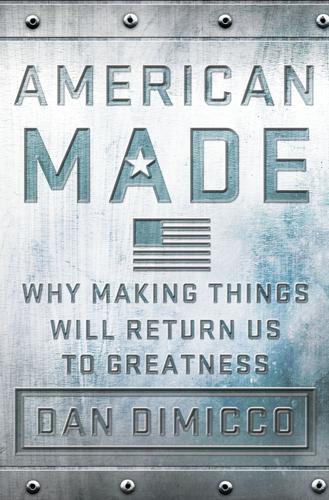
American Made: Why Making Things Will Return Us to Greatness
by
Dan Dimicco
Published 3 Mar 2015
And think about the hundreds of billions that the federal government has spent over the years on defense research. The Defense Advanced Research Projects Agency is one of the great legacies of the Sputnik crisis. DARPA has had a hand in artificial intelligence research, supersonic and stealth flight, passive radar, the driverless car, and creation of a certain computer network that eventually became the Internet. But a large percentage of R&D spending today comes from the private manufacturing sector. You need to be able to make and use what you innovate. You cannot expect to reap the real benefits of innovation if you leave the making and the building to other countries.
…
Fact: according to the Organization for Economic Co-operation and Development, 70 percent of Americans have access to high-speed connections, compared with 94 percent of South Koreans. And the average connection speed in Seoul is about 200 times faster than it is in Charlotte.13 Don’t forget, a road is a road is a road. We may figure out better ways of collecting tolls, or invent sophisticated ways of sequencing traffic patterns to ease congestion, or even perfect a driverless car. But we still need roads and bridges for all of it. And by the way, once we do that, the benefits extend to the whole world, not just the United States, because foreign investors will be more likely to put their money into a country that offers an excellent infrastructure and the rule of law, enforceable contracts, robust protections for intellectual and private property, and capitalism rightly understood.
…
Now consider this: the governments that signed on to the UN framework on climate change in 1992 could not have imagined the rise of Amazon.com, or the way Apple’s iPod and iPhone would change the way people listen to music and communicate, or the emergence of companies like Tesla Motors and technologies like Google’s driverless car. Private enterprise adapts quickly to changing circumstances and needs and often anticipates them. Government does not. Government can only react, and then often not very efficiently. But nobody wants to hear that. Instead, it’s just a lot of heated rhetoric about the need to do something, anything, about climate change, no matter what the cost.

Human + Machine: Reimagining Work in the Age of AI
by
Paul R. Daugherty
and
H. James Wilson
Published 15 Jan 2018
Normalization requires a subset of other skills—understanding of humanities, STEM skills, an entrepreneurial spirit, public relations acumen, and an awareness of social and community issues. Autonomous cars have been creeping up in our rearview mirrors for some time. In the early 2000s, DARPA organized a series of Grand Challenges to prompt researchers to develop robotic vehicles that could race against each other. DARPA’s effort was one of the early steps in popularizing driverless cars. Fast forward to today, when Tesla offers Autopilot for its cars, and Audi has launched its A7 Sportsback, nicknamed Jack, which is programmed to drive with humanlike quirks such as slowing down or speeding up to let another car into its lane. Audi, in particular, has an ad campaign to normalize the concept of its “piloted driving” systems.
…
“We are now addressing the subject from a completely different emotional side.”7 CEOs will play a significant role in normalizing AI technologies to the public. Right now, the public is mostly neutral on AI, although many people operate with assumptions based on the human versus machine binary. Because of this, one major event—such as a child being killed by a driverless car, or truck drivers striking in opposition to the threat of self-driving trucks—can create a crisis of confidence in the technology at large. CEOs must anticipate resistance—through understanding the needs and concerns of communities affected by the changes wrought by AI—and find ways to ameliorate strife.
…
James Wilson, Paul Daugherty and Prashant Shukla, “How One Clothing Company Blends AI and Human Expertise,” Harvard Business Review, November 21, 2016, https://hbr.org/2016/11/how-one-clothing-company-blends-ai-and-human-expertise. Chapter 5 1.Melissa Cefkin, “Nissan Anthropologist: We Need a Universal Language for Autonomous Cars,” 2025AD, January 27, 2017, https://www.2025ad.com/latest/nissan-melissa-cefkin-driverless-cars/. 2.Kim Tingley, “Learning to Love Our Robot Co-Workers,” New York Times, February 23, 2017, https://www.nytimes.com/2017/02/23/magazine/learning-to-love-our-robot-co-workers.html. 3.Rossano Schifanella, Paloma de Juan, Liangliang Cao and Joel Tetreault, “Detecting Sacarsm in Multimodal Social Platforms,” August 8, 2016, https://arxiv.org/pdf/1608.02289. 4.Elizabeth Dwoskin, “The Next Hot Job in Silicon Valley Is for Poets,” Washington Post, April 7, 2016, https://www.washingtonpost.com/news/the-switch/wp/2016/04/07/why-poets-are-flocking-to-silicon-valley. 5.

The Code: Silicon Valley and the Remaking of America
by
Margaret O'Mara
Published 8 Jul 2019
Those who had been present at the creation of the extraordinary creative explosion of the online era looked on in dismay at what all this freedom had wrought. “We were astoundingly naïve,” Mitch Kapor remarked regretfully as he looked out at the upended political landscape. “We couldn’t imagine what is now obvious: if people have bad motives and bad intentions they will use the Internet to amplify them.”30 DEPARTURE Into the Driverless Car The driverless cars slid silently through Mountain View’s eucalyptus-scented side streets, released into the wild during the quieter hiccup after the relentless morning rush. Compact and gleaming, all electric motor and spinning geo-locators sprouting from the roof, the cars were not actually without a driver: if you peered closely, you could see the outline of one or two heads inside, belonging to the young Googlers whose job it was to test and monitor and take notes and seize the wheel if anything went wrong.
…
ELLEN ULLMAN, Life in Code, 19983 CONTENTS Also by Margaret O’Mara Title Page Copyright Dedication Epigraph List of Abbreviations Introduction: The American Revolution ACT ONE: START UP Arrivals Chapter 1: Endless Frontier Chapter 2: Golden State Chapter 3: Shoot the Moon Chapter 4: Networked Chapter 5: The Money Men Arrivals Chapter 6: Boom and Bust ACT TWO: PRODUCT LAUNCH Arrivals Chapter 7: The Olympics of Capitalism Chapter 8: Power to the People Chapter 9: The Personal Machine Chapter 10: Homebrewed Chapter 11: Unforgettable Chapter 12: Risky Business ACT THREE: GO PUBLIC Arrivals Chapter 13: Storytellers Chapter 14: California Dreaming Chapter 15: Made in Japan Chapter 16: Big Brother Chapter 17: War Games Chapter 18: Built on Sand ACT FOUR: CHANGE THE WORLD Arrivals Chapter 19: Information Means Empowerment Chapter 20: Suits in the Valley Chapter 21: Magna Carta Chapter 22: Don’t Be Evil Arrivals Chapter 23: The Internet Is You Chapter 24: Software Eats the World Chapter 25: Masters of the Universe Departure: Into the Driverless Car Photographs Acknowledgments Note on Sources Notes Image Credits Index About the Author LIST OF ABBREVIATIONS ACM: Association for Computing Machinery AEA: American Electronics Association AI: Artificial intelligence AMD: Advanced Micro Devices ARD: American Research and Development ARM: Advanced reduced-instruction-set microprocessor ARPA: Advanced Research Projects Agency, Department of Defense, renamed DARPA AWS: Amazon Web Services BBS: Bulletin Board Services CDA: Communications Decency Act of 1996 CPSR: Computer Professionals for Social Responsibility CPU: Central processing unit EDS: Electronic Data Systems EFF: Electronic Frontier Foundation EIT: Enterprise Integration Technologies ENIAC: Electronic Numerical Integrator and Computer ERISA: Employee Retirement Income Security Act of 1974 FASB: Financial Accounting Standards Board FCC: Federal Communications Commission FTC: Federal Trade Commission GUI: Graphical user interface HTML: Hypertext markup language IC: Integrated circuit IPO: Initial public offering MIS: Management information systems MITI: Ministry of International Trade and Industry (of Japan) NACA: National Advisory Committee for Aeronautics, later superseded by NASA NASA: National Aeronautics and Space Administration NASD: National Association of Securities Dealers NDEA: National Defense Education Act NII: National Information Infrastructure NSF: National Science Foundation NVCA: National Venture Capital Association OS: Operating system OSRD: U.S.
…
SRI still did plenty of military work, but it now was grabbing national attention for what it was doing to make machines think. In November 1970, Life magazine invited its millions of readers to “Meet Shaky,” a robot that rolled the linoleum halls of SRI, capable of point-to-point navigation, “seeing” objects in its way, and rudimentary speech recognition. The mainframe-powered Shaky was a smartphone and a driverless car, fifty years before its time.12 Down the hall at SRI lay another future-tense lab, the Augmentation Research Center, led by a soft-spoken engineer in his forties named Douglas C. Engelbart. As academics and policymakers worried over the question of automation—the replacement of human workers with robotic machines, and human brains with artificially intelligent computers—Engelbart was one of a small and growing group of researchers interested in augmentation of human effort via technology.
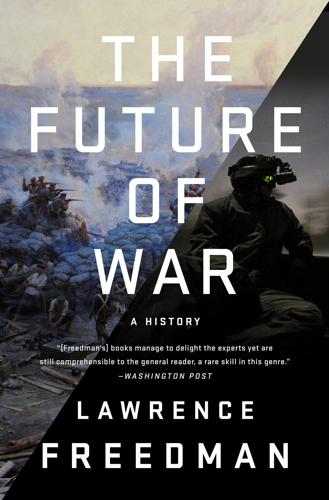
The Future of War
by
Lawrence Freedman
Published 9 Oct 2017
In addition the record of turning exciting new technologies into actual systems was less impressive than often supposed, with funding, bureaucratic, and engineering issues often causing severe delays.22 Another factor affecting the introduction of autonomous vehicles was that the lead with the new technologies was taken by the private sector. The most developed example was a driverless car, a much more challenging machine than a drone and one expected to have much more autonomy. As it moved forward on the ground it had to be aware of numerous potential obstacles and other vehicles with their own dynamics. The challenge grew the more urban and dynamic the operating environment. Driverless cars were first developed as a Pentagon programme in 2004 but resources were only poured into it as a commercial venture, which not only meant that the advances were out of state control but also that the state took second place in competition for the skilled engineers and software developers needed to take the work forward.
…
See casualties Debt of Honor (Clancy), 266 decisive battle, xviii–xix, 2–7, 9–10 Napoleonic Wars and, 8 See also knockout blow declaration of war, Hague Conventions and, 28 decolonisation, 142–143, 149–152 Deerhunter (film), 176 Defense Advanced Research Projects Agency (DARPA), 248–249 “Delicate Balance of Terror” (Wohlstetter, A.), 87 democracy, 136 Africa and, 152 barbarism and, 203 civil war and, 141 Cold War and, 134–135, 141 communism and, 134–135 CSCE and, 137 Iraq War and, 194 nationalism and, 138, 141 Russia and, 139 state-building and, 213 war, academic study of and, 137–140 democratic peace, 137–141 Democratic Republic of the Congo (DRC), 160–161, 170–171, 173–174 Denmark, 7 Dennis, Anthony, 181 deterrence Cold War and, 79–80, 84–86, 92–94 conventional forces and, 93–94 cyberwar and, 237 nuclear stalemate and, 84–86, 92 nuclear war and, 79–80, 200 See also crystal ball effect Deutch, John, 235 diamonds, 159, 161–164 dirty bombs, 271–272 disaggregation, academic study of war and, 118–123 disarmament, 44–46, 49–50, 58, 83–84 disease, 126–129 See also HIV-AIDS Disease and Non-Battle Injury (DNBI), 127 Dobrynin, Anatoly, 103 doomsday machine, 77–79, 232 Douhet, Giulio, 56 Doyle, Arthur Conan, 40 Doyle, Michael, 137 Dr. Strangelove (film), 77–80, 231–232 DRC. See Democratic Republic of the Congo driverless cars, 246 drones, 241–253 See also artificial intelligence; driverless cars drought, 261, 263 drug trafficking, 254, 256–258 Dulles, John Foster, 98 Dumas, Samuel, 125–126 Dunant, Henry, 29 Dunlap, Charles, 201–202 Durant, Ariel, 114–115 Durant, Will, 114–115 Durdin, F. Tillman, 60 Eagleburger, Lawrence, 155 East Germany, 82, 86, 103 East Timor, 173 economic distress, civil war and, 160–164 economic interdependence, 7, 25, 42–43, 139, 163–164 Egypt, 75, 219, 261, 279 Einstein, Albert, 71 Eisenhower, Dwight D., 81 El Salvador, 121 11 September 2001, xx, 119, 148, 180, 182–183 Eliot, T.
…
Driverless cars were first developed as a Pentagon programme in 2004 but resources were only poured into it as a commercial venture, which not only meant that the advances were out of state control but also that the state took second place in competition for the skilled engineers and software developers needed to take the work forward. Competition for a mass market and vast R&D expenditures moved driverless cars to viable products while military programmes for autonomous vehicles lagged behind. A key feature of many of the vital systems introduced for the digital age, including Internet providers, search engines, hardware manufacturers, and software developers, was that they were owned and operated by private companies with global interests. Smartphones carried capabilities such as satellite imaging, navigations, data stores, and instant, encrypted communications of a quality once available to only the most advanced military organisations.

The Future Is Asian
by
Parag Khanna
Published 5 Feb 2019
Bike stations and dockless biking have been pioneered by companies such as Mobike and Ofo, which have spread from China across Asia and into Europe. As Asian cities prepare for driverless cars and buses on their street, policy makers, regulators, urban planners, and insurance companies are developing new frameworks to govern them. Even the Western firms ranked most likely to get self-driving cars onto the road first—including Ford, Renault, Daimler, Volkswagen, and BMW—will be looking to do so in Asia. In South Korea, Hyundai and Kia have partnered with Cisco Systems and other US IT companies to advance connected car communications. Baidu’s open-source approach to driverless-car software development, called Apollo, has lured Intel, Daimler, and Ford to contribute resources.
…
Each major Asian tech hub has a niche edge emerging from its ecosystems: Tel Aviv excels in cybersecurity, Singapore in fintech, Tokyo in robotics, Shenzhen in sensors, and so forth. Other places such as Dubai aren’t scientific pioneers but make themselves regulatory test beds for everything from drones to driverless cars. Asia’s cities lead the world in the deployment of sensor networks for the urban Internet of Things, lifting Korea’s semiconductor exports 55 percent from 2016 to 2017. Now such sensor networks as well as energy-efficient LED lights are being installed in second-tier areas such as India’s Bhopal.
…
Baidu might be on a collision course with Didi Chuxing—or perhaps it will simply buy it. US firms are now copying Chinese innovations. LimeBike in California is copying China’s dockless bike sharing as pioneered by Ofo and MoBike. DiDi has algorithms that predict which ride-sharing users will want a ride at certain times and locations and is designing driverless car interiors for shared augmented-reality experiences—programs that Uber and others will surely copy. Apple is conducting payments through the iMessage chat service, following what Tencent has done. Amazon now has a lending service similar to that of Alibaba. Facebook plans to follow WeChat by becoming a complete ecosystem of digital services.
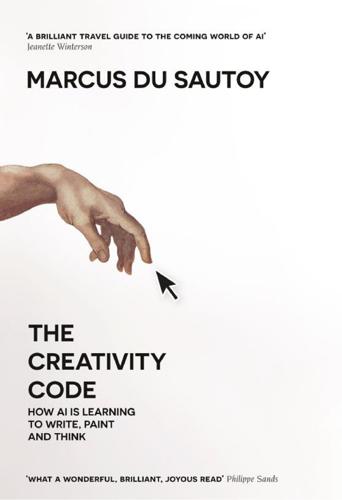
The Creativity Code: How AI Is Learning to Write, Paint and Think
by
Marcus Du Sautoy
Published 7 Mar 2019
If you want to understand how and why the algorithms that control modern life are doing what they do, you need to understand the mathematical rules that underpin them. If you don’t, you will be pushed and pulled around by the machines. AI is challenging us to the core as it reveals how many of the tasks humans engage in can be done equally well, if not better, by machines. But rather than focus on a future of driverless cars and computerised medicine, this book sets out to explore whether these algorithms can compete meaningfully with the power of the human code. Can computers be creative? What does it mean to be creative? How much of our emotional response to art is a product of our brains responding to pattern and structure?
…
So in October 2015 they decided to test-run their program in a secret competition against the current European champion, the Chinese-born Fan Hui. AlphaGo destroyed Fan Hui five games to nil. But the gulf between European players of the game and those in the Far East is huge. The top European players, when put in a global league, rank in the 600s. So, although it was still an impressive achievement, it was like building a driverless car that could beat a human driving a Ford Fiesta round Silverstone then trying to challenge Lewis Hamilton in a Grand Prix. Certainly when the press in the Far East heard about Fan Hui’s defeat they were merciless in their dismissal of how meaningless the win was for AlphaGo. Indeed, when Fan Hui’s wife contacted him in London after the news got out, she begged her husband not to go online.
…
If viewers are asked to count the number of passes made by one team, focusing their attention on the ball, most will completely miss the man in the monkey suit who walks through the players, bangs his chest and then walks off. These attacks on computer vision are just teasing out the algorithms’ blind spots – but we have plenty of them too. Given that driverless cars use vision algorithms to steer, it is clearly an issue that the algorithms can be attacked in this way. Imagine a stop sign that had a psychedelic sticker put on it, or a security system run by an algorithm that completely misses a gun because it thinks it’s a turtle. I decided to put the Kinect algorithm through its paces to see if I could confuse it with strange contortions of my body, but it wasn’t easily fooled.
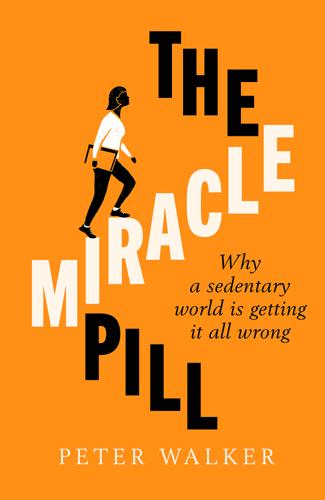
The Miracle Pill
by
Peter Walker
Published 21 Jan 2021
History might prove me wrong, but if towns and cities have a future in which physical activity becomes the norm, I’m not sure that technology, robotics and automation will be the primary reasons why. A few years ago I had a long chat with a senior executive from Sidewalk Labs, a Google spinoff company which seeks to use tech to reimagine how cities could work in the future. We discussed how driverless cars – which at the time, as now, were confidently billed as being just around the corner from ubiquity – could affect active travel. While stressing that predictions were essentially guesswork, he conjured up one scenario in which autonomous cars sped people from distant suburbs to city centres, but with the last half mile or so, where people lived and worked, reserved for modes like cycling and walking.
…
It’s part of the problem.’35 Another possibility, albeit in the slightly longer term, is the almost complete disappearance of all private cars from cities. But what will take their place? Will it be the hoped-for healthy mix of walking, cycling, public transport plus the occasional taxi or share ride? Or, if the technical challenges are finally met, could the newcomer be fleets of app-hailed driverless cars, an endlessly available, cheaper successor to Uber where people would expend even less energy than driving, dispensing with even the marginal exertion of pushing pedals and turning a steering wheel? There is an alternative model to the slightly theme-park likes of Woven City. Vauban is a suburb in the south of Freiburg, a small and famously liveable city in the southwest of Germany.
…
actin (protein) 40 active applause 176–7, 180, 271 Active Ten app (Public Health England) 57, 269 adenosine triphosphate (ATP) 40, 41, 276 Aldred, Rachel 119–20, 139 Alzheimer’s disease 5, 49, 186, 226, 232, 233, 234 Agricultural Revolution/Agrarian Revolution 15–16 Amager Bakke/Copenhill waste-burning energy plant, Denmark 134–5 Amish people 17–18, 208 anaerobic respiration 40 Annual Travel Survey 3 anxiety 5, 50, 57, 112 Araujo, Claudio Gil 229–32 Aspern, Vienna 140 asthma 10–11, 160, 172, 209 Atlas, Charles (Angelo Siciliano) 31 Barnet Graph of Doom 100–1 basal metabolic rate (BMR) 51, 158, 191 Better (non-profit social enterprise) 224 BeUpstanding 195–6 bike couriers 11–13 Biobank public health project 114 biophilia 133 Bjarke Ingels Group (BIG) 132–5, 138–9 Blackburn, Elizabeth 41–2 Blair, Steven 19–20, 21, 46, 169–72, 275–6 blood pressure 5, 41, 46, 48, 57, 75, 90, 160, 225, 227, 265 Boardman, Chris 124–5, 127, 137, 264 BodPod 172–3, 174 body mass index (BMI) 146–7, 150–2, 161–4, 167, 170, 171, 172, 173, 193, 243 bone density/health 16–17, 22, 23, 44, 46, 49, 67, 101, 209, 223, 227–8 Boyd, Andrew 105–6 breast cancer 48, 160 British Medical Journal (BMJ) 64, 65, 80 Buchan, William: Domestic Medicine 63 Buchanan, Colin: Traffic in Towns 120–1 Buchanan, Nigel 203–4, 206, 207–8 Buchner, David 228 Bull, Fiona 98–9 Burden of Disease, WHO 47, 90 Burfoot, Amby 78, 79 Burnham, Andy 124, 264, 266 bus drivers, heart attack rates in London 61–2, 71–3 Bushy Park Time Trial 250 calories 13, 19–20, 19n, 27, 51, 54, 75, 113, 114, 146, 148, 153, 155, 156–7, 158, 165–6, 169, 190 Cambridge University 64, 65–6, 187 cancer 5, 41, 48–9, 62, 79, 90, 114, 160, 186, 187, 227, 231–2 car children and 216, 219, 258, 263–4, 265, 272 electric 137, 268 lobby 263 social engineering and 254, 258 town/city planning and 110, 111, 113, 121, 120–2, 124, 125, 126, 127–8, 129, 130, 131, 135, 136, 137, 138, 140, 141, 142, 191–2, 263, 265, 268 walking supplanted by 2, 3, 5, 53 cardiovascular activity 168–9, 209, 271–2 cardiovascular health bus drivers, heart attack rates in London 61–2, 71–3 children and 2, 213 coronavirus and 265 diabetes and 95 Harvard Alumni Health Study 75–7, 134 heart attacks 41, 48, 50, 62, 70, 71, 74, 75, 76, 77, 91, 92, 93, 106 heart disease 5, 43, 46, 48, 59, 68, 69, 70–4, 81, 82, 88, 89, 114, 152, 154, 243, 244 inactivity first linked to 47–8 life expectancy and 93 longshoremen health study, San Francisco 75 low-density lipoprotein (LDL)/triglycerides and 41, 43, 46, 185 mitochondria and 40, 41 rheumatic heart disease 68, 69–70, 82, 152 sitting and 5, 185, 186, 187, 199 Centers for Disease Control (US government) 95, 228 chair 178–9 Chan, Margaret 152–3 children 22–3, 203–20, 235 adult health, movement in childhood and 11, 209–10 BMI and 51 bone density and 16, 23, 49, 67, 209–10 childhood movement diminishing into adolescence and onwards 11, 210–11 cycling and 121, 130, 214, 237–8, 246, 247 Daily Mile and 203–7, 212–13 decline in activity/inactivity statistics 1–2, 10–11, 22–3, 24, 203–11, 252–3, 254, 256 girls, low activity levels in 141–3, 204, 209, 210–11, 256 independent childhood mobility, perceived cosseting of children and 216–20 life expectancy and 97 obesity and 84, 152, 153, 252–3, 256–7 schools and see schools social care and 100 social engineering and 244, 245, 246, 247–9, 252–3 town/city planning and 121, 122–3, 130, 138, 139–40, 142, 216–20 cholesterol 43, 185, 242–3 cigarettes 10, 29, 47, 62, 75, 76, 79, 92, 98, 105, 176, 177, 242–4 cognitive function 5, 46, 49, 57, 87, 186, 226, 232, 233, 234 Coldbath Fields Prison, London 63–4 colon cancer 48 co-morbidity 89, 91 commuting 58, 111, 114–18, 125, 127–9, 148, 183, 184, 199–200, 221, 270, 273, 274 Cooper, Ashley 129 Cooper, Ken: Aerobics 78, 79 Copenhagen, Denmark 109–12, 122–3, 125, 134, 135, 184, 240 Coronary Heart Disease and Physical Activity of Work 61–2, 71–3 coronavirus pandemic 8–10, 13, 33, 88, 90, 100, 115, 116, 130, 138, 154, 172, 173, 182, 183, 192, 198, 201–2, 214, 240, 247, 248, 257, 259–61, 263, 264–9 Cregan-Reid, Vybarr: Primate Change 178–9, 189 Criado-Perez, Caroline: Invisible Women 141 cycling body fat and 173 calories and 113 car travel supplants 2, 3, 127, 217–18 children/schools and 121, 130, 214, 217, 237–8, 246, 247 commuting/everyday cycling for transport 7, 9, 13, 27–8, 34, 58, 104–5, 113, 114, 115–20, 129, 137, 177, 182, 183, 184, 199, 213, 254, 261, 265, 270, 272–3 couriers 11–13 Denmark and 7, 111, 121, 128, 130, 135, 239, 240, 249, 268 electric-assist bicycle/e-bike 128–30, 135 Finland and 236–8, 246, 247 heart attacks and 74 lanes/routes 9, 28, 82, 111, 119, 120–1, 122, 124, 130, 133, 192, 237, 246, 253–4, 265, 267–8 leg strength and 224, 231, 276 METs and 51, 52, 58, 115, 129 mortality and 114–20, 121 Netherlands and 119, 121, 125, 127, 128, 239, 240, 249, 268 Olympics and 34 overweight people and 166 Peloton 31 postmen and 73 safety/road danger 28, 118–19, 121, 125–6, 128, 137, 216–18, 240, 260 Slovenia and 253–4 social engineering and 236–8, 239–40, 246, 247, 249, 253–4, 256 share schemes 106 short car trips and 136, 137, 143 town/city planning and 33, 111, 112, 113, 114–20, 121, 122, 124–6, 127–31, 136, 137, 141, 143, 191, 192, 236–9, 246–7, 249, 253–4, 256, 263–4, 267–8 cytokines 42, 161, 162 Dahl, Roald 217–18 Daily Mile 203–7, 212–13, 214, 249, 251, 261, 262 Davies, Adrian 5, 35 dementia 5, 49, 87, 88, 226, 227, 229, 232–4 Denmark cycling in 7, 111, 121, 128, 130, 135, 137–8, 184, 239, 240, 249, 268 town/city planning in 109–12, 114–15, 121, 122–3, 125, 128, 130, 131, 132–5, 268 Department for Transport, UK 3 depression 5, 50, 106, 250 diabetes 88, 90, 95, 102, 186, 187, 192–3, 227 pre-diabetes 37, 59, 188 type 1 37, 94 type 2 4, 5, 36, 37, 41, 42, 43, 46, 48–9, 57, 89, 93–4, 99, 106–8, 129, 145, 146, 151, 160, 162–3, 167, 185, 193, 215, 222, 265 Diabetes UK 108 Disneyland 135–6 Dober Tek campaign 254–5 Doll, Richard 79 Donaldson, Liam 79 driverless cars 136, 137 Dunstan, David 192–3, 200 duurzaam veilig (sustainable safety) 126 electric-assist bicycle/e-bike 128–30, 135 electric vehicles 128–30, 135, 136–7, 268 endocrine system 42 Equinox (US gym chain) 32 Erickson, Kirk 226, 233–4, 275 exercise see individual exercise and area of exercise ‘fat and fit’ 147, 169–75 fat, body 42–4, 145, 146–7, 151, 161, 162, 165–6, 167, 169–75, 185, 188, 193, 242, 255 financial costs of inactivity 87–143 mortality and morbidity and 90–3 NHS/universal medical systems and 87–108 non-medical long-term action against preventable conditions and 102–8 social care and 100–2 total additional costs imposed on health services due to inactivity 94–5 Finland 236–47, 258 cycling in 236–8, 246, 247 Finnish Schools on the Move 211–12, 246, 252 Global Report Card study on childhood activity levels and 252–3, 255 Helsinki central library 252 Network of Finnish Cycling Municipalities 247 social engineering in 236–47, 249, 252, 262, 264 Sports Act (1980) 245–6 Sports Act (1999) 246 Winter Cycling Congress 238, 246 see also individual place name Fitbit 54, 181 fitness industry 3, 31, 33, 34 fitness watches 116, 181, 270–1 food corporation lobby 148 ‘four by four’ threat (four most damaging NCDs) 90 Frauen-Werk-Stadt (Women’s Work City), Vienna 140–1 Freiburg, Germany 137–8 Frome, Somerset 141–3 Garmin 116, 181, 270–1 Gehl, Jan 109–12, 120, 122–4, 125, 126, 131, 135, 184, 268, 275 Life Between Buildings 110, 122–3, 131 Gill, Tim 138, 218–20 No Fear: Growing Up in a Risk-Averse Society 219–20 Glasgow University 66, 68, 134, 163 Global Report Card study on childhood activity levels 24, 252–3 glucose intolerance 37, 38, 167, 185, 192–3, 194 Gobec, Mojca 254–5 Googleplex, Mountain View 133, 196 Greater Manchester 124–5, 127, 264–6 gyms 1, 4, 26, 30–5, 51, 106, 149, 166, 167, 220–1, 223–4, 256, 276 Hartley, Sir Percival Horton-Smith 64–5 Harvard Alumni Health Study 75–7, 134 Harvard University 46, 52, 74, 76, 77, 134, 171 Haskell, William 26, 274 Hatano, Yoshiro 54 Health Education Authority 210 health gap (gap between life expectancy and healthy life expectancy) 92–4, 95, 99–100, 222 Healy, Genevieve 194–6, 274 heart attacks 41, 48, 50, 62, 70, 71, 74, 75, 76, 77, 91, 92, 93, 106 see also cardiovascular health heart disease 5, 43, 46, 48, 59, 68, 69, 70–4, 81, 82, 88, 89, 114, 152, 154, 243, 244 see also cardiovascular health heart rate 13, 27, 53, 116, 117, 129, 181, 197, 270 Hidalgo, Anne 192 high-density lipoprotein cholesterol (HDL) 43, 185 Hillman, Mayer: One False Move 217–18 Hillsdon, Mervyn 79–80, 83, 84, 85 Hippocrates 63 Hobro, Denmark 131 hunter-gatherers 5, 15, 16, 17 Hunt, Jeremy 261–4 Imbeah, Alistair 224 inactivity financial costs of 87–143 see also financial costs of inactivity obesity and see obesity sitting and see sitting see also individual area and consequence of inactivity incidental activity (activity which takes place as part of your regular day) 27, 114, 220 individual responsibility 2, 30, 58, 148, 263 industrialisation 2, 30 inequality (of income and opportunity) 103 Ineos 205 inflammation 42, 48, 68, 161, 162, 223 Institute of Hygiene and Occupational Health, Sofia 165 insulin 36, 37, 38, 42, 43, 57, 146, 161, 162 International Olympic Committee 81 International Space Station 44 Johnson, Boris 259, 260, 261, 264, 266, 267 Kail, Eva 139–43 Kelly, Mark 44 Kelly, Phil 88–9, 96–7, 103–5, 107 Kelly, Scott 44 Keston, John 225 keto diet 146 King’s College Hospital, London 87–9, 91 Kiuru, Krista 238–9, 245 Korhonen, Nina 246, 248–9, 252 Kraus, Hans: Hypokinetic Disease: Diseases Produced by Lack of Exercise 74 lactic acid 40–1 Lancet, The 23, 46, 47, 73, 95, 98, 128, 153, 199, 210 Lean, Mike 163–4 Lee, I-Min 46, 47, 52, 55, 56, 59, 60, 74, 77, 78, 80, 81, 82, 274 Levine, James 189–92, 193, 194, 196–7, 199, 201 Lewis, Thomas 68, 71–2 life expectancy 91–2, 99, 221–2 health gap (gap between life expectancy and healthy life expectancy) 92–4, 95, 99–100, 222 lipaemia 43 liver 161, 186, 187 Longevity of Oarsmen study, The 64–5 longshoremen health study, San Francisco 75 low-density lipoprotein (LDL) 43, 185 Lucas, Tamara 73–4, 83, 85 lung cancer 48, 79 lung function 5, 95–6 Lykkegaard, Kasper 181–2 Mackenzie, Richard 36–8, 43, 59, 117, 274–5 Maguire, Jennifer Smith 31, 32, 33 Mancunian Way, Manchester 124–5 Marin, Sanna 238 Marmot, Michael 82–3 ‘Matthew effect’ 206 Mayer, Jean 154–6, 157, 175 Physiological Basis of Obesity and Leanness 155–6 McGovern, Artie 31 meals, movement and processing of fats and sugars after 43–4, 167, 183, 188, 194, 272 mental health 49–50, 74, 204, 211 MET (metabolic equivalent) 51–2, 58, 115, 129, 178 metabolic disorders 5, 43, 49, 74, 95 see also individual disorder name metabolic rate 39, 51, 158, 191 micro mobility 135 Miliband, Ed 266–7 minimum amount of moderate activity needed to maintain health, recommended 116–17 mitochondria 41, 48, 167 Mitrovic, Polona Demšar 254 modal filtering 126 morbidity 89, 91–3, 160, 168–9, 227, 256–7 Morris, Annie 66–7 Morris, Jerry 61–3, 64, 65, 66–74, 75, 77, 79, 80–6, 152, 154, 241 Morris, Nathan 66–7, 83 Moscow 111, 112, 123 Mosley, Michael 229 movement decline of everyday 15–35 rediscovery of benefits of 61–86 see also individual type of movement muscle leg 224, 231, 276 skeletal 40, 42, 43, 167, 276 smooth 40 strength/muscle training 22, 223, 228, 271–2 wastage 22, 42, 223–4 Muscular Christianity 30 myosin (protein) 40 ‘nanny state’ 9, 243–4, 262–3, 264, 265 NASA 44 National Fitness Survey (1990) 84 National Health Service (NHS) 9, 70, 101, 164, 179, 223, 266 cost of inactivity to 9, 89–90, 93–7, 101, 104, 106–7, 153–4 social prescribing 105–6 National Lottery 33 Nebelong, Helle 219–20 Netherlands 119, 121, 125, 127, 128, 166, 239–40, 249, 268 Nieman, David 265 Niemi, Joonas 246, 248–9, 252 non-communicable diseases (NCDs) 90, 98 non-exercise activity thermogenesis (NEAT) 190–1, 194–5 North Karelia, Finland 241–3, 244, 245, 257 obesity 5, 19, 89, 98, 144–75, 215, 241 activity required to lose significant amounts of weight 144–7, 164–9 age and 152 basal metabolic rate and 158, 191 BMI and 146, 150–1, 160, 161–4, 167, 170, 171, 172, 173 body fat percentage and 146–7, 151, 165, 167, 170, 172–4, 193 childhood and 84, 152, 153, 212 costs of 95, 153–4 crisis 152–3, 154, 157 deaths and 47, 90, 160, 163, 170, 171 energy balance and 154–9 exercise benefits for 59, 144–7, 156, 158, 159, 165–6, 167–8 ‘fat and fit’ 169–75 health conditions associated with 160–1 obesogenic foodscape and 148–9 sex and 152 Slovenia and 256–7 stigma 147, 149–50 sugar and 146, 148, 156, 166 waist circumference and 161–4, 169, 172 weight loss/Watson and 144–6, 147–8, 149, 162, 166–7, 171, 173, 175, 270 worldwide spread of 152–3 Odense, Denmark 130 Ojajärvi, Sanna 247 older people/ageing staying active and 220–35 town/city planning and 138–9 Old Order Mennonites community 208 Olympics 33–4, 124, 224, 228, 255 (1964) 54 (1996) 33, 81 (2000) 33 (2012) 23 150-minutes of moderate exercise per-week recommendation 21–2, 26, 38, 54, 201, 270 active travel and 112 children and 207 commuting and 127–8 definitions of moderate and intense exercise 22 MET and 58 moderate activities, WHO list of possible 52 mortality and 45 older people and 222 strength training and 271–2 weight loss and 164 osteoporosis 16–17, 209, 227 Paffenbarger, Ralph 62, 64, 74, 75–82, 84–5, 101, 134, 225, 274 Paris 191–2, 197, 268 Parkrun 106, 249–51 pavement 120, 122, 124, 130, 140, 141, 237, 265, 268 pedometers 53–4 Peloton 31 personal choice, myth of 25–30 personal trainers 31 Peska, Pukka 46, 240–5, 257, 262–3 Physical Activity and Health (eds Bouchard, Blair, Haskell) 39 Physical Activity Guidelines Advisory Committee (PACAG) 45, 48, 57 physical activity level (PAL) 51 Pichai, Sundar 133 Policy Studies Institute 217 polypharmacy 89 portal theory 161 poverty 67, 68, 69, 82, 152, 180 Poynton, Frederic 68 protein 37, 40 Public Health England (PHE) 3, 22, 33, 57, 94–5, 97, 169, 269 Raab, Wilhelm: Hypokinetic Disease: Diseases Produced by Lack of Exercise 74 Radcliffe, Paula 36 ramp test 117–18 rheumatic heart disease 68, 69–70, 82, 152 risk-averse culture 207, 219 road danger 28, 119, 121, 125–6, 128, 137, 216–18, 240, 260 Roehampton University 36, 117, 172 Rook, Sir Alan 65 Ross, Robert 149–50, 157, 160, 161–2, 163, 164, 168–9, 171, 173, 174, 175 Rost, Leon 132–4, 135, 136, 139 Royal College of General Practitioners 105 running 1, 3, 9 ageing and 225, 227, 275 ATP and 40 bone density and 16 childhood and 203–7, 209, 210, 212–13, 214, 215, 246, 255 exercise industry and 31 home running treadmills 147 METs and 51, 58 150-minutes of moderate exercise per-week recommendation and 22, 52, 201 overweight people and 167 Paffenbarger and 76, 77, 78–9, 80, 225 Parkrun 106, 249–51 ultrarunning 32 schools 20, 27, 30, 121, 210–20, 236, 237–8, 239, 244, 245, 246, 247, 248, 252–7, 261–2 cycling to 121, 130, 214, 237–8, 246, 247 Daily Mile and 203–7, 212–13 English curriculum, physical education and 212, 248, 261–2 Finland and 211–12, 246, 252–3, 257 free school meals at 245 girls low activity levels in 204, 209, 210–11 Global Matrix 3.0 Physical Activity Report Card and 24, 252–3 independent childhood mobility, perceived cosseting of children and 216–20 playing fields 103, 107 Scottish schools curriculum, physical education and 212 sitting in 211–16 Slovenian 212, 255–7 social engineering and 237–8, 239, 244, 245, 246 sedentary behaviour 177–202 see also sitting Sens 181–4, 271 short-termism 107 Sidewalk Labs 136 Sim, David: Soft City 123–4, 126–7 Sinton-Hewitt, Paul 250 sit-stand test 228–31 sit-stand workstations 195, 196, 198–9, 200, 202 sitting 5, 13, 24, 26, 39, 49, 54, 62, 72, 176–202, 211–16 active applause and 176–7, 180, 271 average amounts of 179 breaking up prolonged 176–7, 180, 181, 182, 190–1, 193, 194–5, 197, 200, 271, 275 chair and 178–9 diabetes and 185, 186, 187, 188, 192–4 exercise and effects of 184, 199–201 fidgeting and 190–1, 194–5 health effects of 176–7, 185–8 low-density lipoprotein cholesterol (LDL)/triglycerides and 185 ‘new smoking’ headlines 177 schools and 211–16 sedentary behaviour defined 177–8 sit-stand test 228–31 sit-stand workstations 195, 196, 198–9, 200, 202 tracking/measuring 179–84 TV viewing and 178, 186, 187–8, 189, 192 workplace and 189–92, 195–9, 201–2 skeletal muscles 40, 42, 43, 167, 276 skinfold body fat test 173–4, 255 Skinner, James 21 sleep 5, 42, 50, 57, 184 Sleep, Leisure, Occupation, Transportation, and Home-based Activities (SLOTH) 25 Slofit programme 255–6 Slovenia 24, 212, 253–8, 261 Smith, Edward 63–4 smooth muscle 40 social care 97, 99–101, 108 social engineering 236–58 cycling and 236–8, 239–40, 246, 247, 249, 253–4, 256 Finland and 236–47, 249, 252–3, 255, 257, 258 see also individual area of Finland kindergartens and 252 mortality rates and 240–5 ‘nanny state’ objections to 243–4 obesity and 241, 252–7 Parkrun 249–51 political support, need for complete 244–5 schools and 236, 237–8, 239, 244, 245, 246–7, 248, 252–3, 255, 256, 257 Slovenia and 253–7, 258 sports facilities funding 245–6 tax and 245–6, 252 Youth Sports Trust, UK 247–9, 251 social medicine 61, 68–71, 83 Social Medicine Unit 61, 69–70 socialism 66, 67–8 social prescribers 105–6 Spevak, Harvey 32, 35 Sport England 34 stairs 28–9, 131–4 Starc, Gregor 255–7 St Mary’s Hospital, London 93 St Ninian’s primary school, Stirling, Scotland 203–7, 213 Stockholm, Sweden 141 Stop de Kindermoord (Stop the Child Murders) road safety mass protests, Netherlands (1970s) 121, 240 strength/muscle training 22, 223, 228, 271–2 stroke 5, 46, 61, 81, 89, 160, 180, 186, 267 technology, monitoring of activity levels and Active Ten app (Public Health England) 57, 269 activity trackers 38, 57, 116, 180–4, 200–1, 214–15, 269, 270–1 Sens activity tracker 181–4, 200–1, 214–15, 271 television viewing 26, 82–3, 121, 186–9, 192 telomeres 41–2, 226 10,000 steps a day target 26, 38, 52, 53–5, 56, 184, 200, 270, 275 Titmuss, Richard 68–9 town/city planning (built environment) 5, 28–9, 108, 109–43, 210 active travel and 109–43 Amager Bakke and 134–5 Buchanan and 120–1 cars, hegemony of 110, 111, 113, 120–2, 124, 125, 126, 127–31, 135–8, 140, 141, 142, 143, 191–2, 263, 265, 268 Copenhagen 111–12, 122, 123 coronavirus lockdown and 130–1 cycling and 111, 112, 113, 114–20, 121, 122, 124–6, 127–31, 136, 137, 141, 143 driverless cars and 136–7 duurzaam veilig (sustainable safety) concept 126 e-bikes and 127–30 Gehl’s philosophy 109–12, 120, 122–4, 125, 126, 131, 135 Googleplex, Mountain View and 132–4 health dividends of active travel and 114–20 Manchester and 124–5, 127 Odense and 130 older people/those with disabilities and 138–9 stairs and 131–2 Toyota Woven City 135–6, 137, 138–9 Vauban, Freiburg 137–8 walking and 109, 112, 113, 114, 115, 120, 121–7, 129, 130, 131, 132, 133, 134, 136, 137, 140, 141, 143 women and girls, discrimination against 139–43 Toyota Woven City, Japan 135–6, 137, 138–9 tracking, electronic activity 13, 17, 21, 26, 38, 52, 53–5, 56, 57, 113, 116, 180–4, 190, 200–1, 214–15, 269–71, 272 transport use see individual mode of transport travel, active 9, 24, 112–14, 118, 121, 126, 127, 131, 136, 143, 191, 216 see also individual mode of travel Travers, Andrew 100–1 treadmill desk 199 triglycerides 43, 185 True Finns 245 Tudor-Locke, Catrine 53–4, 56 Tulleken, Xand van 29–30, 44–5 Uber 137 ultrarunning 32 University of Massachusetts 53 Utrecht, Netherlands 125 Utzon, Jørn 111 Valabhji, Jonathan 93, 99, 104 Varney, Justin 97–8, 169, 198 Vartiainen, Juha-Pekka 237 Vauban, Freiburg, Germany 137–8 Vienna, Austria 140–3 VO2 max test 117–18, 173 walking Active Ten app and 57, 269–70 ageing and 102 assessing/tracking 26, 38, 52, 53–5, 56, 181, 182, 183, 184, 200, 269–70, 272 bone density and 16 brisk/speed of 3, 9, 22, 48, 52, 53, 55, 57, 60, 74, 79, 84, 86, 114, 167, 269 children and 11, 209, 214, 215, 216, 218, 246, 247 commuting and 114, 130 cycling and 114, 115 danger and 120 decline in 2, 3, 9, 16, 18, 19, 27–9, 33, 208, 216 fat processing/reduction and 43, 48, 185 150 minutes of moderate activity a week recommendation and 52–4 social prescribing and 106 stairs and 28–9, 131–4 10,000 steps a day target 26, 38, 52, 53–5, 56, 184, 200, 270, 275 town/city planning and 109, 112, 113, 114, 115, 120, 121–7, 129, 130, 131, 132, 133, 134, 136, 137, 140, 141, 143 weight loss and 144–5, 157, 165, 166, 167 workplace and 196, 197, 199, 200, 201, 202, 274, 275 WALL·E (film) 25–6 Watson, Tom 144–6, 147–8, 149, 162, 166–7, 171, 173, 175, 270 Downsizing 145 weekend warriors 58–9 Wellington, Chrissie 250, 251, 252, 257 Whyte, Martin 87–9, 91, 94, 95–6, 102–5, 106–8 Wicks, Joe 10 Wiggle 270 Wijndaele, Katrien 187–8 Winter Cycling Congress 238, 246 Wollaston, Sarah 263 Wolff’s Law (bones adapt to the repeated loads put on them) 209 women 6 BMI and 51 bone density 16, 18, 227 cancer and 48 diabetes 151 girls, low activity levels in 141–3, 204, 209, 210–11, 256 life expectancy 92, 222 modern decline in activity among 19, 22, 24 obesity and 150, 151, 152, 153, 154, 157, 159, 160, 161, 162–3, 164, 165, 171 150-minutes of moderate exercise per-week recommendation and 22, 207 public space and 139–43 sitting and 186 walking and 53–4, 55, 84, 121 World Health Organization (WHO) 22, 47, 52, 98, 151, 152–3, 210 World Obesity Forum 154 Wright, Chris 247–9, 252, 257 Wyllie, Elaine 203–4, 205, 206, 209, 212, 213, 262 Youth Sports Trust 247–9, 251 First published in Great Britain by Simon & Schuster UK Ltd, 2021 Copyright © Peter Walker, 2021 The right of Peter Walker to be identified as the author of this work has been asserted in accordance with the Copyright, Designs and Patents Act, 1988.
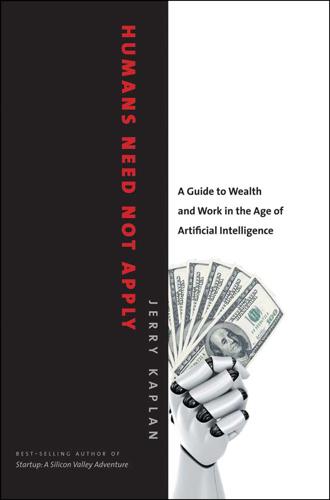
Humans Need Not Apply: A Guide to Wealth and Work in the Age of Artificial Intelligence
by
Jerry Kaplan
Published 3 Aug 2015
When automobiles were first introduced in the early 1900s, people called them “horseless carriages” because the horse-drawn carriage was the nearest reference point with which to grasp the concept of the newfangled machines. (And how many people today realize that “horsepower” actually refers to real horse power?) Now we talk about “driverless cars” for the same reasons. Both phrases are examples of describing new technologies in terms of old, but in doing so, the words obscure their real potential. A “driverless car” sounds like some terrific new technology with which to trick out your next vehicle—like parking sensors or a backup camera. It’s just like your old car, except that now you don’t have to drive it yourself. But the truth is that this new technology is going to dramatically change the way we think about transportation, with an impact on society far greater than these words suggest.
…
See shipping depth perception, 42–43 D. E. Shaw and Company, 53, 95, 96, 97 DIDO (distributed input, distributed output), 127 digital recording, 193 Dijkstra, Edgar, 3 dishwashing, 145 Disneyland VIP tour option, 165 doctors. See medical care Dow Jones Industrial Average, 8–9, 61–63 driverless cars. See autonomous vehicles drones, 43, 44 duty-based normative ethics, 82 “Easterlin Paradox,” 225n31 economic system, 7, 10–15 absolute vs. reactive needs and, 186 asset-based, 14–15, 175–87 autonomous vehicles’ effects on, 195, 196 class and, 115, 116, 118 competitive advantage and, 102, 103, 106, 161–65, 181, 186, 187 expansion of, 15, 165 incentives and, 176, 177 inequality and, 12–15, 117–18, 165–66, 174–76 inflation rate, 173, 175 innovation and, 158, 161–64, 186–87 Silicon Valley disruption of, 16 synthetic intellect takeover of, 201–2.
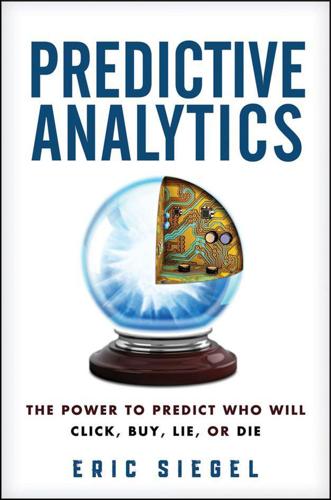
Predictive Analytics: The Power to Predict Who Will Click, Buy, Lie, or Die
by
Eric Siegel
Published 19 Feb 2013
For a short autobiographical essay by John Elder, see: Mohamed Medhat Gaber, Journeys to Data Mining: Experiences from 15 Renowned Researchers (Springer, 2012), 61–76. Regarding terrified spouses of astronauts: Mike Mullane, Riding Rockets: The Outrageous Tales of a Space Shuttle Astronaut (Scribner, 2006). $10 million Grand Challenge: The Defense Advanced Research Projects Agency (DARPA); est. 1958. See: www.darpa.mil/. Driverless cars: Daniel Nasaw, “Driverless Cars and How They Would Change Motoring,” BBC News Magazine, May 10, 2012. www.bbc.co.uk/news/magazine-18012812. Quote from Stephen Dubner: Stephen J. Dubner, “Why Can’t We Predict Earthquakes?” Freakonomics Radio, March 31, 2011. www.freakonomics.com/2011/03/31/why-cant-we-predict-earthquakes-full-transcript/.
…
Astronauts are in essence stunt pilots, voluntarily strapping themselves in to serve as guinea pigs for a giant experiment, willing to sacrifice themselves in order to be part of history. From grand challenges are born great achievements. We’ve taken strolls on our moon, and in more recent years a $10 million Grand Challenge prize was awarded to the first nongovernmental organization to develop a reusable manned spacecraft. Driverless cars have been unleashed—“Look, Ma, no hands!” Fueled as well by millions of dollars in prize money, they navigate autonomously around the campuses of Google and BMW. Replace the roar of rockets with the crunch of data, and the ambitions are no less far-reaching, “boldly going” not to space but to a new final frontier: predicting the future.
…
death predictions deception, predicting decision trees CART decision trees circle single model decision boundaries in getting data from in machine learning methods competing with mortgage risk decision trees overlearning and assuming random forests uplift trees deduction vs. induction Deep Blue computer DeepQA Delta Financial Deming, William Edwards Democratic National Committee (DNC) Dey, Anindya Dhar, Vasant diapers and beer, behavior and Dick, Philip K. differential response modeling. See uplift modeling discrimination, risks of disease, predicting Disraeli, Benjamin Divorce360 divorce, predicting dolls and candy bars, behavior and donations and giving, predicting do-overs downlift driver inatentiveness, predicting driverless cars Drucker, Peter drugs effects and use, predicting “Dry Bones” (song) DTE Energy Dubner, Stephen J. Duhigg, Charles dunnhumby Dyson, George E Earthlink.com Echo Nest economic recession Edison, Thomas education grades, predicting guided studying for targeted learning mouse clicks and online content PA for student dropout risk, predicting student knowledge and performance, predicting eHarmony Eindhoven University, Netherlands Einstein, Albert Elder, John about black box trading systems on employee death predictions on generalization paradox in Netflix Prize competition on passion for science on power of data risks taken by Elder Research elections, crime rates and electoral politics musical taste political affiliation Obama for America Campaign uplift modeling applications for voter persuasion, predicting electronic equipment, predicting fault in Elie Tahari e-mail consumer behavior and addresses for government storage of Hotmail.com phishing e-mails spam filtering for user preferences and mood emotional data emotions in blog posts cause and effect of human behavior and money and mood labels mood predictions and serendipity in innovation validating feelings See also human behavior employees and staff job applications and positions job performance, predicting job promotions and retention job skills, predicting LinkedIn for career predictions PA examples in privacy concerns and data on quitting, predicting Energex (Australia) energy consumption, predicting Ensemble Effect, The Ensemble Experts ensemble models about CART decision trees and bagging collective intelligence in complexity in crowdsourcing and generalization paradox and IBM Watson question answering computer and IRS (tax fraud) meta-learning and Nature Conservancy (donations) Netflix (movie recommendations) Nokia-Siemens Networks (dropped calls) University of California, Berkeley (brain activity) for uplift modeling U.S.

A World Without Work: Technology, Automation, and How We Should Respond
by
Daniel Susskind
Published 14 Jan 2020
There are now driverless tractors and cow-milking machines, cattle-herding drones and automated cotton strippers.11 There are tree-shaking robots that harvest oranges, vine-pruning robots that collect grapes, and vacuum-tube-wielding robots that suck apples off the trees.12 There are fitness trackers that monitor animal well-being, camera systems that detect unhealthy produce, and autonomous sprayers that drop fertilizer on crops and pesticide on weeds.13 In Japan, for example, 90 percent of crop spraying is done by unmanned drones.14 One British farm plants, nurtures, and harvests barley without a person setting foot in the field at all.15 The US agricultural giant Cargill uses facial recognition software to monitor their cows.16 The Chinese tech conglomerate Alibaba is developing similar technology to follow pigs, and also plans to use voice recognition software to listen for the squeals of piglets being crushed by their mothers—this, it is thought, will reduce the piglet mortality rate by 3 percent a year.17 Today, much of the excitement about automating tasks in the physical world is focused on driverless cars and trucks. In the past, it was thought that the only way for a computer to operate a vehicle was to copy human drivers, to mimic the thinking processes they go through behind the wheel. In keeping with the spirit of the pragmatist revolution, that belief turned out to be wrong: driverless cars, we now realize, do not have to follow fixed, step-by-step rules of the road articulated and set down by human beings, but instead can learn how to navigate by themselves, from the bottom up, drawing on sensor data from millions of real and simulated test drives.18 Ford has committed to launching a driverless car by 2021.19 Others have made similar pledges.
…
In keeping with the spirit of the pragmatist revolution, that belief turned out to be wrong: driverless cars, we now realize, do not have to follow fixed, step-by-step rules of the road articulated and set down by human beings, but instead can learn how to navigate by themselves, from the bottom up, drawing on sensor data from millions of real and simulated test drives.18 Ford has committed to launching a driverless car by 2021.19 Others have made similar pledges. Tesla claims its cars already have all the hardware needed to drive themselves at a safety level “substantially greater than that of a human driver.”20 Given that, on average, one person is injured in a traffic crash somewhere in the world every second—and one is killed every twenty-five seconds—the prospect of self-driving vehicles is something to be welcomed.21 The most immediate impact of driverless vehicles is likely to be on freight delivery, rather than personal transport, due in part to the relative importance of the cargo.
…
The women’s liberation movement of the 1970s, for instance, understood this very well.51 They fought to make the world wake up and see that the personal part of our lives—sex and relationships, child care and housework, fashion and pastimes—truly matters, that “the personal is political.” And in that spirit, Jamie Susskind writes that these days “the digital is political.” In the future, Big Tech will be ever more politically powerful in this broader sense. As described in Future Politics, these companies will set the limits of liberty—think of a driverless car that cannot go above a certain speed, for example. They will shape the future of democracy—think of an electorate reared on political facts curated to their personal tastes and served up by algorithms. And they will determine questions of social justice—think of someone who finds their request for a financial loan or health treatment turned down on the basis of personal data they never agreed to give away.52 In the twentieth century, our main preoccupation was with the economic power of large companies.

Surviving AI: The Promise and Peril of Artificial Intelligence
by
Calum Chace
Published 28 Jul 2015
Accurate facial recognition was achieved in the mid-2000s, and in 2012 a Google system reviewing randomly-selected pictures on the internet recognised that cats were a category of images. The remarkable thing about this achievement is that the system had never been taught about cats. It was a milestone in machine learning. In 2011, Nevada became the first US state to allow driverless cars to be tested on its roads. Nevada was joined by Florida and California the following year. By June 2015, Google’s small fleet of driverless cars had clocked up a million miles without a single accident that was not caused by a human. Each car is fitted with a $70,000 LIDAR sensing system and $80,000 of other mapping and analysis equipment. Each has a driver and a Google engineer.
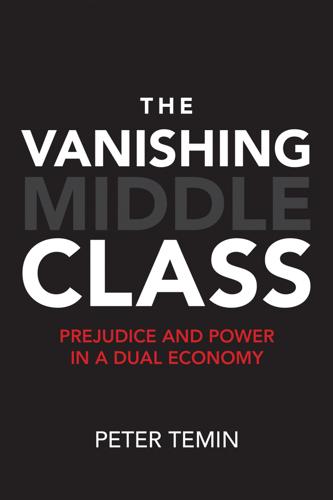
The Vanishing Middle Class: Prejudice and Power in a Dual Economy
by
Peter Temin
Published 17 Mar 2017
The increasing role of independent contractors for the low-wage sector can be seen in the switch from consumers using taxi services to using Uber and other computer-based drivers. Uber recently settled a class-action suit by its drivers by paying them a bit more, but continuing to categorize them as independent contractors. And the bargaining power of these independent contractors will fall if Uber replaces them with driverless cars. Drivers now find their way with the aid of Uber maps on their smartphones; driverless cars can use the same maps once they learn how to drive in traffic.6 There also has been a sharp reduction in competition among large companies in America due partly to the growth of network effects and partly to a relaxation of antitrust standards for mergers.
…
Holder, 65, 89, 142, 159, 180n11 Slavery, xi–xii, 159 abolitionists and, 51, 54, 58 cities and, 133 Civil War and, ix, 15, 17–18, 51, 65, 88, 94, 107, 180n13 concepts of government and, 88, 94 conservatives and, 56 cross-country comparison and, 148 equal protection clause and, 58, 67, 102 expansion of, 50–51 FTE (finance, technology, and electronics) sector and, 17, 22 indentured servants and, 50 Investment Theory of Politics and, 64 Irish Americans and, 54 legacy of, xiii, 133 Lincoln and, 51 lower human status and, 51 low-wage sector and, 27 public education and, 133 voting rights and, ix white rage and, 51 Snyder, Rick, xv, 36 Social capital bridging vs. bonding, 171n31 cities and, 131–133 dual economy and, 12 inequality models and, 165–166 low-wage sector and, 39, 153 mass incarceration and, 103, 107, 156 public education and, 117, 124, 126–128, 156 Putnam on, 11–12, 39, 165 transition and, 42 Social Security, 33, 45, 52 debt and, 141 government loan for, 174n15 phasing out of, 93 reform for, 69–70 standard of living and, 90–91 Trust Fund of, 69 Solow, Robert M., 162–165, 181n3 Soros, George, 85 South concepts of government and, 88, 91, 94 FTE (finance, technology, and electronics) sector and, 15, 17, 20, 22 Great Migration and, 20 (see also Great Migration) Investment Theory of Politics and, 62–67 Jim Crow policies and, 27, 49, 51–53, 58, 65–66, 104, 107, 154 low-wage sector and, 27–29, 34–35, 142, 170n1 oligarchy of, 88 public education and, 119, 125 race and, 50–59 Reconstruction and, 27, 51, 65, 67 slavery and, 94 (see also Slavery) very rich and, 80–81 voting rights and, 142, 170n1 Southern Strategy, 15, 27, 35, 81, 117, 142 Soviet Union, 22 Spain, 149 Stagflation, 16, 20–21 Stanford University, 57 State Department of Education, 121 State legislatures, 19, 62–63, 95 STEM (science, technology, engineering, and mathematics) Student loans, 43–45, 137, 140, 172n14 Subcontractors, 30–31, 57 Suffrage, 58, 64, 67 Switzerland, 149 Syrian refugees, 148 Tariffs, 21, 32–33 Taxes capital gains and, 24 cities and, 129–130, 134–136 concepts of government and, 89–92, 95 cuts in, 15, 19, 22, 71, 79 debt and, 158, 172n14 dual economy and, 10, 12 Earned Income Tax Credit and, 79 FTE (finance, technology, and electronics) sector and, 15, 17–18, 22–24, 155 government benefits and, 10 incentives and, 10 increase of, 17, 79, 91–92, 103, 141, 155, 174n15 inequality models and, 161–162 Investment Theory of Politics and, 62, 65 Kennedy and, 15 Lewis model and, 153 liberals and, 174n15 loopholes and, 24, 81–82 low-wage sector and, 31, 36 mass incarceration and, 101, 103, 105 one-percenters and, 22–23 Panama Papers and, 82 poll, 58, 65 property, 43, 103, 130 public education and, 46, 117–119, 124, 172n14 Reagan and, 22 reform and, 17, 22 S&L crisis and, 17 sales, 103 Social Security and, 33, 45, 52, 69–70, 79, 90, 93, 141, 174n15 tariffs and, 21, 32–33 very rich and, 79–82 Technology. See also FTE (finance, technology, and electronics) sector bomb robots and, 102 driverless cars and, 31 low-wage sector and, 28–30, 32 Luddites and, 155 mass transit and, 179n18 Tenure, 31, 52, 65 Tepper, David, 82 Terrorism, 83, 95, 143 Texas, 57–58, 80–81, 84, 102 Theory of Justice, A (Rawls), 92 Toyota, 34 Transition African Americans and, 41–42 capital and, 42–45 college and, 41–46 financial crisis of 2008 and, 45 FTE (finance, technology, and electronics) sector and, 11, 41–46, 154 human capital and, 44 industry and, 41, 43 inequality and, 46 Lewis model and, 44 low-wage sector and, 11, 41–46 mortgages and, 44–45 social capital and, 42 student loans and, 43–45 very rich and, 148, 151 wages and, 41–46 Troubled Asset Relief Program (TARP), 139, 179n4 Truman, Harry S., 81 Trump, Donald, xii, 66, 81–82, 92, 154, 174n11 Trump University, 66 Tuition costs, 43, 46, 105, 150 Tunnels, 134–135 Tutoring, 121, 178n18 Twitter, 38 Uber, 31 Ukraine, 58 Unemployment cities and, 132 debt and, 141 FTE (finance, technology, and electronics) sector and, 16, 21 Investment Theory of Politics and low-wage sector and, 34, 37, 157 mass incarceration and, 104, 113 participation rates and, 141, 179n2 race and, 52–53 very rich and, 78–79 Union City, 123–127 Unions African Americans and, 20–21 autoworkers and, 33–34 FTE (finance, technology, and electronics) sector and, 18–22, 28–29, 32–34, 64, 80–81, 116, 120 Heritage Foundation and, 18 individual freedom and, 17–19 Investment Theory of Politics and low-wage sector and, 28–29, 32–34 public education and, 116, 120 Reagan and, 22 very rich and, 80–81 United States Institute for Peace, 18 Universities debt and, 139–140 FTE (finance, technology, and electronics) sector and, 43–46 inadequate resources of, 116 need for refinancing, 157 race and, 52 student loans and, 43–45, 137, 140, 172n14 teacher salaries and, 170n31 transition and, 42–46 tuition costs and, 43, 46, 105 undue hardship and, 44 women and, 57 University of Manchester, 5 University of Phoenix, 43 U.S.
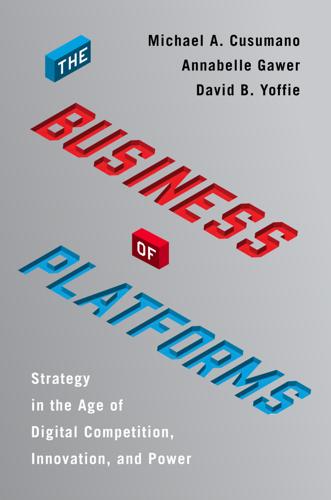
The Business of Platforms: Strategy in the Age of Digital Competition, Innovation, and Power
by
Michael A. Cusumano
,
Annabelle Gawer
and
David B. Yoffie
Published 6 May 2019
CHAPTER 7: LOOKING FORWARD: PLATFORMS AND THE FUTURE 1.Georgia Wells, “Snapchat Zigs Where Facebook Zags,” Wall Street Journal, June 14, 2018. 2.Khari Johnson, “Everything Amazon’s Alexa Learned to Do in 2017,” Venture Beat, December 29, 2017; Paul Cutsinger, “2017 Alexa Skills Kit Year in Review: More Than 100 New Products, Programs, Features, and Tools” January 5, 2018, https://developer.amazon.com/blogs/alexa/post/829a615b-301f-407c-96e7-6956fb988570/2017-alexa-skills-kit-year-in-review-more-than-100-new-products-programs-features-and-tools (accessed May 2, 2018); and Monica Chin, “Amazon Is Killing the Skill (as We Know It),” Tom’s Guide, September 13, 2018. 3.Jake Swearingen, “Amazon Could Give the Echo Dot Away and Still Make Money,” New York Magazine, January 3, 2018. 4.James Stables, “Google Assistant Aces Accuracy Study—but Alexa Is Catching Up Fast,” Ambient, April 30, 2018. 5.Rob Verger, “Someday, You Might Subscribe to a Self-Driving Taxi Service, Netflix-Style,” Popular Science, March 15, 2018. 6.Ibid. 7.Phil LeBeau, “General Motors Plans to Take On Ride-Sharing Services with Self-Driving Cars by 2019,” CNBC, November 30, 2018, https://www.cnbc.com/2017/11/30/gm-to-take-on-ride-sharing-services-with-self-driving-cars-by-2019.html (accessed June 2018). 8.Caitlin Huston, “Driverless Cars Could Cost 35 Cents per Mile for the Uber Consumer,” Marketwatch, September 19, 2016, https://www.marketwatch.com/story/demand-for-driverless-cars-could-boost-uber-to-2016-09-19 (accessed June 2018). 9.Christopher Mims, “How Self-Driving Cars Could End Uber,” Wall Street Journal, May 7, 2017. 10.Max Chafkin, “Uber’s First Self-Driving Fleet Arrives in Pittsburgh This Month,” Bloomberg, August 18, 2016. 11.See Lyft, “The Open Autonomous Era,” https://take.lyft.com/open-platform/ (accessed June 2018). 12.Mike Isaac, “Lyft Adds Ford to Its List of Self-Driving Car Partners,” New York Times, September 27, 2018, https://www.nytimes.com/2017/09/27/technology/lyft-ford-self-driving-cars.html?
…
Then we will look at two emerging and future battlegrounds: quantum computing and gene editing. CURRENT/ONGOING Perhaps the most important new technology in the battle for platforms over the next decade is artificial intelligence and machine learning. For many industries, AI has disruptive potential. Two of the most obvious and powerful applications for AI are voice recognition and driverless cars. Both involve a dramatic change in platform ecosystems. VOICE WARS: RAPID GROWTH BUT CHAOTIC PLATFORM COMPETITION Although artificial intelligence has been around for decades, one branch has made exceptional progress: machine learning (using special software algorithms to analyze and learn from data) and the subfield of deep learning (using hardware and software to build massively parallel processors called neural networks to mimic how the brain works).

Radical Technologies: The Design of Everyday Life
by
Adam Greenfield
Published 29 May 2017
As it happens, though the congelation of long-haul trucking, mechanized farming and urban logistics into a single job category obscures as much as it clarifies, it may not matter for our purposes. Trucking, farming and logistics are all seething sites of research into automation, and none will likely survive very long as distinctly human fields of endeavor. “Driverless” cars like those being developed by Google and Uber may dominate the mainstream media coverage, but the spare, highway-bound performance regime of long-haul trucking is far more amenable to automation than the stop-and-start, high-complexity environment of city and suburban driving, as Tesla’s July 2016 announcement of plans for an autonomous semi recognizes.19 Meanwhile, logistics has already shed most of the human labor force it once supported, with Jeff Bezos’s Amazon pioneering the development of robotic warehousing and fulfillment.20 Research has already moved on to attack the challenges of delivery by swarming drone as well as autonomous ground vehicle.
…
Bush,” New York Times, October 17, 2004. 73.Alex Tabarrok, “The Rise of Opaque Intelligence,” Marginal Revolution, February 20, 2015. 74.Travis Mannon, “Facebook Outreach Tool Ignores Black Lives Matter,” Intercept, June 9, 2016. 75.This is easier to do than it is to explain. See rednuht.org/genetic_cars_2/. 76.August C. Bourré, Comment, Speedbird blog, May 28, 2014, speedbird.wordpress.com/2014/05/28/weighing-the-pros-and-cons-of-driverless-cars/#comment-23389. 77.David Z. Morris, “Trains and Self-Driving Cars, Headed for a (Political) Collision,” Fortune, November 2, 2014. 9Artificial intelligence 1.Jeff Hawkins, keynote speech, “Why Can’t a Computer Be More Like a Brain? How a New Theory of Neocortex Will Lead to Truly Intelligent Machines,” O’Reilly Emerging Technology Conference 2007, San Diego, CA, March 27, 2007. 2.The Next Rembrandt project, nextrembrandt.com. 3.David Silver et al., “Mastering the Game of Go with Deep Neural Networks and Tree Search,” Nature, Volume 529, Issue 7587, pp. 484–9, January 28, 2016. 4.Younggil An and David Ormerod, Relentless: Lee Sedol vs Gu Li, Go Game Guru, 2016. 5.Nature Video, “The Computer That Mastered Go,” January 27, 2016, YouTube.com. 6.Ormerod, David.
…
R., 219 GitHub code repository, 242, 274, 281 “glassholes,” 84, 276 Global Village Construction Set, 103 go (game), 263–6 Goodhart’s Law, 247 Goodman, Bryce, 250–1 Google, 18, 24, 37–40, 46, 66, 69, 73–4, 76–8, 80, 84, 193, 212, 218–20, 247, 254, 264, 275, 276, 278, 281, 284 Boston Dynamics robotics division, 276 Chrome browser, 275 Daydream virtual reality headset, 275 Deep Dream, 80, 219 DeepMind, 264–5, 270, 276, 281 driverless cars, 193, 220 Glass augmented reality headset, 66, 73–4, 76–8, 80, 275 Home interface device, 38–40 Image Search, 218 Mail, 275 Maps, 24 Nest home automation division, 275–6 Nest thermostat, 275–6 Play, 18 Plus social network, 276 search results, 212 Sidewalk Labs, 276 Gladwell, Malcolm, 237 Glaser, Will, 220 Global Positioning System, 4, 16, 21, 26, 51, 67 Graeber, David, 205 Guangdong, 179 Guardian (newspaper), 276 Guattari, Félix, 148 Gu Li, 265 Hagakure, 267 Haldane, Andy, 194 Halo (game), 39 Hannah-Arendt-Strasse, 70 haptics, 16 Harman, Graham, 48 hash value, 123–4, 128–30 Hashcash, 121 hashing algorithm, 123 head-up displays, 66–7 Hearn, Mike, 179 Heat List, Chicago Police Department program, 230–1, 233, 235–6, 244 heroin, 228 heterotopias, 70 high-density polyethylene plastic filament, HDPE, 99 Hitachi Corporation, 197 Hollerith machines, 61 hooks, bell, 311 HR analytics, 199 Hungarian pengo, 120, 122 iaido, 266 iaijutsu, 266 IBM, 263 ideology of ease, 42 infrapolitics, 311 ING, bank, 262 input neurons, 215 Instagram.
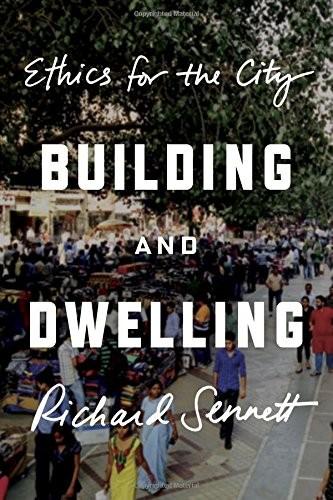
Building and Dwelling: Ethics for the City
by
Richard Sennett
Published 9 Apr 2018
In interacting with a replicant, like a voice-activated, voice-answering device, we communicate as with another person. A proper robot is not based on the human body, but has an independent form based on other logics. Take the driverless car Bill Mitchell was designing. The automobile could function as a replicant if it offered a steering wheel and brakes, even though the human driver would, hopefully, never have to use them; still, the passenger need not feel passively in the hands of the machine. If the driverless car functioned as a robot, without steering wheels and brakes, the experience would be like riding in a train or aeroplane – a passive one – the passenger taking its operations on trust.
…
Little or no human effort has to be exerted to make the machine move; the machine does the work. An interesting study in this regard compares driving a car with manual gears to driving an automatic; the manual-gears driver is less accident-prone because the effort of changing gears attunes the driver more to conditions around him or her, outside the car. With the advent of the driverless car, suspension of engagement in environmental conditions will be complete – which is the dark side of Bill Mitchell’s dream. The loss of maker-made scale echoes Peter Merholz’s celebration of user-friendly technology: as the effort to make the program work decreases, understanding of how it works also decreases.
…
A type-form differs also from a prototype. The type-form sets the terms for making a family of possible objects – objects yet to be made – while the prototype already exists in built form, as a specific demonstration of what can be done. Part of the problem with Bill Mitchell’s Media Lab experiments for driverless cars was that he thought in terms of type-forms rather than prototypes; he could explain – sort of – the relationship of the hardware to the human body, but he couldn’t show an actual example of what he meant. Still, thinking in terms of type-form rather than prototype loosened up his imagination.

Click Here to Kill Everybody: Security and Survival in a Hyper-Connected World
by
Bruce Schneier
Published 3 Sep 2018
Smart systems in buildings will provide more efficient lighting, elevator operation, climate control, and other services. Cities are starting to embed smart sensors in roads, streetlights, and sidewalk squares, as well as smart energy grids and smart transportation networks. Soon, cities will be able to control your appliances and other home devices to optimize energy use. Networks of smart driverless cars will automatically route themselves to where they’re needed, minimizing energy use in the process. Sensors and controls in the streets will better regulate traffic, speed up both police and medical response times, and automatically report road flooding. Other sensors will improve the efficiency of public services, from dispatching police to optimizing garbage truck routes to repairing potholes.
…
AI and intelligent robotics are the culmination of several precursor technologies, like machine-learning algorithms, automation, and autonomy. The security risks from those precursor technologies are already with us, and they’re increasing as the technologies become more powerful and more prevalent. So, while I am worried about intelligent and even driverless cars, most of the risks are already prevalent in Internet-connected drivered cars. And while I am worried about robot soldiers, most of the risks are already prevalent in autonomous weapons systems. Also, as roboticist Rodney Brooks pointed out, “Long before we see such machines arising there will be the somewhat less intelligent and belligerent machines.
…
The shipping giant Maersk was hit so badly by NotPetya that it had to halt operations at 76 port terminals around the world. Devices not normally associated with critical infrastructure can also cause catastrophes. I’ve already mentioned class breaks against systems like automobiles, especially driverless cars, and medical devices. To this we can add mass murder by swarms of weaponized drones, the disruption of critical systems by ever-more-massive botnets, using biological printers to produce lethal pathogens, malicious AIs enslaving humanity, malicious code received from space aliens hacking the planet, and all the things we haven’t thought of yet.
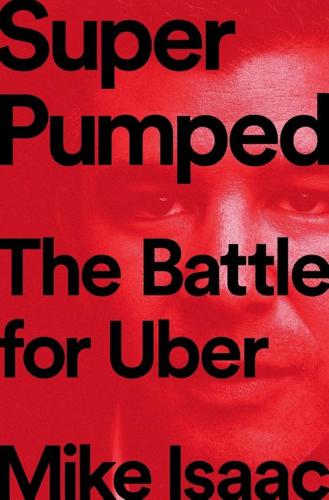
Super Pumped: The Battle for Uber
by
Mike Isaac
Published 2 Sep 2019
Now just a few weeks into his new job, Jones found himself in front of a laptop at Uber’s headquarters, faced with hundreds of pissed-off Uber drivers. His plan was to begin improving driver relations by introducing himself with a question-and-answer session conducted over Facebook. Drivers seized the opportunity to express their frustration. “What are you going to do about YOUR DRIVERS when driverless cars come on the road?” “Will you be giving drivers stock options once there are driverless cars on the roads?” “Has Uber forgotten that drivers built their company?” “Why should drivers be put out of work when they were the ones made Uber successful?” Drivers pelted Jones with questions and accusations. Jones was catching years of pent-up aggression from Uber’s driver force.
…
Says It’s Illegal.,” New York Times, December 14, 2016, https://www.nytimes.com/2016/12/14/technology/uber-self-driving-car-san-francisco.html. 254 Uber issued a statement: Isaac, “Uber Expands Self-Driving Car Service to San Francisco.” 255 Uber’s narrative was false: Mike Isaac and Daisuke Wakabayashi, “A Lawsuit Against Uber Highlights the Rush to Conquer Driverless Cars,” New York Times, February 24, 2017, https://www.nytimes.com/2017/02/24/technology/anthony-levandowski-waymo-uber-google-lawsuit.html. 255 Levandowski was unceremoniously terminated: Mike Isaac and Daisuke Wakabayashi, “Uber Fires Former Google Engineer at Heart of Self-Driving Dispute,” New York Times, May 30, 2017, https://www.nytimes.com/2017/05/30/technology/uber-anthony-levandowski.html. 256 “possible theft of trade secrets”: Aarian Marshall, “Google’s Fight Against Uber Takes a Turn for the Criminal,” Wired, May 12, 2017, https://www.wired.com/2017/05/googles-fight-uber-takes-turn-criminal/. 256 expressed contrition in a press interview: Mike Isaac, “Uber Releases Diversity Report and Repudiates Its ‘Hard-Charging Attitude,’ ” New York Times, March 28, 2017, https://www.nytimes.com/2017/03/28/technology/uber-scandal-diversity-report.html. 257 existence of Uber’s program “Hell”: Efrati, “Uber’s Top Secret ‘Hell’ Program.” 257 The team kept tabs: Kate Conger, “Uber’s Massive Scraping Program Collected Data About Competitors Around the World,” Gizmodo, December 11, 2017, https://gizmodo.com/ubers-massive-scraping-program-collected-data-about-com-1820887947. 257 recorded private conversations: Paayal Zaveri, “Unsealed Letter in Uber-Waymo Case Details How Uber Employees Allegedly Stole Trade Secrets,” CNBC, December 15, 2017, https://www.cnbc.com/2017/12/15/jacobs-letter-in-uber-waymo-case-says-uber-staff-stole-trade-secrets.html. 261 personal, private medical files: Kara Swisher and Johana Bhuiyan, “A Top Uber Executive, Who Obtained the Medical Records of a Customer Who Was a Rape Victim, Has Been Fired,” Recode, June 7, 2017, https://www.recode.net/2017/6/7/15754316/uber-executive-india-assault-rape-medical-records. 262 it was over for Eric Alexander: Mike Isaac, “Uber Fires Executive Over Handling of Rape Investigation in India,” New York Times, June 7, 2017, https://www.nytimes.com/2017/06/07/technology/uber-fires-executive.html. 262 Kalanick accepted her resignation: Mike Isaac, “Executive Who Steered Uber Through Scandals Joins Exodus,” New York Times, April 11, 2017, https://www.nytimes.com/2017/04/11/technology/ubers-head-of-policy-and-communications-joins-executive-exodus.html. 263 “The last note I got from her”: Kalanick, “Dad is getting much better in last 48 hours.” 265 “Over the last seven years”: Unpublished letter, obtained by author.
…
: Anthony Levandowski, “Pronto Means Ready,” Medium, December 18, 2018, https://medium.com/pronto-ai/pronto-means-ready-e885bc8ec9e9. 333 “Way of the Future”: Mark Harris, “Inside the First Church of Artificial Intelligence,” Wired, November 15, 2017, https://www.wired.com/story/anthony-levandowski-artificial-intelligence-religion/. 338 Larry Page grew increasingly “unpumped”: Daisuke Wakabayashi, “Why Google’s Bosses Became ‘Unpumped’ About Uber,” New York Times, February 7, 2018, https://www.nytimes.com/2018/02/07/technology/uber-waymo-lawsuit.html. 338 “He answered every question”: Eric Newcomer, “Inside the Abrupt End of Silicon Valley’s Biggest Trial,” Bloomberg, February 9, 2018, https://www.bloomberg.com/news/articles/2018-02-09/inside-the-abrupt-end-of-silicon-valley-s-biggest-trial. 338 As part of the terms of the settlement: Daisuke Wakabayashi, “Uber and Waymo Settle Trade Secrets Suit Over Driverless Cars,” New York Times, February 9, 2018, https://www.nytimes.com/2018/02/09/technology/uber-waymo-lawsuit-driverless.html. INDEX Page numbers followed by n refer to footnotes. 510 Systems, 108 ABC, 131 Abu Dhabi Investment Authority, 317 Abyzov, Ilya, 90 Accel, 40 Adobe, 27, 39 Advanced Micro Devices, 67 Advanced Technologies Group, 184 Agenda, 67 AIG, 33 Airbnb, xiii, 6, 65, 224 Akamai Technologies, 29, 31, 32 Albarrán, Tammy, 224, 226, 271–72, 275 Alexander, Eric, 260–61, 262, 337 Alfonso, Melene, 16 Alipay, 148 Allen & Company, 319, 320 Alltel, 100 Alphabet, 232.

The Contrarian: Peter Thiel and Silicon Valley's Pursuit of Power
by
Max Chafkin
Published 14 Sep 2021
It would show up at Juul, the e-cigarette company that shamelessly marketed to children, at Robinhood, which tempted novice investors with questionable financial products, and especially at Uber, which violated municipal statutes with apparent glee, underpaid drivers, and ignored common safety standards, celebrating these transgressions at every turn. When cities complained that Uber was breaking the law, Kalanick replaced his Twitter avatar with a picture of an Ayn Rand cover, and, as I reported in Businessweek, employees at the company’s driverless car division distributed stickers that proudly proclaimed, “Safety Third.” This was all, in a way, an extension of PayPal. “The PayPal Mafia philosophy became the founding principle for an entire generation of tech companies,” said McNamee. * * * — even so, in late 2000, Thiel wasn’t thinking about moving fast and breaking things.
…
YC—as it was known—had since expanded to include venture capital investing and had displaced Founders Fund as the hot firm of the moment in Silicon Valley. The firm was, like Founders Fund, committed to entrepreneurs and entrepreneurial control—and fanatical about ambitious companies. The Founders Fund manifesto had mentioned fast airplanes; YC had actually funded one, Boom Supersonic, along with a fusion power company, a driverless car company, and more seed-stage biotech firms than any investor. Thiel had been close to Sam Altman, YC’s young president. Altman, who’d supported Hillary Clinton in 2016, considered Thiel a mentor and had defended him ahead of the election, promising that he would not “fire someone for supporting a major party nominee.”
…
During one of the lectures, he’d noted Google’s monopoly in internet search and then maintained that it had presented itself as a general-purpose tech company in order to avoid scrutiny from the U.S. Department of Justice and other antitrust regulators. This self-presentation, Thiel said, was a lie; Google’s businesses in driverless cars, social networks, and everything else were there because “politics demand that the cash be spread around.” At the time, most people who heard it or read about Thiel’s statement assumed that he meant it as an interesting observation, maybe even a compliment. But it wasn’t exactly that. In 2001, Thiel had used the threat of antitrust scrutiny during PayPal’s fight with eBay, and then in 2011, the same executive who’d worked on that effort, Vince Sollitto, showed up in Hawaii to make a presentation at the Conference of Western Attorneys General on behalf of another Thiel-affiliated company, Yelp.

Narrative Economics: How Stories Go Viral and Drive Major Economic Events
by
Robert J. Shiller
Published 14 Oct 2019
Around the same time, other inventions also attracted great public attention, notably driverless cars, which, despite some worries about safety, are predicted to replace many jobs. Though very few of us had actually seen a driverless car, we all knew that prototypes were already on our highways. These autonomous vehicles can already do things that we assumed were not programmable, like slowing down when the car senses children running around near the street. Human common sense can be reduced to a list of signals to a driverless car, which means that human common sense can be replaced. Recent talk has stressed machine learning, in which computers are designed to learn for themselves rather than be programmed using human intelligence.
…
Another part of the underlying narrative that has spurred Bitcoin’s and other cryptocurrencies’ high contagion rate is the story of computers taking greater and greater control of people’s lives. In the twenty-first century, people have access to automated assistants, such as Amazon’s Alexa, Apple’s Siri, and Alibaba’s Tmall Genie, that understand human speech and respond knowledgeably and intelligently to questions with a simulated human voice. In addition, driverless cars, trucks, trains, and ships seem likely in the near future, raising the specter of mass unemployment among truck drivers and other people who drive or navigate for a living. The “technology is taking over our lives” narrative is the most recent incarnation of a labor-saving-machinery narrative that has scared people since the Industrial Revolution.
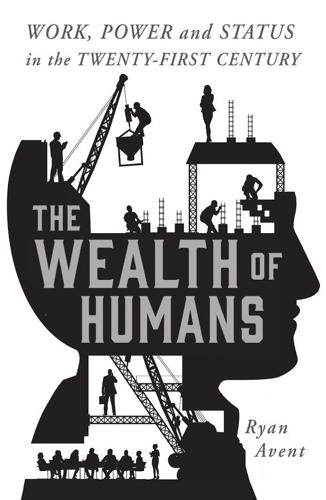
The Wealth of Humans: Work, Power, and Status in the Twenty-First Century
by
Ryan Avent
Published 20 Sep 2016
High-quality online courses could lead to massive layoffs of lecturers, but would make a good education easily affordable and accessible to people all over the world, people of all incomes and from all walks of life. Cheap wearable computers and computer monitoring and diagnosis could mean big trouble for lots of doctors and nurses, but should improve health while also reducing health-care costs. Driverless cars will displace professional drivers, but should save hundreds of thousands of lives thanks to reduced accidents. The digital revolution is an irresistible force because it offers humanity so many good things. It forces society to face the trade-off: new and improved goods, services and experiences at lower costs in exchange for social and economic disruption.
…
The value of the code in the machines becomes relatively more important as cars get smarter; Volvo, like many manufacturers, is working to get autonomous vehicles in regular operation on Swedish streets within the next few years. Already the cars are smart enough to do much of the brainwork involved in driving, from plotting routes to keeping a safe distance from the car ahead. Driverless cars are not yet generating discomfort among the men who drive cabs around central Gothenburg, many of whom are immigrants or the children of immigrants. The hollowing out of the industrial workforce is, however. Income inequality has risen in this famously egalitarian country,1 and recent Swedish governments have reformed their country’s generous welfare programmes to encourage more unemployed people to seek work.
…
They provide a context within which social capital can be especially productive. What does the productive application of social capital look like? It is the development of profitable know-how, more or less. Digital technologies create the potential to do all sorts of new things: to develop new forms of media, to build driverless cars and programme them to zip around city streets, to create machine intelligence capable of deciphering human speech or identifying the images in a picture. We have new capabilities aplenty. What is not obvious is how those capabilities can best be used. Part of what the productive application of social capital looks like is the community of start-ups and new businesses which experiment with new business models using new technologies to see which of them work.
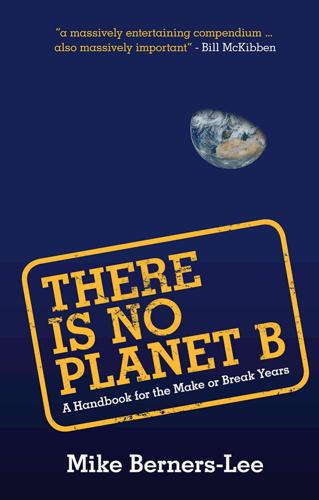
There Is No Planet B: A Handbook for the Make or Break Years
by
Mike Berners-Lee
Published 27 Feb 2019
Taking carbon, particles and nitrogen dioxide all into account, there is a clear hierarchy with diesels at the bottom, petrol in the mediocre middle, and electric cars at the top by a long way. Whatever type you chose, it’s good if you get a small one, drive it less and share it more. Could autonomous cars be a disaster? Or brilliant? It all depends on how much we use them. Driverless cars undoubtedly stand to be more efficient because they can slip stream each other and optimise every 110 4 TRAVEL AND TRANSPORT manoeuvre. The first difficulty, as we’ve seen, is that efficiency leads to yet more trouble unless the total global carbon use is capped. The issue is particularly extreme with autonomous cars because they also stand to be far less stressful and safer.
…
Before we slip into this way of living by default, we should ask ourselves very carefully the essential but slightly weird and unusual question of whether the quality of life will be made better or worse by this innovation. Just because we invented it, it doesn’t mean we are forced to adopt it, even though as we will see later, it may be hard to resist the pressure. Is the experience of being alive in a driverless car going to be better than the experience of being behind the wheel, or not in a car at all? My instinct is that once the novelty has worn off, it will be almost as inherently dull as frequent flying. The question of autonomous cars takes us back to two questions. Can we cap the carbon? And, more widely, can enough be enough?
…
32, 147–48, 227 big picture perspective 186, 191, 195–97 biodiversity 44, 53–54, 101–3, 102–3, 103–4, 214 big picture perspective 195–96 pressure on land 78–79, 91 Bioregional, One Planet Living 160–62, 162 boats/shipping 114–16, 235–36 Brazil 69–70, 70 278 Brexit 214 Buddhism 193, 208 bullshit 179, 214; see also fake news; truth Burning Question (Berners-Lee and Clark) 4, 92, 215 business as usual 8, 128, 204 businesses 158, 215 environmental strategies 163–64 fossil fuel companies 223 perspectives/vision 159 role in wealth distribution 138–39 science-based targets 164–66 systems approaches 159–62, 161–62 technological changes 166–68 useful/beneficial organisations 158–59 values 159, 174 see also food retailers call centres, negative effect of performance metrics 125–26 calorific needs 12, 242–43 carbohydrates, carbon footprint 23–25, 25 carbon budgets 51–52, 88, 146, 169–70, 201–2, 204–5 carbon capture and storage (CCS) 91–92, 141, 211, 215 carbon dioxide emissions, exponential growth 202–4, 203, 220; see also greenhouse gas emissions carbon footprints agriculture 22–25, 23, 29–30 carbohydrates 25 local food/food miles 30–32 population growth 149 protein 24 sea travel 114–16 vegetarianism/veganism 27 INDEX carbon pricing 145–47, 209–10 carbon scrubbing 211, 216 carbon taxes 142–43 CCS see carbon capture and storage celebrities 182 change, embracing see openmindedness chicken farms 25–26 Chilean seabass (Patagonian toothfish) 33–34 China 216 global distribution of fossil fuel reserves 89–90 sunlight/radiant energy 69–70, 70 choice//being in control 266 cities, urban planning and transport 104–6 citizen’s wages 136–39, 153–54 Clark, Duncan: Burning Question (with Berners-Lee) 4, 92, 215 climate change 3–4, 51, 55, 216 big picture perspective 195 biodiversity impacts 53–54 evidence against using fossil fuels 64–66 ocean acidification 54–55 plastics production/pollution 55–58, 56–57 rebound effects 52, 128, 165–66, 206–7, 206 science-based targets 164–66 scientific facts 51–53, 200–11, 203, 206 systems approaches 159–62, 161 values 169–70 coal 216; see also fossil fuels comfort breaks, performance metrics 125–27 Common Cause report (Crompton) 129 community service 174 Index commuting 217; see also travel and transport companies see businesses competence 266 complexity 189, 191, 221; see also simplistic thinking consumption/consumerism 217 ethical 147–48, 168 personal actions 174–75 risks of further growth 121 values 173 corporate responsibility 219; see also businesses critical realism 176 critical thinking skills 188–89, 191 Crompton, Tom (Common Cause report) 129 cruises 115–16 cultural norms big picture perspective 197 values 171–72 cultures of truth 177–79 cumulative carbon budgets 51, 201–2 cycling 4–5, 99–102, 116, 217 dairy industry 230–31; see also animal sources of food democracy 141, 218, 240–41; see also voting denial 198, 227 Denmark, wealth distribution 130–35 Desai, Pooran 161–62 desalination plants, energy use 94 determinism 95, 218 developed countries 218–19 energy use 93 food waste 13, 39–40, 241 diesel vehicles 107–9, 109 diet, sustainable 219; see also vegetarianism/veganism 279 digital information storage, and energy efficiency 84–85 direct air capture, carbon dioxide 211, 216 distance, units of 243 double-sided photocopying metaphor 219 driverless cars 109–10 e-transport e-bikes 101–2, 116 e-boats 115 e-cars 101–2, 106, 220 e-planes 111 investment 141 economic growth 119, 219 big picture perspective 196–97 carbon pricing 145–47 carbon taxes 142–43 consumer power through spending practices 147–48 GDP as inadequate metric 123–24, 126–27 investment 140–42 market forces 127–30 need for new metric of healthy growth 124–27 risks and benefits of growth 120–23, 121 trickledown of wealth 130–31, 130 wealth distribution 130–35, 131–40, 132, 134 education 173–74, 219 efficiency 219–20 digital information storage 84–85 energy use 82–85 investment 141 limitations of electricity 73–86, 85–87 meat eating/animal feed 212–13 rebound effects 84, 207 280 electric vehicles see e-transport electricity, limitations of use 73–86, 85–87; see also renewable energy sources empathy 172, 186–87, 191 employment see work/employment enablement, businesses 163–64 energy in a gas analogy of wealth distribution 136–39 energy use 59, 87, 95–96 current usage 59–60 efficiency 82–85 fracking 79–81, 81 growth rates over time see below inequality 60, 90–91, 131 interstellar travel 117–18 limitations of electricity 73–86, 85–87 limits to growth 67–69, 68, 94–95, 208 nuclear fission 75–77 nuclear fusion 77 personal actions and effects 97 risks of further growth 120–21 sources 63–64 supplied by food 12 UK energy by end use 62, 62 units of 242–43 values 169–70 see also fossil fuels; renewable energy sources energy use growth 1–2, 60–62, 61, 220 and energy efficiency 84 future estimates 93–94 limits to growth 67–69, 68, 94–95 and renewables 81–82 enhanced rock weathering 92 enoughness 221; see also limits to growth environmental strategies, businesses 163–64 science-based targets 164–66 INDEX ethical consumerism 147–48, 168 ethics see values evolutionary rebalancing 6, 221 expert opinion 221 exponential growth 120, 121, 149, 202–4, 220–21 extrinsic motivation and values 143–44, 170–73 facts 222 climate change 51–53, 200–11, 203, 206 meaning of 175–76 media roles in promoting 179–80 see also misinformation; truth fake news 170, 175, 222; see also misinformation farming see food and agriculture fast food 238 feedback mechanisms 272; see also rebound effects fish farming 33 fishing industry 32–36, 222–23 flat lining blip, carbon dioxide emissions 203–4, 220 flexibility see open-mindedness flying see air travel food and agriculture 11, 50, 222–23 animal farming 16–21, 29 biofuels 44 carbon footprints 22–25, 23–25, 27 chicken farming 25–26 employment in agriculture 44–45, 222 feeding growing populations 46–47 fish 32–36 global surplus in comparison to needs 12, 13 human calorific needs 12 investment in sustainability 48–50, 141 Index malnutrition and inequalities of distribution 15–16 overeating/obesity 16 personal actions 30, 34–35, 40, 43, 50 research needs 49 rice farming 29–30 soya bean farming 21, 22 supply chains 48 technology in agriculture 45–46 vegetarianism/veganism 26–29 see also waste food food imports, and population growth 150 food markets 130–31 food miles 30–32, 230 food retailers fish 35–36 food wastage 40–42 rice 30 vegetarianism/veganism 28 fossil fuel companies 223 fossil fuels 63–64, 216, 223 carbon pricing 145–47, 209–10 carbon taxes 142–43 evidence against using 64–66 global deals 87–91, 161, 205–6, 208–9 global distribution of reserves 89, 89–90 limitations of using electricity instead 73–86, 85–87 need to leave in the ground 87–91, 161, 205–6, 208–9, 223 sea travel 115 using renewables instead of or as well as 81–82 fracking 79–81, 81, 224 free markets 127–30, 172, 228 free will 95, 167 frog in a pan of water analogy 236, 241 fun 224 281 fundamentalism 176, 192 future scenarios aims and visions 8–9 climate change lag times 204–5 energy use 93–94 planning ahead 204–5 thinking/caring about 187, 191, 229 travel and transport 100–1, 109–10 gambling industry 139–40, 152, 265 gas analogy of wealth distribution 136–39 gas (natural gas) 224; see also fracking; methane GDP big picture perspective 196–97 as inappropriate metric of healthy growth 123–24, 126–27 risks of further growth 121–22 genetic modification 45–46 genuineness 172 geo engineering solutions 224–25 Germany, tax system 145 Gini coefficient of income inequality 144 global cultural norms 171–72, 197 global deals 163 fossil fuels 87–91, 208–10 inequity 210 global distribution, fossil fuels 89–91, 89 global distribution, solar energy 69–71, 70, 89 global distribution, wind energy 74, 74 global food surplus 12, 13 global governance 127–30, 141, 225 global solutions, big picture perspective 196 global systems 5–6, 186, 225 global temperature increases 200–1 282 global thinking skills 186 global travel, by mode of transport 100 global wealth distribution 130–35, 132, 132, 134, 144, 145 governmental roles big picture perspective 196 climate change policies 51–53, 200–11 energy use policies 59, 97 fishing industry 36 promoting culture of truth 178–80 sustainable farming 29, 45 technological changes 168 wealth distribution 138 see also global governance greed 225–26; see also individualism greenhouse gas emissions 209 exponential growth curves 202–4, 203, 220 food and agriculture 23 market forces 128 measurement 127 mitigation of food waste 42, 43, 43 risks of further growth 120 scientific facts 51–53 units 243 see also carbon dioxide; carbon footprints; methane; nitrogen dioxide greenwash 215, 226 growth 226; see also economic growth; energy use growth; exponential growth hair shirts 212, 224, 226–27 Handy, Charles 236 Happy Planet Index 126 Hardy, Lew 143 Hawking , Stephen 2, 166–67 Hong Kong, population growth 149–50 INDEX How Bad Are Bananas?
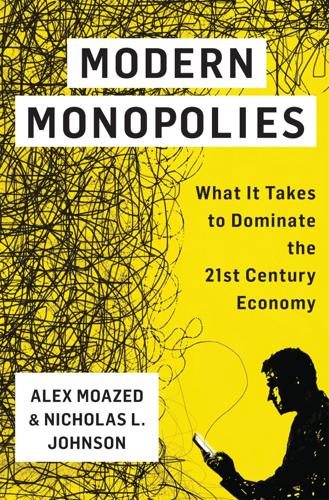
Modern Monopolies: What It Takes to Dominate the 21st Century Economy
by
Alex Moazed
and
Nicholas L. Johnson
Published 30 May 2016
Insurance companies are starting to offer better rates based around users’ ability to drive safely or their ability to monitor users’ homes. Farther down the line, driverless cars will be a big part of the Internet of Things. And they will likely be connected by one or two dominant development platforms. Apple and Google have both made big moves in this space over the last year, so they are currently leading contenders. Uber is another. Travis Kalanick, the company’s founder and CEO, has already said on the record that Uber intends to build on driverless car technology. To that end, in February 2015, Uber effectively bought out the entire robotics department at Carnegie Mellon University.
…
To that end, in February 2015, Uber effectively bought out the entire robotics department at Carnegie Mellon University. (Yes, really.) The company likely will start by introducing driverless cars into its fleet to help prove out the market and construct a regulatory regime around the new technology. However, once Uber accomplishes this, it’s unlikely that the company will simply own and operate its own armada of vehicles. It’s not clear why a logistics and transportation platform would want to radically alter its business model in favor of owning a fleet of rapidly depreciating physical assets that also come with the downside of serious liability concerns. The potential in the industrial sector of the economy to improve efficiency is enormous.
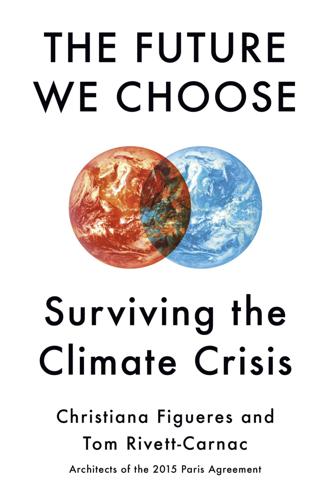
The Future We Choose: Surviving the Climate Crisis
by
Christiana Figueres
and
Tom Rivett-Carnac
Published 25 Feb 2020
Abby Norman, “Aliens, Autonomous Cars, and AI: This Is the World of 2118,” Futurism.com, January 11, 2018, https://futurism.com/2118-century-predictions; Matthew Claudel and Carlo Ratti, “Full Speed Ahead: How the Driverless Car Could Transform Cities,” McKinsey & Company, August 2015, https://www.mckinsey.com/business-functions/sustainability/our-insights/full-speed-ahead-how-the-driverless-car-could-transform-cities. 18. Brad Plumer, “Cars Take Up Way Too Much Space in Cities. New Technology Could Change That,” Vox, 2016, https://www.vox.com/a/new-economy-future/cars-cities-technologies; Vanessa Bates Ramirez, “The Future of Cars Is Electric, Autonomous, and Shared—Here’s How We’ll Get There,” Singularity Hub, August 23, 2018, https://singularityhub.com/2018/08/23/the-future-of-cars-is-electric-autonomous-and-shared-heres-how-well-get-there/. 19.
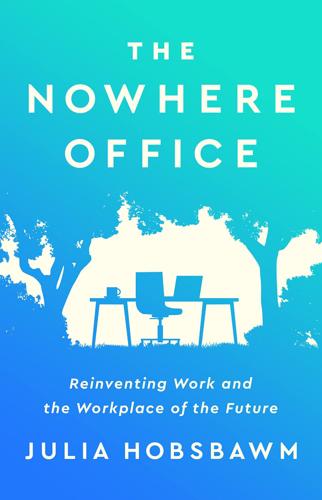
The Nowhere Office: Reinventing Work and the Workplace of the Future
by
Julia Hobsbawm
Published 11 Apr 2022
Preface Office centricity is over. Tobi Lütke, CEO Shopify, on Twitter1 Imagine you are holding a snow globe in your hand and the object inside is not a place you have been to on holiday or a festive bauble but a representation of where you work. What does it show? Your home? A laptop? A driverless car? For the professional class (which in advanced economies makes up over 40 per cent of the workforce) there is no single obvious image to encapsulate working life any more.2 Thanks to the internet and automation it could be a smartphone or it could be a makeshift desk under a tree. It is unlikely to be – at least full time – an actual office.
…
We never see the future as clearly as we see the past. It is as if the more seismic the shift the less we anticipate it until it has arrived. For instance, blockchain technology is upending finance as we know it and decentralising centuries of controlled banking – but people said it would never happen. I was one of the naysayers against the driverless car but no one would bet against it now, nor electric vehicles replacing petrol-driven ones. The Nowhere Office is not a blip or a trend which is going to be reversed. I have written this book to help those of us in the professions who are in the middle of the biggest upheaval of our working lives, whether we are Learners, Leavers or Leaders, to help shape the future rather than wait passively for it to happen to us.

Bold: How to Go Big, Create Wealth and Impact the World
by
Peter H. Diamandis
and
Steven Kotler
Published 3 Feb 2015
v=Y0WH-CoFwn4. 38 Matt Ridley, The Rational Optimist: How Prosperity Evolves (New York: HarperCollins, 2010). 39 Larry Page, “Google I/O 2013: Keynote,” Google I/O 2013, Google Developers, May 15, 2013, https://www.youtube.com/watch?v=9pmPa_KxsAM. 40 Joann Muller, “No Hands, No Feet: My Unnerving Ride in Google’s Driverless Car,” Forbes, March 21, 2013, http://www.forbes.com/sites/joannmuller/2013/03/21/no-hands-no-feet-my-unnerving-ride-in-googles-driverless-car/. 41 Robert Hof, “10 Breakthrough Technologies 2013: Deep Learning,” MIT Technology Review, April 23, 2013, http://www.technologyreview.com/featuredstory/513696/deep-learning/. 42 Steven Levy, “Google’s Larry Page on Why Moon Shots Matter,” Wired, January 17, 2013, http://www.wired.com/2013/01/ff-qa-larry-page/all/. 43 Larry Page, “Beyond Today—Larry Page—Zeitgeist 2012.” 44 Larry Page, “Google+: Calico Announcement,” Google+, September 2013, https://plus.google.com/+LarryPage/posts/Lh8SKC6sED1. 45 Harry McCracken and Lev Grossman, “Google vs.
…
To look at this from a more expansive angle, consider that we now live in a world where Google’s autonomous car can cruise our streets safely because of a rooftop sensor called LIDAR—a laser-based sensing device that uses sixty-four eye-safe lasers to scan 360 degrees while concurrently generating 750 megabytes of image data per second to help with navigation.5 Pretty soon, though, we’ll live in a world with, say, two million autonomous cars on our roads (not much of a stretch, as that’s less than one percent of cars currently registered in the United States),6 seeing and recording nearly everything they encounter, giving us near-perfect knowledge of the environment they observe. What’s more, ubiquitous imaging doesn’t stop there. 360-degree LIDAR imaging in Google’s driverless car Source: http://people.bath.ac.uk/as2152/cars/lidar.jpg In addition to these autonomous cars scanning the roadside, by 2020, an estimated five privately owned low-Earth-orbiting satellite constellations will be imaging every square meter of the Earth’s surface in resolutions ranging from 0.5 to 2 meters.7 Simultaneously, we’re also about to see an explosion of AI-operated microdrones buzzing around our cities and taking images down in the centimeter range.

Overcomplicated: Technology at the Limits of Comprehension
by
Samuel Arbesman
Published 18 Jul 2016
But at the same time, the systems we are building—the technologies that run our world—are not only intricate and complicated, but also stitch together field after field. We have systems in the world of finance that require an understanding of physics; there are economists involved in the development of computer systems. The design of driverless cars is a good example, requiring collaboration among those with expertise in software, lasers, automotive engineering, digital mapping, and more. In other words, even as specialization aids us in making advances, we are ever more dependent on systems that draw from many different areas, and require an understanding of each of these.
…
more than 36 million books: “Fascinating Facts,” Library of Congress, accessed March 2, 2015, http://www.loc.gov/about/fascinating-facts/. The biologist E. O. Wilson described the change: Edward O. Wilson, Consilience: The Unity of Knowledge (New York: Alfred A. Knopf, 1998; repr. Vintage Books, 1999), 42–43. driverless cars is a good example: Jordan Bell-Masterson, “Innovation Series: The Rising Costs of Invention,” Growthology, March 24, 2015, http://www.kauffman.org/blogs/growthology/2015/03/innovation-series-increasing-costs-of-invention. attempt to visualize these patterns of teamwork: Michael Ogawa and Kwan-Liu Ma, “Software Evolution Storylines,” SOFTVIS ’10: Proceedings of the 5th International Symposium on Software Visualization (New York: ACM Digital Library, 2010), 35–42, available online: http://vis.cs.ucdavis.edu/papers/softvis_storylines.pdf.

The Zero Marginal Cost Society: The Internet of Things, the Collaborative Commons, and the Eclipse of Capitalism
by
Jeremy Rifkin
Published 31 Mar 2014
“GM Enters Carsharing Business; Teams Up with RelayRides,” GM News, October 5, 2011, http://media.gm.com/media/us/en/gm/news.detail.html/content/Pages/news/us/en/2011 /Oct/1005_relay.html (accessed May 29, 2013). 17. Lawrence Burns, “A Vision of Our Transport Future,” Nature 497 (May 9, 2013): 181–82. 18. Ibid. 19. Joann Muller, “With Driverless Cars, Once Again It Is California Leading the Way,” Forbes, September 26, 2012, http://www.forbes.com/sites/joannmuller/2012/09/26/with-driverless-cars -once-again-it-is-california-leading-the-way/ (accessed June 2, 2013). 20. Chris Urmson, “The Self-Driving Car Logs More Miles on New Wheels,” Google Blog, August 7, 2012, http://googleblog.blogspot.com/2012/08/the-self-driving-car-logs-more-miles-on.html (accessed June 2, 2013). 21.
…
Chris Urmson, “The Self-Driving Car Logs More Miles on New Wheels,” Google Blog, August 7, 2012, http://googleblog.blogspot.com/2012/08/the-self-driving-car-logs-more-miles-on.html (accessed June 2, 2013). 21. Mary Slosson, “Google Gets First Self-Driven Car License in Nevada,” Reuters, May 8, 2012, http://www.reuters.com/article/2012/05/08/uk-usa-nevada-google-idUSLNE84701320120508 (accessed June 3, 2013). 22. Alex Hudson, “Will Driverless Cars Mean Computer Crashes?,” BBC News, October 1, 2012, http://news.bbc.co.uk/2/hi/programmes/9755210.stm (accessed June 2, 2013). 23. John Markoff, “Google Cars Drive Themselves, in Traffic,” New York Times, October 9, 2010, http://www.nytimes.com/2010/10/10/science/10google.html?pagewanted=all&_r=0 (accessed June 2, 2013). 24. “2012 U.S.
…
Power and Associates, April 26, 2012, http://autos.jdpower.com/content/press-release/gGOwCnW/2012-u-s-automotive-emerg ing-technologies-study.htm (accessed June 3, 2013). 25. Jack Ewing, “A Benz with a Virtual Chauffeur,” New York Times, May 16, 2013, http://www.ny times.com/2013/05/19/automobiles/a-benz-with-a-virtual-chauffeur.html?pagewanted=all& _r=0 (accessed May 28, 2013). 26. Emi Kolawole, “A Win For Google’s Driverless Car: Calif. Governor Signs a Bill Regulating Autonomous Vehicles,” Washington Post, September 25, 2012, http://www.washingtonpost.com (accessed June 2, 2013). 27. Jeremy Rifkin, The Age of Access: The New Culture of Hypercapitalism Where All of Life Is a Paid-For Experience (New York: Tracher/Penguin, 2000), 6, 14. 28.

Homo Deus: A Brief History of Tomorrow
by
Yuval Noah Harari
Published 1 Mar 2015
Christopher Steiner, Automate This: How Algorithms Came to Rule Our World (New York: Penguin, 2012), 215; Tom Vanderbilt, ‘Let the Robot Drive: The Autonomous Car of the Future is Here’, Wired, 20 January 2012, accessed 21 December 2014, http://www.wired.com/2012/01/ff_autonomouscars/all/; Chris Urmson, ‘The Self-Driving Car Logs More Miles on New Wheels’, Google Official Blog, 7 August 2012, accessed 23 December 2014, http://googleblog.blogspot.hu/2012/08/the-self-driving-car-logs-more-miles-on.html; Matt Richtel and Conor Dougherty, ‘Google’s Driverless Cars Run into Problem: Cars with Drivers’, New York Times, 1 September 2015, accessed 2 September 2015, http://www.nytimes.com/2015/09/02/technology/personaltech/google-says-its-not-the-driverless-cars-fault-its-other-drivers.html?_r=1. 7. Dehaene, Consciousness and the Brain. 8. Ibid., ch. 7. 9. ‘The Cambridge Declaration on Consciousness’, 7 July 2012, accessed 21 December 2014, https://web.archive.org/web/20131109230457/http://fcmconference.org/img/CambridgeDeclarationOnConsciousness.pdf. 10.
…
Grayzel, Women and the First World War (Harlow: Longman, 2002), 101–6; Christine Bolt, The Women’s Movements in the United States and Britain from the 1790s to the 1920s (Amherst: University of Massachusetts Press, 1993), 236–76; Birgitta Bader-Zaar, ‘Women’s Suffrage and War: World War I and Political Reform in a Comparative Perspective’, in Suffrage, Gender and Citizenship: International Perspectives on Parliamentary Reforms, ed. Irma Sulkunen, Seija-Leena Nevala-Nurmi and Pirjo Markkola (Newcastle upon Tyne: Cambridge Scholars Publishing, 2009), 193–218. 4. Matt Richtel and Conor Dougherty, ‘Google’s Driverless Cars Run into Problem: Cars with Drivers’, New York Times, 1 September 2015, accessed 2 September 2015, http://www.nytimes.com/2015/09/02/technology/personaltech/google-says-its-not-the-driverless-cars-fault-its-other-drivers.html?_r=1; Shawn DuBravac, Digital Destiny: How the New Age of Data Will Transform the Way We Work, Live and Communicate (Washington DC: Regnery Publishing, 2015), 127–56. 5.

Future Crimes: Everything Is Connected, Everyone Is Vulnerable and What We Can Do About It
by
Marc Goodman
Published 24 Feb 2015
,” Car and Driver, Aug. 2011; Andy Greenberg, “Hackers Reveal Nasty New Car Attacks—with Me Behind the Wheel,” Forbes, July 24, 2013; Dan Goodin, “Tampering with a Car’s Brakes and Speed by Hacking Its Computers: A New How-To,” Ars Technica, July 29, 2013. 32 Renault Nissan’s CEO: Paul A. Eisenstein, “Spying, Glitches Spark Concern for Driverless Cars,” CNBC.com, Feb. 8, 2014. 33 The biggest proponent: Sebastian Anthony, “Google’s Self-Driving Car Passes 700,000 Accident-Free Miles, Can Now Avoid Cyclists, Stop at Railroad Crossings,” ExtremeTech, April 29, 2014; John Markoff, “Google’s Next Phase in Driverless Cars: No Steering Wheel or Brake Pedals,” New York Times, May 27, 2014. 34 Law enforcement officials clearly: Lance Whitney, “FBI: Driverless Cars Could Become ‘Lethal Weapons,’ ” CNET, July 16, 2014. 35 Just as vehicles were rated: Ms.
…
In the same way both Crime, Inc. and crazed exes are targeting computers and mobile phones, it’s only logical that they will go after cars in the future too, bringing scenes like those in Stephen King’s 1983 horror thriller about a possessed car named Christine many steps closer to reality. Law enforcement officials clearly see the threat, and in July 2014 the FBI warned in an internal report that driverless cars could be used as “lethal weapons, with terrorists potentially packing explosives into a self-driving car aimed at a specific destination.” Autonomous vehicles could also potentially be turned off en masse, bringing traffic to a complete standstill in a city or country. To be certain, some of these vehicular attacks require a high degree of computer savvy to pull off, but as we have seen with other exploits, soon there will be point-and-click crimeware options for car hacking as well.
…
Drone Fleet,” Wired, Oct. 7, 2011. 52 The software, dubbed SkyJack: Dan Goodin, “Flying Hacker Contraption Hunts Other Drones, Turns Them into Zombies,” Ars Technica, Dec. 3, 2013. 53 Hackers have already created: Andy Greenberg, “PIN-Punching Robot Can Crack Your Phone’s Security Code in Less Than 24 Hours,” Forbes, July 22, 2013. 54 Robots can also be a criminal’s best friend: “Drug Dealer Arrested in Spite of Home Robotic Protection: Police,” China Post, Aug. 10, 2014. 55 As we saw in the opening: Charlemagne, “Afghanistan—the Biggest Bomb Yet,” Intel MSL, March 15, 2013, http://intelmsl.com/. 56 Moments later numerous rounds: Noah Shachtman, “Iraq Militants Brag: We’ve Got Robotic Weapons, Too,” Wired, Oct. 4, 2011. 57 Officials predicted that robotic conveyances: Harris, “FBI Warns Driverless Cars Could Be Used as ‘Lethal Weapons,’ ” Guardian, July 16, 2014. 58 Sure, others had beaten Bezos: Jathan Sadowski, “Delivered by Drones: Are Tacocopters and Burrito Bombers the Next Pony Express?,” Slate, Aug. 6, 2013; Laura Stampler, “This Club Is Offering Poolside Drone Bottle Service,” Time, June 19, 2014. 59 Dubbed Project Wing: “Google Is Testing Delivery Drone System,” Wall Street Journal, Aug. 29, 2014. 60 Real estate agents: Sarah Zhang, “Drones That Aren’t Out to Kill You,” Mother Jones, Dec. 6, 2012. 61 The Royal Canadian Mounted Police: “Canadian Mounties Claim First Person’s Life Saved by a Police Drone,” Verge, May 10, 2013. 62 The fake cell tower: Andy Greenberg, “Flying Drone Can Crack Wi-Fi Networks, Snoop on Cell Phones,” Forbes, July 28, 2011. 63 The so-called Occu-copter: Spencer Ackerman, “Occupy the Skies!
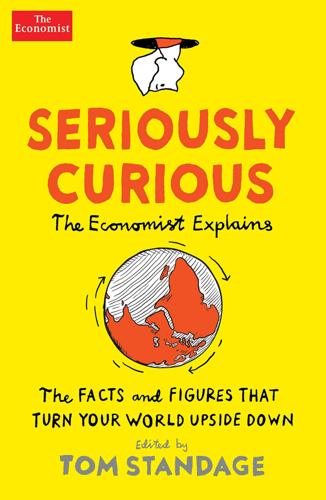
Seriously Curious: The Facts and Figures That Turn Our World Upside Down
by
Tom Standage
Published 27 Nov 2018
By one estimate, the M-Pesa mobile-money system alone lifted about 2% of Kenyan households out of poverty between 2008 and 2014. Technology cannot solve all of Africa’s problems, but it can help with some of them. Why self-driving cars will mostly be shared, not owned When will you be able to buy a driverless car that will work anywhere? This commonly asked question contains three assumptions: that autonomous vehicles (AVs) will resemble cars; that people will buy them; and that they will be capable of working on all roads in all conditions. All three of those assumptions may be wrong. Although today’s experimental vehicles are modified versions of ordinary cars, with steering wheels that eerily turn by themselves, future AVs will have no steering wheel or pedals and will come in all sorts of shapes and sizes; pods capable of carrying six or eight people may prove to be the most efficient design.
…
For more explainers and charts from The Economist, visit economist.com Index A Africa child marriage 84 democracy 40 gay and lesbian rights 73, 74 Guinea 32 mobile phones 175–6 see also individual countries agriculture 121–2 Aguiar, Mark 169 air pollution 143–4 air travel and drones 187–8 flight delays 38–9 Akitu (festival) 233 alcohol beer consumption 105–6 consumption in Britain 48, 101–2 craft breweries 97–8 drink-driving 179–80 wine glasses 101–2 Alexa (voice assistant) 225 Algeria food subsidies 31 gay and lesbian rights 73 All I Want for Christmas Is You (Carey) 243 alphabet 217–18 Alternative for Germany (AfD) 223, 224 Alzheimer’s disease 140 Amazon (company) 225 America see United States and 227–8 Angola 73, 74 animals blood transfusions 139–40 dog meat 91–2 gene drives 153–4 size and velocity 163–4 and water pollution 149–50 wolves 161–2 Arctic 147–8 Argentina gay and lesbian rights 73 lemons 95–6 lithium 17–18 Ariel, Barak 191 Arizona 85 arms trade 19–20 Asia belt and road initiative 117–18 high-net-worth individuals 53 wheat consumption 109–10 see also individual countries Assange, Julian 81–3 asteroids 185–6 augmented reality (AR) 181–2 August 239–40 Australia avocados 89 forests 145 inheritance tax 119 lithium 17, 18 shark attacks 201–2 autonomous vehicles (AVs) 177–8 Autor, David 79 avocados 89–90 B Babylonians 233 Baltimore 99 Bangladesh 156 bank notes 133–4 Bateman, Tim 48 beer consumption 105–6 craft breweries 97–8 Beijing air pollution 143–4 dogs 92 belt and road initiative 117–18 betting 209–10 Bier, Ethan 153 Bils, Mark 169 birds and aircraft 187 guinea fowl 32–3 birth rates Europe 81–3 United States 79–80 black money 133–4 Black Power 34, 35 Blade Runner 208 blood transfusions 139–40 board games 199–200 body cameras 191–2 Boko Haram 5, 15–16 Bolivia 17–18 Bollettieri, Nick 197 bookmakers 209–10 Borra, Cristina 75 Bosnia 221–2 brain computers 167–8 Brazil beer consumption 105, 106 Christmas music 243, 244 end-of-life care 141–2 gay and lesbian rights 73 murder rate 45, 46 shark attacks 202 breweries 97–8 Brexit, and car colours 49–50 brides bride price 5 diamonds 13–14 Britain alcohol consumption 101–2 car colours 49–50 Christmas music 244 cigarette sales 23–4 craft breweries 98 crime 47–8 Easter 238 gay population 70–72 housing material 8 inheritance tax 119 Irish immigration 235 life expectancy 125 manufacturing jobs 131 national identity 223–4 new-year resolutions 234 police body cameras 191 sexual harassment 67, 68, 69 sperm donation 61 see also Scotland Brookings Institution 21 Browning, Martin 75 bubonic plague 157–8 Bush, George W. 119 C cables, undersea 193–4 California and Argentine lemons 95, 96 avocados 90 cameras 191–2 Canada diamonds 13 drones 188 lithium 17 national identity 223–4 capitalism, and birth rates 81–2 Carey, Mariah 243 Carnegie Endowment for International Peace 21 cars colours 49–50 self-driving 177–8 Caruana, Fabiano 206 Charles, Kerwin 169 cheetahs 163, 164 chess 205–6 Chetty, Raj 113 Chicago 100 children birth rates 79–80, 81–3 child marriage 84–5 in China 56–7 crime 47–8 and gender pay gap 115–16, 135–6 obesity 93–4 Chile gay and lesbian rights 73 lithium 17–18 China air pollution 143–5 arms sales 19–20 avocados 89 beer consumption 105 belt and road initiative 117–18 childhood obesity 93 construction 7 dog meat 91–2 dragon children 56–7 flight delays 38–9 foreign waste 159–60 lithium 17 rice consumption 109–10 Choi, Roy 99 Christian, Cornelius 26 Christianity Easter 237–8 new year 233–4 Christmas 246–7 music 243–5 cigarettes affordability 151–2 black market 23–4 cities, murder rates 44–6 Citizen Kane 207 citrus wars 95–6 civil wars 5 Clarke, Arthur C. 183 Coase, Ronald 127, 128 cocaine 44 cochlear implants 167 Cohen, Jake 203 Colen, Liesbeth 106 colleges, US 113–14 Colombia 45 colours, cars 49–50 commodities 123–4 companies 127–8 computers augmented reality 181–2 brain computers 167–8 emojis 215–16 and languages 225–6 spam e-mail 189–90 Connecticut 85 Connors, Jimmy 197 contracts 127–8 Costa Rica 89 couples career and family perception gap 77–8 housework 75–6 see also marriage cows 149–50 craft breweries 97–8 crime and avocados 89–90 and dog meat 91–2 murder rates 44–6 young Britons 47–8 CRISPR-Cas9 153 Croatia 222 Croato-Serbian 221–2 D Daily-Diamond, Christopher 9–10 Davis, Mark 216 De Beers 13–14 death 141–2 death taxes 119–20 democracy 40–41 Deng Xiaoping 117 Denmark career and family perception gap 78 gender pay gap 135–6 sex reassignment 65 Denver 99 Devon 72 diamonds 13–14, 124 digitally remastering 207–8 Discovery Channel 163–4 diseases 157–8 dog meat 91–2 Dorn, David 79 Dr Strangelove 207 dragon children 56–7 drink see alcohol drink-driving 179–80 driverless cars 177–8 drones and aircraft 187–8 and sharks 201 drugs cocaine trafficking 44 young Britons 48 D’Souza, Kiran 187 E e-mail 189–90 earnings, gender pay gap 115–16, 135–6 Easter 237–8 economy and birth rates 79–80, 81–2 and car colours 49–50 and witch-hunting 25–6 education and American rich 113–14 dragon children 56–7 Egal, Muhammad Haji Ibrahim 40–41 Egypt gay and lesbian rights 73 marriage 5 new-year resolutions 233 El Paso 100 El Salvador 44, 45 emojis 215–16 employment gender pay gap 115–16, 135–6 and gender perception gap 77–8 job tenure 129–30 in manufacturing 131–2 video games and unemployment 169–70 English language letter names 217–18 Papua New Guinea 219 environment air pollution 143–4 Arctic sea ice 147–8 and food packaging 103–4 waste 159–60 water pollution 149–50 Equatorial Guinea 32 Eritrea 40 Ethiopia 40 Europe craft breweries 97–8 summer holidays 239–40 see also individual countries Everson, Michael 216 exorcism 36–7 F Facebook augmented reality 182 undersea cables 193 FANUC 171, 172 Federer, Roger 197 feminism, and birth rates 81–2 fertility rates see birth rates festivals Christmas 246–7 Christmas music 243–5 new-year 233–4 Feuillet, Catherine 108 films 207–8 firms 127–8 5G 173–4 flight delays 38–9 Florida and Argentine lemons 95 child marriage 85 Foley, William 220 food avocados and crime 89–90 dog meat 91–2 lemons 95–6 wheat consumption 109–10 wheat genome 107–8 food packaging 103–4 food trucks 99–100 football clubs 211–12 football transfers 203–4 forests 145–6, 162 Fountains of Paradise, The (Clarke) 183 fracking 79–80 France career and family perception gap 78 Christmas music 244 exorcism 36–7 gender-inclusive language 229–30 job tenure 130 sex reassignment 66 sexual harassment 68–9 witch-hunting 26, 27 wolves 161–2 G gambling 209–10 games, and unemployment 169–70 Gandhi, Mahatma 155 gang members 34–5 Gantz, Valentino 153 gas 124 gay population 70–72 gay rights, attitudes to 73–4 gender sex reassignment 65–6 see also men; women gender equality and birth rates 81–2 in language 229–30 gender pay gap 115–16, 135–6 gene drives 153–4 Genghis Khan 42 genome, wheat 107–8 ger districts 42–3 Germany beer consumption 105 job tenure 130 national identity 223–4 sexual harassment 68, 69 vocational training 132 witch-hunting 26, 27 Ghana 73 gig economy 128, 130 glasses, wine glasses 101–2 Goddard, Ceri 72 Google 193 Graduate, The 207 Greece forests 145 national identity 223–4 sex reassignment 65 smoking ban 152 Gregg, Christine 9–10 grunting 197–8 Guatemala 45 Guinea 32 guinea fowl 32–3 guinea pig 32 Guinea-Bissau 32 Guo Peng 91–2 Guyana 32 H Haiti 5 Hale, Sarah Josepha 242 Hanson, Gordon 79 Hawaii ’Oumuamua 185 porn consumption 63–4 health child obesity 93–4 life expectancy 125–6 plague 157–8 and sanitation 155 high-net-worth individuals (HNWIs) 53 Hiri Motu 219 holidays Easter 237–8 St Patrick’s Day 235–6 summer holidays 239–40 Thanksgiving 241–2 HoloLens 181–2 homicide 44–6 homosexuality attitudes to 73–4 UK 70–72 Honduras 44, 45 Hong Kong 56 housework 75–6, 77–8 Hudson, Valerie 5 Hungary 223–4 Hurst, Erik 169 I ice 147–8 Ikolo, Prince Anthony 199 India bank notes 133–4 inheritance tax 119 languages 219 rice consumption 109 sand mafia 7 sanitation problems 155–6 Indonesia polygamy and civil war 5 rice consumption 109–10 inheritance taxes 119–20 interest rates 51–2 interpunct 229–30 Ireland aitch 218 forests 145 St Patrick’s Day 235–6 same-sex marriage 73 sex reassignment 65 Italy birth rate 82 end of life care 141–2 forests 145 job tenure 130 life expectancy 126 J Jacob, Nitya 156 Jamaica 45 Japan 141–2 Jighere, Wellington 199 job tenure 129–30 jobs see employment Johnson, Bryan 168 junk mail 189 K Kazakhstan 6 Kearney, Melissa 79–80 Kennedy, John F. 12 Kenya democracy 40 mobile-money systems 176 Kiribati 7 Kleven, Henrik 135–6 knots 9–10 Kohler, Timothy 121 Kyrgyzstan 6 L laces 9–10 Lagos 199 Landais, Camille 135–6 languages and computers 225–6 gender-inclusive 229–30 letter names 217–18 and national identity 223–4 Papua New Guinea 219–20 Serbo-Croatian 221–2 Unicode 215 World Bank writing style 227–8 Latimer, Hugh 246 Leeson, Peter 26 leisure board games in Nigeria 199–200 chess 205–6 gambling 209–10 video games and unemployment 169–70 see also festivals; holidays lemons 95–6 letter names 217–18 Libya 31 life expectancy 125–6 Lincoln, Abraham 242 lithium 17–18 London 71, 72 longevity 125–6 Lozère 161–2 Lucas, George 208 M McEnroe, John 197 McGregor, Andrew 204 machine learning 225–6 Macri, Mauricio 95, 96 Macron, Emmanuel 143 Madagascar 158 Madison, James 242 MagicLeap 182 Maine 216 Malaysia 56 Maldives 7 Mali 31 Malta 65 Manchester United 211–12 manufacturing jobs 131–2 robots 171–2 summer holidays 239 Maori 34–5 marriage child marriage 84–5 polygamy 5–6 same-sex relationships 73–4 see also couples Marteau, Theresa 101–2 Marx, Karl 123 Maryland 85 Massachusetts child marriage 85 Christmas 246 Matfess, Hilary 5, 15 meat dog meat 91–2 packaging 103–4 mega-rich 53 men career and family 77–8 housework 75–6 job tenure 129–30 life expectancy 125 polygamy 5–6 sexual harassment by 67–9 video games and unemployment 169 Mexico avocados 89, 90 gay and lesbian rights 73 murder rate 44, 45 microbreweries 97–8 Microsoft HoloLens 181–2 undersea cables 193 migration, and birth rates 81–3 mining diamonds 13–14 sand 7–8 mobile phones Africa 175–6 5G 173–4 Mocan, Naci 56–7 Mongolia 42–3 Mongrel Mob 34 Monopoly (board game) 199, 200 Monty Python and the Holy Grail 25 Moore, Clement Clarke 247 Moretti, Franco 228 Morocco 7 Moscato, Philippe 36 movies 207–8 Mozambique 73 murder rates 44–6 music, Christmas 243–5 Musk, Elon 168 Myanmar 118 N Nadal, Rafael 197 national identity 223–4 natural gas 124 Netherlands gender 66 national identity 223–4 neurostimulators 167 New Jersey 85 New Mexico 157–8 New York (state), child marriage 85 New York City drink-driving 179–80 food trucks 99–100 New Zealand avocados 89 gang members 34–5 gene drives 154 water pollution 149–50 new-year resolutions 233–4 Neymar 203, 204 Nigeria board games 199–200 Boko Haram 5, 15–16 population 54–5 Nissenbaum, Stephen 247 Northern Ireland 218 Norway Christmas music 243 inheritance tax 119 life expectancy 125, 126 sex reassignment 65 Nucci, Alessandra 36 O obesity 93–4 oceans see seas Odimegwu, Festus 54 O’Reilly, Oliver 9–10 Ortiz de Retez, Yñigo 32 Oster, Emily 25–6 ostriches 163, 164 ’Oumuamua 185–6 P packaging 103–4 Pakistan 5 Palombi, Francis 161 Papua New Guinea languages 219–20 name 32 Paris Saint-Germain (PSG) 203 Passover 237 pasta 31 pay, gender pay gap 115–16, 135–6 Peck, Jessica Lynn 179–80 Pennsylvania 85 Peru 90 Pestre, Dominique 228 Pew Research Centre 22 Phelps, Michael 163–4 Philippe, Édouard 230 phishing 189 Phoenix, Arizona 177 Pilgrims 241 plague 157–8 Plastic China 159 police, body cameras 191–2 pollution air pollution 143–4 water pollution 149–50 polygamy 5–6 pornography and Britain’s gay population 70–72 and Hawaii missile alert 63–4 Portugal 145 Puerto Rico 45 punctuation marks 229–30 Q Qatar 19 R ransomware 190 Ravenscroft, George 101 Real Madrid 211 religious observance and birth rates 81–2 and Christmas music 244 remastering 207–8 Reynolds, Andrew 70 Rhodes, Cecil 13 rice 109–10 rich high-net-worth individuals 53 US 113–14 ride-hailing apps and drink-driving 179–80 see also Uber RIWI 73–4 robotaxis 177–8 robots 171–2 Rogers, Dan 240 Romania birth rate 81 life expectancy 125 Romans 233 Romer, Paul 227–8 Ross, Hana 23 Royal United Services Institute 21 Russ, Jacob 26 Russia arms sales 20 beer consumption 105, 106 fertility rate 81 Rwanda 40 S Sahara 31 St Louis 205–6 St Patrick’s Day 235–6 salt, in seas 11–12 same-sex relationships 73–4 San Antonio 100 sand 7–8 sanitation 155–6 Saudi Arabia 19 Scotland, witch-hunting 25–6, 27 Scott, Keith Lamont 191 Scrabble (board game) 199 seas Arctic sea ice 147–8 salty 11–12 undersea cables 193–4 secularism, and birth rates 81–2 Seles, Monica 197 self-driving cars 177–8 Serbia 222 Serbo-Croatian 221–2 Sevilla, Almudena 75 sex reassignment 65–6 sexual harassment 67–9, 230 Sharapova, Maria 197 sharks deterring attacks 201–2 racing humans 163–4 shipping 148 shoelaces 9–10 Silk Road 117–18 Singapore dragon children 56 land reclamation 7, 8 rice consumption 110 single people, housework 75–6 Sinquefeld, Rex 205 smart glasses 181–2 Smith, Adam 127 smoking black market for cigarettes 23–4 efforts to curb 151–2 smuggling 31 Sogaard, Jakob 135–6 Somalia 40 Somaliland 40–41 South Africa childhood obesity 93 diamonds 13 gay and lesbian rights 73 murder rate 45, 46 South Korea arms sales 20 rice consumption 110 South Sudan failed state 40 polygamy 5 space elevators 183–4 spaghetti 31 Spain forests 145 gay and lesbian rights 73 job tenure 130 spam e-mail 189–90 sperm banks 61–2 sport football clubs 211–12 football transfers 203–4 grunting in tennis 197–8 Sri Lanka 118 Star Wars 208 sterilisation 65–6 Strasbourg 26 submarine cables 193–4 Sudan 40 suicide-bombers 15–16 summer holidays 239–40 Sutton Trust 22 Sweden Christmas music 243, 244 gay and lesbian rights 73 homophobia 70 inheritance tax 119 overpayment of taxes 51–2 sex reassignment 65 sexual harassment 67–8 Swinnen, Johan 106 Switzerland sex reassignment 65 witch-hunting 26, 27 T Taiwan dog meat 91 dragon children 56 Tamil Tigers 15 Tanzania 40 taxes death taxes 119–20 Sweden 51–2 taxis robotaxis 177–8 see also ride-hailing apps tennis players, grunting 197–8 terrorism 15–16 Texas 85 Thailand 110 Thanksgiving 241–2 think-tanks 21–2 Tianjin 143–4 toilets 155–6 Tok Pisin 219, 220 transgender people 65–6 Trump, Donald 223 Argentine lemons 95, 96 estate tax 119 and gender pay gap 115 and manufacturing jobs 131, 132 Tsiolkovsky, Konstantin 183 Turkey 151 turkeys 33 Turkmenistan 6 U Uber 128 and drink-driving 179–80 Uganda 40 Ulaanbaatar 42–3 Uljarevic, Daliborka 221 undersea cables 193–4 unemployment 169–70 Unicode 215–16 United Arab Emirates and Somaliland 41 weapons purchases 19 United Kingdom see Britain United States and Argentine lemons 95–6 arms sales 19 beer consumption 105 chess 205–6 child marriage 84–5 Christmas 246–7 Christmas music 243, 244 drink-driving 179–80 drones 187–8 end of life care 141–2 estate tax 119 fertility rates 79–80 food trucks 99–100 forests 145 gay and lesbian rights 73 getting rich 113–14 Hawaiian porn consumption 63–4 job tenure 129–30 letter names 218 lithium 17 manufacturing jobs 131–2 murder rate 45, 46 national identity 223–4 new-year resolutions 234 plague 157–8 police body cameras 191–2 polygamy 6 robotaxis 177 robots 171–2 St Patrick’s Day 235–6 sexual harassment 67, 68 sperm banks 61–2 Thanksgiving 241–2 video games and unemployment 169–70 wealth inequality 121 unmanned aerial vehicles (UAVs) see drones V video games 169–70 Vietnam weapons purchases 19 wheat consumption 110 Virginia 85 virtual reality (VR) 181, 182 Visit from St Nicholas, A (Moore) 247 W Wang Yi 117 Warner, Jason 15 wars 5 Washington, George 242 Washington DC, food trucks 99 waste 159–60 water pollution 149–50 wealth getting rich in America 113–14 high-net-worth individuals 53 inequality 120, 121–2 weather, and Christmas music 243–5 Weinstein, Harvey 67, 69 Weryk, Rob 185 wheat consumption 109–10 genome 107–8 Wilson, Riley 79–80 wine glasses 101–2 Winslow, Edward 241 wireless technology 173–4 witch-hunting 25–7 wolves 161–2 women birth rates 79–80, 81–3 bride price 5 career and family 77–8 child marriage 84–5 housework 75–6 job tenure 129–30 life expectancy 125 pay gap 115–16 sexual harassment of 67–9 suicide-bombers 15–16 World Bank 227–8 World Health Organisation (WHO) and smoking 151–2 transsexualism 65 X Xi Jinping 117–18 Y young people crime 47–8 job tenure 129–30 video games and unemployment 169–70 Yu, Han 56–7 Yulin 91 yurts 42–3 Z Zubelli, Rita 239
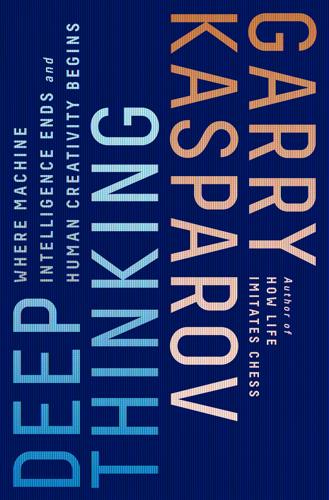
Deep Thinking: Where Machine Intelligence Ends and Human Creativity Begins
by
Garry Kasparov
Published 1 May 2017
But the worries about operatorless elevators were quite similar to the concerns we hear today about driverless cars. In fact, I learned something surprising when I was invited to speak to the Otis Elevator Company in Connecticut in 2006. The technology for automatic elevators had existed since 1900, but people were too uncomfortable to ride in one without an operator. It took the 1945 strike and a huge industry PR push to change people’s minds, a process that is already repeating with driverless cars. The cycle of automation, fear, and eventual acceptance goes on. Of course, what an observer calls freedom and disruption, a worker calls unemployment.
…
Human error is responsible for over 50 percent of plane crashes, although overall air travel is getting safer as it becomes more automated. In other words, fail-safes are required, but so is courage. When I sat across from Deep Blue twenty years ago I sensed something new, something unsettling. Perhaps you will experience a similar feeling the first time you ride in a driverless car, or the first time your new computer boss issues an order at work. We must face these fears in order to get the most out of our technology and to get the most out of ourselves. Many of the most promising jobs today didn’t even exist twenty years ago, a trend that will continue and accelerate.
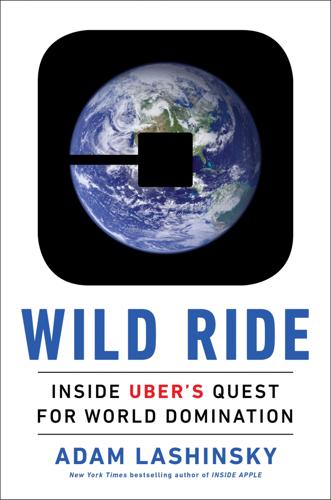
Wild Ride: Inside Uber's Quest for World Domination
by
Adam Lashinsky
Published 31 Mar 2017
This was Sebastian Thrun, the German roboticist who launched Google’s autonomous efforts. Thrun had been a robotics professor at Carnegie Mellon University, home to some of the most advanced research on machine learning and artificial intelligence, when a research arm of the Pentagon started a competition to develop driverless cars. The so-called DARPA Grand Challenge was a bid by the Defense Advanced Research Projects Agency to encourage academics to help the U.S. military field a fighting force that relied less on putting soldiers in harm’s way. Between the time of the first challenge and the third, in 2005, Thrun had abandoned CMU in Pittsburgh for the sunnier climes of Stanford University, in the heart of Silicon Valley.
…
We discuss in great detail how Kalanick oversaw later fund-raising for Uber, including the rounds that got the company to its eventual private-market valuation of nearly $70 billion. When we travel all the way past Fisherman’s Wharf, dodging midsummer tourists from around the world, we step into an In-N-Out Burger, the greasy fast-food chain from Southern California and a Kalanick favorite. By now we are discussing driverless cars, and Kalanick suggests big moves are ahead that he can’t yet discuss. He lets on that this six-mile walk, always including the In-N-Out Burger stop, has become a summer-evening routine and that he typically walks it with one person he won’t identify. I later learn his walking partner is Anthony Levandowski, the ex-Google autonomous vehicles engineer who went on to found Otto, the self-driving truck company.

Platform Revolution: How Networked Markets Are Transforming the Economy--And How to Make Them Work for You
by
Sangeet Paul Choudary
,
Marshall W. van Alstyne
and
Geoffrey G. Parker
Published 27 Mar 2016
The ultimate promise: “Transportation that’s as reliable as running water.”3 The implications are startling. The major automakers would be devastated by the shrinkage of their market. So would ancillary businesses such as auto insurance, car finance, and parking. On the other hand, the sudden decrease in demand for parking places (since driverless cars can be in virtually continual use) will free up tens of millions of square feet of real estate for development, liberate lanes on practically every city street, and drastically reduce the pollution and congestion caused by drivers cruising the streets in search of a parking spot. If this vision for the next phase of Uber’s growth comes true, the landscape of America may well be rendered unrecognizable.4 And if all that is not enough, consider this observation by Kalanick: “If we can get you a car in five minutes, we can get you anything in five minutes.”5 Anything at all?
…
And Internet-centered companies like Google and Apple are designing interfaces and operating systems that will enable both technology experts and ordinary people to have easy access to the Internet of things and use it in countless ways we’re only beginning to imagine and explore. What’s more, the potential power of the Internet of things will only continue to grow as the varieties of devices available to us and their capabilities continue to expand. To mention just a few examples, consider the transformative power of such just-around-the-corner technologies as driverless cars, cheap and powerful electrical storage batteries for the home, and easy-to-use 3D printers for quickly replicating useful objects. As these and other new tools become widely available, they’ll also quickly be linked to the Internet of things, making even more powerful value-creating platforms possible.
…
B., 54–55 classified ads, 49, 63, 120, 131, 133–34 click-throughs, 190, 197 cloud-based networking, 30, 56 cloud-based storage, 54, 56, 56, 59, 102, 177–78 cloud computing, 145, 155, 209 Coase, Ronald, 234–35 Coca-Cola, 198–99 code, computer, 53, 79–80, 131–32, 140, 143, 166, 170, 172, 240, 254–55, 267 coffee machines, 143, 157–58, 159 colleges and universities, 8–9, 91, 97–99, 265–68 community-driven curation, 67–68, 78 comparative advantage, 188–89 competition complexities, 210–13 computer programming, 52, 99, 131–32, 267 Confinity, 80, 83 Congress, U.S., 248–49 connectivity platforms, 200–201, 285, 289 consulting firms, 8, 194 consumer relationship management (CRM), 11, 96, 174 consumer-to-consumer marketplace, 2–3, 29 contact information, 163, 190 contracts, 142, 166, 172, 197, 225–26 control systems, 164–65 convex growth, 20, 295, 297 Cook, Tim, 148 co-opetition (co-creation), 194, 212, 227 copyright, 57, 167, 208, 258, 259 core developers, 141–42 corporations, 157–58 governance by, 164, 256–60 image ads for, 229–30 sponsorship by, 137, 139–40 corruption, 160, 236–37 cosmetics industry, 206 Coursera, 8, 265, 266, 267 Craigslist, 47, 49, 91–92, 101, 103, 165, 193, 224 credit, 170, 175, 243–44, 263, 275–76, 277 credit cards, 37, 81, 83, 84, 137, 139–40, 175, 226, 243, 275 credit reports, 243–44 crime, 165, 231, 257 critical assets, 220–21 critical mass, 97, 112, 188, 195, 201–2 Croll, Alistair, 191, 196 cross-side effects, 29, 30, 34, 295 crowd curation, 167–70 crowdfunding, 40, 51, 92, 96, 102, 111 crowdsourcing, 12, 267 Cryptography, 171 currency, 5, 15, 36, 37–38, 46, 159, 173–74 customized ads, 244 Cusumano, Michael A., 58, 178–79 Damodaran, Aswath, 16–18 data: accountability based on, 253–56 aggregators for, 141, 145–46, 244–48, 254, 255, 262–63, 278 big, 11, 247–48, 276 brokers of, 244–45 capture and collection of, 218–19, 264, 296 in communications, 176–78 flow of, 170, 246–48 leveraging of, 217–20 manipulation of, 251–53 in nationalism, 247–48, 260 platforms for, 200 profiles derived from, 48, 119, 127 security of, 230, 243–46, 260 software for, 91–92, 107, 255, 269, 270–71, 275, 276–77, 278, 284, 286 storage of, 54, 56, 56, 59, 102, 171–73, 177–78 strategic, 217–20 tactical, 217–18 tools for, 10–11, 48, 49, 71 databases, 24–25, 42–44, 63, 72–75, 76, 91–92, 107 “Data Brokers: A Call for Transparency and Accountability,” 245 Data.gov, 283 Data Jams, 282 dating services, 26–28, 30, 93, 97–98, 120, 123, 166, 194 De Beers, 208–9 decentralization, 159, 171–73, 272–74 deep design, 179–80 defaults, 170, 263, 276 Delicious, 95–96 demand-side economies of scale, 18–20, 32, 34, 226 democracy, 149–50, 257, 283 department stores, 264, 287 designers, graphic, 66, 72, 106, 118–19, 267 design structure matrices, 57–58 diabetes, 269–70 diamond industry, 208–9 digital currency, 171, 274–78 digital message deliveries, 94–95 digital real estate, 174–75, 216 digital rights management (DRM), 31 Diners Club, 84 direct-to-consumer channels, 264 discounts, 22, 25–26 disintermediation, 68–69, 71–72, 78, 161–62, 170–71, 298 disk defragmentation, 200 dispute resolution, 169–70 Djankov, Simeon, 238, 239 doctors, 263, 268, 269, 271, 279 Dorsey, Jack, 97 dot-com bubble, x, 22, 79, 80, 113, 288 Dribbble, 37, 66, 118–19 driverless cars, 284 driver ratings, 254, 264 driving records, 232–33, 277 Dropbox, 32, 102, 109 Drucker, Peter, 210 drug trafficking, 162 Duhigg, Charles, 146 Duracell, 162 DVDs, 63, 111, 139 e-commerce, 56, 91, 111, 124–25, 145, 204–5 Earth Class Mail, 94–95 eBay, vii, ix, 2, 3, 17, 24, 36, 38, 40, 83–84, 85, 91, 93, 111, 112–13, 125, 135, 161–62, 163, 169–71, 172, 173, 196n, 205, 206, 207, 215, 262 economics, 72, 78, 230, 234–39 economies of scale, 18–20, 206 Edison, Thomas, 19, 284 editors, 7, 10, 68, 72, 93, 129–30, 262 education, 7–8, 77, 96, 111, 122, 124, 212, 233, 261, 263, 265–68, 269, 288, 289 education platforms, 96, 111, 265–68, 289 Eisenmann, Thomas R., ix, 130 electric lighting, 19, 285 electric power, 19, 69, 247, 284–85 Electronic Arts (EA), 94, 124, 240 electronic health records, 270 electronics, 75, 178, 206 email, 81, 85, 101–4, 185 Encyclopaedia Britannica, 10–11 encyclopaedias, 10–11, 129–30, 133, 149–51 Endomondo, 75 end-to-end design principle, 52–54 energy: efficiency of, 254, 284–85, 286 industry for, 261, 272–74, 289 resources of, 69–70, 254, 272–74 enhanced access, 112, 118, 119–21, 126, 127, 296 enhanced curation, 121–22, 126–27 enhanced design, 223–24 enterprise management, 173–75 enterprise resource planning (ERP), 11 entrepreneurs, 79–83, 86, 96, 111, 205, 282 environmental issues, 62, 70–71, 233, 237, 272, 274 Equal Credit Opportunity Act (1974), 243–44 Equity Bank, 277–78 e-readers, 178 eToys, 22 Etsy, 65, 73, 149, 212, 262, 299 European Union (EU), 242, 247–48 events listings, 112–15, 126 Excel, 216 excess inertia, 241, 296 exclusive access, 213–15 expert networks, 30, 36, 68, 93, 96, 99, 117–18 extension developers, 141, 142–45, 147, 148–49, 153–54 external networks, 100–101, 102, 103–4, 105 Facebook, 3, 12, 20, 32, 33, 37, 39, 41–50, 66, 90–91, 98–103, 104, 112, 121, 126, 131–35, 132, 133, 145, 151, 159, 163, 168, 181, 184, 185, 197, 204, 216–18, 221, 226, 245, 251–52, 267, 270–71 Fair Credit Reporting Act (1970), 175 fairness, 179–81, 230 fair use doctrine, 259 farm prices, 42–44, 60 FarmVille, 221 Fasal, 42–44 Federal Reserve, 174 Federal Trade Commission (FTC), 242, 243–44, 245 FedEx, 61, 249–50, 278 feedback loops, 21, 28, 45–46, 68, 71, 72, 100–101, 108, 139, 167–70, 218–19, 223, 296 feet on street (FOS) sales forces, 43–44, 91 files, 63, 166 encryption of, 200 formats for, 29–30 film industry, 9, 66, 138–39, 163, 178, 259, 267 filters, 38–41, 42, 59, 133, 295, 296–97 financial crash of 2008, 178, 230 financial services industry, 11, 16–18, 33, 164, 171–73, 178, 230, 261, 274–78, 289 fitness and sports activities, 74–76, 245, 270–71 five forces model, 207–10, 212, 213, 221 500px, 37, 47 Fiverr, 116, 193 fixed costs, 9–10, 209, 224–25, 278 follow-the-rabbit strategy, 89–91, 105 food industry, 76, 254, 255, 278 Ford, Henry, 19, 32 Ford Motor Co., 19 Fortune 500, 65 Foursquare, 97, 98 fragmented industries, 131, 262, 265, 268–69, 289 fraud, 175, 196–97, 255, 257, 276 Free: The Future of a Radical Price (Anderson), 22 freelancers (independent contractors), 21, 36, 37, 64, 65, 117–18, 193–94, 196, 210, 213, 233–34, 249–51, 279, 280, 287, 297, 299 free trade, 205, 206, 235 Friedersdorf, Conor, 236 Friendster, 98 FuelBand, 74, 75 full-time employees, 249–50 FUSE Labs, 252–53 games, gaming, 94, 103, 124, 132, 159, 163, 178, 211, 212, 217, 221, 240 “Gangnam Style,” 84, 147 gatekeepers, 7–8, 151–52, 171–73, 243, 253, 262, 265, 268, 275–76, 281, 289, 298 Gawer, Annabelle, 58, 178–79 Gebbia, Joe, 1–2 General Electric (GE), 4, 13, 19, 76, 78, 86, 110, 201, 204, 208, 247, 284 Generally Accepted Accounting Principles, 238–39 geographic focus, 98–99, 271 Germany, 96–97, 161, 205 Gillette, King, 109–10 Global 500, 209–10 Go-Jek, 278 Goldberg, Whoopi, 23 Goodwin, Tom, 11–12 Google, vii, 3–7, 21–25, 30–33, 49–50, 55, 58, 64, 72, 111, 112, 120, 121, 125, 134, 137, 140–41, 148, 153–54, 159, 198–99, 214–17, 226, 240, 242, 250, 267, 270–71 Google AdWords, 72, 120, 121, 125 Google Maps, 49–50, 55, 148, 200 Google Play, 154 government platforms, 261, 281–83, 289 graphical processing units (GPUs), 56, 57, 58 graphic design, 67, 226 Great Britain, 160, 205 gross domestic product (GDP), 160, 161 Grossman, Nick, 253, 254, 255, 256 Guardian, 144–45 Gurley, Bill, 16–18, 21 Haber-Bosch process, 19 Hachette Book Group, 251 Haier Group, vii, 76, 125, 198–99, 222 Halo, 94, 240 Halo: Combat Evolved, 94 Hammurabi, Code of, 274 hard drives (HDs), 56, 57, 58 hardware, 56, 57–58, 136, 152–53, 178–79 Harvard University, 98–99, 266 hashtags, 58, 104 Havas Media, 11–12 health care, 32–33, 35, 69, 71, 77, 200, 233, 234, 238, 245, 261, 263, 265, 268–72, 277, 280, 289 health insurance, 234, 263, 271–72, 277, 280 Heiferman, Scott, 113–14, 126 heirlooms, 161–62 Here, 49–50 Hertz, 9 heuristics, 123–24 Hilton Hotels, 8, 64 Hipstamatic, 100 homeowners’ insurance, 175, 232 horizontal integration, 33, 74–76, 208 hospitals, 69, 71, 233, 270, 271–72 hosting sites, 88, 198, 223–24 hotel industry, 1–2, 8–9, 10, 12, 64, 67, 101, 111, 142–43, 198, 224, 229–33, 236, 253, 287 Hotmail, 103, 104 Houghton Mifflin Harcourt, 204, 208, 225 HTTP, 177 Huffington Post, 90 human resources, 14, 39 human rights, 159, 160–61 hypercompetition, 209–10, 213 IBM, x, 137, 152, 179, 284 iCloud, 75 identity theft, 244 InCloudCounsel, 279 income streams, 139–41, 143, 144, 215 India, 73, 91 Indiegogo, 96, 124 Indonesia, 278 Industrial Awakening, 285–86 industrial development, 205–10, 224–25, 268 industrial-era firms, 19, 32, 34, 256, 285, 288 Industrial Revolution, 288 Industry Standard Architecture (ISA), 58 information, 40, 42 agencies for, 243–44 age of, 253, 256, 260 asymmetries of, 161–62, 164, 181, 182, 220, 228, 258–59, 262–63, 265, 269, 281, 289 exchange of, 36, 37, 39, 41, 47–48, 51, 134 intensive need for, 262–63, 265, 268, 281, 289 mis-, 129–30 platforms for, 190, 200, 287 units of, 296–97 initial public offerings (IPOs), ix, 91, 204–5 Instagram, 3, 13, 32, 46, 47, 66, 85, 100, 102–3, 104, 204, 217, 218, 299 instant messaging, 131, 198, 211 insurance industry, 9, 62, 71, 142, 164, 175–76, 232, 268, 277 integrated systems, 33, 74, 131 Intel, vii, x, 57–58, 89, 137, 178–81, 270–71, 284 Intel Architecture Labs (IAL), 179–81 intellectual property (IP), 33, 57, 167, 174–75, 180, 258 interaction failures, 190, 192, 196–97 Interbrand, 198–99 interest rates, 170, 244, 276 Internal Revenue Service (IRS), 93 internal transparency, 176–79 International Financial Reporting Standards, 238–39 Internet, 24–25, 32, 60–63, 76–79, 95–96, 107–13, 121, 167, 201, 204, 205, 209, 244, 249, 250, 263, 264, 283–89, 299 Internet of things, 76, 201, 204, 283–86, 289 inventory, 9, 11–12, 25, 42, 141, 184, 186, 262 investment, ix, 16, 63, 164, 168–69, 184–86, 209, 278 iPads, 95 iPhone, 3, 6–7, 72, 131, 140, 147, 148, 178, 211, 213–14, 222 iStockphoto, 167–68, 173 iTunes, 75, 131, 142, 153, 164, 214, 231 Japan, 66, 205–6 Jassy, Andrew, 177–78 Java programming language, 140 Jawbone, x, 77, 245 job listings, 39, 49, 50, 51, 63, 111, 118–19, 120, 131, 133–34, 137, 184–86, 196, 201, 218 Jobs, Steve, viii, 53, 131, 214 joint venture model, 137, 138 judiciary, 237, 238, 250 JVC, 138–39 Kalanick, Travis, 18, 62 Kelley, Brian P., 157 Kenya, 277–78 Kercher, Meredith, 129–30, 149–50 Keurig Green Mountain, 143, 157–58, 159, 181 Kickstarter, 40, 92, 96, 102, 111 Kindle, 7, 10, 67, 140, 154, 243 Kindle Fire, 140 Knox, Amanda, 129–30, 149–50 Korengold, Barry, 61 Kozmo, 22–23 Kretschmer, Tobias, 257 Kuraitis, Vince, 270, 271 labor: child, 164 division of, 280 market for, 39, 49, 50, 51, 63, 111, 118–19, 120, 131, 133–34, 137, 196, 201, 218, 235 platforms for, 200, 201, 213, 233–34, 248–51, 279–81, 289 regulation of, 230, 249–51, 260, 288 self-employed, 21, 36, 37, 64, 65, 117–18, 193–94, 196, 210, 213, 233–34, 249–51, 279, 280, 287, 297, 299 unions for, 280, 288 Laffont, Jean-Jacques, 235, 237 law firms, 8, 204, 279 laws and legal systems, 88, 164–70, 182, 230, 247–49, 257, 258, 260, 281 lead generation, 113, 117 Lean Analytics (Croll and Yoskovitz), 191, 196 lean startups, 199, 201–2 Lee Kuan Yew, 160–61 LegalZoom, 204, 225 Lending Club, 77, 275, 276 Lessig, Lawrence, 164–65, 166 Levchin, Max, 79–81 Lexis, 204, 225 liability coverage, 175, 232 libertarianism, 79, 80, 236, 238 licensing fees, 61, 131, 258–59 licensing model, 136–37, 138, 139, 214, 235, 296 lightbulbs, 284–85 linear value chains (pipelines), 6, 183–84, 297, 298 LinkedIn, 39, 41–42, 48, 50–51, 103, 111, 119, 170, 173, 184, 197, 218–19, 223, 226, 245 Linux, 137, 138, 154, 200 liquidity, 189–91, 193, 194–95, 201–2, 297 local content regulations, 246–47 logos (icons), 82, 83 “long tail” (software adoption), 216–17, 219 Lyft, 49, 50–51, 67, 213, 227, 250–51, 297 Ma, Jack, 125, 206, 215 MacCormack, Alan, 57 magazines, 72, 151, 197, 244, 264, 275 magnetic resonance imaging (MRI), 69, 71 mail, 63, 94–95, 171 MailChimp, 109 Malaysia, 160 Management Science (MacCormack and Baldwin), 57 mandis (market-makers), 42–44 Manghani, Ravi, 273–74 manufacturing efficiencies, 208, 209, 261 MapMyFitness, 75 mapping services, 49–50, 55, 148, 200 marginal economics, 72, 78 Marini, Rick, 184–85 marketing, 14, 19, 25, 52–53, 72, 73–74, 84–85, 100, 101, 105, 183–84, 209–10, 267 Marketplace Fairness Act (2013), 249 marketplaces, 60, 91, 190, 204, 249 markets: access to, 87–88, 98, 194, 215, 218, 220 aggregation of, 68–69, 72–73, 78, 262, 297 controls for, 164–65 data on, 42–44 emerging, 210–11 entry barriers to, 207–8, 215, 219–20 expansion of, 4, 20, 31–32 failure of, xiii, 161–63, 164, 170–71, 182, 234–35, 256, 257, 258–59, 263, 289 free, 149, 161–65, 173–76, 180, 182, 234–36 frictionless entry into, 25–26, 34, 81, 107–8, 111, 117, 124–25, 130, 168, 206, 297 incumbent advantage in, 86, 218, 261, 263 late-mover problem in, 87–88, 98 liquidity of, 171, 196 local, 70–71, 117–18, 264 manipulation of, 238, 251–53, 260, 287 micro-, 98–99, 105 multi-sided, 159, 164 new entrants to, 207–10, 262, 296 niche, 88, 216, 223–24, 228, 300 one-sided, 157–58, 159 share of, 16–22, 33, 53, 60–62, 65, 81, 87–88, 112–13, 131–33, 132, 133, 137–40, 152–53, 157, 222–26, 260, 287 strategy for, viii, xi, 10, 16–18, 20, 21, 31–32, 33, 42–44, 57–58, 69–73, 77, 78, 89, 111, 124, 173, 210–11, 272–74, 278 supply and demand in, 69–71, 173, 210–11, 272–74, 278 “thickness” of, 164, 171, 173 two-sided, 81, 89, 93, 110, 119, 175, 196, 215, 218, 295, 298 winner-take-all, viii, 224–27, 228, 279–80, 300 marquee strategy, 94–95, 105 Marriott Hotels, 8–9 massive open online courses (MOOCs), 266–67 mass media, 40, 63, 72, 77, 262, 264 MasterCard, 226, 275 matching services, 17, 47–48 Matharu, Taran, 4–5 McCormick Foods, 76 McGraw-Hill, 204, 208 Mechanical Turk, 249, 280 Medicare, 250 Medicast, 269, 279 Medium, 71–72 Meetup, 113–15, 126 Megaupload, 87–88 membership fees, 123, 125 Mercateo, 96–97 mergers and acquisitions, 208, 216, 220–21, 228 Metcalfe, Robert, 20, 297 Metcalfe’s law, 20, 21, 295, 297 metering tools, 272–73 Microsoft, vii, x, 3, 13, 20, 29, 33, 52–53, 94, 103–4, 110, 124, 131, 140, 152–53, 179, 181, 200, 211, 216, 226, 240, 241, 252, 267, 270–71 Microsoft Outlook, 103–4 Microsoft Vista, 52–53 Microsoft Windows, 30, 53, 140, 152–53, 200, 222, 240 Microsoft Windows XP, 53 middlemen, 68–69, 71–72, 78, 161–62, 170–71, 298 Minerva Project, 268 mining, 225, 263 mislabeled bargains, 161–62, 170–71 MIT, ix–x, xi, 214, 266, 267 MIT Initiative on the Digital Economy, ix–x MIT Platform Strategy Summit, xi, 214 moderators, 151–52 modular design, 54–57, 221 monetary policy, 159, 173–74 monetization, 38, 63, 106–27, 188, 215 MonkeyParking, 233, 234 monopolies, 18–19, 162, 163, 172–73, 182, 208–9, 227, 237, 238, 240–41, 242 Monster, 218–19, 223, 226 mortgages, 237, 243, 263 Mount, David, 285–86 MP3 players, 178 multidirectional platforms, 272–74 multihoming, 213–15, 223–28, 250–51, 297, 300 multinational corporations, 246–48 multi-sponsor decision-making, 139–40 multi-user feedback loop, 46, 100–101 music industry, 63, 71, 75, 87, 111, 134–35, 147, 178, 213, 226, 231, 258, 287, 297 MyFitnessPal, 75, 245 Myspace, 87, 92, 98, 125–26, 131–34, 132, 133, 135, 143, 204, 221, 226 Nakamoto, Satoshi, 171–73 Nalebuff, Barry J., 212 NASDAQ, ix, 80 National Transportation Safety Board (NTSB), 237 navigation tools, 191, 297 NBC, 204, 225 negative cross-side effects, 30–32, 34, 295 negative externalities, 163, 229–34, 257, 287 negative feedback, 28, 157–58, 166–67 negative network effects, 17, 26–32, 34, 47, 49, 51, 68, 112–15, 120, 121, 123, 126, 151, 229–34, 287, 298 negative same-side effects, 30, 298 Nest, 204, 225 Netflix, 63, 163, 204, 225 Netscape, 62, 110 network matching, 26–28 network orchestrators, 32 News Corp., 126 news feeds, 121, 168, 251–52 newspapers, 63, 144–45, 264, 287 New York City, 61, 113, 123, 229–30, 231, 258–59 New York State, 69–70, 274 New York Stock Exchange, 55, 171 New York Times, 205 NeXT, 53 Nigeria, 247 Nike, 4, 74–76, 78, 205, 271 9/11 attacks, 113 99designs, 66, 106 Nintendo, 94, 211, 240 noise, 28, 114, 120, 199, 200 Nokia, 49–50, 64, 131, 226 Novel Writing Month, 4–5 NTT, 89 oDesk, 201 oil and gas industry, 225, 235, 259, 263, 272 OkCupid, xi, 26–28, 30, 195–96 oligopolies, 209, 238 on-boarding effect, 90–91, 97 online courses, 96, 111, 265–68, 289 Open Data, 282 “open in” vs.

The Future Is Faster Than You Think: How Converging Technologies Are Transforming Business, Industries, and Our Lives
by
Peter H. Diamandis
and
Steven Kotler
Published 28 Jan 2020
But even as we witness the birth of aerial ridesharing—which seems likely to replace multiple parts in this system—a different revolution threatens it entirely: autonomous cars. While the first driverless car was a radio-controlled “American wonder” that navigated the streets of New York City back in the 1920s, this was little more than an oversized toy. Its more modern incarnation emerged from the military’s desire for a risk-free way to resupply troops. Roboticists began trying to meet this need in the 1980s; car companies started paying attention in the nineties. Many date the pivotal breakthrough to 2004, when the Defense Advanced Research Projects Association (DARPA) created a driverless car competition—the DARPA Grand Challenge—to turbocharge development.
…
The value of your home is partially measured in its proximity to a half-dozen locations: a central shopping district, the best schools, your place of work, favorite restaurants, the homes of your closest friends, etc. But over the next decade, with the transportation transformation that’s coming, we’re changing the relationship between here and there. So what happens when driverless cars, flying cars, and the Hyperloop make proximity a possibility for all? If Las Vegas to Los Angeles becomes a half-hour Hyperloop commute; if upstate Vermont to middle-of-Boston becomes a flying car ride away; if remote Virginia into Washington, DC, is an hour-long nap in an autonomous Uber, why not buy twice-the-house for half the price in outlying areas?
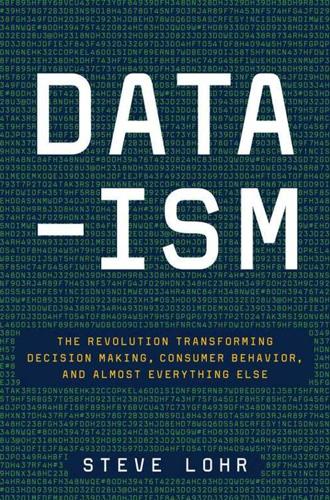
Data-Ism: The Revolution Transforming Decision Making, Consumer Behavior, and Almost Everything Else
by
Steve Lohr
Published 10 Mar 2015
And GE’s bet is that there are big gains in productivity to be had without driverless cars filling the roads and robots delivering packages to your door. It is true that incumbents, like GE, reflexively favor an evolutionary path. Yet it is also true that the world of big data will come sooner, across more of the economy, if GE is right. 8 THE YIN AND YANG OF BEHAVIOR AND DATA Yoky Matsuoka was known as a robot wizard a few years ago, so much a star that she could pick and choose what she wanted to do. At Google, she was one of the founding members of the company’s X Lab, the secretive unit that became the incubator for Google’s driverless cars and Internet-connected glasses.
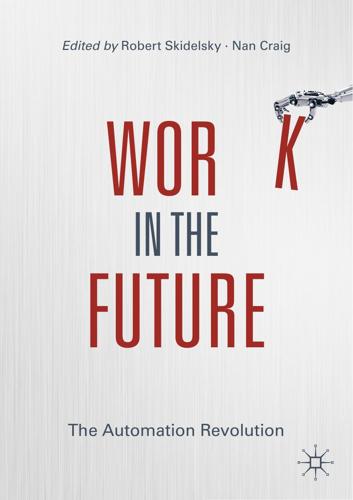
Work in the Future The Automation Revolution-Palgrave MacMillan (2019)
by
Robert Skidelsky Nan Craig
Published 15 Mar 2020
In my own research, I asked the question: what do the tasks of driving a car, making a medical diagnosis and identifying a bird at a fleeting glimpse have in common? And the answer is that they are all tasks that, until recently, most economists thought were ‘non-routine’ and so could not readily be automated. However, now they increasingly can be. Today, all major car manufacturers have driverless car programs, there are countless systems that can diagnose medical problems, and there is even an app developed by the Cornell Lab of Ornithology that can identify a bird at a fleeting glimpse. What went wrong with the ALM hypothesis? As we have seen, most economists thought that the only way to automate a task was to copy the way that human beings thought and reasoned, to try to capture their thinking and reasoning processes in a set of instructions for a machine to 13 Work in the Digital Economy 129 follow.
…
The same process innovations that displace workers in the user industries create demand for workers in the producer industries. The new robots and smart machines need to be developed, designed, built, maintained and repaired. Additionally, the Internet of Things, Industry 4.0, digital Taylorism, driverless cars, big data and artificial intelligence require high investment in new infrastructure such as broadband, transport equipment and IT equipment, as well as increasingly complex software. As a result, process innovations and compensation effects destroy and create jobs, however, they tend to create fewer jobs than they destroyed.
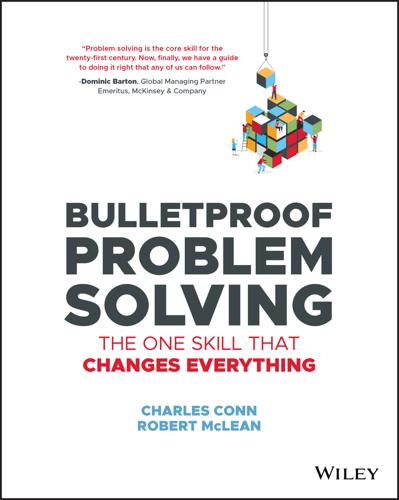
Bulletproof Problem Solving
by
Charles Conn
and
Robert McLean
Published 6 Mar 2019
EXHIBIT 8.1 Level 2 are situations in which there are alternative futures that could follow from a legislative change or technology change, where the results will be binary in the sense of who wins/loses. The Brexit decision in the UK is an example. Another is how should auto insurers prepare for driverless cars on the road, where the time frame for adoption is uncertain, and the role of carmakers in providing the insurance is unclear. Both of these examples are likely to have uncertainty resolved in a 5‐ to 10‐year time period. Level 3 is where there is a range of futures that are possible but where it isn't clear which one is more likely.
…
As automation’s and artificial intelligence's roles in the workplace expand at ever increasing rates, predictions for the labor market have many facets of uncertainty compared to 25 or 50 years ago.10 The tailwinds are around mostly non‐routine, cognitive jobs that didn't exist 10 years ago—you may have seen the World Economic Forum new jobs list: app developer, social media manager, driverless car engineer, cloud‐computing specialist, big‐data analyst, sustainability manager, YouTube content creator, drone operator, millennial generation expert. In 10 years the list will be different again. So as a young person choosing a career, how would you best position yourself in this changing labor landscape?

Machine, Platform, Crowd: Harnessing Our Digital Future
by
Andrew McAfee
and
Erik Brynjolfsson
Published 26 Jun 2017
Perez, “ ‘Predictive Learning’ Is the New Buzzword in Deep Learning,” Intuition Machine, December 6, 2016, https://medium.com/intuitionmachine/predictive-learning-is-the-key-to-deep-learning-acceleration-93e063195fd0#.13qh1nti1. 81 Joshua Brown’s Tesla crashed: Anjali Singhvi and Karl Russell, “Inside the Self-Driving Tesla Fatal Accident,” New York Times, July 12, 2016, https://www.nytimes.com/interactive/2016/07/01/business/inside-tesla-accident.html. 82 it appears that neither Brown: Tesla, “A Tragic Loss,” June 30, 2016, https://www.tesla.com/blog/tragic-loss. 82 “Conventional wisdom would say”: Chris Urmson, “How a Driverless Car Sees the Road,” TED Talk, June 2015, 15:29, https://www.ted.com/talks/chris_urmson_how_a_driverless_car_sees_the_road/transcript?language=en. 82 “Our vehicles were driving through Mountain View”: Ibid. 83 The Japanese insurer Fukoku Mutual Life: Dave Gershgorn, “Japanese White-Collar Workers Are Already Being Replaced by Artificial Intelligence,” Quartz, January 2, 2017, https://qz.com/875491/japanese-white-collar-workers-are-already-being-replaced-by-artificial-intelligence. 83 “learn the history of past payment assessment”: Google Translate, “December 26, Heisei 28, Fukoku Life Insurance Company,” accessed January 30, 2017, https://translate.google.com/translate?
…
200 “So,” the company’s website explains: Uber, “[Our Story],” accessed February 5, 2017, https://www.uber.com/our-story. 200 initially called UberCab: Leena Rao, “UberCab Takes the Hassle Out of Booking a Car Service,” TechCrunch, July 5, 2010, https://techcrunch.com/2010/07/05/ubercab-takes-the-hassle-out-of-booking-a-car-service. 200 “supercrazy freakin’ small”: Fast Company, “Travis Kalanick, the Fall and Spectacular Rise of the Man behind Uber,” South China Morning Post, September 25, 2015, http://www.scmp.com/magazines/post-magazine/article/1860723/travis-kalanick-fall-and-spectacular-rise-man-behind-uber. 200 By late 2010, Kalanick had begun: Ibid. 200 Eighteen months later they launched UberX: Alexia Tsotsis, “Uber Opens Up Platform to Non-limo Vehicles with ‘Uber X,’ Service Will Be 35% Less Expensive,” TechCrunch, July 1, 2012, https://techcrunch.com/2012/07/01/uber-opens-up-platform-to-non-limo-vehicles-with-uber-x-service-will-be-35-less-expensive. 201 UberPool, launched in August of 2014: Alex, “Announcing UberPool,” Uber Newsroom (blog), August 5, 2014, https://newsroom.uber.com/announcing-uberpool. 201 $20 billion in annual gross bookings: James Temperton, “Uber’s 2016 Losses to Top $3bn According to Leaked Financials,” Wired, December 20, 2016, http://www.wired.co.uk/article/uber-finances-losses-driverless-cars. 201 Uber was valued at $68 billion: Andrew Ross Sorkin, “Why Uber Keeps Raising Billions,” New York Times, June 20, 2016, https://www.nytimes.com/2016/06/21/business/dealbook/why-uber-keeps-raising-billions.html. 201 Traditional taxis provided 8.4 million trips: UCLA Labor Center, “Ridesharing or Ridestealing?

The Theory That Would Not Die: How Bayes' Rule Cracked the Enigma Code, Hunted Down Russian Submarines, and Emerged Triumphant From Two Centuries of Controversy
by
Sharon Bertsch McGrayne
Published 16 May 2011
“A computer can easily be trained to distinguish a desert from a forest, but where the road is and where it’s about to fall off a cliff, that’s much harder.” To explore such imaging problems, Sebastian Thrun of Stanford built a driverless car named Stanley. The Defense Advanced Research Projects Agency (DARPA) staged a contest with a 2 million prize for the best driverless car; the military wants to employ robots instead of manned vehicles in combat. In a watershed for robotics, Stanley won the competition in 2005 by crossing 132 miles of Nevada desert in seven hours. While Stanley cruised along at 35 mph, its camera took images of the route and its computer estimated the probability of various obstacles.
…
After the race, Stanley retired in glory to its own room in the Smithsonian National Museum of American History in Washington. The next year a Bayesian team from Carnegie Mellon University and General Motors won another 2 million from DARPA by maneuvering a robot through city traffic while safely avoiding other cars and obeying traffic regulations. Urban planners hope driverless cars can solve traffic congestion. Another Carnegie Mellon team relied on Bayes’ rule and Kalman filters to win international robotic soccer championships involving fast-moving multirobot systems. The U.S. military is heavily involved in imaging issues. Its Automatic Target Recognition (ATR) technology is a heavy user of Bayesian methods for robotic and electronic warfare, combat vehicles, cruise missiles, advanced avionics, smart weapons, and intelligence, surveillance, and reconnaissance.

The Economic Singularity: Artificial Intelligence and the Death of Capitalism
by
Calum Chace
Published 17 Jul 2016
[clxxxviii] In December 2015 Bloomberg reported that Google was preparing to move its self-driving cars unit from its Google X research arm to become a stand-alone business unit within the Alphabet holding company.[clxxxix] At the same time, Elon Musk, CEO of Tesla, remarked that he was revising his estimate of the time when fully automated cars would be available from three years down to two.[cxc] In January 2016 he announced that within about two years, Tesla owners would be able to “summon” their driverless car from New York to pick them up in Los Angeles.[cxci] He claimed that Tesla cars are already better drivers than humans.[cxcii] In April 2016 he went further, claiming that Tesla’s autopilot system was already reducing the number of accidents by 50% - where an accident meant an incident where an airbag was deployed.
…
+Department+of+Transportation+Releases+Policy+on+Automated+Vehicle+Development [clxxxiv] http://www.reuters.com/investigates/special-report/autos-driverless/ [clxxxv] http://www.wired.com/2015/04/delphi-autonomous-car-cross-country/ [clxxxvi] http://recode.net/2015/03/17/google-self-driving-car-chief-wants-tech-on-the-market-within-five-years/ [clxxxvii] http://techcrunch.com/2015/12/22/a-new-system-lets-self-driving-cars-learn-streets-on-the-fly/ [clxxxviii] http://cleantechnica.com/2015/10/12/autonomous-buses-being-tested-in-greek-city-of-trikala/ [clxxxix] http://www.bloomberg.com/news/articles/2015-12-16/google-said-to-make-driverless-cars-an-alphabet-company-in-2016 [cxc] http://electrek.co/2015/12/21/tesla-ceo-elon-musk-drops-prediction-full-autonomous-driving-from-3-years-to-2/ [cxci] http://venturebeat.com/2016/01/10/elon-musk-youll-be-able-to-summon-your-tesla-from-anywhere-in-2018/ [cxcii] https://www.washingtonpost.com/news/the-switch/wp/2016/01/11/elon-musk-says-teslas-autopilot-is-already-probably-better-than-human-drivers/ [cxciii] http://electrek.co/2016/04/24/tesla-autopilot-probability-accident/ [cxciv] http://www.bbc.co.uk/news/technology-35280632 [cxcv] http://www.zdnet.com/article/ford-self-driving-cars-are-five-years-away-from-changing-the-world/ [cxcvi] http://www.reuters.com/investigates/special-report/autos-driverless/ [cxcvii] http://www.wired.com/2015/12/californias-new-self-driving-car-rules-are-great-for-texas/ [cxcviii] http://www.reuters.com/investigates/special-report/autos-driverless/ [cxcix] It has been suggested that electric cars should make noises so that people don’t step off the pavement in front of them.
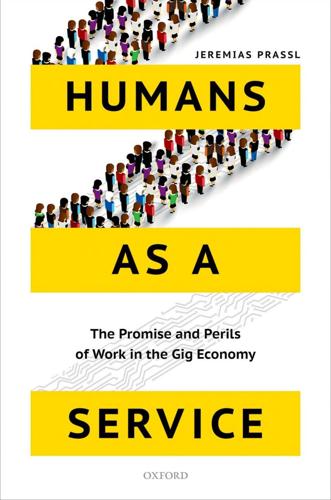
Humans as a Service: The Promise and Perils of Work in the Gig Economy
by
Jeremias Prassl
Published 7 May 2018
As Christine Lagarde, President of the International Monetary Fund (IMF), highlighted in the spring of 2017, * * * Why Should We Care? 87 economists and politicians are increasingly concerned about the ways in which innovation is reshaping markets—or rather, the ways in which it is not: Let me start with the good news. Technological innovation seems to be mov- ing faster than ever, from driverless cars to robot lawyers to 3D-printed human organs. The not-so-good news is that we can see technological breakthroughs everywhere except in the productivity statistics.67 Much ink has been spilt by commentators trying to grapple with this para- dox. One school of thought, for example, argues that recent decades haven’t seen anywhere as much innovation as we commonly think.
…
Morris, ‘Uber sharply lags competition in self-driving progress’, Fortune (18 March 2017), http://fortune.com/2017/03/18/uber-self-driving- car-progress/, archived at https://perma.cc/6GAT-LRQA. The company has also been subject to a lawsuit disputing its ownership of key underlying tech- nology: Mike Isaac and Daisuke Wakabayashi, ‘A lawsuit against Uber highlights the rush to conquer driverless cars’, The New York Times (24 February 2017), http://www.nytimes.com/2017/02/24/technology/anthony-levandowski- waymo-uber-google-lawsuit.html, archived at https://perma.cc/YW9E-B3SU 76. Izabella Kaminska, ‘Do the economics of self-driving taxis actually make sense?’, Financial Times (20 October 2015), https://ftalphaville.ft.com/2015/10/20/ * * * 172 Notes 2142450/do-the-economics-of-self-driving-taxis-actually-make-sense/, archived at https://perma.cc/P65L-SCLD 77.
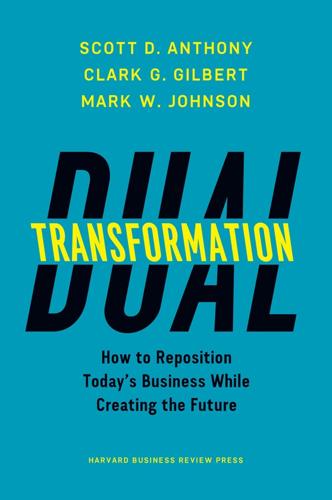
Dual Transformation: How to Reposition Today's Business While Creating the Future
by
Scott D. Anthony
and
Mark W. Johnson
Published 27 Mar 2017
Over the next decade Google invested to further develop the technology behind self-driving cars and to change local regulations to welcome autonomous cars. In 2014 it introduced a new car with no wheels and no pedals. In August 2016, Singapore’s first autonomous taxi debuted on the roads of a cluster of buildings with far-out names like Fusionopolis. Scenes in movies with legions of driverless cars—such as I, Robot and Minority Report—increasingly seem less like science fiction and more like a preview of the next decade. And, of course, that’s to say nothing of the rise of electric vehicles. The rise of self-driving cars will have systemwide effects. Here are examples. Parking consumes significant, and pricey, real estate in urban areas.
…
TABLE AF-1 Disruption by industry Industry Disruptive trends New competitors Growth opportunities Consumer banking Peer-to-peer lending and payments, blockchain Telecommunications companies (e.g., Globe), technology giants Data-driven advisory support for businesses Shipping 3-D printing, drone delivery, smart, connected devices Amazon Real-time tracking, new inventory management services Medical devices Smart, connected devices, customized medicines Apple, IBM, Nestlé Wellness and prevention Automotive Driverless cars, integration of cars and commerce Uber, Apple, Google Transport and logistics services and solutions Professional services Democratized knowledge, platforms, software, artificial intelligence Hourlynerd, LegalZoom Software-enabled complex services Appendix: Dual Transformation Toolkit This appendix presents a set of checklists, discussion guides, and simple analytical models that help you apply key concepts in the book.

Prediction Machines: The Simple Economics of Artificial Intelligence
by
Ajay Agrawal
,
Joshua Gans
and
Avi Goldfarb
Published 16 Apr 2018
However, the former improvement means that mistakes fall by one-third, whereas the latter means mistakes fall by a factor of twenty. In some settings, mistakes falling by a factor of twenty is transformational. The seemingly mundane process of filling in missing information can make prediction machines seem magical. This has already happened as machines see (object recognition), navigate (driverless cars), and translate. 4 Why It’s Called Intelligence In 1956, a group of scholars met at Dartmouth College in New Hampshire to map out a research path to artificial intelligence. They wanted to see if computers could be programmed to engage in cognitive thought, things like playing games, proving mathematical theorems, and the like.
…
The tasks most likely to be fully automated first are the ones for which full automation delivers the highest returns. These include tasks where: (1) the other elements are already automated except for prediction (e.g., mining); (2) the returns to speed of action in response to prediction are high (e.g., driverless cars); and (3) the returns to reduced waiting time for predictions are high (e.g., space exploration). An important distinction between autonomous vehicles operating on a city street versus those in a mine site is that the former generates significant externalities while the latter does not. Autonomous vehicles operating on a city street may cause an accident that incurs costs borne by individuals external to the decision maker.
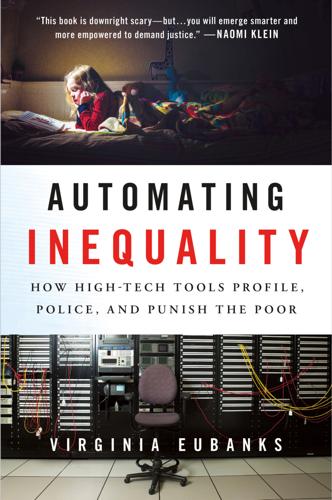
Automating Inequality
by
Virginia Eubanks
Then, managers and technocrats hire economists and engineers to build more “objective” systems to root out the human foibles of their economic inferiors. The classism and racism of elites are math-washed, neutralized by technological mystification and data-based hocus-pocus. I spent much of my November 2016 trip to Pittsburgh trying to spy one of Uber’s famous driverless cars. I didn’t have any luck because the cars are found mostly downtown and in the Strip District, neighborhoods that are gentrifying quickly. I spent my time in Duquesne, Wilkinsburg, the Hill District, and Homestead. I didn’t see a single one. The autonomous cars use a vast store of geospatial data collected from Uber’s human drivers and a two-person team of onboard engineers to learn how to get around the city and interact with other vehicles, bikes, and pedestrians.
…
See automated decision making; predictive risk models digital poorhouse and class and criminalization and discrimination dismantling the and diversion from public resources effects of and equity eternality of and “fear of falling” as hard to understand intractability of National Welfare Rights Organization (NWRO) novel aspects of origins of and politics and prediction of future behavior scalability of and self-interest and values discretion of caseworkers in decision-making discrimination and child welfare and cultural denial and digital poorhouse and public assistance rational and reverse redlining and welfare reform disinvestment in neighborhoods in social service programs disproportionality in child welfare decisions disruptive innovation Dogon, General Dreyer, David driverless cars drug and alcohol abuse Drug and Alcohol Services drug and alcohol treatment drug testing Du Bois, W.E.B. due process Dunham, Calvin B. EBT. See electronic benefits transfer economic depression of 1819 of 1873 economic violence Edin, Kathryn J. Ehrenreich, Barbara electronic benefits transfer (EBT) Electronic Data Systems eligibility rules “employable mother” rules “man in house” rules “substitute father” rules “suitable home” rules empathy “employable mother” rules.

The Future of the Professions: How Technology Will Transform the Work of Human Experts
by
Richard Susskind
and
Daniel Susskind
Published 24 Aug 2015
This is what we call liberalizing ‘latent demand’ (see the discussion later in this section). It also seems that recipients of traditional professional service who belong to the Internet generation are migrating to online self-help because it is more convenient, less costly, and more readily understandable. In the longer term, though, just as we are coming to terms with the idea of driverless cars, so too we will feel comfortable with the concept of teacherless students, doctorless patients, lawyerless clients, consultantless businesses, clergyless parishioners, and so forth.22 Personalization and mass customization One of the fears of professionals is that the routinization and digitization of professional work really means the imposition of inflexible, standardized answers on a wide range of problems.
…
Glasgow Herald, 18 Nov.1985, p. 15. 17 <http://www.ey.com> (accessed 23 March 2015). 18 Atul Gawande, The Checklist Manifesto (2010), 34. 19 Gawande, The Checklist Manifesto, 36. 20 See Yochai Benkler, The Wealth of Networks—How Social Production Transforms Markets and Freedom (2006). 21 <http://www.tripadvisor.co.uk>. 22 See Eric Topol, The Patient Will See You Now (2015), on driverless cars and doctorless patients. 23 Penelope Eckert, ‘Communities of Practice’, in The Encyclopedia of Language and Linguistics, ed. Keith Brown (2006). 24 James Surowiecki, The Wisdom of Crowds (2004). 25 See e.g. David Maister, Managing the Professional Service Firm (1993). 26 See e.g. the Sarbanes–Oxley Act of 2002 in the USA (n. 15 above). 27 Directive 2014/56/EU of the European Parliament and of the Council of 16 April 2014 amending Directive 2006/43/EC on statutory audits of annual accounts and consolidated accounts. 28 With original emphasis, from Herbert L.
…
In ten years robots have moved ‘from making cars to driving them’.55 By 2014, Google’s vehicles had travelled almost 700,000 miles, with only one incident (said to be caused by a car driven by a human being). In the United States legislation has been passed in four states and in Washington, DC, allowing driverless cars.56 By 2020 most major car manufacturers also expect to be selling autonomous vehicles. Our guess is that, in due course, people will look back with incredulity and say, ‘it’s amazing people actually used to drive cars’. Other illustrations of advanced robotics abound. Every year, in manufacturing, an additional 200,000 industrial robots are installed (adding to an expected total of 1.5 million robots in 2015).57 In 2014, for example, Amazon had more than 15,000 robots in ten of its warehouses.
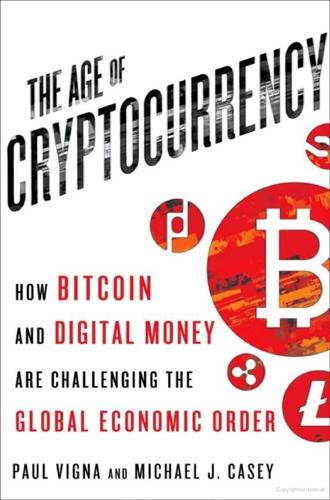
The Age of Cryptocurrency: How Bitcoin and Digital Money Are Challenging the Global Economic Order
by
Paul Vigna
and
Michael J. Casey
Published 27 Jan 2015
He used the example of a driverless taxi, one guided only by sensors and GPS technology. The one-car taxi service would be run by a smart software program plugged into an automated, electronic marketplace Hearn dubbed the Tradenet. There, prospective passengers could post ride requests and receive competing bids from multiple driverless cars. They would choose their preferred taxi based on fare, travel time, and model of car and could negotiate the route based on durations and fares that the service derived by bidding in a separate Tradenet “load space” market, where variations in traffic conditions would offer differing market-based toll-road prices for each route.
…
Because we could program it to provide the cheapest and most efficient service possible, Hearn’s car would be focused on maximizing productivity and surviving, not building up a fat pile of retained earnings to spend on McMansions and trips to the Bahamas. It could keep its profit margins superthin and its prices low. That said, if it brought in more revenue than expenses, the car could be programmed to “have children,” as Hearn puts it, investing its excess bitcoins in new driverless cars that would “inherit” a clone of its software program. To stay ahead of the game the car could also spend its surplus by hiring a human to write it a superior code—after seeking bids for these services via the Tradenet—and then apply special testing protocols to ensure the human isn’t scamming it out of its competitiveness.
…
The societal profit we all share from having more services abundantly available at low prices should be self-evident, but what incentive is there for profit-motivated individuals to invest in providing them? One option is to have governments direct this effort, applying taxpayer money. Another is to hope that philanthropists pick up the challenge. Ideally, though, the investment would come as a community effort. Perhaps residents of a particular neighborhood could invest in a driverless car and be rewarded with free or discounted rides for a prescribed period, and to achieve that kind of broad-based funding objective, Hearn offers up another solution: cryptocurrency assurance contracts, a blockchain-based version of the popular crowdfunding model in which organizers pledge a certain amount when others’ donations reach target levels.
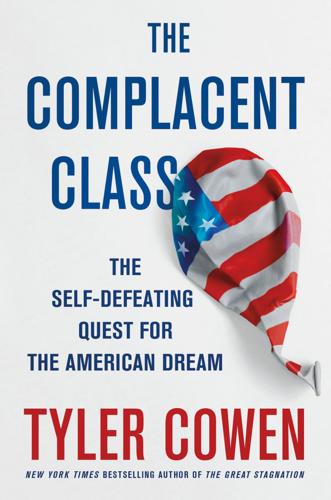
The Complacent Class: The Self-Defeating Quest for the American Dream
by
Tyler Cowen
Published 27 Feb 2017
Furthermore, there has been a migration of Millennials into larger cities, where Uber, bike lanes, and car-sharing services make owning one’s own vehicle less important. Cruising, or taking the proverbial joy ride, just isn’t that big a deal anymore, and each year the Americans who do have cars are driving fewer miles with them. America’s future is likely to bring a much greater use of driverless cars, which will be a major gain in terms of safety and convenience. But just think of the reorientation in terms of cultural and emotional significance: It will be the cars controlling us rather than vice versa. The driver of the American car used to drive an entire economy, but now the driver will be passive, and what will the culture become?
…
In chapter 4, I discussed how more and more of the top talent is being clustered in the largest and most successful firms. America’s productivity problem is coming from small and medium-size enterprises, not the market leaders. Probably not all of Google’s ideas will work out, but still, the company isn’t just search. Gmail is pretty useful, YouTube is running and has been significantly upgraded, driverless cars and trucks seem to be on the horizon, and someday a version of Google Glass may even change our lives, even if Google Glass as we know it remains stillborn. What is happening is that technology has made it easier for better corporations to identify those workers with stronger skills, more demanding work ethics, and higher intelligence, and vice versa.

Vassal State
by
Angus Hanton
Published 25 Mar 2024
Despite lack of profitability, Uber and Lyft have poured billions of dollars into research-and-development projects such as driverless cars. Larger firms, meanwhile, push to buy up potential competitors and out-innovate their rivals to create unassailable market positions. In the past decade, Facebook decided to out-compete social media rival Snapchat by buying and rebuilding Instagram. Tesla, while selling electric vehicles more successfully than other car manufacturers, is also developing driverless systems. It is diversifying further, pledging to parlay its driverless-car research into developing a humanoid robot – called ‘Optimus’ or the ‘Tesla Bot’.

Terms of Service: Social Media and the Price of Constant Connection
by
Jacob Silverman
Published 17 Mar 2015
(It probably was no coincidence that Hayes’s confusion had come from reading a Kindle Single—long pieces, generally 10,000 words or more, that take time to read and that are frequently strip-mined by third-party aggregators, who take the juiciest bits and present them as top 10 lists. Who has time to read all that?) The rush to be first can produce some pretty obvious blunders. When TechCrunch published a story with an enticing headline—“Dispatch from the Future: Uber to Purchase 2,500 Driverless Cars from Google”—other publications went nuts. No matter that the story carried a dateline from the year 2023, or that TechCrunch had published cheeky, fictional stories before, or that no other outlet had reported the news. It was picked up everywhere, from small design blogs to the Daily Mail, the world’s most popular online newspaper, which later deleted its story.
…
In most of these cases, corrections are played down or not done at all. Stories may quietly disappear. Sometimes, as with the Daily Beast’s Booker nonstory, they become an opportunity to write another story in response to the initial one, thereby wringing multiple articles, and even more page views, out of the invented controversy. Around the same time that the driverless car story ran, Forbes published a story claiming that the Houston Astros, then mired in last place, were Major League Baseball’s most profitable baseball team. But the story’s main premise was wrong and it was filled with numerous other errors, causing another Forbes contributor to publish his own article refuting it.
…
Aug. 4, 2013. washingtonpost.com/blogs/wonkblog/wp/2013/08/04/obama-is-wrong-traditional-journalism-isnt-dead. 106 Washington Post correction: ibid. 106 Wonkblog retraction: Will Oremus. “Why Bloggers Fell for a Fake TechCrunch Story about Self-Driving Cars.” Slate. Aug. 27, 2013. slate.com/blogs/future_tense/2013/08/27/uber_google_and_driverless_cars_fake_techcrunch_story_widely_reported_as.html. 107 “the trouble of figuring out”: ibid. 107 “it all depends”: Dan Alexander. “Can Houston Astros Really Be Losing Money Despite Rock-Bottom Payroll?” Forbes. Aug. 29, 2013. forbes.com/sites/danalexander/2013/08/29/can-houston-astros-really-be-losing-money-despite-rock-bottom-payroll. 109 “Some of this is on you”: Alex Goldman.

Capitalism in America: A History
by
Adrian Wooldridge
and
Alan Greenspan
Published 15 Oct 2018
Today the United States is the world’s biggest economy: a mere 5 percent of the world’s population, it produces a quarter of its GDP expressed in U.S. dollars. America has the world’s highest standard of living apart from a handful of much smaller countries such as Qatar and Norway. It also dominates the industries that are inventing the future—intelligent robots, driverless cars, and life-extending drugs. America’s share of the world’s patents has increased from 10 percent when Ronald Reagan was elected in 1980 to 20 percent today. The American economy is as diverse as it is huge. The United States leads the world in a wide range of industries—natural resources as well as information technology, paper, and pulp as well as biotechnology.
…
The IT revolution is touching ever more aspects of daily life. iPhones can do the work of thousands: they can help you find where you want to go, act as virtual secretaries, organize your book and newspaper collections. Uber uses information to revolutionize the taxi business. Airbnb uses it to revolutionize the hotel business. Amazon allows us to order from a vast virtual catalogue and have the goods delivered within a few days or even a few hours. Morgan Stanley estimates that driverless cars could result in $507 billion a year of productivity gains in America, mainly from people being able to stare at their laptops instead of at the road. The IT revolution provides a chance of extending to the service sector the sort of productivity gains that we are used to in the manufacturing sector.
…
And it is doing a better job of preserving its share of global GDP than is Europe. China also shows no signs of replacing the United States as the pacesetter of the global economy. America leads in all the industries that are inventing the future, such as artificial intelligence, robotics, driverless cars, and, indeed, finance. And for all its problems with populism, America has something precious that China lacks: a stable political regime that both constrains the power of the president and allows for the successful transition of power from one leader to the next. So far there are no tales of American billionaires buying escape-hatch homes in Shanghai or Beijing.
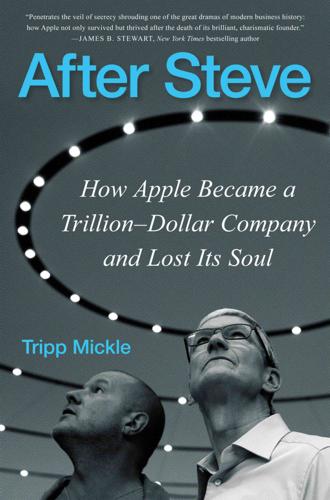
After Steve: How Apple Became a Trillion-Dollar Company and Lost Its Soul
by
Tripp Mickle
Published 2 May 2022
His vision differed from: Daisuke Wakabayashi, “Apple Scales Back Its Ambitions for a Self-Driving Car,” New York Times, August 22, 2017, https://www.nytimes.com/2017/08/22/technology/apple-self-driving-car.html. As the debate simmered: Jack Nicas, “Apple, Spurned by Others, Signs Deal with Volkswagen for Driverless Car,” New York Times, May 23, 2018, https://www.nytimes.com/2018/05/23/technology/apple-bmw-mercedes-volkswagen-driverless-cars.html. Outside, an actor performed as Siri: Aaron Tilley and Wayne Ma, “Before Departure, Apple’s Ive Faded from View,” The Information, June 27, 2019, https://www.theinformation.com/articles/before-departure-apples-jony-ive-faded-from-view.
…
The public expected the company to continue inventing products that were transformative and new, lest it risk entering a period of stagnation or, worse, irrelevancy. For Cook, the pressure was unrelenting. Chapter 17 Hawaii Days Jony Ive arrived in Sunnyvale for a scheduled review of a car project stuck in neutral. It was early 2016, and he quickly grew agitated at the lack of progress. Software development for the fully driverless car he had imagined was lagging behind because of a lack of data and the complexity of building an autonomous system from the ground up. The hardware effort was making progress but trailing the company’s ambitious timeline. There was no way a fully autonomous car would be ready by the self-imposed deadline of 2019.

The Land of Hope and Fear: Israel's Battle for Its Inner Soul
by
Isabel Kershner
Published 16 May 2023
Instead, the digital renaissance had underscored—even exacerbated—the socioeconomic gaps in Israeli society, further distinguishing the more educated, affluent, liberal, and secular population of the notional “state of Tel Aviv” from the periphery. Still, it was all a far cry from the country that, in the late 1950s, had manufactured the ill-fated Susita, a fiberglass-shelled car with a British-made engine that was decried as a plastic death trap and derided as a snack for camels. The new Israel was a world leader in driverless car technology. It appeared that the kind of optical, radar, sonar, and sensor systems used to detect incoming missiles and to guide tanks proved useful for scanning roads for dangerous obstacles. In 2017, Intel spent $15.3 billion on Mobileye, a Jerusalem-based autonomous vehicle tech company led by Amnon Shashua, a Hebrew University professor, in what then constituted the biggest acquisition in Israel’s high-tech industry.
…
W., 281 C Café Albi, 69–70, 72 Café Paula, 109 cannabis, 21 Cave of the Patriarchs, 24 Cellebrite, 314 Central Bureau of Statistics, 304, 307 Cherkassky-Nnadi, Zoya, 290–92, 343 chickpeas, 318, 320 Christians, 141, 179, 185, 197, 242, 274 Ethiopians and, 324, 325, 335, 342 Evangelical, 128, 131–32 Restorationist, 169 Christmas, 277, 278 Chromatis, 306 Chwierut, Janusz, 46 Circassians, 158, 179, 242 Climate group, 45 Cohen, Israel, 226–28, 237 Cohen, Shmuel Eliyahu, 224 communism, 87, 100, 277 coral, 14–16, 28 CoreBone, 15 coronavirus pandemic, 26, 27, 81, 93, 112, 159, 167, 168, 298, 304, 308, 311, 314, 317, 321, 341–43 Haredi and, 201, 202, 213–21, 223, 236 Coronet, 315, 316, 320–21 crime, 186–90 CyberArk, 306 Cyprus, 274, 281 D Dadon family, 162 Dahamshe Mosque, 163 Damri, Yael, 136 Damri, Yochai, 136–39 Dan, tribe of, 324, 325 Darawshe, Mohammad, 193 Darwish, Mahmoud, 196 date palms, 319 Davar, 102 Dawabsheh family, 141–42 Dayan, Moshe, 84, 269 Dead Sea, 6, 7 Degania Aleph, 100, 107 Degel HaTorah, 203 Deir Yassin, 56 Dekel, Hannah, 252–53 Dekel, Yaron, 72–73 Deri, Aryeh, 90, 215 Deri, David, 78–81 development towns, 78–82, 93 Diaspora Museum, 279 Dikla, 73 Dimona, 8, 9, 80–82 Dolgopyat, Artem, 294 Dolphinarium, 289–90 Dome of the Rock, 142, 323 Dorfman, Yevgenia, 289–90 Dosh, 44 driverless cars, 299 Druze, 158, 179–80, 185, 242, 303 Dubai, 144, 296–98, 304, 313, 315–21 Duda, Andrzej, 13 Duke, David, 14 Duma, 141, 142 E Edelstein, Gershon, 219 Edelstein, Yuli, 96, 288 education, 75, 80–81, 166–68, 304, 306, 307 Bedouin and, 311–12 Haredi and, 90, 204–5, 208, 211, 227–30, 234, 237–38, 304 women and, 197, 230, 234, 238 Egypt, 18, 23, 46, 63, 243, 251, 262, 264, 265, 313, 316–17, 319, 321 Eichmann, Adolf, 41, 42, 55, 56 Eilat, 7–9, 327 Ein Gev, 115 Einstein, Arik, 70 Ein Yahav, 5–11, 14, 19–23, 26–28, 29 Eisenkot, Gadi, 257 Eizenman, Julia, 280 El Al, 39, 305 elections, 17–18, 66, 82–90, 96, 108, 149, 171–72, 178, 181, 185 Haredi and, 201, 203, 207, 218–19, 228 Russians and, 282–84 Eliav, Aryeh, 79 El Mal, 169, 170, 172, 178 Elmaleh, Khen, 69–75 Elmaleh, Ohad, 70 engineers, 273, 295, 298, 300–302, 307, 308, 311 Erdan, Gilad, 96 Eretz Nehederet, 285, 289 Eshel, Amir, 244 Esh Kodesh, 120–21, 124–28, 131–33, 141, 142, 144, 149 Ethiopian immigrants, 37, 64, 81, 94, 161, 164, 307, 322–44 airlifts of, 326, 328, 342–44 Christianity and, 324, 325, 335, 342 in criminal justice system, 332–33 Jerusalem and, 322–23, 326, 327, 340 Jewish status of, 324, 325, 328, 334–35, 340 kessim, 322, 328, 337, 340, 343 marriage and, 328, 333, 335 musicians, 341 police and, 329–38 poverty among, 335 protests and riots by, 329–35, 340, 342 racism against, 324, 328–31, 332–34, 336, 337, 339, 340, 343 Sigd holiday of, 322–23, 327, 328 Ettinger, Meir, 142 Etzel Museum, 31, 181 Etzion bloc, 134 Evyatar, 144–45 exits (mergers and acquisitions or initial public offerings), 110, 298, 299, 308, 314 F Familia, La, 40–41, 156 Farber, Clara, 200 Farber, Yanki, 200–201, 203–4, 208, 210–12, 214, 216, 221, 227, 237 Fauda, 193 fedayeen, 7–8 Feinstein, Meir, 85–86 fertility rates, 197, 201, 207, 304, 308 Fikadey, Demas, 329–32, 340 First Israel, 64, 92, 93, 97 fish farming, 21, 61, 112 Flags over the Warsaw Ghetto (Arens), 38 Floyd, George, 193, 334 Fogel family, 140 Forbes, 69 Forbes Midas List, 305 Frank, Zvi, 102 Frankfort-Smith, Elisheva, 196 Free the Asi campaign, 61, 62, 65, 66, 96–97 Frei, Danny, 147 Friends of Itamar, 141 G Gabbay, Avi, 87–89 Galilee, 67, 157, 158, 169, 172, 173, 184 Galili, Lily, 282 Gantz, Benny, 183, 263, 266–67 Garbuz, Yair, 86, 89–91 Gardosh, Kariel, 43–44 Garin Torani movement, 160–61, 163–65 Gattegno, Iris, 91–92 Gavrieli, Matanya, 139 gay and LGBTQ communities, 184, 185, 226, 229, 252 Gaydamak, Arcadi, 40 Gaza, 11, 18, 22, 23, 82–84, 91, 111, 124, 129, 145, 156, 165, 175–77, 180, 243, 246–47, 255, 259, 267, 269, 289, 303, 304, 313, 320 Israeli withdrawal from, 150–51, 259 Mengistu in, 330–31, 338–39 2014 war in, 83, 111, 243, 260, 302, 336, 338 Geffen, Aviv, 220 Geneva Conventions, 128 Gesher Theater, 289 Getahun, Zion, 339–40 Ghetto Fighters’ House, 42, 47 Gilboa prison, 176, 177 Gilmore, Esh Kodesh, 124 Givatayim, 30, 35 Givat Halfon Eina Ona, 251 Glazer, Shlomo, 61–63 Golan, Eyal, 69, 71, 73 Golan Heights, 18, 88, 122 Goldbach, Tamar, 117–18 Goldberg, Elazar, 224 Goldin, Hadar, 339 Goldsmith, Leah, 141 Goldsmith, Moshe, 140–41, 143 Goldstein, Baruch, 24, 148 Goldstein, Bat-El and Yonatan, 75 Gottex, 43 Gottlieb, Lea, 43 Gouri, Aliza, 47–53, 57–58 Gouri, Gila, 48, 49 Gouri, Haim, 47–59, 83, 135, 157, 244 Ben-Gurion’s letter to, 55–57 death of, 58–59 Gouri, Israel, 48 Great March of Return, 84 Great Rift Valley, 28 Greenbaum, Avraham Dov, 209 Green Line, 135, 176, 281–83 Grossman, David, 255 Gulf War, 211, 218, 281 gun violence, 186–90 Gush Emunim, 54, 134–35 Gvaot Olam, 126 H Haaretz, 41, 46, 87, 104, 110, 223, 282 Haber, Avi, 103 Haber, Shoshana, 102–5, 112 HaCohen, Akiva, 131, 139 Hadad, Perah, 65, 96 Hadash, 181, 182 HaDerech, 209 Hadid, Gigi and Bella, 130 Haganah, 29, 32, 36–38, 44, 115, 194, 243 Palmach, see Palmach Hagee, John, 132 Haifa, 25, 67, 98, 103, 157, 181, 344 Haifa University, 171 Halevi, Tzahi, 193 Hall of Remembrance, 18, 19 Hamad, Maryam Hassan Abd al-Karim, 151 Hamas, 24, 82–84, 91, 124, 156, 176, 243, 246–47, 255, 269, 289, 314 Mengistu and, 330–31, 339 Hamed, Atallah Abd al-Hafez, 151–52 Hamevaser, 210 Haredi (ultra-Orthodox Jews), 16–17, 26, 61, 74, 87, 90, 95, 123, 166, 169, 185, 200–239, 267, 285, 292, 303, 304, 313 coronavirus pandemic and, 201, 202, 213–21, 223, 236 departures from community of, 220–21 economic system of, 232 education and, 90, 204–5, 208, 211, 227–30, 234, 237–38, 304 elections and, 201, 203, 207, 218–19, 228 Gulf War and, 211, 218 Internet and, 202, 209–10, 217–20, 224, 232, 234, 237 military and, 201, 205–8, 210–12, 215–17, 235, 238, 239, 242, 245, 249–51, 253, 261, 266, 267 Mount Meron disaster and, 222–26, 229 Netanyahu and, 87, 201–2, 206–7, 214, 226–28 New, 238–39 in popular culture, 221–22 population growth of, 207, 239, 242, 249 Russians and, 273 sexual abuse and harassment among, 233, 235–38 tech and, 307, 313 women, 207–10, 213, 219, 227, 229–35, 238, 307 “HaReut” (Gouri), 53, 58 Harman, Juta, 38 Harmel, Kristin, 221 Harris, Tahel, 162 Hasan, Roy, 72 Hasdei Amram, 217 Hashomer, 36 Hasidim, 202, 203, 210, 225, 231 see also Haredi Haskel, Amir, 27 Hassouneh, Mousa, 156–57, 164–65 Hatzerim, 9 Hauser, Zvi, 93 Hawara, 140 Al-Hawashleh, Rabaa, 309–12 Haza, Ofra, 69 Hebrew Labor, 20 Hebrew language, 16, 17, 27, 36, 37, 48, 72, 74, 75, 80, 166, 168, 177–78, 205, 271, 317, 335 Hebron, 24, 37, 122, 134–36, 142, 148, 256 Heilbronn, Avigayil, 231–35, 237–39 Heilbronn, Hananel, 231–33 Heilbronn, Rachel, 231–32, 239 Herut, 55 Herzliya, 15, 45 Herzog, Isaac, 86, 255, 343 Hezbollah, 243, 246 hijacking plot, 286–87 Hijazi, Ahmad, 186 hilulah, and Mount Meron disaster, 222–26, 229 al-Hinawi, Shirin, 163 Hitler, Adolf, 36, 38, 55, 56, 62, 103 Hogeg, Moshe, 40–41 Holocaust, 38, 41–43, 45, 47, 55, 78, 80, 244, 293, 300 Haredi and, 203–5 Holocaust survivors, 25, 29, 30, 36, 41–47, 52, 55, 65, 111, 158, 195, 244, 294, 327, 335 reparations for, 55, 74–75, 104–5, 113 homicides, 186–90 Hujayrat, Ammar, 190 human rights organizations, 95, 123–24, 133, 144, 149, 256, 257, 259 al-Huzayel, Laila, 192 I “I Am a Civil War” (Gouri), 47–49 Ibn Sina (Avicenna), 167 Ibrahimi Mosque, 24 ICQ, 299, 300 Ifargan, Yaacov, 91 immigration, immigrants, 304, 334, 341–42 Arab Revolt against, 101 development towns and, 78–82, 93 Ethiopian, see Ethiopian immigrants illegal, 102 kibbutzim and, 102, 107, 108 Law of Return and, 36–37, 180–81, 272, 274, 295, 324, 342, 343 Lithuanian, 203, 204, 214, 219–20, 227–29 Nation State Law and, 179 Russian, see Russian immigrants Im Tirzu, 259 Independence Day, 156, 161, 217, 236, 238, 253, 254, 345 Innovation Authority, 303, 307 InnovoPro, 318, 320 Intel Israel, 311, 312 Internet, 299, 300, 309 Haredi and, 202, 209–10, 217–20, 224, 232, 234, 237 In the Tunnel, 289 intifadas First, 11, 182, 246, 282 knife, 235, 256, 257 Second, 24, 51, 86, 175, 176, 243, 246, 248, 289, 305 Iran, 68, 87, 143, 176, 243, 247, 298–99, 314, 315, 316 nuclear program of, 12, 16, 189, 246, 298 Iraq, 211, 218 Irgun, 29–34, 37–40, 56, 85 Iron Beam, 247 Iron Dome, 88, 247 Islam, 179 see also Muslims Islamic Jihad, 24, 176 Islamic Movement, 195 Israel Advanced Technology Industries, 307 Israel Defense Forces (IDF), 29, 31–36, 39, 109, 145, 147, 174, 180, 188, 222, 240–69, 310, 336, 345 Air Force, 244, 261, 308 alleged brutality and lack of accountability in, 259 Azaria affair and, 256–59, 268 Bahad 1, 240–41, 243, 244, 264 Ben-Gurion and, 31, 33, 34, 241, 242, 244–45, 260 Caracal Battalion, 263–65 draft and mandatory service in, 10, 205, 207, 208, 210–12, 215, 239, 241–43, 245, 249, 251–52, 260, 266, 267 ethical code of, 256–57, 266 Haredi and, 201, 205–8, 210–12, 215–17, 235, 238, 239, 242, 245, 249–51, 253, 261, 266, 267 Irgun and, 31–33 Kirel in, 253–54 in Lebanon, 243, 246 Mamram, 300, 315 modern Orthodox and, 260, 265 Netanyahu and, 240 as People’s Army, 241, 251, 266, 267, 269, 299 professional volunteer force proposals and, 249–50, 266 public relations campaign of, 252–53 public rituals around, 254–55 reserve duty in, 251 Russian immigrants in, 251–52, 276, 277, 279–80, 293 selective objection and, 260 Shalit incident and, 255–56 Shmueli incident and, 267–69 Talpiot program, 300 tech and, 298, 300–303 Unit 81, 300 Unit 8200, 300, 301, 319 in West Bank, 243, 244, 246–48, 264 women in, 242, 245, 249–51, 261–66, 303 Israel Democracy Institute, 249, 257 Israel Hayom, 94, 110 Israeli Black Panther movement, 67, 70, 72–74, 182, 334 Israeli Declaration of Independence, 26, 31, 158, 179, 198, 232 Israel Innovation Authority, 303, 307 Israel Museum, 45 Cherkassky exhibition at, 290–92 Israel Prize, 236, 254–55 Israel Women’s Network, 250 Itamar, 140, 141, 143 J Jabali, Saad, 188–89 Jabali, Watfa, 188–89 Jabotinsky, Ze’ev, 30, 31, 34, 36–38, 40, 58, 93, 179, 183 Jaffa, 157, 160, 170, 181, 187 Jalud, 126 Jeffress, Robert, 132 Jenin, 211, 258 Jeremiah, 127, 148 Jericho, 6 Jerusalem, 6, 25, 32, 37, 45, 122, 134, 142, 144, 156, 168, 306 Armon Hanatziv neighborhood of, 322–23 Dome of the Rock in, 142, 323 East, 139, 175, 282, 304 Ethiopians and, 322–23, 326, 327, 340 Hass Promenade in, 322–23, 327 Margalit Startup City in, 297, 306 Mea Shearim neighborhood of, 202, 205, 211, 216–17, 221, 230, 235 Mount Herzl in, 18, 86, 345 Old City in, 18, 23, 48, 50, 53–54, 74, 156, 211, 316, 322, 323 siege of, 50–53, 59 Temple Mount (Noble Sanctuary) in, 54, 195, 323 U.S. embassy in, 128, 132 West, 24 Western Wall in, 170, 211, 226 Zion Square in, 55 Jerusalem corridor, 51, 52 Jerusalem Day, 156 Jerusalem Faction, 212 Jewish Agency, 79, 94, 290, 342, 343 Jewish National Fund, 194, 199 Jewish Nation State Law, 41, 178–80, 198 Jisr al-Zarqa, 115, 119 Joint List, 179, 181–85 Jordan, 7, 10, 18, 63, 134, 194, 313, 316–17 Israel’s border with, 5, 6, 8, 9, 243, 262 Jordan Valley, 122, 134, 146, 148, 149 Joshua, 127, 141, 213 Judea, 135, 139 JVP, 296, 305, 306, 313, 317–18, 320 K Kachlili, Ron, 72 Kadima, 96 Kahane, Meir, 142, 148 KamaTech, 307 Kaminitz Law, 180, 186 Kanievsky, Chaim, 214, 215, 218, 219 Kantor, Itzik, 112 Kashua, Sayed, 159 Katsav, Moshe, 64, 94 Katsof, Aaron, 131–33, 139, 142, 144, 149 Katz, Israel, 96 Kaufman, Mendel, 30 Kedumim, 21 Keissar, Adi, 72 kessim, 322, 328, 337, 340, 343 Kfar Etzion, 134 Kfar Vitkin, 33 Kfir Brigade, 211 Khaldi, Ishmael, 193 Khomeini, Ayatollah Ruhollah, 68 kibbutzim, 17, 98–119, 121, 221, 246–47, 287 Begin and, 107–8 children in, 103–4, 106, 114, 116, 117, 119 decline of, 106–7, 117 Degania Aleph, 100, 107 Hatzerim, 9 immigrants and, 102, 107, 108 industry and, 107, 108, 110–14 Kibbutz Movement and, 106–8, 112 Kvutzat Shiller, 107 Lohamei HaGetaot, 38, 41–42, 110–11, 261 Maagan Michael, 100, 103, 106, 110, 112–17, 119 Maayan Zvi, 98–105, 111–13, 115–19 Megiddo, 199 Nahal Oz, 84, 111, 269 Nir David, 61–66, 83, 85, 95–97, 101, 107, 108 Peres and, 108 privatization of, 100, 101, 106, 107, 115, 117–19 “renewed,” 106 revival of, 101, 111, 132 Sde Boker, 25, 108–10 Kibbutznikim, 119 Kikar HaShabbat, 209, 219 King David Hotel, 56 Kingsley, Patrick, 268 Kippat Barzel, 222 Kirel, Noa, 253–54 Kiryat Arba, 122 Kiryat Gat, 312 Kiryat Malachi, 275, 276, 326–27, 329 Kiryat Moshe, 335–37 Kiryat Shemona, 161, 306, 313 Klagsbald, Shmuel Zvi, 224 Knesset, 14, 18, 23, 27, 48, 55, 56, 58, 76, 88–90, 107, 171, 178, 179, 181–84, 188, 230, 255, 262, 282, 288, 306, 328, 329, 341 Knesset Research Center, 81 knife intifada, 235, 256, 257 Knipsel, Gershon, 174 Kochavi, Aviv, 269, 345 Kollek, Teddy, 305–6 Korkevados, Yoram, 93 kosher laws, 20–21, 204, 208, 212, 218, 229, 249, 277, 278, 317, 335 al-Krenawi, Talal, 192 Kupat Ha’ir, 219 Kushner, Jared, 143 Kvutzat Shiller, 107 L Labor Party, 23, 24, 58, 66, 74, 85–89, 95, 122, 134, 282, 288, 295, 306, 325 Labor Zionism, 6, 7, 12, 20, 30, 34, 54, 56 Lag ba’Omer, and Mount Meron disaster, 222–26, 229 LaMerhav, 55 Land Day, 170–72, 174, 178, 182 Land of Israel Movement, 54 Lapardin, Ira, 271 Lapid, Yair, 202, 208, 212, 228, 267, 286, 346 Lavi fighter jet, 301 Law of Return, 36–37, 180–81, 272, 274, 295, 324, 342, 343 League of Nations, 169 Lebanon, 18–19, 161, 180, 243, 246, 298, 313, 319 Lehava, 192–93 Lehi, 37, 38, 85 Leifer, Malka, 213 Levinger, Moshe, 122 Levinstein, Yigal, 265 Levy, David, 63–64 Levy, Edmund, 148 Levy, Yagil, 248–49, 262 LGBTQ communities, 184, 185, 226, 229, 252 Liberman, Avigdor, 228, 258, 267, 283–86, 288 Likud, 17, 23, 26, 30, 38, 40, 55, 56, 61, 64, 66, 69, 75, 80–89, 92–97, 122, 135, 143, 148, 204, 206, 219, 282–84, 288, 343 Lilay, Tamar, 327 Lipa, Dua, 130 Lithuanian immigrants, 203, 204, 214, 219–20, 227–29 Litzman, Yaakov, 213–15 Livni, Tzipi, 89 Liwer, Dror, 315–16, 320–21 Lod, 155–70, 175 HaRakevet neighborhood of, 165–67 Ramat Eshkol neighborhood of, 155–56, 159–61, 163 Lohamei HaGetaot, 38, 41–42, 110–11, 261 Lo Tishtok movement, 235 Lubetkin, Zivia, 261 Lydda, 160 M Maagan Michael, 100, 103, 106, 110, 112–17, 119 Maaleh Michmash, 146–48 Maayan Zvi, 98–105, 111–13, 115–19 al-Mabhouh, Mahmoud, 314 Madar, Erez, 94 Magen, 235 Malach, Nir, 330 Malachi, Kiryat, 94–95 Malassa, Eli, 329 Malcolm X, 70, 182–83 Mamram, 300, 315 Mapai, 34, 39, 48, 55, 56, 58, 67, 83, 86, 135 Margalit, Erel, 296–98, 305–6, 313, 319 Margalit Startup Cities, 297, 306 marijuana, 21 Mark, Michael “Miki,” 137 Markovitz, Yitzhak, 217 marriage, 274–75, 280–81, 293, 294, 328, 333, 335 Masada, 6 MasterChef, 153 Matlon, Shlomo, 224 May 2021 outbreak of violence, 156, 189–90, 193, 199 Megiddo, 199 Meidan, David, 313–14 Meir, Dafna, 137 Meir, Golda, 67 Meir, Nir, 106–8, 112 Meiri, Lavi, 63–65, 97 Memorial Day, 62, 156, 168, 217, 238, 254, 255, 346 Mendelsohn, Amitai, 291 Mendelsohn-Lessel, Adam, 280 Mengistu, Avera, 330–31, 338–39 Meprolight, 113 Meretz, 66, 74, 145, 185 Mergui, Jonathan, 253 Merkel, Angela, 210 Meshi-Zahav, Yehuda, 235–37 Message for Peace, 319 #MeToo movement, 235 Migdalim, 125 millennials, outpost, 120–54 Miller, Alice, 261 Million Lobby, 294 Million That Changed the Middle East, The (Galili and Bronfman), 282 Mimouna, 64 Ministry of Economy, 311 Mirabilis, 299, 300, 305 Mitzna, Amram, 81 Mitzpe Danny, 146–48 Mitzpe Ramon, 81 Mizrahi Democratic Rainbow, 65–66 Mizrahi Jews, 10, 37, 56, 58, 60–69, 71, 73–78, 80, 81, 83, 85–92, 95, 96, 101, 107, 108, 206, 257, 327, 334 Ars Poetica movement of, 72, 276 musicians, 68–69, 71–73 Netanyahu and, 58, 62, 64, 66, 85 ringworm affair and, 77–78 Yemenite, Mizrahi, and Balkan Children Affair and, 76–77 mobile phones, 218, 232 Mobileye, 299 Modiin Illit, 123, 219 Mohammed bin Rashid Al Maktoum, Sheikh, 315 Morocco, 12, 93, 143, 319 Mossad, 313, 314, 325–26 Mount Hebron Regional Council, 136 Mount Herzl, 18, 86, 345 Mount Meron disaster, 222–26, 229 Mount of Olives, 86, 323 Moyne, Walter Guinness, Lord, 38 Muallem, Uri, 329 murders, 186–90 music, 68–73, 341 Muslims, 24, 40, 54, 83, 156, 158, 160, 173, 174, 177, 179, 181, 185, 192, 195, 197, 242, 274, 304, 317 Sunni, 298–99 mystics, 91 N Nablus, 141 Nachman, Ron, 283 Nachmias, Yafa, 33–35, 39 Nachmias, Yosef “Yoske,” 29–35, 37–40, 83 Nahal, 7, 8, 10, 109, 269 Nahalat Yitzhak Cemetery, 30, 35 Nahal Oz, 84, 111 Nakba, 18, 158, 160, 163, 168, 175, 194–96 Nasraldeen, Lutfi, 180 Nasraldeen, Shadi, 180 National Center for the Development of Holy Sites, 222 National Water Carrier, 9 Nation State Law, 41, 178–80, 198 Natour-Hafi, Muhammad, 167 Natour-Hafi, Shirin, 166–69 Nazareth, 184, 312 Nazis, 36, 38, 43, 101, 102, 239 Nuremberg Laws of, 36, 274 Nazlah, 102 Nechushtan, Taly, 318, 320 Negev, 9, 25, 27, 50, 67, 73, 80, 157, 160, 191, 240, 308, 309, 311 Abu Krinat in, 309–12 Tamar Center in, 311–12 Nehama, Avraham, 34 Neias, 209 Netafim, 9, 111 Netanya, 25 Netanyahu, Benjamin “Bibi,” 3, 4, 12–14, 18, 24, 27, 30, 41, 61, 66, 80, 82, 88, 90–94, 96, 110, 128, 143, 146, 183, 186, 224, 256, 267, 283, 284, 293, 296, 305, 321, 346 Altalena and, 35 Arab community and, 171–72, 178, 179, 185 Azaria family and, 258 corruption allegations against, 13, 92, 93 Ethiopian community and, 331, 342, 343 Gantz and, 263, 266 Gouri eulogized by, 58–59 Haredi and, 87, 201–2, 206–7, 214, 226–28 IDF and, 240 Liberman and, 283–86 lifestyle of, 13, 26, 39 military acquisitions and, 306 Mizrahi base of, 58, 62, 64, 66, 85 protests against, 3, 27–28, 144 Russians and, 277, 290 settlements and, 124, 129, 144, 147–49 Shaar Hagai and, 51 Shmueli family and, 268 Netanyahu, Sara, 13, 26, 39 Netanyahu, Yair, 14, 28, 66, 171 Netivot, 91–93 Nevsu, 341 New Year’s Eve, 277–79 Nir David, 61–66, 83, 85, 95–97, 101, 107, 108 Nizri, Tamar, 153 Nizri, Yohayada, 153 Nnadi, Sunny, 291 Noble Sanctuary (Temple Mount), 54, 195, 323 Novy God, 277–79, 289 Nsasra, Ibrahim, 311 nuclear facilities and weapons, 8, 184, 247, 346 in Iran, 12, 16, 189, 246, 298 Nudel, Ida, 294 Nuremberg Laws, 36, 274 O Obama, Barack, 12 October 2000 riots, 175, 181 Odeh, Ayman, 179, 181–85, 188 Odessa, 279 Od Yosef Hai, 139 Ofer, Tovah, 52–53 Ofra, 150, 152–54 Ohana, Tal, 81 Ohayon, Rachel, 221 oil, 314, 317 O.K.
…
Petersburg, 279 Saison, La, 38 Sakhnin, 169, 172–76, 178 Salah, Raed, 195 Salameh, Rami, 163–65 Salamse, Yosef, 330 Saleh, This Is the Land of Israel, 78–81, 93, 95 Samaria, 54, 120, 135, 139 Samarian Regional Council, 144 al-Samarqandi, Fatima, 167 Samuel, Herbert, 169–70, 178 Sana, Ibrahim, 310–11 Sara, Sasson, 82–83 Sarche, Uri, 337–38 Sasson, Dana, 113–14 Sasson, Talya, 147, 148 Sasson, Tsafrir, 113–14, 116–17 Satmars, 203 Saudi Arabia, 297, 316 Schreiber, Yehuda Leib, 225 Schreibman, Gur, 240–44, 250, 260–61, 265–66 Schreibman, Ya’ara, 243 Schwartz, Ohad, 15 Scopus, 113, 118, 119 Scorpion’s Ascent, 7 Sde Boker, 25, 108–10 Sderot, 82–84, 88 Sea of Galilee, 9 Sebastia, 54, 145 Second Israel, 64, 92, 97 Second Israel (Ben Haim), 93 Sela, Eliyahu, 52 Selassie, Haile, 325 Sephardic Jews, 10, 32, 61, 65, 66, 78, 85, 86, 89, 95 settlements, 12, 14, 16, 24, 39–40, 46, 120–54, 179, 194 sexual abuse and harassment, 233, 235–38 Sfard, Michael, 148–49, 151 Shaar Hagai (Bab el Wad), 50–52, 58–59 Shababnikim, 221–22 Shabak, 182 Shadow, The, 268 Shaham, Ami, 7, 8, 16, 26–28 Shaham, Assaf, 5–8, 10–12, 14–16, 20–22, 25–28 Shaham, Hagit, 20 Shaham, Ido, 20–21 Shaham, Ronit, 11, 16, 20, 28 Shaham, Shula, 8, 16, 20–23, 26–28 Shahar program, 212 Shai, Nachman, 295 Shaked, Rami, 302–3 Shalit, Gilad, 255–56, 339 Shami, Anan, 180 Shamir, Yitzhak, 87, 273, 281–82, 326 Sharabi, Boaz, 76–77 Sharansky, Avital, 283 Sharansky, Natan, 283, 284, 286, 290 al-Sharif, Abdel al-Fatah, 256–57 Sharon, Ariel, 122, 124, 147, 150, 281 Shas, 61, 66, 74, 82, 89–90, 206, 207, 209, 215, 218, 219 Shashua, Amnon, 299 Shaul, Oron, 339 Sheba, Chaim, 78–79 Sheba, Queen of, 324, 325 Shemi, Menachem, 52 Shilo, 120–21, 125, 127, 141, 142, 149, 153 Shilon, Avi, 62 Shimon, Menberu, 323 Shin Bet, 141–42 Shmueli, Barel Hadaria, 267–69 Shtisel, 222 Sigd, 322–23, 327, 328 Sinai Peninsula, 18, 23, 191 Six-Day War (1967), 8, 11, 18, 53, 107, 122, 134–35, 156, 180, 245, 286 socialism, 100, 107, 282, 298 Solomon, King, 324, 325 Soltam, 70 Soviet Union, 100, 108, 277, 287 immigrants from, see Russian immigrants refuseniks in, 283, 286, 288, 294 spirulina, 21 Srulik, 44 Start-Up Nation (Senor and Singer), 301, 303 Start-Up Nation Central, 307 start-ups, 71, 296, 298–303, 307, 308 status quo agreement, 204, 205, 273 Stern, Avraham, 37 Stern, Elazar, 241, 256, 266 Sternberg, Dorka, 42–43, 111 Sudan, 143, 325, 326, 340 suicide bombings, 24, 25, 86, 243, 248, 289–90 Supreme Court of Israel, 14, 64, 97, 145–52, 179, 199, 207, 212, 229, 261, 262, 266, 306 Susita, 299 Sweetness of Forgetting, The (Harmel), 221 Syria, 18 T Tagiltseva, Maria, 290 Taibeh, 190 Talpiot program, 300 Tamano, Bracha, 329–30 Tamano-Shata, Pnina, 341, 343, 344 Tamar Center, 311–12 Tashala, Laoul, 335–37 Tassa, Dudu, 73 tech, 71, 296–321 driverless cars, 299 engineers and, 273, 295, 298, 300–302, 307, 308, 311 exits in, 298, 299, 308, 314 export of, 303 food, 306, 318, 320 Haredi and, 307, 313 military and, 298, 300–303 women and, 307 Tekah, Solomon, 333–34, 340 Tekah, Worka, 334 Tel Aviv, 24, 25, 33, 39, 45, 48, 69, 83, 86, 138, 308–9, 311, 312 Ethiopian protests in, 329–32 suburbs of, 30, 202–3, 218, 252, 278; see also Bnei Brak Temple Mount, 54, 195, 323 terrorism, 24, 38, 84, 87, 121, 124, 130–31, 140–42, 176, 177, 301, 339, 346 suicide bombings, 24, 25, 86, 243, 248 Terumat Hamaaser, 20–21 Thai workers, 19 Thatcher, Margaret, 39 ThyssenKrupp, 306 Tibi, Ahmad, 171, 179 Tikkun, 89 Till the End of the Day, 119 Tiv Taam, 278 Tnuva, 111 Toldos Aharon sect, 202, 222 Topaz, Dudu, 85, 86 Torah, 23 Touma-Suleiman, Aida, 184 Tregerman, Daniel, 84 Triangle, 164, 170, 198 Trump, Donald, 12–13, 128–29, 132–33, 136–39, 143, 144, 198, 296, 321 Tsofen, 308 Tubi, Ezri, 140 Tubi, Ora, 139–40 Tumarkin, Igael, 155 two-state solution, 21–22, 123, 129, 130, 138, 143, 145 tzabarim, see Sabras Tzuri, Avner, 77 U Ukraine, 342 Russian invasion of, 294–95 Umm al-Fahem, 157, 194–99 Umm Kulthum, 69, 73 Unit 81, 300 Unit 8200, 300, 301, 319 United Arab Emirates, 12, 40, 143, 296–98, 313–21 United Arab List, see Raam United Nations, 31–33, 91, 259, 284 partition plan of, 31, 158, 160, 194 United States, 342 housing loan to Israel from, 281 Israel embassy of, 128, 132 military aid to Israel from, 247, 301 Netanyahu and, 124, 146 Soviet Jewish emigration and, 272–73, 288 Trump administration in, 12–13, 128–29, 132–33, 136–39, 143, 144, 198, 296, 321 United Torah Judaism, 203, 213, 218, 219, 228 Uvda, 236 V Vaknin, Nati, 96–97 Valley of Tears, 245–46 Van Leer Institute, 79–80 Vardi, Arik, 300 Vardi, Yossi, 299–300, 312 Vasa, Yossi, 341 Vatrushka, 287 Vilna Gaon (Rabbi Eliyahu of Vilna), 231 W Wadi Salib, 67 Walder, Chaim, 236–37 Warko, Devre, 327–28 War of Independence, 7, 18, 38, 50, 57, 65, 196, 261 Warsaw Ghetto, 38, 41, 43, 110–11, 261 Weiss, Daniella, 131 Weitz, Eliezer, 30 West Bank, 6, 11, 16–18, 21–23, 39–40, 53, 83, 111, 120–24, 127–30, 134–41, 143–46, 149–51, 154, 160, 175–77, 188, 198, 202, 211, 280, 304, 313 Ariel, 132, 135, 149, 283, 288 Barkan, 288 Beit El, 160–61 IDF in, 243, 244, 246–48, 264 Israel’s reinvasion of, 25, 243, 246 Russian immigrants in, 281–84 Winter, Ofer, 260 women, 197–98, 335 education and, 197, 230, 234, 238 feminism and, 230, 234, 261 Haredi, 207–10, 213, 219, 227, 229–35, 307 in military, 242, 245, 249–51, 261–66, 303 tech and, 307 World Zionist Organization, 136, 147 Wye Plantation talks, 124 Y Yamina, 17, 145 Yankelevitch, Omer, 230, 238 Yated Neeman, 219–20 Yedioth Ahronoth, 69, 96, 226, 305, 342 Yehoshua, Yigal, 157 Yellow Peppers, 19 Yemenites, 37, 76–77, 82, 334 Yemini, Ben-Dror, 342–43 Yeruham, 78–79, 81, 161 YESHA council, 151 Yesh Din, 133, 149, 151, 257 Yishuv, 41, 115 Yisrael B’Aliyah, 283, 284 Yisrael Beiteinu, 284 Yitzhar, 139, 143 Ynet, 184, 334 Yokneam Illit, 70–71 Yom HaZikaron, see Memorial Day Yom Kippur, 22, 44, 306, 322 Yom Kippur War (1973), 56, 67–68, 134, 245–46, 287 Yosef, Ovadia, 90, 325, 335 Young Maccabee movement, 101 Yozma Group, 305, 306 Z Zaal, Awad, 133–34 Zaal, Mahmoud, 133–34 Zaher, Julia, 184 ZAKA, 236 Zaltsman, Chavi, 225 Zeev, Benaya, 126 Zeev, Inbal, 121, 125–28, 131 Zeevi, Rehavam, 51, 53, 59 Zevadia, Belaynesh, 341 Zichron Yaakov, 98, 99, 101, 102, 115 Zilberman, Aharon, 224–25 Zilbershlag, Melech, 222 Zionist Forum, 283 Zoabi, Muhammad, 184 Zubeidi, Zakaria, 176–77 Zuckerman, Roni, 261 Zuckerman, Yitzhak “Antek,” 43, 261 A B C D E F G H I J K L M N O P Q R S T U V W X Y Z A NOTE ABOUT THE AUTHOR Isabel Kershner was born and raised in Manchester, England, and graduated from Oxford University with a degree in Arabic from the faculty of Asian and Middle Eastern studies.
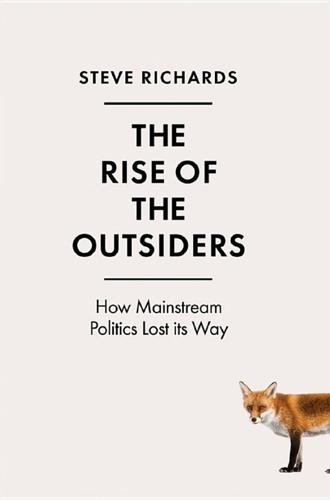
The Rise of the Outsiders: How Mainstream Politics Lost Its Way
by
Steve Richards
Published 14 Jun 2017
The financial crash in 2008, as well as widening inequality, immigration and shapeless new work patterns, is the stormy consequence of globalization, ones that help to explain outsider electoral breakthroughs. At the same time there are related but distinct technological revolutions. These are not incremental, but fast-moving sequences, a leap from relative security to insecurity on several fronts. Forms of communication change on an almost daily basis. Driverless cars are just around the corner and, with them, robotic machines and software that will apparently carry out the duties of those who once assumed they had a career for life. Coffee shops in towns are crammed with people who once had staff jobs and are now part of the fractured world of work. They are the lucky ones.
…
The technological revolution was also transforming the way jobs were defined. Uber would not have happened without an app that capitalized on new forms of technology from the mobile phone to satellites, which bring together driver and customer. The orthodox taxi driver felt threatened by the competition. Both would be undermined, if driverless cars are given the go-ahead. While we wait to be driven by machines, accountants are being replaced by virtual accountants. Paid journalists compete with unpaid bloggers. No one gets paid for tweeting. Emails replace the delivered letter. Local branches of banks are closing, as online banking takes over from contact with paid staff.
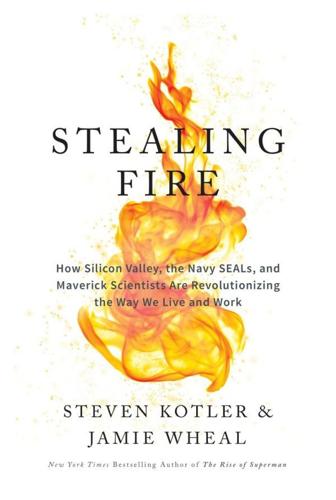
Stealing Fire: How Silicon Valley, the Navy SEALs, and Maverick Scientists Are Revolutionizing the Way We Live and Work
by
Steven Kotler
and
Jamie Wheal
Published 21 Feb 2017
Out of all the ideas Spielberg’s think tank came up with, they correctly anticipated head-up digital displays, gesture command, driverless cars, personalized advertising, voice-automated home appliances, and predictive crime analytics. At first, the movie was supposed to be set in 2070, but then they dialed it back to 2054. And out of all their educated guesswork, that was their biggest mistake. They were forty years too late. And not just for the cool tech like driverless cars and head-up displays, but for precognition itself. In 2015, we were invited to Southern California to host an event for Nike’s innovation group.

Capitalism Without Capital: The Rise of the Intangible Economy
by
Jonathan Haskel
and
Stian Westlake
Published 7 Nov 2017
First of all, there is the question of scale. Policy wonks around the world often look enviously at DARPA, the US defense innovation agency, which spends around $3 billion a year on a mixture of innovative research and challenges and has played an important role in the development of technologies from the computer mouse to the driverless car. But part of the reason DARPA works is that it is backed up by the United States’ $600 billion defense procurement budget, one of the principles of which is to maintain the technological superiority of the American military. Second, there must be a sufficient level of political commitment. Using procurement to encourage innovation involves a risk of failure.
…
Suppose there are big economic gains to be had from developing self-driving cars and reconfiguring our cities around them (fewer car accidents, more productive commutes, freeing up parking spaces for redevelopment, and so on). But realizing these benefits requires a lot of investments to be made together (driverless car technology, urban design, new insurance policies, and so on); it may well be that no company is willing to make investments on its own unless it knows that others will make complementary ones. In this case, it is possible that government investment may not only be useful in itself (by funding high-spillover investments that others would not make), but would also encourage wider investment by increasing the likelihood that others would make complementary investments.
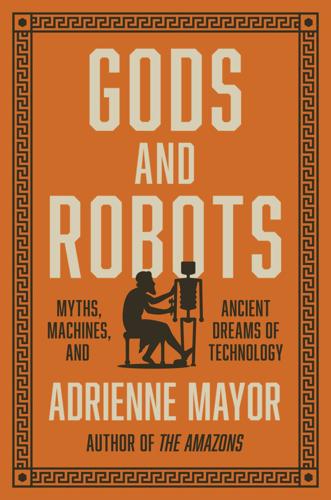
Gods and Robots: Myths, Machines, and Ancient Dreams of Technology
by
Adrienne Mayor
Published 27 Nov 2018
Notably, Philostratus (AD 170–245) reported that the peripatetic sage Apollonius of Tyana saw many amazing sights in India in the first or second century AD (Life of Apollonius 6.11). Among the thaumata, “wonders,” were tripodes de automatoi and automated cupbearers that attended royal banquets. As many modern historians have remarked, the self-moving tripods serving the Olympian gods call to mind modern self-propelled, laborsaving machines, driverless cars, and military-industrial robots. Homer’s myth reminds us that the impulse to “automate” is extremely ancient.20 Wheeled tripods do not appear in surviving ancient Greek art, and archaeological examples are unknown. However, many ornately decorated four-wheeled bronze carts for transporting cauldrons have been excavated in Mediterranean sites, dating to the Bronze Age (thirteenth to twelfth century BC).
…
A goal of this book has been to suggest that on deeper levels the ancient myths about artificial life can provide a context for the exponential developments in artificial life and Artificial Intelligence—and the looming practical and moral implications. I hope that rereading those ancient stories might enrich today’s discussions of robotics, driverless cars, biotechnology, AI, machine learning, and other innovations. We saw how the god Hephaestus made a fleet of “driverless” tripods that responded to commands to deliver food and wine. Even more remarkable was the covey of life-size golden female robots he devised to do his bidding. According to Homer, these divine servants were in every way “like real young women, with sense and reason, strength, even voices, and they were endowed with all the learning of immortals.”
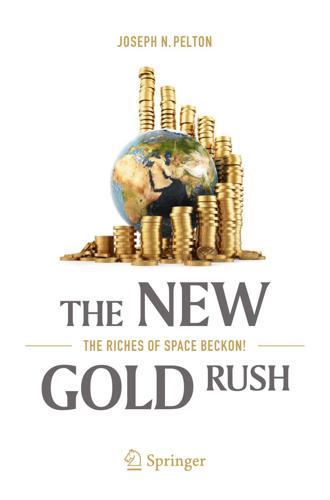
The New Gold Rush: The Riches of Space Beckon!
by
Joseph N. Pelton
Published 5 Nov 2016
Or, one could look at the equation upside down. If the GPS and other satellite navigation satellite networks were to suddenly not be available we would lose the synchronization of the Internet in many countries. Airline operations would be more dangerous. Satellite navigation will be key to supporting the operation of new driverless cars. The truth is that if we were to lose our navigation and timing satellites this would in a short order of time literally cripple the global economy. The impact would be felt everywhere. The losses would be felt in modern military systems, airline networks, information technology networks, banking and commercial retail authentication systems, and other vital infrastructure would be stripped of its core functionality.
…
The added precision that is provided by the latest generations of precision navigation and timing (PNT) satellites , also known as Global Navigational Satellite Systems (GNSS ), have allowed more and more applications. These vital applications include assistance with aircraft takeoffs and landings and guidance to driverless cars. Today the launching of more and more PNT satellites has added to the precision of navigation and position determination, but has also led the United Nations to take the lead in seeking to coordinate the various national systems that are being deployed. This group, known as the International Committee on Global Navigation (ICG ), was established in 2005 and participation is voluntary, but it also is used universally by all countries with GNSS networks.

The Myth of Artificial Intelligence: Why Computers Can't Think the Way We Do
by
Erik J. Larson
Published 5 Apr 2021
It’s not even that we’re making incremental progress, because working on easy problems, in practice, means neglecting the real ones (the keys not near lampposts). Inductive strategies by themselves give false hope. Getting a misclassified photo on Facebook or a boring movie recommendation on Netflix may not get us into much trouble with reliance on data-driven induction, but driverless cars and other critical technologies certainly can. A growing number of AI scientists understand the issue. Oren Etzioni, head of the Allen Institute for Artificial Intelligence, calls machine learning and big data “high-capacity statistical models.”9 That’s impressive computer science, but it’s not general intelligence.
…
We can patch up purely data-driven, inductive systems by including more data—to some extent. But exceptions, atypical observations, and all sorts of surprises are part and parcel of the real world. The strategy of exposing supervised learning systems to foreseeable exceptions, as is done with ongoing work on driverless cars, is a Sisyphean undertaking, because exceptions by their very nature cannot be completely foreseen. A new, essentially abductive, approach is required. In the meantime, we’re stuck with only the observable regularities, the “fat head” of what is automatable. Judea Pearl has made this point nicely with his metaphor of the “ladder of causation.”

Code Dependent: Living in the Shadow of AI
by
Madhumita Murgia
Published 20 Mar 2024
Last year, Ian won a scholarship from Sama to attend college, where he is now studying for a bachelor’s degree in IT. Ian’s job at Sama is to perform data annotation: he helps to train artificial intelligence software made by global corporations, by creating detailed labels for the datasets used to train them. Ian works primarily on image-tagging for driverless cars. The computers inside these cars, developed by the likes of Volkswagen, BMW, Tesla, Google, Uber and others, need to know how to read a road – street signs, pedestrians, trees, road markings and traffic lights – so they can control the car’s driving functions. Ian usually receives driver’s-view clips of cars driving down anonymous roads, a bit like a hazard perception test for learners.
…
.: ‘The Machine Stops’ ref1 Fortnite ref1 Foxglove ref1 Framestore ref1 Francis, Pope ref1, ref2 fraudulent activity benefits ref1 gig workers and ref1, ref2, ref3 free will ref1, ref2 Freedom of Information requests ref1, ref2, ref3 ‘Fuck the algorithm’ ref1 Fussey, Pete ref1 Galeano, Eduardo ref1 gang rape ref1, ref2 gang violence ref1, ref2, ref3, ref4 Gebru, Timnit ref1, ref2, ref3 Generative Adversarial Networks (GANs) ref1 generative AI ref1, ref2, ref3, ref4, ref5, ref6, ref7, ref8, ref9, ref10 AI alignment and ref1, ref2, ref3 ChatGPT see ChatGPT creativity and ref1, ref2, ref3, ref4 deepfakes and ref1, ref2, ref3 GPT (Generative Pre-trained Transformer) ref1, ref2, ref3, ref4 job losses and ref1 ‘The Machine Stops’ and ref1 Georgetown University ref1 gig work ref1, ref2, ref3, ref4, ref5 Amsterdam court Uber ruling ref1 autonomy and ref1 collective bargaining and ref1 colonialism and ref1, ref2, ref3 #DeclineNow’ hashtag ref1 driver profiles ref1 facial recognition technologies ref1, ref2, ref3, ref4 fraudulent activity and ref1, ref2, ref3, ref4 ‘going Karura’ ref1 ‘hiddenness’ of algorithmic management and ref1 job allocation algorithm ref1, ref2, ref3, ref4, ref5, ref6 location-checking ref1 migrants and ref1 ‘no-fly’ zones ref1 race and ref1 resistance movement ref1 ‘slaveroo’ ref1 ‘therapy services’ ref1 UberCheats ref1, ref2, ref3 UberEats ref1, ref2 UK Supreme Court ruling ref1 unions and ref1, ref2, ref3 vocabulary to describe AI-driven work ref1 wages ref1, ref2, ref3, ref4, ref5, ref6, ref7, ref8, ref9, ref10, ref11 work systems built to keep drivers apart or turn workers’ lives into games ref1, ref2 Gil, Dario ref1 GitHub ref1 ‘give work, not aid’ ref1 Glastonbury Festival ref1 Glovo ref1 Gojek ref1 ‘going Karura’ ref1 Goldberg, Carrie ref1 golem (inanimate humanoid) ref1 Gonzalez, Wendy ref1 Google ref1 advertising and ref1 AI alignment and ref1 AI diagnostics and ref1, ref2, ref3 Chrome ref1 deepfakes and ref1, ref2, ref3, ref4 DeepMind ref1, ref2, ref3, ref4 driverless cars and ref1 Imagen AI models ref1 Maps ref1, ref2, ref3 Reverse Image ref1 Sama ref1 Search ref1, ref2, ref3, ref4, ref5 Transformer model and ref1 Translate ref1, ref2, ref3, ref4 Gordon’s Wine Bar London ref1 GPT (Generative Pre-trained Transformer) ref1, ref2, ref3, ref4 GPT-4 ref1 Graeber, David ref1 Granary Square, London ref1, ref2 ‘graveyard of pilots’ ref1 Greater Manchester Coalition of Disabled People ref1 Groenendaal, Eline ref1 Guantanamo Bay, political prisoners in ref1 Guardian ref1 Gucci ref1 guiding questions checklist ref1 Gulu ref1 Gumnishka, Iva ref1, ref2, ref3, ref4 Gutiarraz, Norma ref1, ref2, ref3, ref4, ref5 hallucination problem ref1, ref2, ref3 Halsema, Femke ref1, ref2 Hanks, Tom ref1, ref2 Hart, Anna ref1 Hassabis, Demis ref1 Harvey, Adam ref1 Have I Been Trained ref1 healthcare/diagnostics Accredited Social Health Activists (ASHAs) ref1, ref2, ref3 bias in ref1 Covid-19 and ref1, ref2 digital colonialism and ref1 ‘graveyard of pilots’ ref1 heart attacks and ref1, ref2 India and ref1 malaria and ref1 Optum ref1 pain, African Americans and ref1 qTrack ref1, ref2, ref3 Qure.ai ref1, ref2, ref3, ref4 qXR ref1 radiologists ref1, ref2, ref3, ref4, ref5, ref6 Tezpur ref1 tuberculosis ref1, ref2, ref3 without trained doctors ref1 X-ray screening and ref1, ref2, ref3, ref4, ref5, ref6, ref7, ref8, ref9, ref10 heart attacks ref1, ref2 Herndon, Holly ref1 Het Parool ref1, ref2 ‘hiddenness’ of algorithmic management ref1 Hikvision ref1, ref2 Hinton, Geoffrey ref1 Hive Micro ref1 Home Office ref1, ref2, ref3 Hong Kong ref1, ref2, ref3, ref4, ref5 Horizon Worlds ref1 Hornig, Jess ref1 Horus Foundation ref1 Huawei ref1, ref2, ref3 Hui Muslims ref1 Human Rights Watch ref1, ref2, ref3, ref4 ‘humanist’ AI ethics ref1 Humans in the Loop ref1, ref2, ref3, ref4 Hyderabad, India ref1 IBM ref1, ref2, ref3, ref4 Iftimie, Alexandru ref1, ref2, ref3, ref4, ref5 IJburg, Amsterdam ref1 Imagen AI models ref1 iMerit ref1 India ref1, ref2, ref3, ref4, ref5, ref6, ref7, ref8, ref9 facial recognition in ref1, ref2, ref3 healthcare in ref1, ref2, ref3 Industrial Light and Magic ref1 Information Commissioner’s Office ref1 Instacart ref1, ref2 Instagram ref1, ref2 Clearview AI and ref1 content moderators ref1, ref2, ref3, ref4 deepfakes and ref1, ref2, ref3 Integrated Joint Operations Platform (IJOP) ref1, ref2 iPhone ref1 IRA ref1 Iradi, Carina ref1 Iranian coup (1953) ref1 Islam ref1, ref2, ref3, ref4, ref5 Israel ref1, ref2, ref3 Italian government ref1 Jaber, Faisal bin Ali ref1 Jainabai ref1 Janah, Leila ref1, ref2, ref3 Jay Gould, Stephen ref1 Jewish faith ref1, ref2, ref3, ref4 Jiang, Mr ref1 Jim Crow era ref1 jobs application ref1, ref2, ref3 ‘bullshit jobs’ ref1 data annotation and data-labelling ref1 gig work allocation ref1, ref2, ref3, ref4, ref5, ref6 losses ref1, ref2, ref3 Johannesburg ref1, ref2 Johnny Depp–Amber Heard trial (2022) ref1 Jones, Llion ref1 Joske, Alex ref1 Julian-Borchak Williams, Robert ref1 Juncosa, Maripi ref1 Kafka, Franz ref1, ref2, ref3, ref4 Kaiser, Lukasz ref1 Kampala, Uganda ref1, ref2, ref3 Kellgren & Lawrence classification system. ref1 Kelly, John ref1 Kibera, Nairobi ref1 Kinzer, Stephen: All the Shah’s Men ref1 Knights League ref1 Koli, Ian ref1, ref2, ref3, ref4, ref5, ref6, ref7, ref8, ref9, ref10 Kolkata, India ref1 Koning, Anouk de ref1 Laan, Eberhard van der ref1 labour unions ref1, ref2, ref3, ref4, ref5, ref6 La Fors, Karolina ref1 LAION-5B ref1 Lanata, Jorge ref1 Lapetus Solutions ref1 large language model (LLM) ref1, ref2, ref3 Lawrence, John ref1 Leigh, Manchester ref1 Lensa ref1 Leon ref1 life expectancy ref1 Limited Liability Corporations ref1 LinkedIn ref1 liver transplant ref1 Loew, Rabbi ref1 London delivery apps in ref1, ref2 facial recognition in ref1, ref2, ref3, ref4 riots (2011) ref1 Underground terrorist attacks (2001) and (2005) ref1 Louis Vuitton ref1 Lyft ref1, ref2 McGlynn, Clare ref1, ref2 machine learning advertising and ref1 data annotation and ref1 data colonialism and ref1 gig workers and ref1, ref2, ref3 healthcare and ref1, ref2, ref3 predictive policing and. ref1, ref2, ref3, ref4 rise of ref1 teenage pregnancy and ref1, ref2, ref3 Mahmoud, Ala Shaker ref1 Majeed, Amara ref1, ref2 malaria ref1 Manchester Metropolitan University ref1 marginalized people ref1, ref2, ref3, ref4, ref5, ref6, ref7, ref8, ref9 Martin, Noelle ref1, ref2, ref3, ref4, ref5, ref6, ref7 Masood, S.

The Technology Trap: Capital, Labor, and Power in the Age of Automation
by
Carl Benedikt Frey
Published 17 Jun 2019
Despite decades of companies’ moving jobs offshore, roughly 2.2 million Americans still work in 6,800 call centers across the country, and several hundred thousand do similar jobs in smaller sites.20 * * * One of the greatest leaps forward has taken place in autonomous driving. In 2004, the Defense Advanced Research Projects Agency (DARPA)—set up by President Dwight Eisenhower in 1958, in response to the Soviet Union’s launch of the first artificial earth satellite, Sputnik 1—held its first “grand challenge” for driverless cars. The goal was to drive 142.0 miles through the Mojave Desert within ten hours without any human assistance. The farthest any of the vehicles got was 7.1 miles, and several cars did not even get off the starting line. The $1 million prize went unclaimed. Yet in 2016, the world’s first self-driving taxis were picking up passengers in Singapore.
…
“A More Realistic Route to Autonomous Driving,” 2018, Economist, August 2, https://www.economist.com/business/2018/08/02/a-more-realistic-route-to-autonomous-driving. 28. “Tractor Crushes Boy to Death,” 1931, New York Times, October 12. 29. J. R. Treat et al., 1979, Tri-Level Study of the Causes of Traffic Accidents: Final Report, vol. 2: Special Analyses (Bloomington, IN: Institute for Research in Public Safety). See also V. Wadhwa, 2017, The Driver in the Driverless Car: How Our Technology Choices Will Create the Future (San Francisco: Berrett-Koehler). 30. World Health Organization, 2015, “Road Traffic Deaths,” http://www.who.int/gho/road_safety/mortality/en. 31. J. McCurry, 2018, “Driverless Taxi Debuts in Tokyo in ‘World First’ Trial ahead of Olympics,” Guardian, August 28. 32.
…
Journal of Law and Economics 59 (1): 191–223. Von Tunzelmann, G. N. 1978. Steam Power and British Industrialization to 1860. Oxford: Oxford University Press. Voth, H. 2000. Time and Work in England 1750–1830. Oxford: Clarendon Press of Oxford University Press. Wadhwa, V., and A. Salkever. 2017. The Driver in the Driverless Car: How Our Technology Choices Will Create the Future. San Francisco: Berrett-Koehler. Walker, C. R. 1957. Toward the Automatic Factory: A Case Study of Men and Machines. New Haven, CT: Yale University Press. Wallis, P. 2014. “Labour Markets and Training.” In The Cambridge Economic History of Modern Britain, 1:178–210, Industrialisation, 1700–1870, edited by R.

The Singularity Is Nearer: When We Merge with AI
by
Ray Kurzweil
Published 25 Jun 2024
BACK TO NOTE REFERENCE 8 “Economics and Industry Data,” American Trucking Associations, accessed April 20, 2023, https://www.trucking.org/economics-and-industry-data; US Bureau of Labor Statistics, “Occupational Outlook Handbook, Passenger Vehicle Drivers—Summary,” US Department of Labor, accessed January 30, 2023, https://www.bls.gov/ooh/transportation-and-material-moving/passenger-vehicle-drivers.htm. BACK TO NOTE REFERENCE 9 Mark Fahey, “Driverless Cars Will Kill the Most Jobs in Select US States,” CNBC, September 2, 2016, https://www.cnbc.com/2016/09/02/driverless-cars-will-kill-the-most-jobs-in-select-us-states.html. BACK TO NOTE REFERENCE 10 Fahey, “Driverless Cars Will Kill the Most Jobs in Select US States.” BACK TO NOTE REFERENCE 11 Cheeseman Day and Hait, “America Keeps on Truckin’.” BACK TO NOTE REFERENCE 12 Bureau of Transportation Statistics, Transportation Economic Trends, US Department of Transportation, accessed April 20, 2023, https://data.bts.gov/stories/s/caxh-t8jd.

Future Files: A Brief History of the Next 50 Years
by
Richard Watson
Published 1 Jan 2008
In the future all cars will be automatically tracked from space, making no journey entirely private. The good news in all this is that real-time data on where a car is and what it’s doing will revolutionize the auto theft recovery and insurance industries and will foster various location-based services such as pay-as-you-go insurance. Driverless cars Don’t expect this any time soon, but by about 2040 we will see cars capable of driving themselves with minimal interference from the driver. Cars will also travel in social groups Automotive and Transport 155 and correspond with other vehicles about conditions ahead or alternative routes.
…
A 311 Index ‘O’ Garage 170 3D printers 56 accelerated education 57 accidents 159, 161–6, 173, 246 ACNielsen 126 adaptive cruise control 165 Adeg Aktiv 50+ 208 advertising 115–16, 117, 119 Africa 70, 89, 129, 174, 221, 245, 270, 275, 290, 301 ageing 1, 10, 54, 69, 93, 139, 147–8, 164, 188, 202, 208, 221, 228–9, 237, 239, 251, 261, 292, 295, 297–8 airborne networks 56 airlines 272 allergies 196–7, 234, 236 Alliance Against Urban 4x4s 171 alternative energy 173 alternative futures viii alternative medicine 244–5 alternative technology 151 amateur production 111–12 Amazon 32, 113–14, 121 American Apparel 207 American Express 127–8 androids 55 Angola 77 anti-ageing drugs 231, 237 anti-ageing foods 188 anti-ageing surgery 2, 237 antibiotics 251 anxiety 10, 16, 30, 32, 36, 37, 128, 149, 179, 184, 197, 199, 225, 228, 243, 251, 252, 256, 263, 283–4, 295–6, 300, 301, 305 Apple 61, 115, 121, 130, 137–8, 157 Appleyard, Bryan 79 Argentina 210 Armamark Corporation 193 artificial intelliegence 22, 40, 44, 82 131, 275, 285–6, 297, 300 Asda 136, 137 Asia 11, 70, 78, 89, 129, 150, 174, 221, 280, 290, 292 Asimov, Isaac 44 Asos.com 216 asthma 235 auditory display software 29 Australia 20–21, 72–3, 76, 92, 121, 145, 196, 242, 246, 250, 270, 282 Austria 208 authenticity 32, 37, 179, 194, 203–11 authoritarianism 94 automated publishing machine (APM) 114 automation 292 automotive industry 154–77 B&Q 279 baby boomers 41, 208 bacterial factories 56 Bahney, Anna 145 Bahrain 2 baking 27, 179, 195, 199 Bangladesh 2 bank accounts, body double 132 banknotes 29, 128 banks 22, 123, 135–8, 150, 151 virtual 134 Barnes and Noble 114 bartering 151 BBC 25, 119 Become 207 Belgium 238 313 314 benriya 28 Berlusconi, Silvio 92 Best Buy 223 biofuel 64 biomechatronics 56 biometric identification 28, 35, 52, 68, 88, 132 bionic body parts 55 Biosphere Expeditions 259 biotechnology 40, 300 blended families 20 blogs 103, 107, 109, 120 Blurb 113 BMW 289 board games 225 body double bank accounts 132 body parts bionic 55 replacement 2, 188, 228 Bolivia 73 Bollywood 111 books 29, 105, 111–25 boomerang kids 145 brain transplants 231 brain-enhancing foods 188 Brazil 2, 84, 89, 173, 247, 254, 270, 290 Burger King 184 business 13, 275–92 Bust-Up 189 busyness 27, 195, 277 Calvin, Bill 45 Canada 63, 78, 240 cancer 251 car sharing 160, 169, 176 carbon credits 173 carbon footprints 255 carbon taxes 76, 172 cars classic 168–9 driverless 154–5 flying 156, 165 hydrogen-powered 12, 31, 157, 173 pay-as-you-go 167–8 self-driving 165 cascading failure 28 cash 126–7, 205 cellphone payments 129, 213 cellphones 3, 25, 35, 51, 53, 120, 121, FUTURE FILES 129, 156, 161, 251 chicken, Christian 192 childcare robots 57 childhood 27, 33–4, 82–3 children’s database 86 CHIME nations (China, India, Middle East) 2, 10, 81 China 2, 10, 11, 69–72, 75–81, 88, 92–3, 125, 137, 139–40, 142, 151, 163, 174–5, 176, 200, 222, 228, 247, 260, 270–71, 275, 279, 295, 302 choice 186–7 Christian chicken 192 Christianity, muscular 16, 73 Chrysler 176 cinema 110–11, 120 Citibank 29, 128 citizen journalism 103–4, 108 City Car Club 168 Clarke, Arthur C. 58–9 Clarke’s 187 classic cars 168–9 climate change 4, 11, 37, 43, 59, 64, 68, 74, 77–9, 93, 150, 155, 254, 257, 264, 298–9 climate-controlled buildings 254, 264 cloning 38 human 23, 249 CNN 119 coal 176 Coca-Cola 78, 222–3 co-creation 111–12, 119 coins 29, 128, 129 collective intelligence 45–6 Collins, Jim 288 comfort eating 200 Comme des Garçons 216 community 36 compassion 120 competition in financial services 124–5 low-cost 292 computers disposable 56 intelligent 23, 43 organic 56 wearable 56, 302 computing 3, 33, 43, 48, 82 connectivity 3, 10, 11, 15, 91, 120, Index 233, 261, 275–6, 281, 292, 297, 299 conscientious objection taxation 86 contactless payments 123, 150 continuous partial attention 53 control 36, 151, 225 convenience 123, 178–9, 184, 189, 212, 223, 224 Coren, Stanley 246 corporate social responsibility 276, 282, 298 cosmetic neurology 250 Costa Rica 247 Craig’s List 102 creativity 11, 286; see also innovation credit cards 141–3, 150 crime 86–9 forecasting 86–7 gene 57, 86 Croatia 200 Crowdstorm 207 Cuba 75 cultural holidays 259, 273 culture 11, 17–37 currency, global 127, 151 customization 56, 169, 221–2, 260 cyberterrorism 65, 88–9 Cyc 45 cynicism 37 DayJet 262 death 237–9 debt 123–4, 140–44, 150 defense 63, 86 deflation 139 democracy 94 democratization of media 104, 108, 113 demographics 1, 10, 21, 69, 82, 93, 202, 276, 279–81, 292, 297–8 Denmark 245 department stores 214 deregulation 11, 3 Destiny Health 149 detox 200 Detroit Project 171 diagnosis 232 remote 228 digital downloads 121 evaporation 25 315 immortality 24–5 instant gratification syndrome 202 Maoism 47 money 12, 29, 123, 126–7, 129, 132, 138, 150, 191 nomads 20, 283 plasters 241 privacy 25, 97, 108 readers 121 digitalization 37, 292 Dinner by Design 185 dirt holidays 236 discount retailers 224 Discovery Health 149 diseases 2, 228 disintegrators 57 Disney 118–19 disposable computers 56 divorce 33, 85 DNA 56–7, 182 database 86 testing, compulsory 86 do-it-yourself dinner shops 185–6 dolls 24 doorbells 32 downshifters 20 Dream Dinners 185 dream fulfillment 148 dressmaking 225 drink 178–200 driverless cars 154–5 drugs anti-ageing 231, 237 performance-improving 284–5 Dubai 264, 267, 273 dynamic pricing 260 E Ink 115 e-action 65 Earthwatch 259 Eastern Europe 290 eBay 207 e-books 29, 37, 60, 114, 115, 302 eco-luxe resorts 272 economic collapse 2, 4, 36, 72, 221, 295 economic protectionism 10, 15, 72, 298 economy travel 272 316 Ecuador 73 education 15, 18, 82–5, 297 accelerated 57 lifelong learning 290 Egypt 2 electricity shortages 301 electronic camouflage 56 electronic surveillance 35 Elephant 244 email 18–19, 25, 53–4, 108 embedded intelligence 53, 154 EMF radiation 251 emotional capacity of robots 40, 60 enclosed resorts 273 energy 72, 75, 93 alternative 173 nuclear 74 solar 74 wind 74 enhancement surgery 249 entertainment 34, 121 environment 4, 10, 11, 14, 64, 75–6, 83, 93, 155, 171, 173, 183, 199, 219–20, 252, 256–7, 271, 292, 301 epigenetics 57 escapism 16, 32–3, 121 Estonia 85, 89 e-tagging 129–30 e-therapy 242 ethical bankruptcy 35 ethical investing 281 ethical tourism 259 ethics 22, 24, 41, 53, 78, 86, 132, 152, 194, 203, 213, 232, 238, 249–50, 258, 276, 281–2, 298–9 eugenics 252 Europe 11, 70, 72, 81, 91, 141, 150, 174–5, 182, 190, 192, 209 European Union 15, 139 euthanasia 238, 251 Everquest 33 e-voting 65 experience 224 extended financial families 144 extinction timeline 9 Facebook 37, 97, 107 face-recognition doors 57 fakes 32 family 36, 37 FUTURE FILES family loans 145 fantasy-related industries 32 farmaceuticals 179, 182 fast food 178, 183–4 fat taxes 190 fear 10, 34, 36, 38, 68, 150, 151, 305 female-only spaces 210–11, 257 feminization 84 financial crisis 38, 150–51, 223, 226, 301 financial services 123–53, 252 trends 123–5 fish farming 181 fixed-price eating 200 flashpacking 273 flat-tax system 85–6 Florida, Richard 36, 286, 292 flying cars 165 food 69–70, 72, 78–9, 162, 178–201 food anti-ageing 188 brain-enhancing 188 fast 178, 183–4 functional 179 growing your own 179, 192, 195 history 190–92 passports 200 slow 178, 193 tourism 273 trends 178–80 FoodExpert ID 182 food-miles 178, 193, 220 Ford 169, 176, 213, 279–80 forecasting 49 crime 86–7 war 49 Forrester Research 132 fractional ownership 168, 175, 176, 225 France 103, 147, 170, 189, 198, 267 Friedman, Thomas 278–9, 292 FriendFinder 32 Friends Reunited 22 frugality 224 functional food 179 Furedi, Frank 68 gaming 32–3, 70, 97, 111–12, 117, 130, 166, 262 Gap 217 Index gardening 27, 148 gas 176 GE Money 138, 145 gendered medicine 244–5 gene silencing 231 gene, crime 86 General Motors 157, 165 Generation X 41, 281 Generation Y 37, 41, 97, 106, 138, 141–2, 144, 202, 208, 276, 281, 292 generational power shifts 292 Genes Reunited 35 genetic enhancement 40, 48 history 35 modification 31, 182 testing 221 genetics 3, 10, 45, 251–2 genomic medicine 231 Germany 73, 147, 160, 170, 204–5, 216–17, 261, 267, 279, 291 Gimzewski, James 232 glamping 273 global currency 127 global warming 4, 47, 77, 93, 193, 234 globalization 3, 10, 15–16, 36–7, 63–7, 72–3, 75, 81–2, 88, 100, 125, 139, 143, 146, 170, 183, 189, 193–5, 221, 224, 226, 233–4, 247–8, 263, 275, 278–80, 292, 296, 299 GM 176 Google 22, 61, 121, 137, 293 gout 235 government 14, 18, 36, 63–95, 151 GPS 3, 15, 26, 50, 88, 138, 148, 209, 237, 262, 283 Grameen Bank 135 gravity tubes 57 green taxes 76 Greenpeace 172 GRIN technologies (genetics, robotics, internet, nanotechnology) 3, 10, 11 growing your own food 178, 192, 195 Gucci 221 Gulf States 125, 260, 268 H&M 217 habitual shopping 212 Handy, Charles 278 317 Happily 210 happiness 63–4, 71–2, 146, 260 health 15, 82, 178–9, 199 health monitoring 232, 236, 241 healthcare 2, 136, 144, 147–8, 154, 178–9, 183–4, 189–91, 228–53, 298; see also medicine trends 214–1534–7 Heinberg, Richard 74 Helm, Dieter 77 Heritage Foods 195 hikikomori 18 hive mind 45 holidays 31, 119; see also tourism holidays at home 255 cultural 259 dirt 236 Hollywood 33, 111–12 holographic displays 56 Home Equity Share 145 home baking 225 home-based microgeneration 64 home brewing 225 honesty 152 Hong Kong 267 hospitals 228, 241–3, 266 at home 228, 238, 240–42 hotels 19, 267 sleep 266 human cloning 23, 249 Hungary 247 hybrid humans 22 hydrogen power 64 hydrogen-powered cars 12, 31, 157, 173 Hyperactive Technologies 184 Hyundai 170 IBM 293 identities, multiple 35, 52 identity 64, 71 identity theft 88, 132 identity verification, two-way 132 immigration 151–2, 302 India 2, 10, 11, 70–72, 76, 78–9, 81, 92, 111, 125, 135, 139, 163, 174–5, 176, 247, 249–50, 254, 260, 270, 275, 279, 302 indirect taxation 86 318 individualism 36 Indonesia 2, 174 industrial robots 42 infinite content 96–7 inflation 151 information overlead 97, 120, 159, 285; see also too much information innovation 64, 81–2, 100, 175, 222, 238, 269, 277, 286–8, 291, 297, 299 innovation timeline 8 instant gratification 213 insurance 123, 138, 147–50, 154, 167, 191, 236, 250 pay-as-you-go 167 weather 264 intelligence 11 embedded 53, 154 implants 229 intelligent computers 23, 43 intelligent night vision 162–3 interaction, physical 22, 25, 97, 110, 118, 133–4, 215, 228, 243, 276, 304 interactive media 97, 105 intergenerational mortgages 140, 144–5 intermediaries 123, 135 internet 3, 10, 11, 17–18, 25, 68, 103, 108, 115–17, 124, 156, 240–41, 261, 270, 283, 289, 305 failure 301 impact on politics 93–4 sensory 56 interruption science 53 iPills 240 Iran 2, 69 Ishiguro, Hiroshi 55 Islamic fanaticism 16 Italy 92, 170, 198–9 iTunes 115, 130; see also Apple Japan 1, 18, 26, 28–9, 54–5, 63, 80–81, 114, 121, 128–9, 132, 140, 144–5, 147, 174, 186, 189, 192, 196, 198, 200, 209–10, 223, 240, 260, 264, 271, 279, 291 jetpacks 60 job security 292 journalism 96, 118 journalism, citizen 103–4, 107 joy-makers 57 FUTURE FILES Kaboodle 207 Kapor, Mitchell 45 Kenya 128 keys 28–9 Kindle 60, 121 Kramer, Peter 284 Kuhn, Thomas 281 Kurzweil, Ray 45 Kuwait 2 labor migration 290–91 labor shortages 3, 80–81, 289–90 Lanier, Jaron 47 laser shopping 212 leisure sickness 238 Let’s Dish 185 Lexus 157 libraries 121 Libya 73 life-caching 24, 107–8 lighting 158, 160 Like.com 216 limb farms 249 limited editions 216–17 live events 98, 110, 304 localization 10, 15–16, 116, 128, 170, 178, 189, 193, 195, 215, 220, 222–3, 224, 226, 255, 270, 297 location tagging 88 location-based marketing 116 longevity 188–9, 202 Longman, Philip 71 low cost 202, 219–22 luxury 202, 221, 225, 256, 260, 262, 265–6, 272 machinamas 112 machine-to-machine communication 56 marketing 115–16 location-based 116 now 116 prediction 116 Marks & Spencer 210 Maslow, Abraham 305–6 masstigue 223 materialism 37 Mayo Clinic 243 McDonald’s 130, 168, 180, 184 McKinsey 287 Index meaning, search for 16, 259, 282, 290, 305–6 MECU 132 media 96–122 democratization of 104, 108, 115 trends 96–8 medical outsourcing 247–8 medical tourism 2, 229, 247 medicine 188, 228–53; see also healthcare alternative 243–4 gendered 244–5 genomic 231 memory 229, 232, 239–40 memory loss 47 memory pills 231, 240 memory recovery 2, 228–9, 239 memory removal 29–30, 29, 240 Menicon 240 mental health 199 Meow Mix 216 Merriman, Jon 126 metabolomics 56 meta-materials 56 Metro 204–5 Mexico 2 micromedia 101 micro-payments 130, 150 Microsoft 137, 147, 293 Middle East 10, 11, 70, 81, 89, 119, 125, 129, 139, 174–5, 268, 301 migration 3, 11, 69–70, 78, 82, 234, 275, 290–91 boomerang 20 labor 290–91 Migros 215 military recruitment 69 military vehicles 158–9 mind-control toys 38 mindwipes 57 Mitsubishi 198, 279 mobile payments 123, 150 Modafinil 232 molecular biology 231 monetization 118 money 123–52 digital 12, 29, 123, 126–7, 129, 132, 138, 150, 191 monitoring, remote 154, 168, 228, 242 monolines 135, 137 319 mood sensitivity 41, 49, 154, 158, 164, 187–8 Morgan Stanley 127 mortality bonds 148 Mozilla Corp. 289 M-PESA 129 MTV 103 multigenerational families 20 multiple identities 35, 52 Murdoch, Rupert 109 muscular Christianity 16, 73 music industry 121 My-Food-Phone 242 MySpace 22, 25, 37, 46, 97, 107, 113 N11 nations (Bangladesh, Egypt, Indonesia, Iran, South Korea, Mexico, Nigeria, Pakistan, Philippines, Turkey, Vietnam) 2 nanoelectronics 56 nanomedicine 32 nanotechnology 3, 10, 23, 40, 44–5, 50, 157, 183, 232, 243, 286, 298 napcaps 56 narrowcasting 109 NASA 25, 53 nationalism 16, 70, 72–3, 139, 183, 298, 302 natural disasters 301 natural resources 2, 4, 11, 64, 298–9 Nearbynow 223 Nestlé 195 Netherlands 238 NetIntelligence 283 networkcar.com 154 networks 28, 166, 288 airborne 56 neural nets 49 neuronic whips 57 neuroscience 33, 48 Neville, Richard 58–9 New Economics Foundation 171 New Zealand 265, 269 newspapers 29, 102–9, 117, 119, 120 Nigeria 2, 73 Nike 23 nimbyism 63 no-frills 224 Nokia 61, 105 Norelift 189 320 Northern Rock 139–40 Norwich Union 167 nostalgia 16, 31–2, 51, 169–70, 179, 183, 199, 203, 225, 303 now marketing 116 nuclear annihilation 10, 91 nuclear energy 74 nutraceuticals 179, 182 Obama, Barack 92–3 obesity 75, 190–92, 199, 250–51 oceanic thermal converters 57 oil 69, 72–3, 93, 151, 174, 176, 272, 273, 301 Oman 2, 270 online relationships 38 organic computers 56 organic food 200, 226 osteoporosis 235 outsourcing 224, 292 Pakistan 2 pandemics 4, 10, 16, 59, 72, 128, 232, 234, 272, 295–7, 301 paper 37 parasite singles 145 passwords 52 pictorial 52 pathogens 233 patient simulators 247 patina 31 patriotism 63, 67, 299 pay-as-you-go cars 167–8 pay-as-you-go insurance 167 payments cellphone 129, 213 contactless 123, 150 micro- 130, 150 mobile 123, 150 pre- 123, 150 PayPal 124, 137 Pearson, Ian 44 performance-improving drugs 284–5 personal restraint 36 personal robots 42 personalization 19, 26, 56, 96–8, 100, 102–3, 106, 108–9, 120, 138, 149, 183, 205–6, 223, 244–5, 262, 267, 269 Peru 73 FUTURE FILES Peters, Tom 280 Pharmaca 244 pharmaceuticals 2, 33, 228, 237 Philippines 2, 212, 290 Philips 114 Philips, Michael 232–3 photographs 108 physical interaction 22, 25, 97, 110, 118, 133–4, 215, 228, 243, 276, 304 physicalization 96–7, 101–2, 106, 110, 120 pictorial passwords 52 piggy banks 151 Pink, Daniel 285 plagiarism 83 polarization 15–16, 285 politics 37, 63–95, 151–2 regional 63 trends 63–5 pop-up retail 216, 224 pornography 31 portability 178, 183–4 power shift eastwards 2, 10–11, 81, 252 Prada 205–6, 216 precision agriculture 181–2 precision healthcare 234–7 prediction marketing 116 predictions 37, 301–2 premiumization 223 pre-payments 123, 150 privacy 3, 15, 41, 50, 88, 154, 165–7, 205, 236, 249, 285, 295 digital 25, 97, 108 Procter & Gamble 105, 280 product sourcing 224 Prosper 124, 135 protectionism 67, 139, 156, 220, 226, 301 economic 10, 15, 72, 299 provenance 178, 193, 226 proximity indicators 32 PruHealth 149 psychological neoteny 52 public ownership 92 public transport 171 purposeful shopping 212 Qatar 2 quality 96–7, 98, 101, 109 Index quantum mechanics 56 quantum wires 56 quiet materials 56 radiation, EMF 251 radio 117 randominoes 57 ranking 34, 83, 109, 116, 134, 207 Ranking Ranqueen 186 reality mining 51 Really Cool Foods 185 rebalancing 37 recession 139–40, 202, 222 recognition 36, 304 refrigerators 197–8 refuge 121 regeneration 233 regional food 200 regional politics 63 regionality 178, 192–3 regulation 124, 137, 143 REI 207 Reid, Morris 90 relationships, online 38 religion 16, 58 remote diagnosis 228 remote monitoring 154, 168, 228, 242 renting 225 reputation 34–5 resistance to technology 51 resorts, enclosed 273 resource shortages 11, 15, 146, 155, 178, 194, 254, 300 resources, natural 2, 4, 11, 64, 73–4, 143, 298–9 respect 36, 304 restaurants 186–8 retail 20–21, 202–27, 298 pop-up 216, 224 stealth 215 theater 214 trends 202–3 Revkin, Andy 77 RFID 3, 24, 50, 121, 126, 149, 182, 185, 192, 196, 205 rickets 232 risk 15, 124, 134, 138, 141, 149–50, 162, 167, 172, 191, 265, 299–300, 303 Ritalin 232 321 road pricing 166 Robertson, Peter 49 robogoats 55 robot department store 209 Robot Rules 44 robotic assistants 54, 206 concierges 268 financial advisers 131–2 lobsters 55 pest control 57 soldiers 41, 55, 60 surgery 35, 41, 249 robotics 3, 10, 41, 44–5, 60, 238, 275, 285–6, 292, 297 robots 41, 54–5, 131, 237, 249 childcare 57 emotional capacity of 40, 60 industrial 42 personal 42 security 209 therapeutic 41, 54 Russia 2, 69, 72, 75, 80, 89, 92–3, 125, 174, 232, 254, 270, 295, 302 safety 32, 36, 151, 158–9, 172–3, 182, 192, 196 Sainsbury’s 215 Salt 187 sanctuary tourism 273 satellite tracking 166–7 Saudi Arabia 2, 69 Schwartz, Barry 186 science 13, 16, 40–62, 300 interruption 53 trends 40–42 scramble suits 57 scrapbooking 25, 108, 225 Sears Roebuck 137 seasonality 178, 193–4 second-hand goods 224 Second Life 133, 207–8 securitization 124, 140 security 16, 31, 151 security robots 209 self-driving cars 165 self-medication 242 self-publishing 103, 113–14 self-reliance 35, 75 self-repairing roads 57 322 self-replicating machines 23, 44 Selfridges 214 sensor motes 15, 50, 196 sensory internet 56 Sharia-based investment 125 Shop24 209 shopping 202–27 habitual 212 laser 212 malls 211–5 purposeful 212 slow 213 social 207 Shopping 2.0 224 short-wave scalpels 57 silicon photonics 56 simplicity 169–70, 179, 186, 202, 218, 224, 226, 272 Singapore 241 single-person households 19–20, 202–3, 208–9, 221, 244, 298, 304 skills shortage 293, 302 sky shields 57 sleep 159–60, 188, 228, 231, 246–7, 265 sleep debt 96, 266 sleep hotels 266 sleep surrogates 57 slow food 178, 193 slow shopping 213 slow travel 273 smart devices 26–7, 28, 32, 35, 44, 50, 56, 57, 164, 206, 207 smart dust 3, 15, 50, 196 smartisans 20 Smartmart 209 snakebots 55 social networks 97, 107, 110, 120, 133, 217, 261 social shopping 207 society 13, 15–16, 17–37 trends 15–16 Sodexho 193 solar energy 74 Sony 114, 121 South Africa 84, 149, 242 South America 82, 270 South Korea 2, 103, 128–9 space ladders 56 space mirrors 47 space tourism 271, 273 FUTURE FILES space tugs 57 speed 164, 202, 209, 245, 296–7 spirituality 16, 22, 282, 298, 306 spot knowledge 47 spray-on surgical gloves 57 St James’s Ethics Centre 282 stagflation 139 starch-based plastics 64 stealth retail 215 stealth taxation 86 Sterling, Bruce 55 storytelling 203 Strayer, David 161 street signs 162–3 stress 32, 96, 235, 243, 245–6, 258–9, 265, 257–9, 275, 277, 283–5 stress-control clothing 57 stupidity 151, 302 Stylehive 207 Sudan 73 suicide tourism 236 Super Suppers 185 supermarkets 135–6, 184–6, 188, 191–2, 194, 202–3, 212, 215, 218–19, 224, 229 surgery 2, 31 anti-ageing 2, 237 enhancement 249 Surowiecki, James 45 surveillance 35, 41 sustainability 4, 37, 74, 181, 193–5, 203, 281, 288, 298–9 Sweden 84 swine flu 38, 251, 272 Switzerland 168, 210, 215 synthetic biology 56 Taco Bell 184 Tactical Numerical Deterministic Model 49 tagging, location 86, 88 Taiwan 81 talent, war for 275, 279, 293; see also labor shortages Target 216 Tasmania 267 Tata Motors 174, 176 taxation 85–6, 92, 93 carbon 76, 172 conscientious objection 86 Index fat 190 flat 85–6 green 76 indirect 86 stealth 86 Tchibo 217 technology 3, 14–16, 18, 22, 26, 28, 32, 37, 40–62, 74–5, 82–3, 96, 119, 132, 147–8, 154, 157, 160, 162, 165–7, 178, 182, 195–8, 208, 221, 229, 237, 242–3, 249, 256, 261, 265–6, 268, 275–6, 280, 283–4, 292, 296–7, 300 refuseniks 30, 51, 97 trends 40–42 telemedicine 228, 238, 242 telepathy 29 teleportation 56 television 21, 96, 108, 117, 119 terrorism 67, 91, 108, 150, 262–3, 267, 272, 295–6, 301 Tesco 105, 135–6, 185, 206, 215, 219, 223 Thailand 247, 290 therapeutic robots 41, 54 thermal imaging 232 things that won’t change 10, 303–6 third spaces 224 ThisNext 207 thrift 224 Tik Tok Easy Shop 209 time scarcity 30, 96, 102, 178, 184–6, 218, 255 time shifting 96, 110, 116 time stamps 50 timeline, extinction 9 timeline, innovation 8 timelines 7 tired all the time 246 tobacco industry 251 tolerance 120 too much choice (TMC) 29, 202, 218–19 too much information (TMI) 29, 51, 53, 202, 229; see also information overload tourism 254–74 cultural 273 ethical 259 food 273 323 local 273 medical 2, 229, 247 sanctuary 273 space 271, 273 suicide 238 tribal 262 Tourism Concern 259 tourist quotas 254, 271 Toyota 48–9, 157 toys, mind-control 38 traceability 195 trading down 224 transparency 3, 15, 143, 152, 276, 282, 299 transport 15, 154–77, 298 public 155, 161 trends 154–6 transumerism 223 travel 2, 3, 11, 148, 254–74 economy 272 luxury 272 slow 273 trends 254–6 trend maps 6–7 trends 1, 5–7, 10, 13 financial services 123–5 food 178–80 healthcare 228–9 media 96–8 politics 63–5 retail 202–3 science and technology 40–42 society 15–16 transport 154–6 travel 254–6 work 275–7 tribal tourism 262 tribalism 15–16, 63, 127–8, 183, 192, 220, 260 trust 82, 133, 137, 139, 143, 192, 203, 276, 282–3 tunnels 171 Turing test 45 Turing, Alan 44 Turkey 2, 200, 247 Twitter 60, 120 two-way identity verification 132 UAE 2 UFOs 58 324 UK 19–20, 72, 76, 84, 86, 90–91, 100, 102–3, 105, 128–9, 132, 137, 139–42, 147–9, 150, 163, 167–8, 170–71, 175, 185, 195–6, 199, 200, 206, 210, 214–16, 238, 259, 267–8, 278–9, 284, 288 uncertainty 16, 30, 34, 52, 172, 199, 246, 263, 300, 303 unemployment 151 Unilever 195 University of Chicago 245–6 urban rental companies 176 urbanization 11, 18–19, 78, 84, 155, 233 Uruguay 200 US 1, 11, 19–21, 23, 55–6, 63, 67, 69, 72, 75, 77, 80–83, 86, 88–90, 92, 104–5, 106, 121, 129–33, 135, 139–42, 144, 147, 149, 150, 151, 162, 167, 169–71, 174, 185, 190–3, 195, 205–6, 209, 211, 213, 216, 218, 220, 222–3, 237–8, 240–8, 250, 260, 262, 267–8, 275, 279–80, 282–4, 287, 291 user-generated content (UGC) 46, 97, 104, 289 utility 224 values 36, 152 vending machines 209 Venezuela 69, 73 verbal signatures 132 VeriChip 126 video on demand 96 Vietnam 2, 290 Vino 100 113 Virgin Atlantic 261 virtual adultery 33 banks 134 economy 130–31 protests 65 reality 70 sex 32 stores 206–8 vacations 32, 261 worlds 157, 213, 255, 261, 270, 305 Vocation Vacations 259–60 Vodafone 137 voice recognition 41 voice-based internet search 56 voicelifts 2, 237 FUTURE FILES Volkswagen 175 voluntourism 259 Volvo 164 voting 3, 68, 90–91 Walgreens 244 Wal-Mart 105, 136–7, 215, 219–20, 223, 244, 282 war 68–9, 72 war for talent 275, 279; see also labor shortages war forecasting 49 water 69–70, 74, 77–9, 199 wearable computers 55 weather 64 weather insurance 264 Web 2.0 93, 224 Weinberg, Peter 125 wellbeing 2, 183, 188, 199 white flight 20 Wikipedia 46, 60, 104 wild swimming 273 Wilson, Edward O. 74 wind energy 74 wine producers 200 wisdom of idiots 47 Wizard 145 work 275–94 trends 275–94 work/life balance 64, 71, 260, 277, 289, 293 worldphone 19 xenophobia 16, 63 YouTube 46, 103, 107, 112 Zara 216–17 Zipcar 167 Zopa 124, 134

Cathedrals of Steam: How London’s Great Stations Were Built – and How They Transformed the City
by
Christian Wolmar
Published 5 Nov 2020
By the same author Railways A Short History of Trains Driverless Cars: On a Road to Nowhere The Story of Crossrail Railways & the Raj Are Trams Socialist? To the Edge of the World Engines of War Blood, Iron & Gold Fire & Steam The Subterranean Railway On the Wrong Line Down the Tube Broken Rails Forgotten Children Stagecoach The Great Railway Disaster The Great Railway Revolution First published in hardback in Great Britain in 2020 by Atlantic Books, an imprint of Atlantic Books Ltd. Copyright © Christian Wolmar, 2020 The moral right of Christian Wolmar to be identified as the author of this work has been asserted by him in accordance with the Copyright, Designs and Patents Act of 1988.
…
He has written seven previous books for Atlantic: The Subterranean Railway (on the London Underground), Fire and Steam (Britain’s railways), Blood, Iron and Gold (the world’s railways), Engines of War, The Great Railway Revolution (a history of the American railways), To the Edge of the World (the Trans-Siberian railway) and Railways and the Raj (Indian railways). He has written several other books including The Crossrail Story and Driverless Cars: On a Road to Nowhere? He has had a sadly unsuccessful political career, having tried and failed to get the Labour nomination for several seats. He fought the 2016 Richmond Park by-election, recording Labour’s worst result in London since 1900. A passionate Londoner, he was also shortlisted to be the Labour candidate in the 2016 London Mayoral election, coming fifth out of sixth in the subsequent vote.

Falter: Has the Human Game Begun to Play Itself Out?
by
Bill McKibben
Published 15 Apr 2019
(Archaeologists were the safest, “because the job requires highly sophisticated types of pattern recognition, and doesn’t produce huge profits.”)10 Other researchers pointed out that the Rust Belt has already been so heavily automated that employment will actually drop less there than in places with big service industries. Number one: Las Vegas, which stands to lose 65 percent of its current jobs in the next two decades.11 So, if inequality worries you, just wait. These practical losses come with practical gains, obviously: Driverless cars would make it theoretically possible to have fleets of dispatchable, roving electric vehicles that in turn could reduce traffic by 90 percent, free up the city streets that no longer require parking spaces, and save some of the lives lost each year in auto accidents. Also, you could go to a bar and have an extra beer without worry.
…
This is not an attempt to be pure, to meet some philosophical ideal. We mix people and machines, for instance, in all kinds of ways. I love Vermont’s local stock car track (“Thunder Road, the nation’s site of excitement!”) because the men and women at the wheel show skill and courage. But I don’t think I’d bother going if the races were run by driverless cars. They could doubtless go faster, just as runners genetically altered to have more red blood cells can doubtless go faster. But faster isn’t really the point. The story is the point. If something as marginal (though wonderful) as sports can see meaning leach away when we mess with people’s bodies or remove them from the picture, perhaps we should think long and hard about more important kinds of meaning.
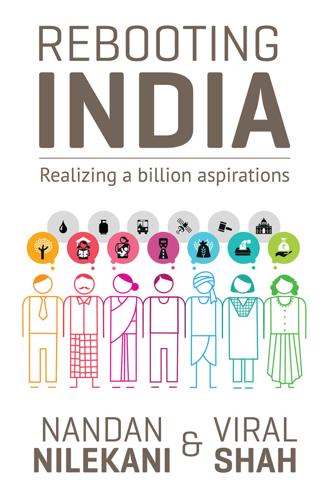
Rebooting India: Realizing a Billion Aspirations
by
Nandan Nilekani
Published 4 Feb 2016
Through DARPA—coincidentally the agency that also birthed the internet—the US government has been funding such endeavours for over a decade.15 The underlying technology has now entered the commercial space; Google is testing self-driving cars using its Google Chauffeur platform, Uber has just announced an academic collaboration with Carnegie Mellon University to ‘develop driverless car and mapping technology’, and Apple is reportedly investigating technologies for building electric and self-driving cars.16 While we may not see a fleet of self-driving cars taking over our streets in the near future, it’s worthwhile to consider that various US state governments are already starting to pass laws that permit driverless cars to operate on state roads.17 Once again, government regulations need to anticipate innovation by keeping a close eye on emerging trends and assessing their potential impact and chances of widespread adoption.
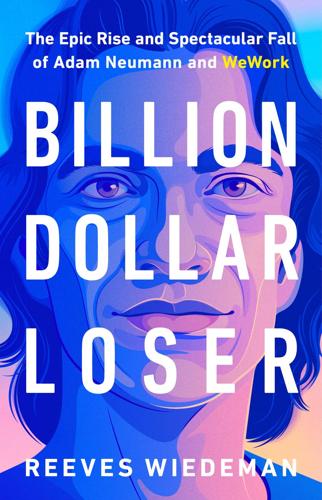
Billion Dollar Loser: The Epic Rise and Spectacular Fall of Adam Neumann and WeWork
by
Reeves Wiedeman
Published 19 Oct 2020
The company’s scattered assortment of potential business lines was distracting for the employees tasked with maintaining the blistering growth of its core office-leasing business. But the most ambitious companies of the 2010s were no longer content to do what they were best at. Google was building a driverless car. Snapchat was getting into eyewear. Amazon was starting to make movies. In 2015, Adam had a team draw up a plan for a private club on the top floor of a Manhattan tower where Goldman Sachs once had its executive suites. (WeWork had also leased the basement, where Adam thought about opening an outpost of SPIN, a Manhattan ping-pong bar.)
…
WeWork was already among the Vision Fund’s largest investments, but part of the fund’s conception was to pursue “blockbuster” deals that would pour not just billions but tens of billions of dollars into individual companies. In some ways, the strategy was a necessity. There were only so many good ideas to spend $100 billion on, and the Vision Fund already seemed to be pushing that limit: Masa was investing in food delivery, virtual reality, vertical farming, genomics, driverless cars, car rentals, dog walking, pizza-making robots, and the online sale of sports apparel. The plan Masa and Adam began sketching out would dwarf their record-setting deal from 2017. It called for SoftBank and the Vision Fund to buy out many of WeWork’s existing shareholders, from Benchmark to the Chainsmokers to the former community managers in Austin and London who had taken out loans to buy their vested options.

A New History of the Future in 100 Objects: A Fiction
by
Adrian Hon
Published 5 Oct 2020
You might not think that such a simple robot would be so influential (it can’t even make anything or talk to anyone, after all), but it turns out that moving things from A to B was an extraordinarily expensive and cumbersome business before UCS appeared. This little vehicle changed entire industries. It created millions of jobs, and it destroyed tens of millions more. How did it get there? Dr. Whittaker says: If you look at the media from the 2010s, the thing everyone was most excited about was driverless cars. However, getting all the safety and insurance regulations in place for their use on public roads took years. It was deliverbots that paved the way. They faced less opposition from lobbyists, and, frankly, they seemed less likely to cause injuries or scare people. In 2020, when UCS was founded in Toronto by Kevin Wing, it wasn’t competitive with existing shipping companies such as FedEx, DHL, and UPS, as it simply didn’t have the infrastructure.
…
It’s very similar to a previous dress she’d made herself by hand, but this dress was made, as she said, “not in a better way, just a different way.” Evans kept on designing clothes until she died at the age of ninety-six—and her friend Nagra always made sure that the right tools were ready and waiting for her. 50 CHOOSING A DRIVING PLAN United States, 2035 The driverless car revolutionized every aspect of transportation—particularly the business model. This brochure demonstrates how people struggled to come to grips with the new world: Life used to be simple. If you wanted to travel, all you had to do was buy a car and put gas in it every so often. Sure, keeping a car was expensive, and it bled value every minute you weren’t using it, and you had to pay for parking and repairs and insurance, and you wasted thousands of hours of your life in the mindless drudgery of driving, but at least you knew you had absolutely no choice in the matter.

The Inevitable: Understanding the 12 Technological Forces That Will Shape Our Future
by
Kevin Kelly
Published 6 Jun 2016
In the next 30 years we will continue to take solid things—an automobile, a shoe—and turn them into intangible verbs. Products will become services and processes. Embedded with high doses of technology, an automobile becomes a transportation service, a continuously updated sequence of materials rapidly adapting to customer usage, feedback, competition, innovation, and wear. Whether it is a driverless car or one you drive, this transportation service is packed with flexibility, customization, upgrades, connections, and new benefits. A shoe, too, is no longer a finished product, but an endless process of reimagining our extended feet, perhaps with disposable covers, sandals that morph as you walk, treads that shift, or floors that act as shoes.
…
It will sport wireless connection for driverless navigation, for maintenance and safety, and for the latest, greatest HD 3-D video entertainment. The connected car will also become the new office. If you are not driving in your private space, you will either work or play in it. I predict that by 2025 the bandwidth to a high-end driverless car will exceed the bandwidth into your home. As cars become more digital, they will tend to be swapped and shared and used in the same social way we swap digital media. The more we embed intelligence and smarts into the objects in our households and offices, the more we’ll treat these articles as social property.
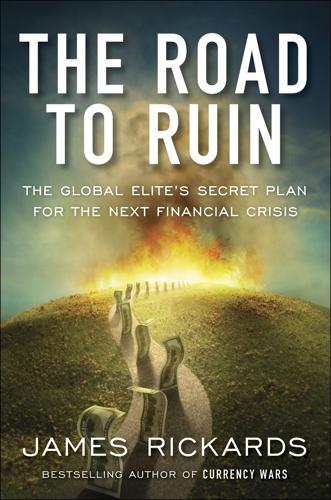
The Road to Ruin: The Global Elites' Secret Plan for the Next Financial Crisis
by
James Rickards
Published 15 Nov 2016
Your smartphone GPS signals your whereabouts between points of purchase. This information is available to government using collection standards that do not adhere to Fourth Amendment requirements of reasonableness and probable cause. Next on the horizon is the driverless car championed by Google, Tesla, and Volkswagen among others. The driverless car is not driverless, it’s just that the driver is not human. The real driver is a network of algorithms, GPS location devices, and robotics. Driverless systems are subject to government supervision. In the future, governments will deliver political opponents to detention centers by commandeering the software, locking the car doors, and conveying the car’s occupant into custody.
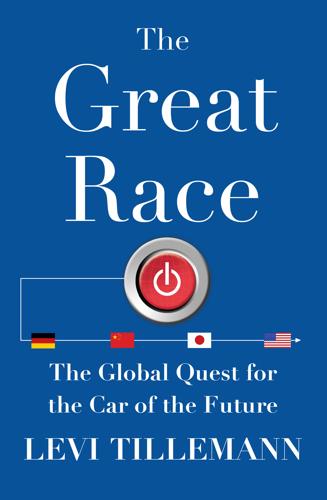
The Great Race: The Global Quest for the Car of the Future
by
Levi Tillemann
Published 20 Jan 2015
Not only electric but “driverless” autonomous vehicles are within sight. The transition to electric and driverless cars will usher forth a step change in both quality of life and economic productivity and potentially be the most transformational social development since the World Wide Web. It will change the way we live and many of the fundamentals of the global economy. That’s why America, China, and Japan are in a white-hot race for the future of transportation. Indeed, the petroleum-free EV and what Forbes called the “Trillion-Dollar Driverless Car”—those autonomous mobility pods from the SAIC-GM Expo—are just around the proverbial corner.
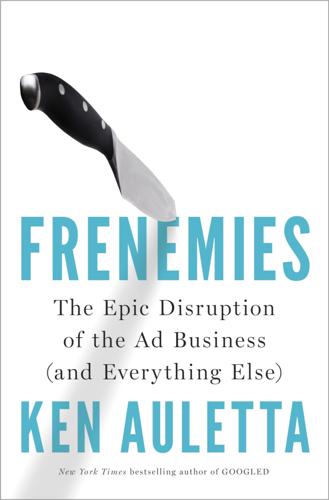
Frenemies: The Epic Disruption of the Ad Business
by
Ken Auletta
Published 4 Jun 2018
The digital giants, however, particularly Facebook and Google, might pose an existential threat. By their nature, these companies are disrupters. They want to eradicate extraneous middlemen. They may begin in one industry, but when they spot new opportunities, they seize them: Google’s tentacles spread from search to television to mobile phones to driverless cars to the Internet of things to cloud computing. Facebook went from social networking to IM to Instagram to the work of Carolyn Everson’s growing armies of marketing teams. Imagine the advantages Facebook will reap if, as Carolyn Everson predicts, it adds a Buy button to facilitate e-commerce for its advertisers.
…
They have already fundamentally transformed the ad and marketing business, and when 5G replaces 4G and 3G speeds for mobile devices sometime in the next several years, nearly matching the broadband speeds of cable or telephone fiber, the impact should be profound. A movie can be downloaded in an eyeblink. Annoying download waits will disappear, providing a boost to all video, including video ads and virtual reality. Driverless cars, which must ping other cars on the road many times each second to avoid crashes, will receive a boost, as will robotics. The varied devices that make up the Internet of things will seamlessly communicate. A decade ago, most digital content was text. By 2016, half was video and photos. Advertisers know that the most effective mobile ads engage the consumer with video.
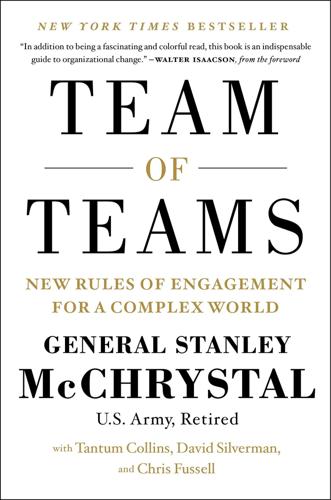
Team of Teams: New Rules of Engagement for a Complex World
by
General Stanley McChrystal
,
Tantum Collins
,
David Silverman
and
Chris Fussell
Published 11 May 2015
It doesn’t even look like they slow down. Their trajectories can be plotted in coordination with one another long before arriving at the intersection, so there is no need for the stopping and starting that characterize human behavior under similar circumstances. It looks like a death trap, but driverless cars promise to reduce traffic fatalities significantly. UT professor Peter Stone, one of the leaders of the project, notes that 25 percent of accidents and 33 percent of the thirty-three thousand auto deaths each year in America occur at intersections, and 95 percent are attributable to “human error.”
…
“Computer Scientist Developing Intersections of the Future with Fully Autonomous Vehicles,” University of Texas News, February 20, 2012, http://www.utexas.edu/news/2012/02/20/autonomous_intersec tion/. 25 percent of accidents . . . “No Lights, No Signs, No Accidents: Future Intersections for Driverless Cars,” Reuters Video, March 22, 2012, http://www.reuters.com/video/2012/03/22/no-lights-no-signs-no-accidents-future-i?videoId=232193655. 95 percent are attributable . . . “No Lights,” Reuters Video. “stereotypes are a real timesaver” . . . “Stereotypes Are a Real Timesaver,” The Onion, August 14, 2002, http://www.theonion.com/articles/stereotypes-are-a-real-timesaver,10696/.
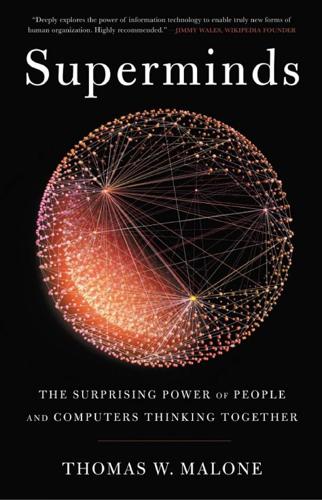
Superminds: The Surprising Power of People and Computers Thinking Together
by
Thomas W. Malone
Published 14 May 2018
They are little orange boxes about eight inches tall and about one foot square with small wheels mostly hidden on the bottom. They travel around a warehouse, insert themselves underneath a shelving unit, then lift and move the shelves (and everything they hold) to another location. Google’s newest driverless cars also don’t look like traditional cars with robots sitting in the drivers’ seats. Instead the steering wheels, brake pedals, and accelerators are gone completely. All the intelligence is hidden, along with the engine and other mechanical parts of the car, out of the passengers’ view altogether.
…
A very important benefit the guilds could provide would be a kind of unemployment insurance. In return for a percentage of your income in good times, for instance, your guild could guarantee you a minimum income in bad times. That means it would clearly be in your guild’s interest to help you learn new, marketable skills if your old job were eliminated. For instance, if driverless cars took away your job as an Uber driver, your guild might pay for you to learn to participate in online markets where you identify signs of cancer in mammograms or predict voter behavior. In any case, if your fellow guild members felt that you weren’t trying hard enough to learn new skills and find new work, they could do something government unemployment insurance programs never could: they could exert social pressure on you.
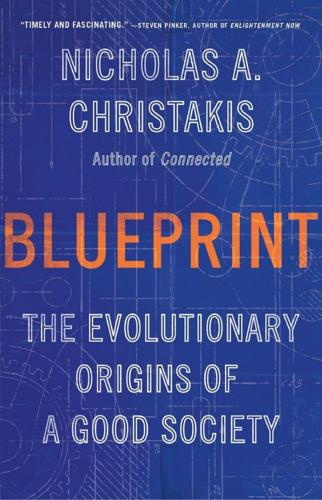
Blueprint: The Evolutionary Origins of a Good Society
by
Nicholas A. Christakis
Published 26 Mar 2019
I know it may be hard to believe, but robots make mistakes too”).67 The presence of this robot willing to admit error modified how the humans interacted among themselves, making them work better together. And consider the impact of driverless cars on the roads. Such vehicles will interact with nearby human-driven cars and will be programmed to drive in a way that reduces the likelihood of a collision.68 But a human who has driven near a driverless car for a while might wind up driving in a different way even once he or she is no longer near that car. The robotic car might create a cascade of benefits, modifying the behavior not only of drivers with whom it has direct contact but also of others with whom it has not interacted.69 Still other advances in artificial intelligence will affect our social lives.
…
That technology—whether spears or satellites—was concerned with means directed at ends humans specified. But AI has the potential of specifying its own ends, of having its own “desires.” Even more amazing, to me, is that AI might actually affect our social organization. We will increasingly be adding machines (such as driverless cars) and autonomous agents (such as online bots) to our social systems. These devices are not simply tools we will use to supplement our own efforts (like the face-recognizing glasses), but machines that might act in humanlike ways. At the moment, these devices—such as companion robots that express emotions and carry on simple conversations or online bots that spread misinformation—are still crude.
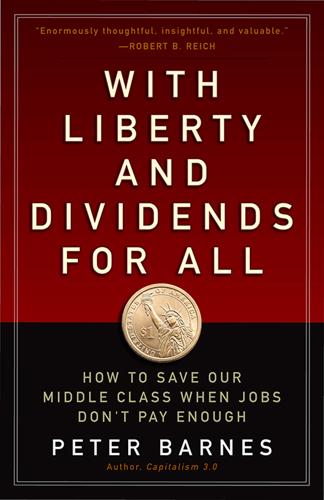
With Liberty and Dividends for All: How to Save Our Middle Class When Jobs Don't Pay Enough
by
Peter Barnes
Published 31 Jul 2014
What’s more, Foxconn, Apple’s low-wage Chinese manufacturer (and also Dell’s, Hewlett-Packard’s, and Intel’s), has broken ground on a new factory to make robots. Its goal is to “hire” one million robots, displacing hundreds of thousands of Chinese workers. “Robots don’t complain, or demand higher wages, or kill themselves,” the Economist noted wryly.14 Then there’s Apple’s neighbor Google, which along with its online services is developing a driverless car. If it catches on, it will be an awesome innovation, but not one that cab or truck drivers will like. Will FedEx stick with humans when mechanical drivers are a fraction of the cost? Not likely. And what are we to make of the “insourcing” of manufacturing jobs that has recently raised hopes in the Midwest?

In Our Own Image: Savior or Destroyer? The History and Future of Artificial Intelligence
by
George Zarkadakis
Published 7 Mar 2016
Since then DARPA has repeated the robotics challenge, to include autonomous vehicles capable of finding their way in an urban environment, as well as humanoid robots. The contestants have consistently produced better products over the years. This rapid evolution in performance is very telling of how quickly engineers can integrate new systems nowadays, and innovate. Google and others are currently developing prototype commercial driverless cars, which we should expect to become part of our everyday lives by the next decade. The other seminal event that signalled that something big was changing in the field of Artificial Intelligence took place in February 2011, and was televised. Watson – another computer developed by IBM – beat two former, human, winners of the popular American TV quiz Jeopardy!
…
Based largely on this trend, I believe that the creation of greater than human intelligence will occur during the next thirty years.’24 Ray Kurzweil adopted Vinge’s argument in a series of popular science books that explore the technological drivers, and potentially devastating impact, of superhuman Artificial Intelligence. Kurzweil marks the year 2030 as a watershed by extrapolating, like Vinge, from today’s exponential improvement of computers according to Moore’s Law:25 2030 thus becomes the year that computer complexity will surpass the complexity of information processing in the human brain. Deep Blue, driverless cars crossing the Mojave Desert, and Watson beating humans at Jeopardy! all seem to validate the arguments made by Vinge and Kurzweil. Brute computer power has made computers more ‘intelligent’. Nevertheless, underneath the correlation between powerful computing and intelligent behaviour lurk two fundamental assumptions that deserve closer examination.
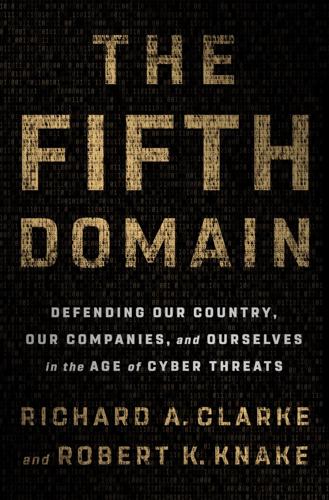
The Fifth Domain: Defending Our Country, Our Companies, and Ourselves in the Age of Cyber Threats
by
Richard A. Clarke
and
Robert K. Knake
Published 15 Jul 2019
One thing telecommunications experts agree on is that 5G will make it possible to connect many more devices, either directly or indirectly, to the internet and give all of those devices the ability to work much more rapidly. There will be no more latency, no more buffering, which will make possible more types of devices, including those that require reliable and instantaneous connectivity to the Internet of Things, such as autonomous vehicles. For autonomous vehicles, otherwise known as driverless cars, to achieve their full potential, multiple sensors and devices on each vehicle will have to communicate instantly with nearby vehicles, sensors in the road, street signs, and traffic lights. To do all of that, the vehicles will need 5G communications, fast, unbuffered, and able to handle many devices in a small space.
…
Then, they need to use their regulatory powers to require all existing devices be retrofitted with security or replaced by newly designed devices created from the ground up with security in mind. For example: The U.S. Department of Transportation has made noises about issuing regulations requiring such assurances for driverless cars. At the same time, however, that department is, without much thought to security, requiring train operators to install new IoT sensors that could literally stop trains in their tracks (so-called positive train control systems). The FDA has said that new devices should be patchable, but what about all the old ones that are out there?

New Laws of Robotics: Defending Human Expertise in the Age of AI
by
Frank Pasquale
Published 14 May 2020
Wendy Wagner, “When All Else Fails: Regulating Risky Products through Tort Regulation,” Georgetown Law Journal 95 (2007): 693, 694. 31. Wagner, “When All Else Fails.” 32. John Villasenor, Products Liability and Driverless Cars: Issues and Guiding Principles for Legislation (Brookings Institution, 2014), https://www.brookings.edu/wp-content/uploads/2016/06/Products_Liability_and_Driverless_Cars.pdf. 33. Martha T. McCluskey, “Defining the Economic Pie, Not Dividing or Maximizing It,” Critical Analysis of Law 5, no. 1 (2018): 77–98; Mariana Mazzucato, The Value of Everything: Making and Taking in the Global Economy (New York: Hachette, 2018). 34.

The Everything Blueprint: The Microchip Design That Changed the World
by
James Ashton
Published 11 May 2023
The company, based in Loughborough in the English Midlands, would be useful in the IOT world because it enabled cameras to better understand their environment and adapt to weather changes. But until that point, Arm had very little in the way of IOT technology, insiders said. Optimists countered that Arm had worked on IOT microcontrollers and explored the different ways to connect devices. Its critical contribution would be one of security: driverless cars talking to traffic lights risked lives if the communications system was hacked or faulty. All in all, IOT was a bet on a hard-to-imagine future, just as the ‘portables’ listed on Arm’s first SWOT analysis in 1990 offered no clue of the mobile-phone boom to come. Son pledged to put Arm at the ‘center of the center’ of SoftBank, boldly estimating that within 20 years one trillion Armchips would enter the market annually, a 67-fold increase compared to the 15 billion that had been shipped in 2015.19 And because SoftBank didn’t make microchips itself, it was well placed to maintain Arm’s neutrality.
…
These relatively low-level, repetitive calculations were required to render individual pixels all at once so that images were clear and lifelike. Tailored to life beyond computer games and animations, these powers could be deployed anywhere and large numbers of commands had to be processed in parallel, chewing through great volumes of data, such as in artificial intelligence and driverless cars. A 2009 research paper by a trio of Stanford University computer scientists, ‘Large-scale Deep Unsupervised Learning using Graphics Processors’, concluded that GPUs ‘far surpass the computational capabilities of multicore CPUs, and have the potential to revolutionize the applicability of deep unsupervised learning methods’.17 That meant they were ideal for machine-learning tasks that involved trying to spot patterns in reams of data and predict what came next.

When Computers Can Think: The Artificial Intelligence Singularity
by
Anthony Berglas
,
William Black
,
Samantha Thalind
,
Max Scratchmann
and
Michelle Estes
Published 28 Feb 2015
Probably the most significant in the short term will be autonomous, self-driving cars. Huge trucks have been autonomously driving around mine sites for several years. Mercedes already ships driver assist technology that senses other cars, while BMW expects to move their completely automatic freeway driving system into production by 2020. The Google driverless car has received considerable attention, but all vehicle manufactures have invested in the technology. The initial focus is on just assisting human drivers, but fully autonomous or partially remotely controlled cars are likely to be in production by 2025. Incidentally, flying an airplane turns out to be much easier for a computer to do than driving a car.
…
Mine sites can be controlled fairly tightly, but robots are now working in much more natural and unstructured environments. The first of these technologies that is likely to have widespread impact is self driving cars and trucks. Google self driving car. News www.mirror.co.uk The famous Google driverless car can negotiate urban traffic autonomously, and is purported to have covered 500,000 kilometres with only one accident caused by another car running into it from behind. What that really means is unclear because the cars also have drivers that could take over if the computer was about to cause an accident.

This Machine Kills Secrets: Julian Assange, the Cypherpunks, and Their Fight to Empower Whistleblowers
by
Andy Greenberg
Published 12 Sep 2012
In 1960, it put the first five GPS satellites into orbit. In 1969, it launched the ARPANET, a system of remotelynetworked computers that would later be renamed the Internet. In the late 1970s, it developed and flew the first stealth planes. From 2006 to 2008, DARPA organized a series of races of robotic, driverless cars through the desert. Several of the top scientists in those competitions now work for Google, where they’ve built autonomous automobiles that have driven between San Francisco and Los Angeles with no human assistance. In 2011, it tested an unmanned plane that can fly twenty times the speed of sound.
…
The site no longer exists, and given that I no longer consider the documents taken from that site to be public, I’ve treated them as my own reporting and haven’t cited them below. it put the first five GPS satellites into orbit Duncan Graham-Rowe. “Fifty years of DARPA: Hits, misses and ones to watch.” New Scientist.com, May 15, 2008. developed and flew the first stealth planes Ibid. organized a series of races of robotic, driverless cars through the desert Ibid. driven between San Francisco and Los Angeles with no human assistance “Google Cars Drive Themselves, in Traffic” The New York Times, October 9, 2010. build flying Humvees Clay Dillow. “DARPA’s ‘Flying Humvee’ Is Moving Ahead, Ready for Prototype.” Popsci.com, October, 25, 2011.
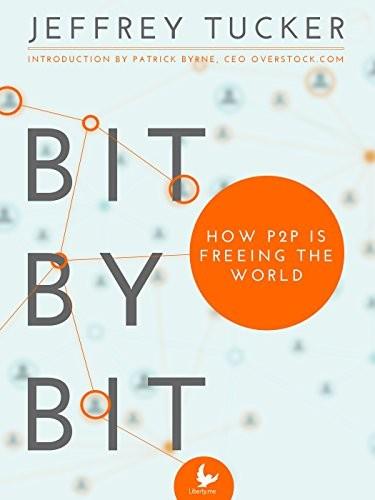
Bit by Bit: How P2P Is Freeing the World
by
Jeffrey Tucker
Published 7 Jan 2015
Spend a few minutes driving in any major city and you realize that safety concerns cannot be addressed by coerced tweaks. The entire structure of highways and the right of individuals to control their cars at all are the major safety concern—at least, this is what it would appear from the outside looking in. And speaking of innovation, the prospect of driverless cars now awaits, and these offer the chance for authentically improving safety. Will the government stop them through endless hectoring and belligerence? Government can slow down development, but they are coming regardless. As much as I love the way the potential chaos of the highways can lead to authentic order, there’s always an improvement to be made.

Blockchain Revolution: How the Technology Behind Bitcoin Is Changing Money, Business, and the World
by
Don Tapscott
and
Alex Tapscott
Published 9 May 2016
Unleashing a virus on the blockchain could be more difficult and certainly costly because it would likely have to pay the other party to interact with it, and the network would quickly identify its public key, crash its reputation score, or not validate its transactions. For positive blockchain examples, consider the following. A cloud computing service rents processing power from various sources, growing to Amazon’s size by making rental deals with other computers that have excess capacity.11 A driverless car owned by a community, company, individual, or perhaps itself moves around the city picking up and dropping off passengers and charging them appropriate fees. We’re interested in agents that can do transactions, acquire resources, make payments, or otherwise produce value on behalf of their creator.
…
Insurers could adjust payment according to where the object is and its environment—if it’s in New York’s Metropolitan Museum of Art under controlled climate, then a lower insurance rate; if traveling to Greece, then charge a higher rate. The object could tell whether it was in a vault or around a celebrity’s neck. Insurance rates could be higher if the device was hanging on Lindsay Lohan’s neck versus, say, Anne Hathaway’s. Driverless cars would surely have lower insurance rates, and devices themselves could settle insurance claims on the spot based on sensor data. 8. Document and Other Record Keeping As we have explained, physical assets can become digital assets. All documentation relating to a particular “thing” can be digitized and carried on the blockchain including patents, ownership, warranties, inspection certification, provenance, insurance, replacement dates, approvals, et cetera, significantly increasing data availability and integrity, reducing paperwork handling, storage, and loss, and other process improvements related to that documentation.

Melting Pot or Civil War?: A Son of Immigrants Makes the Case Against Open Borders
by
Reihan Salam
Published 24 Sep 2018
By his count, there are a billion people between the ages of fifteen to forty-nine whose skills earn them less than $5,000 a year at home, corrected for purchasing power, but who could make more than $20,000 in the United States.14 In other words, the United States’ potential low-skill labor pool is vast. So why, Pritchett asks, are the country’s brightest minds focused on finding ways to take human workers out of the equation? Think of the billions that have gone into driverless cars, automated checkout processes in the grocery store, and, perhaps eventually, deliveries by drone. At first glance, these projects make little economic sense. With labor as abundant as it is, it should be very cheap. Forget about leaving a $5,000-a-year job for a $20,000 one. Pritchett suggests that a 50 or 100 percent wage premium should be enough to convince a worker from a developing country to leave home.15 Why, then, hire best-in-class U.S. researchers and dump billions into R&D to build a robot when you could just hire cheaper foreign labor to do the job manually?
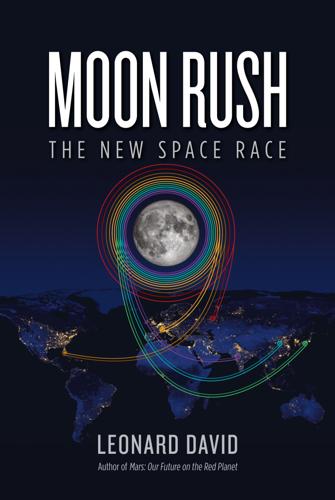
Moon Rush: The New Space Race
by
Leonard David
Published 6 May 2019
Clarke wrote that every revolutionary idea passes through three stages: It’s completely impossible. It’s possible, but it’s not worth doing. I said it was a good idea all along. Today we use the word “moonshot” to connote an ambitious, exploratory, and groundbreaking project. Google X’s “Moonshot Factory” has embraced the term for inventive initiatives like driverless cars, robots for manufacturing purposes, even life extension. They define “moonshot” as a task or idea that addresses a huge problem, proposes a radical solution, and makes use of breakthrough technology. The National Cancer Institute at the National Institutes of Health is sponsoring the “Cancer Moonshot” to accelerate cancer study and make more therapies available to more patients, while also advancing the capacity to prevent cancer and detect it at an early stage.

The Second Intelligent Species: How Humans Will Become as Irrelevant as Cockroaches
by
Marshall Brain
Published 6 Apr 2015
The last of the three is extremely important to recognize because it is imminent and has the potential to destroy the lives of millions of people if not anticipated and handled properly. Simply by looking at current news articles, we can see what is starting to happen. Here are just a few examples: Driverless cars [50] are improving rapidly, and it is easy to understand that they will begin to eliminate all the jobs held by truck drivers, taxi drivers, etc. That is a million or more jobs that will be lost. Tablets and kiosks in restaurants [51] will be eliminating many of the jobs currently held by waiters and waitresses.

Flash Count Diary: Menopause and the Vindication of Natural Life
by
Darcey Steinke
Published 17 Jun 2019
This was on Stuart Island, a location that in the rain had lost much of last summer’s charm. My fellow campers this time were a group of engineers, men in their sixties with their adult sons. In the kayak I was paired with one of the sons, a young robotics expert who nagged me to paddle harder and talked relentlessly of driverless cars run by robots. When I told him about writing this book, he asked incredulously what whales could possibly have to do with menopause. It didn’t help that my beloved J2, Granny, was dead. In October 2016, just a few months after I’d seen her, she was reported missing, and by the end of the year, listed as deceased.
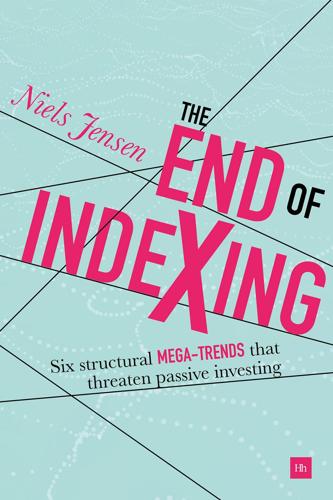
The End of Indexing: Six Structural Mega-Trends That Threaten Passive Investing
by
Niels Jensen
Published 25 Mar 2018
That said, disrupters are not always successful. It is a misconception that entrants are disruptive by virtue of their success. Success is not built into the definition of disruption. Looking ahead, disruption can only intensify, and automation is only a subset of disruptive innovations coming our way. Yes, driverless cars are not that many years away, and robots will soon be able to do what humans have done for centuries; however, there is much more to disruption than advanced robotics. For example, think Amazon and think about the extensive damage it has done to retail businesses all over the world. Before long, they may do to banks what they have done to retailers in recent years3.

The Age of Surveillance Capitalism
by
Shoshana Zuboff
Published 15 Jan 2019
Deborah D’Souza, “Big Tech Spent Record Amounts on Lobbying Under Trump,” Investopedia, July 11, 2017, https://www.investopedia.com/tech/what-are-tech-giants-lobbying-trump-era; Brodkin, “Google and Facebook Lobbyists”; Natasha Lomas, “Google Among Top Lobbyists of Senior EC Officials,” TechCrunch (blog), June 24, 2015, http://social.techcrunch.com/2015/06/24/google-among-top-lobbyists-of-senior-ec-officials; “Google’s European Revolving Door,” Google Transparency Project, September 25, 2017, http://googletransparencyproject.org/articles/googles-european-revolving-door. 109. “Google Enlisted Obama Officials to Lobby States on Driverless Cars,” Google Transparency Project, March 29, 2018, https://googletransparencyproject.org/articles/google-enlisted-obama-officials-lobby-states-driverless-cars. 110. “Tech Companies Are Pushing Back Against Biometric Privacy Laws,” Bloomberg.com, July 20, 2017, https://www.bloomberg.com/news/articles/2017-07-20/tech-companies-are-pushing-back-against-biometric-privacy-laws; “Biometric Privacy Laws: Illinois and the Fight Against Intrusive Tech,” March 29, 2018, https://news.law.fordham.edu/jcfl/2018/03/20/biometric-privacy-laws-illinois-and-the-fight-against-intrusive-tech; April Glaser, “Facebook Is Using an ‘NRA Approach’ to Defend Its Creepy Facial Recognition Programs,” Slate, August 4, 2017, http://www.slate.com/blogs/future_tense/2017/08/04/facebook_is_fighting_biometric_facial_recognition_privacy_laws.html; Conor Dougherty, “Tech Companies Take Their Legislative Concerns to the States,” New York Times, May 27, 2016, http://www.nytimes.com/2016/05/28/tech nology/tech-companies-take-their-legislative-concerns-to-the-states.html. 111.
…
The same term may mean one thing today and something very different in one year or in five years. For example, Google has been described as developing and deploying “artificial intelligence” since at least 2003, but the term itself is a moving target, as capabilities have evolved from primitive programs that can play tic-tac-toe to systems that can operate whole fleets of driverless cars. Google’s machine intelligence capabilities feed on behavioral surplus, and the more surplus they consume, the more accurate the prediction products that result. Wired magazine’s founding editor, Kevin Kelly, once suggested that although it seems like Google is committed to developing its artificial intelligence capabilities to improve Search, it’s more likely that Google develops Search as a means of continuously training its evolving AI capabilities.95 This is the essence of the machine intelligence project.

50 Future Ideas You Really Need to Know
by
Richard Watson
Published 5 Nov 2013
That’s encouraging, considering an eight-ounce jar of hazelnuts costs about nine dollars.” Jimmy Fallon, actor and comedian “Home, James” The big question, though, is when are we finally going to get behind the wheel of a driverless vehicle? Well you already can. Many airports already feature driverless trains. Indeed, much of the technology needed for driverless cars already exists. Radar cruise control, motion sensors, lane-change warnings, electronic stability control, and digital mapping are all here. The main obstacle is regulation, liability laws and our own feelings about letting go of the steering wheel. And if this makes you feel unsafe, how about pilotless commercial airliners?

The Currency Cold War: Cash and Cryptography, Hash Rates and Hegemony
by
David G. W. Birch
Published 14 Apr 2020
A Manifesto for an Intelligent Transport Policy — David Metz Britain’s Cities, Britain’s Future — Mike Emmerich Before Babylon, Beyond Bitcoin: From Money That We Understand To Money That Understands Us — David Birch The Weaponization of Trade: The Great Unbalancing of Politics and Economics — Rebecca Harding and Jack Harding Driverless Cars: On a Road to Nowhere — Christian Wolmar Digital Transformation at Scale: Why the Strategy Is Delivery — Andrew Greenway, Ben Terrett, Mike Bracken and Tom Loosemore Gaming Trade: Win–Win Strategies for the Digital Era —Rebecca Harding and Jack Harding The Currency Cold War: Cash and Cryptography,Hash Rates and Hegemony — David Birch The Currency Cold War Cash and Cryptography,Hash Rates and Hegemony David G.

Long Game: How Long-Term Thinker Shorthb
by
Dorie Clark
Published 14 Oct 2021
But we generally have a much harder time grasping the implications of exponential growth, as in the famous story of the king who agreed to an inventor’s payment terms: one grain of rice on the first square of a chessboard, two on the second, four on the third, and so on. It sounds rather modest at first. Yet by the time he got to the sixty-fourth and final square, the king owed more than eighteen quintillion grains.2 In their book Bold, Peter Diamandis and Steven Kotler discuss what they call “exponential technologies”—innovations such as driverless cars, or 3D printing, or artificial intelligence. For a long time, sometimes decades, people dismiss exponential technologies, saying they’re overhyped and ineffective. But then, on the back half of the chessboard, they suddenly pop into public consciousness and amaze everyone: Where did this come from?

Scale: The Universal Laws of Growth, Innovation, Sustainability, and the Pace of Life in Organisms, Cities, Economies, and Companies
by
Geoffrey West
Published 15 May 2017
This is a little shorter than the estimates from fits to data by Johansen and Sornette, who suggest a number more like thirty-five years. The theory cannot, of course, tell us the nature of the change, so we can only make wild speculations as to its nature. It could be something as relatively mundane as driverless cars and associated smart devices or something as dramatic as the kind of science fiction fantasy of Kurzweil and the singularists. Most likely it’s none of the above and, if we are able to make the paradigm shift, it’ll be something totally unexpected. Perhaps more likely is that we can’t make the shift, and that we will need to come to terms with the whole concept of open-ended growth and find some new way of defining “progress” or be content with what we’ve got and spend our energies raising the entire planet’s standard of living to reflect a comparably high quality of life.
…
They all rely on iterative procedures for finding and building upon correlations in data without concern for why such relationships exist and implicitly presume that “correlation supersedes causation.” This approach has become a huge area of interest and has already had a big impact on our lives. For instance, it is central to how search engines like Google operate, how strategies for investment or operating an organization are devised, and it provides the foundational basis for driverless cars. It also brings up the classic philosophical question as to what extent these machines are “thinking.” What, in fact, do we mean by that? Are they already smarter than we are? Will superintelligent robots eventually replace us? The specter of such science fiction fantasies seems to be rapidly encroaching on us.

To Save Everything, Click Here: The Folly of Technological Solutionism
by
Evgeny Morozov
Published 15 Nov 2013
Thus, Canadian legal philosopher Ian Kerr warns of the dangers inherent in the quest to “automate human virtue,” which he describes as “programming people to ‘do the right thing’ by constraining and in some cases altogether eliminating moral behavior through technology rather than ethics or law.” Kerr’s concern—and he limits his discussion mostly to recent technologies like “digital rights management” protection (found in electronic books and DVDs) and driverless cars—is that such schemes lead to a kind of “moral disability,” whereby humans put morality on autopilot and no longer cultivate any disposition for honesty. Thus, notes Kerr, “digital locks would ensure particular outcomes for property owners but would do so at the expense of the moral project of honesty.”
…
It seems counterintuitive to suggest that a deliberate attempt to behave morally—even one that would require recruiting technology to help you with the mission—will somehow compromise your morality. Granted, you won’t have a chance to express your impeccable morality at every left turn, but you have still expressed it when, unsure of your own driving abilities, you surrendered control to the car itself. Of course, there may be other reasons to oppose automated and driverless cars; for instance, they might completely devastate whatever is left of public space in America, as urban sprawl might continue even more aggressively. But this is a very different type of critique from Kerr’s concerns about automating virtue. There are perhaps good arguments to be made as to why mastering how to drive an unautomated car might be as intellectually and aesthetically stimulating as repairing a motorcycle.
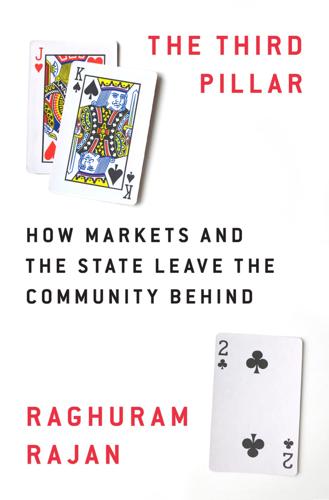
The Third Pillar: How Markets and the State Leave the Community Behind
by
Raghuram Rajan
Published 26 Feb 2019
THE DIRECT EFFECTS ON JOBS As a number of researchers have pointed out, in recent years new technologies have eliminated jobs that involved well-specified routines or simple, predictable tasks.1 For example, the Amazon Go store (opened first in Seattle) tries to create a shopping experience with no lines and no checkout counters.2 As you walk in, you use the app on your phone to register your presence, pick up what you need, and walk out. Later, your Amazon account is billed. Computer vision and machine-learning algorithms, similar to the ones used in driverless cars, help identify what you pick up and tote up your bill. Not only does this do away with checkout clerks, the underlying software has also reduced the need for someone to monitor stock levels, order new inventory, or reconcile the store’s books at the end of the day. The automated system does it all.
…
China, given its enormous access to data, is probably much further along in some aspects of artificial intelligence and machine learning than developed countries. The bulk of employment is not in high-tech sectors, though, but in older legacy manufacturing such as automobiles and steel. This is where China needs new technologies—such as electric and driverless cars and battery storage. It could acquire them by requiring foreign companies to enter into joint ventures if they want to sell in China—and the enormous size of the domestic Chinese economy now makes it a very attractive carrot—or it could buy companies abroad. Yet companies and countries are growing increasingly wary of China’s ambitions, realizing that the Chinese will improve upon any technology shared today to outcompete them tomorrow.

Buyology
by
Martin Lindstrom
Published 14 Jul 2008
A few years ago, I conducted a small experiment—a little narrower in scope than my brain-scan experiment—on my own. I taped sixty different TV car commercials produced by twenty different automotive companies. Each one had been running on TV for the past two years. Each one had a scene in which the new, shiny, and seemingly driverless car guns its way around a hairpin turn in the desert, sending up a dramatic little cloud of dust—poof. The thing is, though the make of car might have differed, that scene was exactly the same in every single commercial. Same swerve. Same turn. Same desert. Same dust cloud. Just for fun, I created a montage of these breathtakingly unmemorable moments on a two-minute reel, to see if I could tell which car was a Toyota, a Nissan, a Honda, an Audi, or a Subaru.
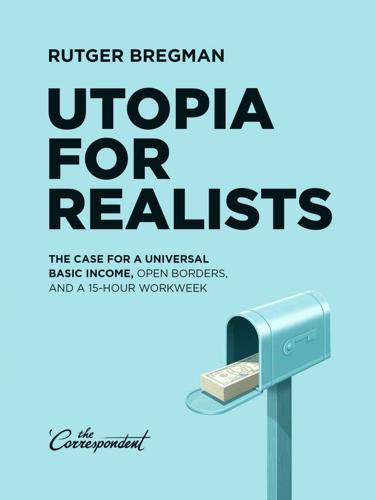
Utopia for Realists: The Case for a Universal Basic Income, Open Borders, and a 15-Hour Workweek
by
Rutger Bregman
Published 13 Sep 2014
Or the Rheobatrachus, a species of frog that went extinct in 1983 but, thanks to Australian scientists, has quite literally been brought back to life using old DNA. The Tasmanian tiger is next on this research team’s wish list, whose work is part of the larger “Lazarus Project” (named for the New Testament story of a death deferred). Meanwhile, science fiction is becoming science fact. The first driverless cars are already taking to the roads. Even now, 3D printers are rolling out entire embryonic cell structures, and people with chips implanted in their brains are operating robotic arms with their minds. Another factoid: Since 1980, the price of 1 watt of solar energy has plummeted 99% – and that’s not a typo.
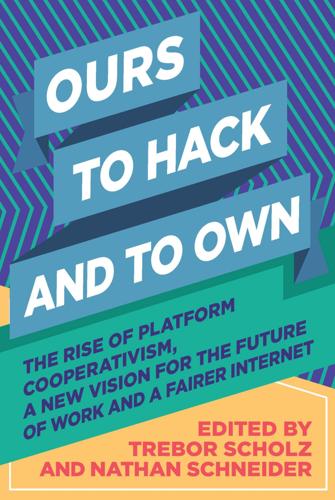
Ours to Hack and to Own: The Rise of Platform Cooperativism, a New Vision for the Future of Work and a Fairer Internet
by
Trebor Scholz
and
Nathan Schneider
Published 14 Aug 2017
The builders of emerging online platforms aim to become pervasive across all productive sectors, and to permeate every level of society: the level of the individual (with smartphones and wearable technology, lenses, glasses); the level of the home (“smart homes,” smart power meters and Internet-connected sensors); and the level of “smart cities” (driverless cars, networked transportation services; energy grids, drones, ubiquitous digital services). Platforms are reshaping not just the Internet but the economy as a whole, and governments have a responsibility to ensure that this new economy serves more than the platform-builders’ profits. We are seeing a shift of power, for instance, from service intermediaries to information intermediaries, a kind of “Uberization” of services.

Hit Refresh: The Quest to Rediscover Microsoft's Soul and Imagine a Better Future for Everyone
by
Satya Nadella
,
Greg Shaw
and
Jill Tracie Nichols
Published 25 Sep 2017
the answers might be surprising—desert farming in Australia or local banking in Dubai. Some other country or community might strive to become the world’s leader for innovations in IoT; ambient intelligence; mobile payment systems; virtual reality; silicon photonics; 3D printing; wearables; lightweight, low altitude satellites; drones; native advertising; driverless cars; robotics and industrial automation; adaptive, gamified education; nano-machines; genomics; or economical solar, wind, and tidal power. Each represents an opportunity for leadership that no single community or region has yet seized. Seattle, for example, has become the center of excellence for cloud computing as the home of both Amazon and Microsoft.
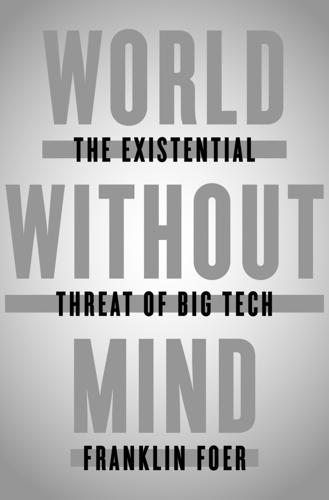
World Without Mind: The Existential Threat of Big Tech
by
Franklin Foer
Published 31 Aug 2017
Amazon, as in the most voluminous river on the planet, has a logo that points from A to Z; Google derives from googol, a number (1 followed by 100 zeros) that mathematicians use as shorthand for unimaginably large quantities. Where do these companies begin and end? Larry Page and Sergey Brin founded Google with the mission of organizing all knowledge, but that proved too narrow. Google now aims to build driverless cars, manufacture phones, and conquer death. Amazon was once content being “the everything store,” but now produces television shows, designs drones, and powers the cloud. The most ambitious tech companies—throw Facebook, Microsoft, and Apple into the mix—are in a race to become our “personal assistant.”
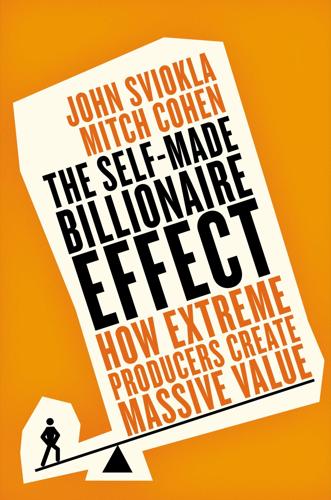
The Self-Made Billionaire Effect: How Extreme Producers Create Massive Value
by
John Sviokla
and
Mitch Cohen
Published 30 Dec 2014
Their invention, which they called Google, made it easier to find information on the Web, and served as the basis of the 1998 launch of the company. Since then, Google has evolved into an Internet behemoth known for content search, Web ad displays, video streaming (through YouTube), productivity applications, cloud storage, maps, driverless cars, and mobile devices. Page has served as Google’s CEO since 2011. Lynda Resnick b. 1944, United States Roll International (Fiji Water, POM Wonderful, Wonderful Pistachios, Teleflora) Lynda Resnick started her own ad agency in Los Angeles when she was only nineteen years old. She met Stuart Resnick, her second husband, in 1969, and ten years later the two acquired Teleflora, the flower delivery service.
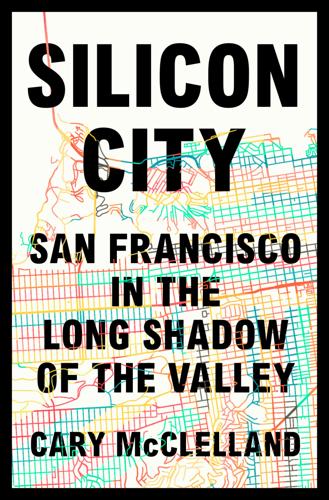
Silicon City: San Francisco in the Long Shadow of the Valley
by
Cary McClelland
Published 8 Oct 2018
What is Uber really? Why is this company worth $40 billion? People must be thinking they are going to take over the worldwide taxi industry, plus a healthy chunk of UPS and DHL and the local pizza delivery guy, too. And are they really? Now they are trying to align themselves with Google and the driverless cars, saying, This is going to be our future. I love reading, I love making love to my girlfriend, I love traveling. I’m single, and I don’t have children or anything like that. I buy books and records and that’s about it. I don’t have a car. I walk three miles to work every day. I take the Muni.

The Complete Guide to Property Investment: How to Survive & Thrive in the New World of Buy-To-Let
by
Rob Dix
Published 18 Jan 2016
With six of these, that gives us a grand total of £990 per month before tax. Life-changing? Absolutely not, but that’s not what we’re interested in for the purposes of this strategy. Instead, join me in my time machine as we travel 20 years into the future – where we’re all presumably riding around in driverless cars, you can download the contents of this book directly on to a chip in your brain, and U2 is still putting out disappointing albums. We’ve handed all our properties over to a letting agent, and barely given them a second thought. When we finally remember to check up on them, where have we ended up?

The Other Side of Happiness: Embracing a More Fearless Approach to Living
by
Brock Bastian
Published 25 Jan 2018
What is utterly mystifying is that we are increasingly seeking to numb ourselves to our daily discomforts in a world where our levels of comfort are at an all-time high. As a species, we have overcome the challenges of our environment in ways that no other animal has. We started by developing basic tools from sticks and stones and now have access to instant information via our iPhones, and driverless cars. We harnessed the power of fire to cook our food and progressed to Michelin-starred restaurants and fine wine. We outsmarted our predators and proceeded to place them in zoos. Just as we have attempted to conquer our external environment, we have also attempted to conquer our internal worlds.
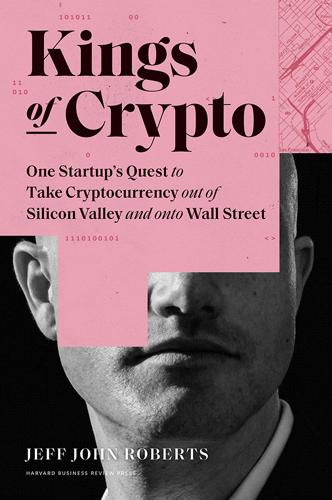
Kings of Crypto: One Startup's Quest to Take Cryptocurrency Out of Silicon Valley and Onto Wall Street
by
Jeff John Roberts
Published 15 Dec 2020
The struggle to find diverse business lines was hardly unique to Coinbase. Other tech companies in the Valley—even the biggest—still rely heavily on a core business for the bulk of their revenue, and especially their profits. This includes Google and its parent company, Alphabet, which dabbles in everything from driverless cars to human biology. Most of these bets, though, are money-losing, and it’s still search engine advertising that brings in most of the cash that powers Google. Facebook, meanwhile, has failed repeatedly to bring shopping to its platform, and its effort to crack the mobile phone market—in the form of the short-lived Facebook phone—remains one of the company’s spectacular flops.

The Rare Metals War
by
Guillaume Pitron
Published 15 Feb 2020
Fuelling this thirst for rare metals are a burgeoning global population set to reach 8.5 billion by 2030, the boom in new modes of high-tech consumption, and the growing convergence of Western and emerging economies.20 By seeking to break free from fossil fuels and turn an old order into a new world, we are in fact setting ourselves up for a new and more potent dependence. Robotics, artificial intelligence, digital healthcare, cybersecurity, medical biotechnology, connected objects, nanoelectronics, driverless cars … the most strategic sectors of the economies of the future, all the technologies that will exponentially increase our computing capacity and modernise how we consume energy, our daily routines, and even our most significant collective choices will depend entirely on rare metals. These resources will provide the fundamental building blocks of the twenty-first century.
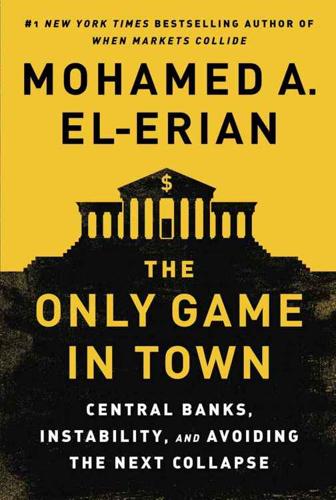
The Only Game in Town: Central Banks, Instability, and Avoiding the Next Collapse
by
Mohamed A. El-Erian
Published 26 Jan 2016
The amazing information-gathering power of the Internet, combined with the surge in smartphone technologies, provides you with powerful tools to answer more questions correctly, and much faster than most people ever imagined possible. Yet these are the same underlying forces that enable machines such as IBM’s Watson to beat humans on game shows. They are also at the basis of work on driverless cars, remote health diagnoses, and a lot more. But this is, in fact, far from a simple dichotomy. Yes, the phenomenon of a “race against the machines” is being felt in the labor market, the value of education, employment remuneration, and the composition of jobs in a modern economy.4 It is also altering the risk/return configuration for new investments, amplifying “winner takes all” effects.

Thinking Machines: The Inside Story of Artificial Intelligence and Our Race to Build the Future
by
Luke Dormehl
Published 10 Aug 2016
Today, just two of those – the pilots – remain. And they may not be around for long, either. ‘A pilotless airliner is going to come; it’s just a matter of when,’ said Boeing executive James Albaugh in 2011. No doubt seeing that as a challenge, Google has already created its Project Wing initiative, which seeks to extend its work on driverless cars to driverless commercial airlines. ‘Let’s take unmanned all the way,’ Project Wing’s leader Dave Vos said during a panel discussion at the annual conference of the Association of Unmanned Vehicle Systems International. ‘That’s a fantastic future to aim for.’ It’s tough to predict how many other industries will be disrupted thanks to Artificial Intelligence, although we can make an educated guess.
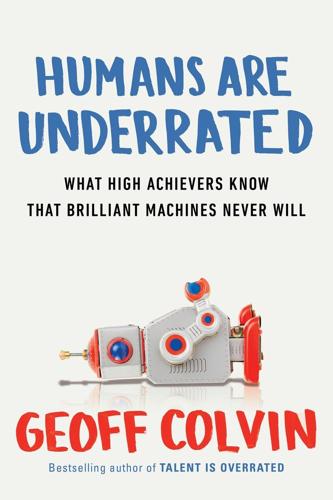
Humans Are Underrated: What High Achievers Know That Brilliant Machines Never Will
by
Geoff Colvin
Published 3 Aug 2015
The Pew Research Center Internet Project . . . Pew Research Center, “AI, Robotics, and the Future of Jobs,” August 2014. Available at: http://www.pewinternet.org/2014/08/06/future-of-jobs/. The company produced a version . . . http://www.nytimes.com/2014/05/28/technology/googles-next-phase-in-driverless-cars-no-brakes-or-steering-wheel.html?_r=0. In a world like that . . . Loukas Karabarbounis and Brent Neiman, “The Global Decline of the Labor Share,” National Bureau of Economic Research, October 2013. The authors find that “the decrease in the relative price of investment goods, often attributed to advances in information technology and the computer age, induced firms to shift away from labor and toward capital.”

We Are Bellingcat: Global Crime, Online Sleuths, and the Bold Future of News
by
Eliot Higgins
Published 2 Mar 2021
Simple: I matched the images in paused footage to Wikipedia entries, or via internet message boards that discussed munitions, or through websites that specialised in unexploded ordnance. It was time-consuming, and I had to get this right or I would lose credibility. Another rebel trend I documented was improvisation. In YouTube videos, I found driverless cars rigged with bombs and directed by remote control, along with bizarre-looking trucks converted into mobile forts with slabs of protective metal, armoured wheels and firing posts. I found a heavy machine gun mounted on a trolley; fuse-lit explosive bottles fired with an oversized slingshot; a homemade missile that looked like a hybrid of a firework and a space rocket.44 Paradoxically, my lack of Arabic could be an asset in pattern recognition.

Fully Automated Luxury Communism
by
Aaron Bastani
Published 10 Jun 2019
It is the leading edge of a transformation which will mean not only the loss of countless jobs, but entire professions. And just like the acrobatics of Atlas, nobody saw it coming – until it was right in front of them. Autonomous Vehicles In 2002 the American defence agency DARPA announced a ‘Grand Challenge’ for driverless cars scheduled to take place in the Mojave Desert in spring 2004. The proposed route was two hundred and forty kilometres long and the prize, for whichever car finished first, was set at $1 million. While some of the most brilliant minds in America applied themselves to the task, not one of the fifteen teams present at the start line was able to complete the course.

I Hate the Internet: A Novel
by
Jarett Kobek
Published 3 Nov 2016
“I was very much captivated,” said Adeline, “by news of Sergey Brin’s affair.” Sergey Brin was one of the co-founders of Google. He was married to Anne Wojcicki. Over the summer, news had broken that Sergey Brin was having an affair with an underling at Google X. Google X was an experimental lab that developed products like driverless cars, dogs that don’t need to lick their own genitals, and Google Glass. Google Glass was a wearable computer built into a pair of ugly eyeglasses. Google Glass allowed its wearers to act out their social inadequacies. They could record videos with Google Glass and alienate everyone in their surrounding vicinity.

Invisible Influence: The Hidden Forces that Shape Behavior
by
Jonah Berger
Published 13 Jun 2016
So when trying to predict the Color of the Year, or fill in the popular expression “______ is the new black,” the answer might just be slate grey. PUTTING SOCIAL INFLUENCE TO WORK Integrating similarity and difference is particularly important when managing innovation. How should a new product like the Swiffer be described? Is it a revolutionary mop? A new cleaning tool? And how should it be designed? Should seats in driverless cars face forward because that is what people are used to, even if that is no longer required? A new product or technology can be light-years ahead of the competition, but its success hinges on consumer perception. If the product seems too similar to what’s already out there, people aren’t compelled to purchase.
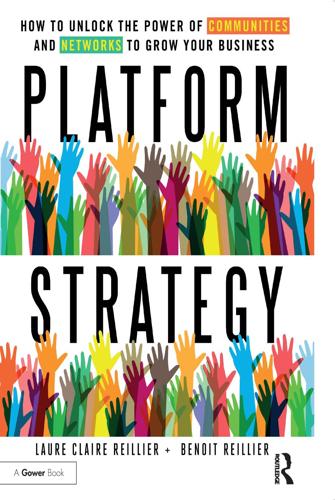
Open for Business Harnessing the Power of Platform Ecosystems
by
Lauren Turner Claire
,
Laure Claire Reillier
and
Benoit Reillier
Published 14 Oct 2017
This has forced some superstar YouTubers such as PewDiePie, who generated more than $15 million in 2016 advertising revenues alone, to disable comments on their videos.31 Despite cutting off Platform-powered ecosystems 69 Table 6.3 Google’s ecosystem GOOGLE Platform Search services 3 Retailer/ Reseller Input/Output Business Software tools for enterprise (AdWords, G Suite, etc.) 3 Software consumer tools (Gmail, Google Maps, etc.) 3 Android OS and app stores 3 Video sharing and social networking (YouTube, Google+) 3 Google hardware (glasses, chromecast, driverless cars, etc.) 3 Source: Launchworks analysis his ability to interact with fans, his decision has had no impact on his 50+ million subscriber base. YouTube has since introduced better moderation tools, but the issue of moderation is still lingering, including with YouTube Gaming, its newly launched live streaming platform for video gaming enthusiasts.32 In this category, real-time conversations are integral to the gaming experience.

The Power Law: Venture Capital and the Making of the New Future
by
Sebastian Mallaby
Published 1 Feb 2022
Uber had granted Kalanick super-voting power, so Gurley could not force him to listen.[59] If Uber had gone with a strong Series B investor, Gurley might have had a like-minded ally, but Kalanick had chosen a cheerleader. The main Series C investor was little help: Kalanick sidelined his Google board member because of Google’s plans to develop driverless cars that might compete with Uber. That left TPG’s David Bonderman as Gurley’s main support. But two votes were not enough to sway the board. There was no effective check on the chief executive. At the start of 2015, Gurley began to air his frustrations. In a long and carefully crafted essay on his blog, he laid out the problems with unicorns that put off the day when they went public.
…
An ex-employee named Susan Fowler detailed repeated instances of sexual harassment at Uber, and her complaints went viral. Kalanick attempted to apologize and regroup, hiring a pair of prestigious law firms to investigate. But before the month was over, two new crises blew up. Furious that Uber had poached one of its key scientists, Google sued the firm for stealing its driverless-car technology. Then a damning video of Kalanick surfaced, apparently confirming what many suspected: the CEO was a jerk, and Uber was a jerk company. The video, recorded by a camera on an Uber car’s dashboard, showed Kalanick in the backseat, squirming awkwardly to music and flanked by two women.
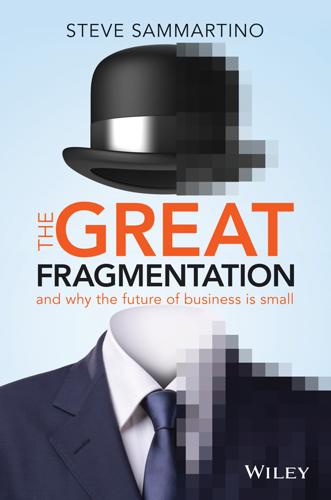
The Great Fragmentation: And Why the Future of All Business Is Small
by
Steve Sammartino
Published 25 Jun 2014
They’re escaping the cubicle and factory to build something more humane. What it means for business ‘Tell and sell’ is over. Now it’s about connecting in a non-corporate, human manner. Corporations have to start acting more like people and less like evil organisms with their own agenda. Note 1 Driverless car prediction dates by various respected auto and technology firms: www.driverless-future.com/?page_id=384 CHAPTER 6 Demographics is history: moving on from predictive marketing If you learned your marketing trade any time in the past 60 years, there’s a very good chance a large part of what you learned was related to demographic profiling, the statistical art of putting people into behaviour buckets.

Dogfight: How Apple and Google Went to War and Started a Revolution
by
Fred Vogelstein
Published 12 Nov 2013
When it’s rolled out, Google says, you’ll be able to ask your laptop, smartphone, or tablet anything—and it will respond accurately. The improvements made Siri, Apple’s voice-command technology in the iPhone, seem quaint. In August 2013 it unveiled its first Motorola smartphone. Even the products Google had no intention of selling immediately were generating enormous buzz. It demonstrated that its driverless-car software actually works. It showed that Google Glass—a computer in a pair of eyeglasses—may indeed fuse man and his machine. It’s tempting to predict that it’s only a matter of time before Apple comes back with its own new revolutionary device. Certainly that’s how the competition between the two has been up until now.

Exponential Organizations: Why New Organizations Are Ten Times Better, Faster, and Cheaper Than Yours (And What to Do About It)
by
Salim Ismail
and
Yuri van Geest
Published 17 Oct 2014
One form will come via mobile/social wallets and seamless transactions. A second will come via micropayments (probably via the block chain). The ability to move infinitesimal transaction amounts will underpin entirely new business models. Autonomous vehicles Implications: In September 2014, California will issue the first license plates for driverless cars. Starting with delivery vehicles and then taxis, predictions call for existing road capacity to increase 8-10 times once a critical mass of AVs is reached. Ridesharing is an intermediate step toward fully automated transportation, which may have a bigger visible impact on society than anything else, including sustainability, urban planning (almost no parking lots) and fewer traffic fatalities.
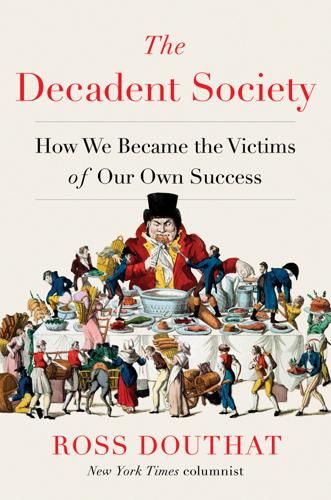
The Decadent Society: How We Became the Victims of Our Own Success
by
Ross Douthat
Published 25 Feb 2020
Yes, the Green Revolution of the 1970s made the doom-and-gloom scenarios of Paul Ehrlich, author of The Population Bomb, and likeminded alarmists look ridiculous, and enabled the econoptomist Julian Simon to win a 1980s-era famous bet with Ehrlich over whether commodity prices would rise or fall. But those same prices have risen since the 1990s, while the agricultural-yield returns to the Green Revolution have declined. Meanwhile, travel speeds have dropped and transportation innovations have been delayed and delayed, and while we may get driverless cars in some form eventually (albeit perhaps a form that can’t drive in the rain or snow), the harder limits on machine intelligence have not yet been overcome. Indeed, beneath the hype and scaremongering about artificial intelligence, there is just as much evidence that we’re actually headed for an “AI winter”—in which research funding and public interest both dry up—as there is that we’ll all be in thrall to a superintelligence soon enough.
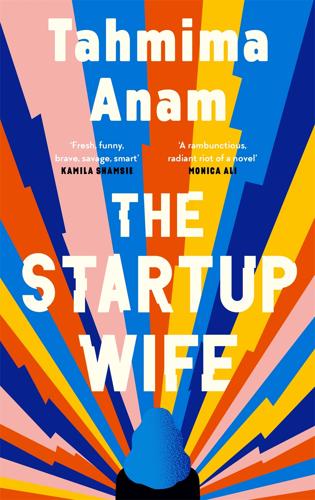
The Startup Wife
by
Tahmima Anam
Published 2 Jun 2021
“Sayonara, church,” Craig says, waving his hand and bidding farewell to millennia of organized religion. I look over at Jules, whose face is unreadable. I tell myself I’m the Miss Manhattan statue at the Brooklyn Museum so I don’t give away a single one of my thoughts. “I think you’ll like this one in particular, Craig: the CEO of Einstein X, the driverless car company that’s about to IPO—” “Jeremy Rubenfeld-Castro?” “He’s a WAIser, has been from the start, and he says that next week, when they debut at the stock market, they’re not going to ring the bell. They’re going to perform a Jupiterian ritual instead.” Cyrus puts his hands together but slightly apart, as if he’s holding a ball, and he moves it around and says something about prosperity, kabbalah, and planetary alignment.
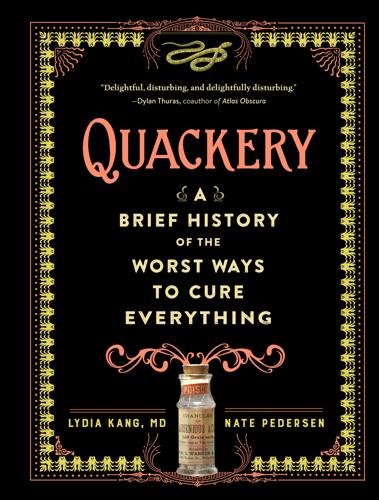
Quackery: A Brief History of the Worst Ways to Cure Everything
by
Lydia Kang
and
Nate Pedersen
Published 16 Oct 2017
And that song might possibly be More Than a Feeling, by Boston, one of the most frequently played radio songs of all time. There’s something comforting in that. In the early twentieth century, radio was the flashy new tech and had all the glamour and speculation about it that today surrounds driverless cars or even new iPhones. Thanks to recent technological advances by Italian inventor Guglielmo Marconi, who created the first commercially successful radio transmission system in 1895, the popular excitement about radio waves, coupled with the lack of understanding about exactly how they worked, made a market ripe for exploitation.

Listen, Liberal: Or, What Ever Happened to the Party of the People?
by
Thomas Frank
Published 15 Mar 2016
When Schmidt was asked what America might do to get its economy going again, the answer was predictable: “What we need to do is come up with policies which actually allow the creative people who can create value and invent new things” to do their stuff. If we put these people first, we will enjoy “huge new jobs, huge new choices of employment.” As an example of the kind of thing these people might come up with, Schmidt mentioned driverless cars, a legendary Google project that, if it is ever perfected, might make redundant everyone who drives a taxi, limo, or semi-trailer truck. The short-term effect of such an efficiency would obviously be to increase unemployment, not reduce it. In the bailout days, you might recall, people were outraged to learn that, thanks to the number of federal officials drawn from Goldman Sachs, one of its nicknames was “Government Sachs.”

The Story of Crossrail
by
Christian Wolmar
Published 5 Sep 2018
His previous books include The Subterranean Railway, a history of the London underground, Fire and Steam: How the Railways Transformed Britain, To the Edge of the World: The Story of the Trans-Siberian Railway and Railways and the Raj: How the Age of Steam Transformed India. His other work includes an analysis of transport policy, Are Trams Socialist?, and a debunking of the myths around autonomous cars, Driverless Cars: On a Road to Nowhere. Find me on Twitter Visit my website An Invitation from the Publisher Apollo is an imprint of Head of Zeus. We hope you enjoyed this book. We are an independent publisher dedicated to discovering brilliant books, new authors and great storytelling. Please join us at www.headofzeus.com and become part of our community of book-lovers.

Artificial Unintelligence: How Computers Misunderstand the World
by
Meredith Broussard
Published 19 Apr 2018
In a self-driving car, death is a feature, not a bug. The trolley problem is a classic teaching example of computer ethics. Many engineers respond to this dilemma in an unsatisfying way. “If you know you can save at least one person, at least save that one. Save the one in the car,” said Christoph von Hugo, Mercedes’s manager of driverless car safety, in an interview with Car and Driver.22 Computer scientists and engineers, following the precedent set by Minsky and previous generations, don’t tend to think through the precedent that they’re establishing or the implications of small design decisions. They ought to, but they often don’t.
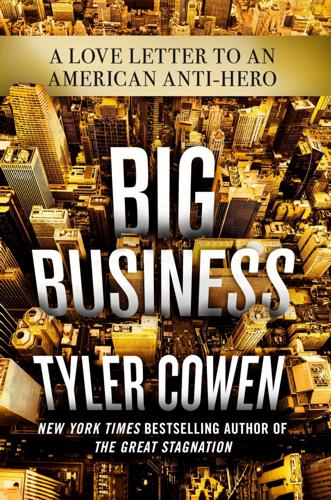
Big Business: A Love Letter to an American Anti-Hero
by
Tyler Cowen
Published 8 Apr 2019
While I don’t expect Google to become a major manufacturer of such cars, they put in key work on the underlying artificial intelligence, scanners, road mapping, programs, and other features of the service. They also helped make the idea publicly acceptable, in part by having driverless Google cars take people to work for years. While it is debated exactly when driverless cars, trucks, and buses will be ready for regular use, by now it is a debate over when rather than whether. Twenty years ago, or maybe even ten years ago, very few people expected that, and Google has helped pave the way for this progress. Self-driving vehicles arguably will be the biggest and most important technological breakthrough since the internet.

Live Work Work Work Die: A Journey Into the Savage Heart of Silicon Valley
by
Corey Pein
Published 23 Apr 2018
This brazen startup raised $50 million in several early investment rounds, then pressured state regulators and elected officials until its service was effectively legalized. With its “break laws first, buy influence later” strategy proven, Uber’s next round raised an astonishing $258 million with help from Google, which needed to “disrupt” the rules of the road if it hoped to gain approval for its driverless cars. The cash windfall fueled Uber’s global expansion. Its CEO and cofounder, Travis Kalanick, was a big fan of the novelist Ayn Rand, and at times his behavior seemed to imitate one of Rand’s infinitely selfish antiheroes. Uber tried to subvert resistance wherever it launched by ingratiating itself with politicians.

Crushing It!: How Great Entrepreneurs Build Their Business and Influence—and How You Can, Too
by
Gary Vaynerchuk
Published 30 Jan 2018
Remember when we all thought it was amazing that we could be driving along, recall that we used to love Kenny Rogers’s “Lady,” and download his greatest hits as soon as we got to our destination (because we would never do that while driving, right?). Soon, we won’t have to wait to play a song or pull over to type in a location on a map app. We’ll just tell Alexa what we want her to do, and she’ll do it. Finally, texting and driving will be a thing of the past—unless we’re in our driverless cars. Skills 201 There is no Skills 201. The feature is so new, we’re only just now identifying best practices. I hope you’ll share yours with me as you discover them and explore all the exciting possibilities in this space. Hit me up at @garyvee. My intuition is that all the brands in the how-to space will flock to Voice-First by 2020, and they will battle to be the ones chosen to teach people to make cookies and pair wine and get better at chess and clean carpets.
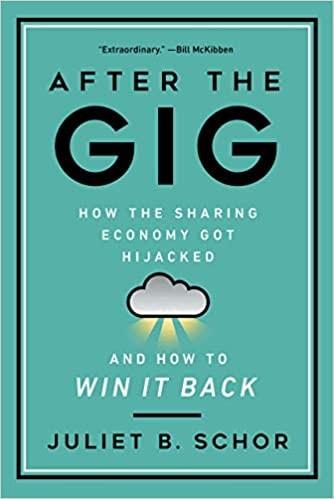
After the Gig: How the Sharing Economy Got Hijacked and How to Win It Back
by
Juliet Schor
,
William Attwood-Charles
and
Mehmet Cansoy
Published 15 Mar 2020
Nearly $20 billion in Uber losses includes $14 billion from 2014 to 2018 (Horan 2019a), plus nearly $5 billion in the third quarter of 2019 (Newcomer 2019). 64. Horan (2019b). 65. The 41 percent subsidy is from Horan (2016). 66. Smith (2018). 67. In its IPO documents Uber named public transport as a competitor. Uber Technologies, Inc. (2019). 68. Conger (2019). 69. The oft-repeated hope that driverless cars will make ride-hail profitable ignores Uber’s dismal record in this area to date, as well as the large expensive capital investment required, unlike the two-sided platform model where drivers bear the cost of vehicles. 70. Ramsey (2019). 71. Smith (2018). 72. Sustainable Economies Law Center, www.theselc.org. 73.

How to Fix the Future: Staying Human in the Digital Age
by
Andrew Keen
Published 1 Mar 2018
In fact, Wojcicki boasts, the origins of some of Google’s most influential ideas can be traced to her child-rearing strategies. So, for example, “Larry and Sergei got their twenty-percent rule from my daughters,” she says, speaking of Google’s corporate policy of requiring its staff to invest 20 percent of their time in what it calls “moonshot” projects, such as driverless cars, delivery drones, smart homes, and robots.21 But to her, Sergei Brin and Larry Page are also models of risk-takers unafraid of failure who are able to “think outside the box.” “Both Sergei and Larry went to Montessori schools, so they’ve always set out to accomplish what everyone told them couldn’t be done,” Wojcicki, an admirer of Maria Montessori’s teaching method, reminds me.
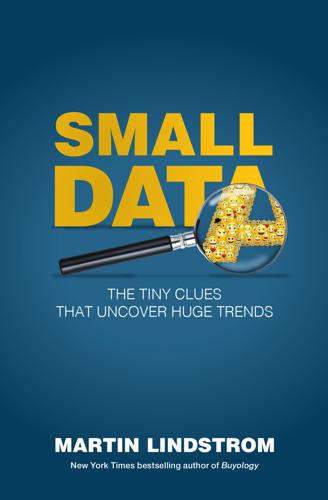
Small Data: The Tiny Clues That Uncover Huge Trends
by
Martin Lindstrom
Published 23 Feb 2016
Ian Urbana, “The Secret Life of Passwords,” New York Times Magazine, November 19, 2014, http://www.nytimes.com/2014/11/19/magazine/the-secret-life-of-passwords.html. 14. Nicole Laskowski, “Seven Big Data Failures to Watch Out For,” SearchCio, TechTarget, August 12, 2015, http://searchcio.techtarget.com/news/4500251611/Seven-big-data-failures-to-watch-out-for. 15. Matt Richtel, and Doughery, Conor, “Google’s Driverless Cars Run into Problem: Cars with Drivers,” the New York Times, September 1, 2015. 16. Von Bettina Höchli, Karin Frick, Mirjam Hauser, “We-Dentity: Wie Das Netzwerk-Ich die Wirtschaft und Gesellschaft von Morgen Verandert,” University of Zurich, Gottlieb Duttweiler Institute of Economic and Social Studies, GDI Studie #42, @copyright GDI 2015.

The Sharing Economy: The End of Employment and the Rise of Crowd-Based Capitalism
by
Arun Sundararajan
Published 12 May 2016
Once the technology associated with “e-hail” is commoditized, the potential for a worker cooperative appears to be in place, since each local market is contestable, as I discussed in chapter 5. The emergence of Swift, a platform owned by drivers, may be an early leading indicator.31 (At least until the fleets of driverless cars take over.) Many active participants in the sharing economy see the sharing of the wealth as a moral imperative; others suggest it makes good business sense. In a 2014 Fast Company article, Lisa Gansky summarized the early evolution of the sharing economy by indicating that “early companies like Uber, Lyft, Quirky, Airbnb, TaskRabbit, RelayRides, and 99 Designs garnered much visibility, but these companies were funded by venture capital, with an eye on big paydays for investors—and not necessarily for the drivers, hosts, creators, and sellers that make the companies viable.”
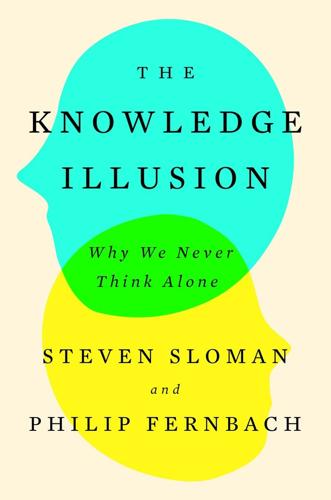
The Knowledge Illusion
by
Steven Sloman
Published 10 Feb 2017
And the automation revolution is just beginning: Completely automated cars are no longer science fiction. In late 2015, Elon Musk, CEO of Tesla Motors, stated that the technology for full automation will be perfected in about two years, though it may take government regulators longer to work out the legal issues before driverless cars start taking over the roads. With larger vehicles, technology has already changed the playing field. Modern airplanes simply cannot be flown without the help of automation. The most advanced military jets are fly-by-wire: They are so unstable that they require an automated system that can sense and act many times more quickly than a human operator to maintain control.
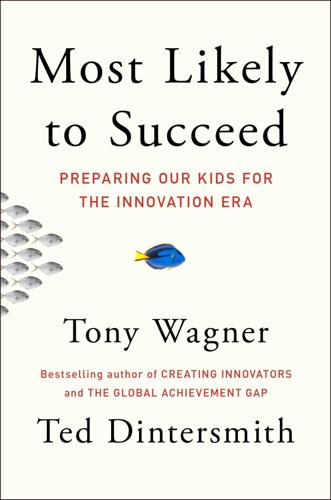
Most Likely to Succeed: Preparing Our Kids for the Innovation Era
by
Tony Wagner
and
Ted Dintersmith
Published 17 Aug 2015
Dempsey spearheaded a complete overhaul of all training programs in the army in order to make every soldier an innovator, believing that with the right training, “[A] second lieutenant in a mountain pass in Afghanistan can often do more to advance the mission in a very strategic way than can a four-star general in Kabul.” He went on to tell Tony that traditionally, West Point cadets wanted “to know what the answer is, what you are looking for.” Now, the aim is to graduate cadets who can think strategically. A dozen emerging innovations that will send tremors through our labor force: * * * • Driverless cars are now three times safer than vehicles operated by careful human drivers. • Software applications can take raw data and write newspaper stories or business reports indistinguishable from those of journalists or analysts. • Personal robots are replacing healthcare providers on hospital floors, in nursing homes, and even in private residences

Frugal Innovation: How to Do Better With Less
by
Jaideep Prabhu Navi Radjou
Published 15 Feb 2015
Many of these disruptive digital ventures are being launched by millennials (popularly known as generation recession), who can raise capital on crowdfunding sites such as Kickstarter, KissKissBankBank and MedStartr. Digital disrupters are not all young bootstrap entrepreneurs. Technology heavyweights including Apple, Google, Cisco and IBM are investing heavily in driverless cars, smart grids, connected homes and consumer medical devices. A massive shakeout in the automotive, construction, energy, health-care and other mature industries seems imminent. When asked who her company’s main competitor would be in five years’ time, a senior executive at a large US industrial firm answered: “Google.”

AI Superpowers: China, Silicon Valley, and the New World Order
by
Kai-Fu Lee
Published 14 Sep 2018
In the United States, in contrast, we build self-driving cars to adapt to our existing roads because we assume the roads can’t change. In China, there’s a sense that everything can change—including current roads. Indeed, local officials are already modifying existing highways, reorganizing freight patterns, and building cities that will be tailor-made for driverless cars. Highway regulators in the Chinese province of Zhejiang have already announced plans to build the country’s first intelligent superhighway, infrastructure outfitted from the start for autonomous and electric vehicles. The plan calls for integrating sensors and wireless communication among the road, cars, and drivers to increase speeds by 20 to 30 percent and dramatically reduce fatalities.

Insane Mode: How Elon Musk's Tesla Sparked an Electric Revolution to End the Age of Oil
by
Hamish McKenzie
Published 30 Sep 2017
In June 2016, the National Association of City Transportation Officials, a coalition of officials from dozens of large North American cities, published a policy statement that included a series of safety- and civic-minded recommendations, such as capping inner-city speeds for autonomous vehicles at twenty-five miles an hour and offering federal and state incentives to cities that prioritize self-driving electric cars that can be shared. And that September, the Obama administration issued guidelines that covered how driverless cars should behave in the case of a system failure, how they should preserve digital security, how cars should communicate with passengers, and how occupants should be protected in crashes. While unveiling the guidelines, the head of the National Economic Council said that highly automated vehicles will “save time, money, and lives.”
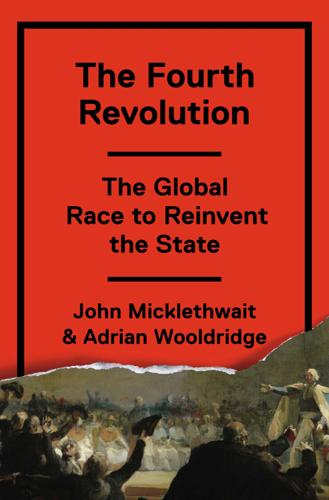
The Fourth Revolution: The Global Race to Reinvent the State
by
John Micklethwait
and
Adrian Wooldridge
Published 14 May 2014
But there is nothing kindergartenish about the company’s success: Google has grown from an inspired hunch of two Stanford students in 1998 to a veritable Googlezilla that controls 80 percent of all searches online, dominates online advertising, and is even promising to revolutionize Sloan’s old business with the driverless car. Only 1 percent of applicants to the company are given a job. They work much longer hours than the GMers of old (who, to Sloan’s disapproval, were not averse to three-martini lunches and leisurely golf games), and to keep them at work, Google provides them with everything they need, from dry cleaners and masseurs to Wi-Fi–equipped company buses.
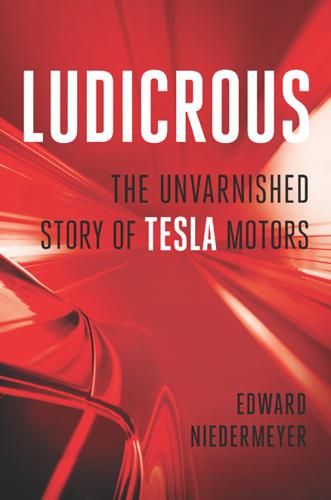
Ludicrous: The Unvarnished Story of Tesla Motors
by
Edward Niedermeyer
Published 14 Sep 2019
He even slipped up in the Autopilot release press conference, saying, “It’s $2,500 to activate the autonomous features forever,” after repeatedly insisting Autopilot was not autonomous. In the Tesla blog post announcing the release of Autopilot capabilities, the company stated, “While truly driverless cars are still a few years away, Tesla Autopilot functions like the systems that airplane pilots use when conditions are clear. The driver is still responsible for, and ultimately in control of, the car.” Musk echoed the warning at a press event announcing the new feature, while introducing the first hints of ambiguity that would prove so problematic.

Life After Google: The Fall of Big Data and the Rise of the Blockchain Economy
by
George Gilder
Published 16 Jul 2018
In July 2015, the house in Atherton that Balaban, Austin Russell, and Thomas Sohmers were renting finally sold for its $10 million asking price. At the same time, Sohmers caught the eye of Thiel’s prestigious Founders Fund. Thiel put up $2 million to tape-out Sohmers’s new chip at Taiwan Semiconductor Manufacturing Company. Meanwhile, venture money from Thiel, 1517, and other funds rolled in for Russell’s “stealth” driverless car project up at Pony Tracks. And Balaban found an unexpected direction. The month before, Chris Olah, Vitalik Buterin’s high school friend who beat him to the Thiel Fellowship and was now an intern at Google Brain, published a blog post with two Google software engineers. It was titled “Inceptionism: Going Deeper into Neural Networks.”2 The name itself was multilayered—a reference to the neural net architecture they were using, which in turn was a reference to an Internet meme about “going deeper,” which in turn was a quotation from the 2010 Christopher Nolan film Inception, in which a thief tunnels through other people’s dreams.

Upgrade
by
Blake Crouch
Published 6 Jul 2022
Beth pulled the door closed after her and started down the flagstones toward the street. This was my moment. But as I reached to open the car door, headlights appeared in the distance, the light scattering across the raindrops that were sliding down the windshield. I waited, watching as the driverless car pulled to the curb. Beth opened the rear passenger door and climbed in. After two miles, Beth’s ride-share stopped in front of a restaurant called La Fleur, where we’d eaten together on a handful of special occasions. It was an anniversary and birthday place. A trying-to-impress-someone place with a synthetic-free menu and stupefying prices.
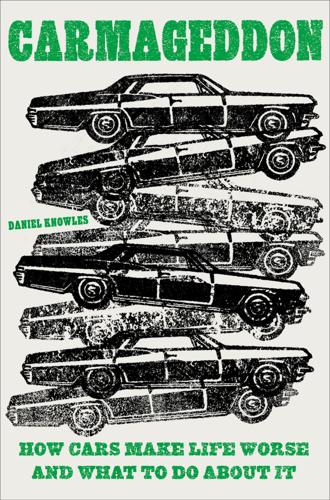
Carmageddon: How Cars Make Life Worse and What to Do About It
by
Daniel Knowles
Published 27 Mar 2023
Even in American cities like Phoenix, Arizona, where Google has experimented with its Waymo self-driving car project, they are yet to be proven to be safe. Tesla’s self-driving features—its so-called autopilot—have led to so many crashes that the National Transportation Safety Board encouraged the firm to turn it off. “It’s time to stop enabling drivers in any partially automated vehicle to pretend that they have driverless cars,” said its chairman, Robert Sumwalt, in 2020. (In January 2021 Tesla responded by releasing a car with a video game console built in, which drivers can use while their car is moving—essentially two middle fingers stuck up at the regulators.) That is why most of the attempts to develop truly self-driving cars have proven so difficult.
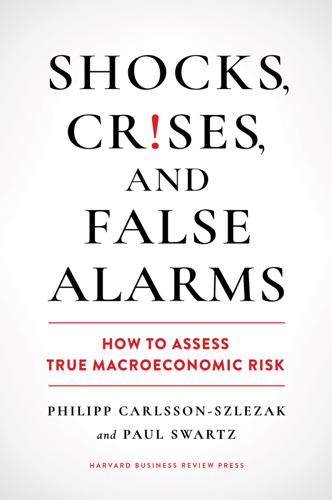
Shocks, Crises, and False Alarms: How to Assess True Macroeconomic Risk
by
Philipp Carlsson-Szlezak
and
Paul Swartz
Published 8 Jul 2024
Consider four factors that will impact the timing of such gains: Technological maturity. Is the technology ready to have impact at scale? Though technological breakthroughs often seem within reach, timelines are routinely overstated. Take the example of driverless technology—which we already encountered in our analysis of the taxi in the previous chapter. Driverless cars are many years behind schedule. In October 2016 Elon Musk made public claims about the self-driving capabilities of Tesla cars. As of 2023 these claims had not only failed to materialize but had also led to federal civil and criminal investigations.2 Driverless taxis now operate in San Francisco and a few other cities, but the timeline for truly widespread adoption remains unclear.
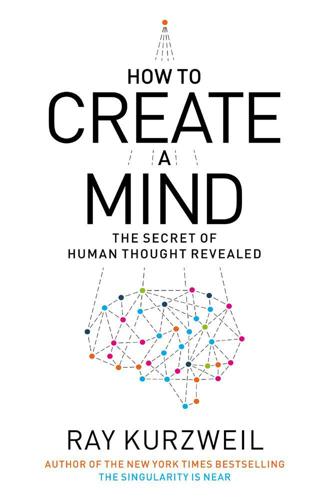
How to Create a Mind: The Secret of Human Thought Revealed
by
Ray Kurzweil
Published 13 Nov 2012
For example, consider Google’s self-driving cars (which as of this writing have gone over 200,000 miles in cities and towns), a technology that will lead to significantly fewer crashes, increased capacity of roads, alleviating the requirement of humans to perform the chore of driving, and many other benefits. Driverless cars are actually already legal to operate on public roads in Nevada with some restrictions, although widespread usage by the public throughout the world is not expected until late in this decade. Technology that intelligently watches the road and warns the driver of impending dangers is already being installed in cars.

Only Humans Need Apply: Winners and Losers in the Age of Smart Machines
by
Thomas H. Davenport
and
Julia Kirby
Published 23 May 2016
It’s important to note, however, that the same rules that constrain automation in your industry can end up serving you well, if your own strategy aims for augmentation. For example, developers of automated transportation solutions—think self-driving cars—face something between a thicket and a morass of regulations. Although it’s now pretty clear that the technical capabilities for driverless cars, trucks, and golf carts are already mastered or masterable, it’s not at all obvious when the regulatory structure will allow them on highways and fairways. Companies like Google and Tesla, as well as automotive industry mainstays Ford, General Motors, and Mercedes, could find that they have put a lot of energy into developing vehicles that drive themselves but are stuck with regulations that require an alert driver with hands on the steering wheel and feet on the pedals.

Free Money for All: A Basic Income Guarantee Solution for the Twenty-First Century
by
Mark Walker
Published 29 Nov 2015
We are on the cusp of being able to get the inventory from factory to warehouse robotically. In some advanced warehouses, Kiva robots are directed by a computer program to select inventory from the warehouse shelves and bring it to human workers who actually place the items into boxes for shipping. On the transportation end, Google has software for driverless cars. Of course, legal restrictions still require a human driver to be present who is capable of taking over the wheel, but the software is already so good that experimental vehicles have gone hundreds of thousands of miles without any human intervention. The safety record of this software already exceeds that of the average human driver.

Revolution Française: Emmanuel Macron and the Quest to Reinvent a Nation
by
Sophie Pedder
Published 20 Jun 2018
In the first half of 2017 it became the biggest carmaker in the world. ‘A few years ago the motor industry was said to be the steel of the 21st century, but today there’s an incredible effervescence in the sector,’ Jacques Aschenbroich, head of Valeo, which makes high-tech automotive parts such as sensors for driverless cars, told me.1 In 2017 half of Valeo’s orders were for products that had not existed three years previously. Yet for all this creativity, corporate France has not fulfilled its potential, and in some respects has been losing ground. Most of the big French companies have been around for a very long time.
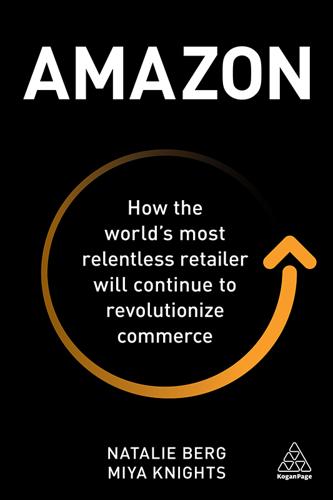
Amazon: How the World’s Most Relentless Retailer Will Continue to Revolutionize Commerce
by
Natalie Berg
and
Miya Knights
Published 28 Jan 2019
Big Data, generated as the result of increasingly pervasive interfaces that encourage users to digitize more of their lives, from music and messages to memories, feeds these systems with varied and potentially unstructured data needed to derive insight from innumerable ‘what if?’-type scenarios. The most significant manifestation of the drive towards increasingly autonomous computing systems is AI. In turn, AI has made checkout-less stores, robotics, driverless cars, drones and voice assistants a reality, and we have only begun to tap its potential. Indeed, market research firm The Insight Partners has predicted that AI spending in retail will exceed US $27.2 billion by 2025, growing at 49.9 per cent CAGR from an estimated $712.6 million in 2016.2 It is no accident, therefore, that AWS, the massive amounts of data Amazon already has on its customers, and its relentless pursuit of simplification in the name of innovation, has supported the company’s dominance in the rapidly emerging area of AI and its application through voice systems.
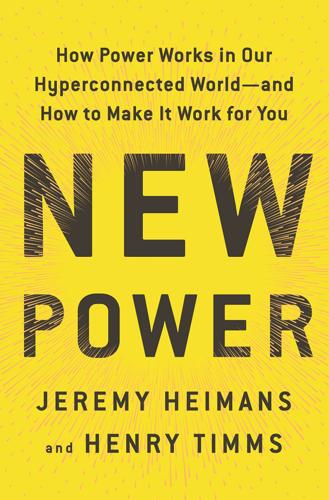
New Power: How Power Works in Our Hyperconnected World--And How to Make It Work for You
by
Jeremy Heimans
and
Henry Timms
Published 2 Apr 2018
Over time, Lyft has mostly ditched the mustaches and the fist-bumping, but still positions itself as trying to get closer to its drivers, and its riders. Uber is defined by its remoteness—with a cutthroat “bro” culture that has created a toxic relationship with its key constituents and led to the downfall of founder and CEO Travis Kalanick. A typical comment from Kalanick, anticipating driverless cars, summed up the company’s attitude, casting its drivers as little more than a cost center: “The reason Uber could be expensive is because you’re not just paying for the car—you’re paying for the other dude in the car.” Yet the Uber story goes much deeper than the personal failings of Kalanick.

Artificial Intelligence: A Guide for Thinking Humans
by
Melanie Mitchell
Published 14 Oct 2019
Clarke, 2001: A Space Odyssey (London: Hutchinson & Co, 1968). 17. Ibid., 192. 18. N. Wiener, “Some Moral and Technical Consequences of Automation,” Science 131, no. 3410 (1960): 1355–58. 19. J. J. Thomson, “The Trolley Problem,” Yale Law Journal 94, no. 6 (1985): 1395–415. 20. For example, see J. Achenbach, “Driverless Cars Are Colliding with the Creepy Trolley Problem,” Washington Post, December 29, 2015. 21. J.-F. Bonnefon, A. Shariff, and I. Rahwan, “The Social Dilemma of Autonomous Vehicles,” Science 352, no. 6293 (2016): 1573–76. 22. J. D. Greene, “Our Driverless Dilemma,” Science 352, no. 6293 (2016): 1514–15. 23.

The Coming of Neo-Feudalism: A Warning to the Global Middle Class
by
Joel Kotkin
Published 11 May 2020
BBC, February 22, 2017, https://www.bbc.com/news/technology-37384152. 6 Greg Ferenstein, “Silicon Valley’s political endgame, summarized in 12 visuals,” Medium, November 5, 2015, https://medium.com/the-ferenstein-wire/silicon-valley-s-political-endgame-summarized-1f395785f3c1. 7 Geoff Nesnow, “73 Mind-blowing Implications of Driverless Cars and Trucks,” Medium, February 9, 2018, https://medium.com/@DonotInnovate/73-mind-blowing-implications-of-a-driverless-future-58d23d1f338d; Steve Andriole, “Already Too Big to Fail—The Digital Oligarchy Is Alive, Well (& Growing),” Forbes, July 29, 2017, https://www.forbes.com/sites/steveandriole/2017/07/29/already-too-big-to-fail-the-digital-oligarchy-is-alive-well-growing/#71125b7667f5. 8 Marisa Kendall, “Tech execs back California bill that aims to build more housing near transit,” Mercury News, January 25, 2018, https://www.mercurynews.com/2018/01/24/tech-execs-back-bill-that-aims-to-build-more-housing-near-transit/. 9 Ferenstein, “Silicon Valley’s political endgame, summarized in 12 visuals.” 10 Nellie Bowles, “Dorm Living for Professionals Comes for San Francisco,” New York Times, March 4, 2018, https://www.nytimes.com/2018/03/04/technology/dorm-living-grown-ups-san-francisco.html; Emmie Martin, “Facebook and Google are both building more affordable housing in Silicon Valley,” CNBC, July 10, 2017, https://www.cnbc.com/2017/07/07/facebook-and-google-are-building-affordable-housing-in-silicon-valley.html; Avery Hartmans, “Facebook is building a village that will include housing, a grocery store and a hotel,” Business Insider, July 7, 2017, https://www.businessinsider.com/facebook-building-employee-housing-silicon-valley-headquarters-2017-7. 11 Ben Tarnoff, “Tech’s push to teach coding isn’t about kids’ success—it’s about cutting wages,” Guardian, September 21, 2017, https://www.theguardian.com/technology/2017/sep/21/coding-education-teaching-silicon-valley-wages. 12 Gerard C.

Artificial Whiteness
by
Yarden Katz
Alongside sweeping objections to the use of narrow domains, Dreyfus also posits milestones for AI, such as playing chess as well as grandmasters or driving a car. These challenges have made it easier to dismiss Dreyfus’s critique with time, especially today when many seem to believe that roads dominated by driverless cars are around the corner. The embrace of pragmatic utility is a general weakness of Dreyfus’s critique, as it is clearly possible to build systems premised on epistemic forgeries that still make for useful products. Despite holding a privileged place for applications, however, Dreyfus’s critique remains rather abstract.

Hype: How Scammers, Grifters, and Con Artists Are Taking Over the Internet―and Why We're Following
by
Gabrielle Bluestone
Published 5 Apr 2021
I just kept trying and then I succeeded.’” It reminds me of something a commencement speaker for the Baruch College graduating class of 2017 once said about the importance of believing in yourself in a world where the Elon Musk types inevitably end up ahead. “As exciting as technology might be, as exciting as driverless cars or flying to...space, I want us to never forget that the future, while leveraging technology, lies in ourselves. It is us who will blaze the path forward, paved not with algorithms, not with software, but with values. With friendship. With common goals, and most importantly, with humanity,” he said.
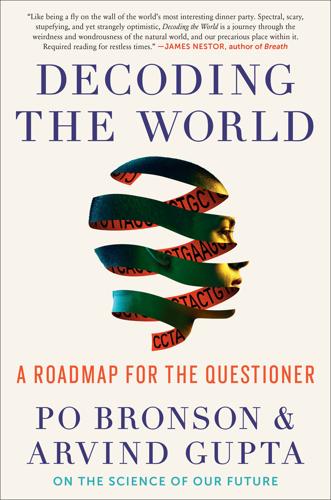
Decoding the World: A Roadmap for the Questioner
by
Po Bronson
Published 14 Jul 2020
Warp-Speed Impulse entails this tendency to immediately extrapolate into the far-off dystopian future. In the case of bees, dire predictions about a world without bees. We see this warp-speed impulse all the time. When CRISPR was invented, almost immediately people were talking about the future horror of designer babies. The driverless car led people to impulsively jump ahead to a future without jobs. A single blood-sharing study in mice, in which the older mouse grew younger, led everyone to race ahead to contemplating a society where everyone lives to 150. Not all of it is dystopian; when checkpoint inhibitor immunotherapy was invented, people started predicting a future without cancer.

British Rail
by
Christian Wolmar
Published 9 Jun 2022
They airily dismissed any doubts about the ability of tunnels to accommodate road traffic, suggesting that coaches, in particular, would be able to speed along these dedicated highways. Much as today’s media laps up outlandish notions of congestion-busting and safety-enhancing new forms of transport, such as driverless cars, delivery by drone and hyperloops, coverage of the Conversion League was remarkably uncritical. A failure to ask searching questions of its promoters resulted in the concept being picked up by a handful of serious and influential players. In particular, Peter Hall, a media-savvy professor of geography at Reading University, who later became a nationally respected authority on planning, expressed support for the concept.
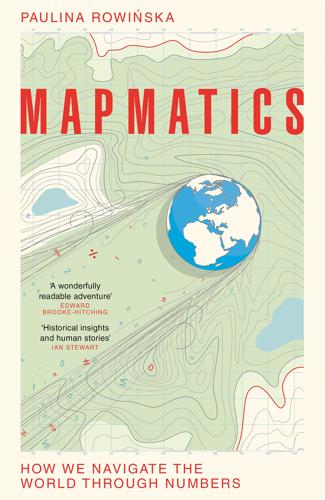
Mapmatics: How We Navigate the World Through Numbers
by
Paulina Rowinska
Published 5 Jun 2024
In 2009, Google took on the challenge of developing autonomous cars and, after less than a decade, any interested resident or visitor in Phoenix, Arizona, could hail a self-driving car with a simple click on an app. Today, fully autonomous taxis are a popular mode of transportation in Phoenix and San Francisco, due to their novelty, convenience, and low cost – although Sam points out that ‘you’re paying for it with the risk that it could kill you’. But they add that driverless cars seem to drive more safely than human drivers – if anything, the car will err on the side of caution, stopping completely when unsure how to proceed. To replace a human driver’s eyes, ears and thinking patterns, a self-driving car combines information from multiple sources. Just as a person behind the wheel subconsciously merges her pre-existing knowledge of the area, her driving experience and whatever she sees and hears in the moment, a machine uses very precise maps updated with real-time information from lidars,* radars, cameras and other sensors.* Together, they allow the car to make quick decisions in any situation it might encounter on the road.

Supremacy: AI, ChatGPT, and the Race That Will Change the World
by
Parmy Olson
In December 2019, Page stepped down completely and Sundar Pichai became the CEO of Alphabet. It was the clearest sign yet that the company was growing up and acting more like a traditional corporation. For years, Google’s freewheeling founders Page and Sergey Brin had dabbled in moonshot ideas like driverless cars, wearable computers, and a project that aimed to conquer death, but none of those businesses were making real money. In 2019, the moonshot businesses had earned about $155 million in revenue, and cost the company close to $1 billion, according to the Wall Street Journal. Meanwhile Google’s search business, along with its web browser Chrome, its hardware unit, and YouTube, was bringing in about $155 billion a year in revenue.

The Liberation Line: The Untold Story of How American Engineering and Ingenuity Won World War II
by
Christian Wolmar
Published 15 Dec 2024
And my gratitude as ever to my wife, Deborah Maby, for her support and ideas. Discover Your Next Great Read Get sneak peeks, book recommendations, and news about your favorite authors. Tap here to learn more. Also by Christian Wolmar Blood, Iron & Gold British Rail Broken Rails Cathedrals of Steam Down the Tube Driverless Cars: On a Road to Nowhere Engines of War Fire & Steam Forgotten Children The Great British Railway Disaster The Great Railway Revolution The Iron Road On the Wrong Line Railways Railways & the Raj A Short History of Trains Stagecoach The Story of Crossrail Subterranean Railway To the Edge of the World NOTES INTRODUCTION 1.

Utopia Is Creepy: And Other Provocations
by
Nicholas Carr
Published 5 Sep 2016
The Valley guys are a little nervous about the optics of their pastime—“Try to tone down the rich guy hobby thing,” angel investor and ex-Googler Joshua Schachter instructs Manjoo—but the “visceral thrill” of driving has nevertheless made it “the Valley’s ‘it’ hobby.” The Valley guys are rushing to rent out racetracks and strap themselves into Ferraris at the very moment that they’re telling the rest of us how miserable driving is, and how happy we’ll all feel when robots take the wheel. Jazzed by a Googler’s TED Talk on driverless cars, MIT automation expert Andrew McAfee says that the Googlemobile will “free us from a largely tedious task.” Writes Wired transport reporter Alex Davies, “Liberated from the need to keep our hands on the wheel and eyes on the road, drivers will become riders with more time for working, leisure, and staying in touch with loved ones”—in other words, they’ll be able to spend more time on their phones.
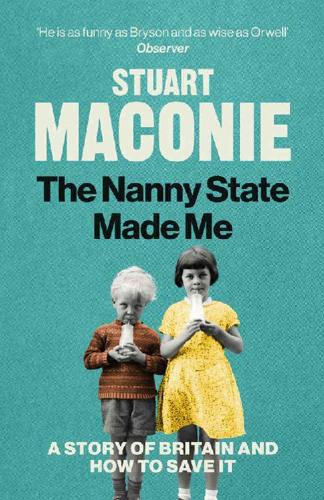
The Nanny State Made Me: A Story of Britain and How to Save It
by
Stuart Maconie
Published 5 Mar 2020
In his book, Clear Bright Future, Mason outlines some of the small but crucial ways you can fight back against the rise of the machines and the tyranny of the algorithm: never use the automated checkouts, always wait for an assistant, look your barista in the eye and engage with them, not your phone. ‘I’m not a technophobe. But I understand what capitalism’s objectives are. Four hundred and fifty thousand men in this country drive vans for a living. I’d love driverless cars to become standard. I’m excited for them and I would love to find them something better and more fulfilling to do. But I am not excited about the economic tragedy that will happen unless all this happens under the control of an enlightened state not capitalist big tech. The promise of internet is lower prices, complete symmetry of information.

The Deep Learning Revolution (The MIT Press)
by
Terrence J. Sejnowski
Published 27 Sep 2018
utm_term=.497dfd1b5d9c. 286 Notes 5. Patcharinee Tientrakool, Ya-Chi Ho, and N. F. Maxemchuk, “Highway Capacity Benefits from Using Vehicle-to-Vehicle Communication and Sensors for Collision Avoidance,” IEEE Vehicular Technology Conference, San Francisco, 5–8 September 2011. 6. “Google’s Waymo Passes Milestone in Driverless Car Race,” Financial Times, December 10, 2017. https://www.ft.com/content/dc281ed2-c425-11e7-b2bb -322b2cb39656/. 7. B. A. Golomb, “Will We Recognize It When It Happens?” in Brockman, J. (ed.), What to Think About Machines That Think (New York: Harper Perennial, 2015), 533– 535. 8. Pierre Delforge, “America’s Data Centers Consuming and Wasting Growing Amounts of Energy,” Natural Resources Defense Council Issue Paper, February 6, 2015. https://www.nrdc.org/resources/americas-data-centers-consuming-and -wasting-growing-amounts-energy/. 9.

Zucked: Waking Up to the Facebook Catastrophe
by
Roger McNamee
Published 1 Jan 2019
They have achieved monopoly power, but at the same time they are also competing against each other. They are big enough to swallow startups that could develop into competitors, but only the giants have the resources to invade each other’s territory. They are poised to dominate the new growth areas that artificial intelligence is opening up, like driverless cars. The impact of innovations on unemployment depends on government policies. The European Union and particularly the Nordic countries are much more farsighted in their social policies than the United States. They protect the workers, not the jobs. They are willing to pay for re-training or retiring displaced workers.

Brotopia: Breaking Up the Boys' Club of Silicon Valley
by
Emily Chang
Published 6 Feb 2018
The most commonly shared narrative is that Google’s triumph came through innovation—that it was the first to the future. Indeed, the top echelon at Google might have bought into that story themselves. One former Google executive told me that management was never Page or Brin’s favorite activity. They preferred to focus on the blue-sky projects—like curing death, and driverless cars. But there was another story to tell: that Google’s success had at least as much to do with making bets on strong female leaders like Mayer, Sandberg, and Wojcicki who brought wider skill sets and different management styles to the company in its earliest days. If subsequent managers at Google understood this lesson, that might have quieted the grumbling among engineers who had a narrow idea of what forms of intelligence or training made a Google employee.
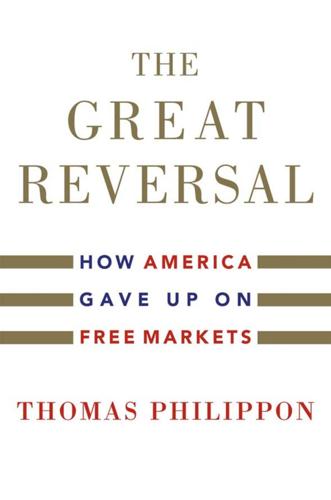
The Great Reversal: How America Gave Up on Free Markets
by
Thomas Philippon
Published 29 Oct 2019
Moreover, the market for iOS apps is opaque, and conflicts of interest are pervasive. To have a meaningful impact on economic growth, the GAFAMs or their siblings need to improve the markets that really matter: transport, energy, and health. If Google really helps to create a market for effective driverless cars, if Facebook really disrupts the banking system, if other digital technologies enable the efficient provision of health services, then we will see real, widespread benefits. But here is the catch-22. In all these cases, privacy issues are paramount. In these new markets, the GAFAMs would have access to even more personal data, and data that are even more sensitive than what they can access today.

Age of Discovery: Navigating the Risks and Rewards of Our New Renaissance
by
Ian Goldin
and
Chris Kutarna
Published 23 May 2016
Is it possible that there are only so many one-time transformations humanity can work upon itself—and that we’ve already made most of them? Before, we couldn’t harness electricity; now we can. We couldn’t maintain sanitary living conditions; now we can. We couldn’t get from any A to any B; now we can. We couldn’t talk to anyone anywhere anytime; now we can. Whatever’s left—driverless cars, or even quantum teleportation—might be incremental in comparison. And perhaps whatever truly fundamental transformations do remain to be made, if any, will be much harder to achieve. We’ve picked clean the low-hanging fruit. Looking back, doubling human life expectancy the first time was simple: roughly, we separated our animals (horses, cows, pigs, chickens) from our homes, separated potable water from sewage and stumbled upon (then mass-produced) the stuff in mold that kills off bacteria (penicillin).

The Evolution of Everything: How New Ideas Emerge
by
Matt Ridley
Then there is Namecoin, which aims to issue internet names in a decentralised, peer-to-peer fashion; Storj, which plans to allow cloud storage of files hidden inside blockchains; and Ethereum, which is a decentralised peer-to-peer network ‘designed to replace absolutely anything that can be described in code’, as Matthew Sparkes puts it. The digital expert Primavera De Filippi sees Ethereum and its ilk coming up with smart contracts, allowing ‘distributed autonomous organisations’ that, once they have been deployed on the blockchain, ‘no longer need (nor heed) their creators’. In other words, not just driverless cars, but ownerless firms. Imagine in the future summoning a taxi that not only has no driver, but that belongs to a computer network, not to a human being. That network has raised funds, signed contracts and taken delivery of vehicles, even though its ‘headquarters’ is distributed all over the net.
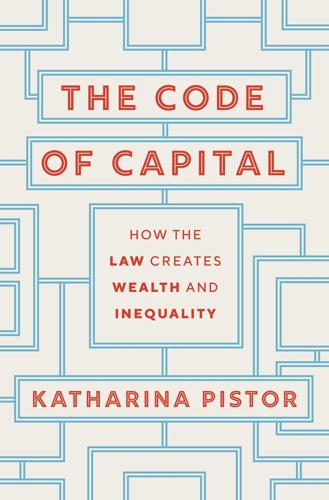
The Code of Capital: How the Law Creates Wealth and Inequality
by
Katharina Pistor
Published 27 May 2019
Ueber Techs Inc., was filed in 2017, but settled in February 2018 only a few days into the trial. Ueber paid Waymo 0.34 percent of its equity, worth $245 million, and promised not to use Waymo technology for self-driving cars. Daisuke Wakabayashi, “Ueber and Waymo settle Trade Secrecy Suit over Driverless Car,” February 9, 2018, available online at www.nytimes.com. 80. Charles Duhigg, “Stop Thief,” New Yorker, October 22, 2018, 50–61, p. 61, quoting a spokesperson for Waymo, the Google subsidiary: “We comply with law-enforcement requests where there is a valid legal process, and this case is no exception.” 81.
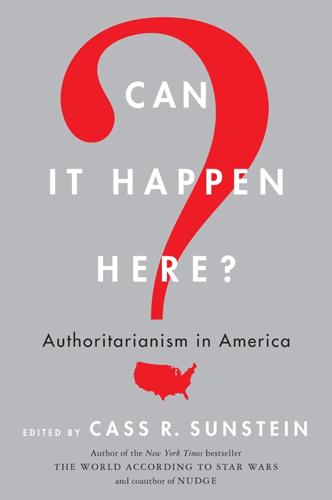
Can It Happen Here?: Authoritarianism in America
by
Cass R. Sunstein
Published 6 Mar 2018
Depending on the measurement technique, the language of politics has been becoming increasingly polarized since somewhere between the 1970s and early 1990s.33 In a 2008 YouGov poll, a fifth of both Democrats and Republicans indicated that they would be “somewhat upset” or “very upset” if a son or daughter married someone of the other party.34 In the 1960s, very few people were offended about the party choice of their relatives.35 Political scientists of that era repeatedly demonstrated that Americans did not think of parties in ideological terms, as most do now.36 If the status quo is awful and the prospect of its perpetuation frightening, it is not the worst possible scenario. Any number of plausible developments could undermine the prevailing equilibrium in American politics and set off a cascade favoring one intolerant community or the other. The possible triggers include emerging technologies. Driverless cars and automated stores will displace millions of drivers and cashiers, swelling the ranks of Americans without marketable skills. Just as China, Mexico, and foreigners are blamed for the loss of industrial jobs, so the unfolding automation could heighten xenophobia and anti-globalism, swelling the numbers of nativists.

The Costs of Connection: How Data Is Colonizing Human Life and Appropriating It for Capitalism
by
Nick Couldry
and
Ulises A. Mejias
Published 19 Aug 2019
It is ingenious to make employment less predictable, and thus less costly, in the name of independence and choice.”94 As such, regardless of its size or long-term success, Uber remains an important exemplar of a projected direction for global capitalism: it represents the potential to create new forms of exploitative work, to substantially increase the levels of exploitation within established forms of work, and to circumvent human labor altogether (the company is currently investing heavily in driverless cars and trucks). Data-gathering and data tracking are essential to all these functions, the fact of which makes exploitation seem like the “natural” outcome of algorithmic processes. Gone are the narratives of a benign form of capitalism in which institutions still acknowledged a social responsibility.
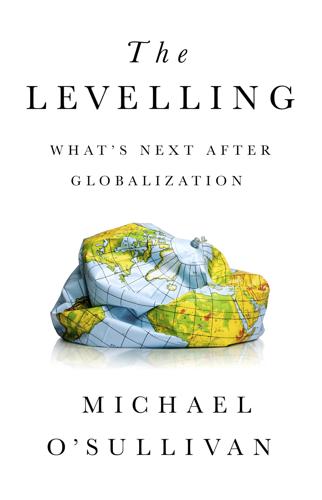
The Levelling: What’s Next After Globalization
by
Michael O’sullivan
Published 28 May 2019
On a similar basis, there is room for the United States to take the lead, perhaps with Europe, in crafting the legal and philosophical frameworks that will oversee the rise in the use of new technologies. Consider the potential for robots to disrupt many forms of employment or to bolster demographics by allowing older people to live more comfortably for longer (consider advances in home care or driverless cars), or consider the way in which algorithms entrench inequalities. Think also about advances in science in the realm of DNA and genetic experimentation, which may allow some people to enjoy long lives. As with many advances in medical technology, the benefits of advances in the areas of genetic editing (a leading area here is Clustered Regularly Interspaced Short Palindromic Repeats [CRISPR], which is effectively a DNA-based approach to managing bacteria and viruses), gene sequencing, and the manipulation of reproductive cells are going to be enjoyed by the better-off; more worryingly, they are not yet bound by internationally recognized laws.

World Cities and Nation States
by
Greg Clark
and
Tim Moonen
Published 19 Dec 2016
But not all national governments are able to pass major infrastructure spending plans because of political conflict. In the United States, major spending bills have been watered down and national initiatives have mostly been geared to investing in the research infrastructure for smart cities and driverless cars (The White House, 2015). In all of these cases, one of the imperatives for national governments is to develop not just new sources of infrastructure investment for cities, but long‐ term strategies around which the investment is channelled. Often, infrastructure funds are distributed on a per capita basis and do not take a view about strategic needs of some cities over others.
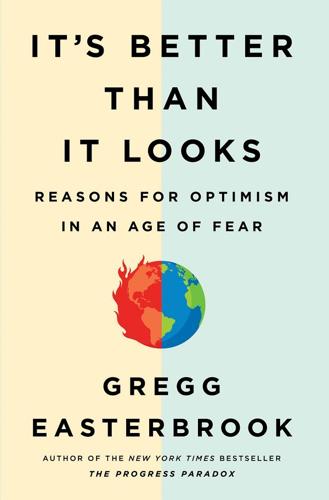
It's Better Than It Looks: Reasons for Optimism in an Age of Fear
by
Gregg Easterbrook
Published 20 Feb 2018
The actual number for 2011 was 98 quads: “US Energy Consumption Rose Slightly in 2016” (Washington, DC: Energy Information Administration, 2017). In 2001, Vice President Dick Cheney declared that unless the United States built: “Dick Cheney, Energy Czar” (editorial), New York Times, May 14, 2001. Studies by researchers at the Massachusetts Institute of Technology suggest: Matthew Claudel, How the Driverless Car Could Transform Cities (New York: McKinsey & Co., 2015). Labor economists who deride long-haul trucks as “sweatshops on wheels”: Michael Belzer, Sweatshops on Wheels (Oxford: Oxford University Press, 2000). Civilian airliner crashes peaked in 1972 and have declined steadily since: See the Aviation Safety Database maintained by Aviation Safety Network at http://aviation-safety.net/database/.

Greater: Britain After the Storm
by
Penny Mordaunt
and
Chris Lewis
Published 19 May 2021
Currently, data is collected, proposals are drawn up in a Green Paper, a White Paper is produced and consulted on, and then legislation follows. In the meantime, the thing you were trying to regulate has evolved into an entirely different beast. George Freeman, while a transport minister, questioned the idea of regulation coming from Whitehall, given the presence of real-time data. He cited the example of driverless cars. These are more of a concern in cities than in rural communities. So why did the regulations need to be the same across the country? The main criticism of the Green Book of late is that it does not give enough weight to rebalancing or ‘levelling up’ regional economies. The rules are blunt and too rigid and there is in-built bias in favour of wealthier areas receiving more infrastructure.

These Strange New Minds: How AI Learned to Talk and What It Means
by
Christopher Summerfield
Published 11 Mar 2025
In the past, where researchers have tried to translate AI from toy environments – simulated worlds or video games – to the more unpredictable world that you and I inhabit, it has often fallen flat on its face (sometimes literally). Embodied agents – robots – that are trained in simulation almost always fail on first contact with the real, physical world, which is one reason that Toyota hasn’t finished that autonomous dog walker yet. It’s also why (despite years of promises) our streets are not yet teeming with sleek driverless cars. LLMs currently suffer from a similar problem of translation to real-world actions: there is no trivial generalization from an AI that can reason about high-school maths problems to one that can autonomously manage your household finances. I use the term ‘instrumental gap’ to refer to this chasm between the ability of LLMs to talk and to act.

Gambling Man
by
Lionel Barber
Published 3 Oct 2024
In the intervening years, Foxconn had become wildly successful thanks to an exclusive contract to manufacture the Apple iPhone in low-cost factories in China. Gou’s relationship with Masa was a case study in mutual dependence and one-upmanship. For Grannan, the only good memory was when Masa insisted – astutely – that Light’s futuristic, three-dimensional camera technology was more suited to business applications like driverless cars than consumer products like smartphones. In hindsight, that was the high point of their relationship. In late July, Grannan received a text from Akshay Naheta, about whom more later. Light was showing a shortfall on its projected revenues. This was hardly unusual for a youthful enterprise which had just had its business plan blown up, but Naheta flew into a rage.
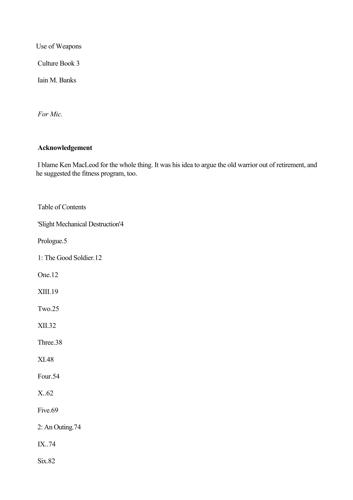
Use of Weapons
by
Iain M. Banks
Published 14 Jan 2011
Probably she had been left behind in a retreat and had wandered about too frightened or proud or stupid to surrender until she had seen the staff car in difficulties in the storm-washed hollow. Her attempt at killing him had been brave but laughable. By sheer luck she'd killed his driver with one shot; a second had struck him a glancing blow on the side of the head, making him groggy while she threw the empty gun away and leapt into the car with her knife. The driverless car had slid down a greasy grass slope into the brown torrent of the river. Such a stupid act. Sometimes, heroics revolted him; they seemed like an insult to the soldier who weighed the risks of the situation and made calm, cunning decisions based on experi-ence and imagination; the sort of unshowy soldiering that didn't win medals but wars.
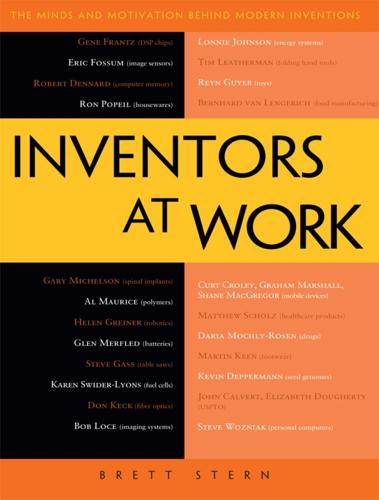
Inventors at Work: The Minds and Motivation Behind Modern Inventions
by
Brett Stern
Published 14 Oct 2012
But I can say we are focused initially on UAVs [unmanned aerial vehicles]—flying robots! Stern: Where do you feel that robotics technology has not been applied yet? Greiner: Oh, there are lots of great places. Just off the top of my head, agriculture and transportation. We don’t have automated farms or real driverless cars yet. There is a lot that can be done robotically in exploring the universe or exploring underwater that hasn’t yet been taken on. There is a lot you could do with having networks for early warning systems for natural disasters in the oceans and the sky. Any time you have a task that is dull, dirty, or dangerous, I believe a robot should be invented to do the job.
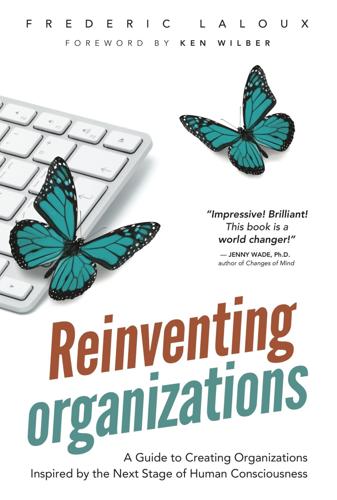
Reinventing Organizations: A Guide to Creating Organizations Inspired by the Next Stage of Human Consciousness
by
Frederic Laloux
and
Ken Wilber
Published 9 Feb 2014
Software has already shown it can perform legal discovery far more cheaply and more thoroughly than lawyers and paralegals in many cases. Radiologists, who can earn over $300,000 a year in the United States after 13 years of college education and internship, are in a similar boat. Automated pattern-recognition software can do much of the work of scanning tumor slides and X-ray images at a fraction of the cost. Advances in driverless car technology make a future where truck and taxi drivers are no longer needed a distinct possibility (provided we have the energy to fuel the engines). Society could be entering a new phase—one in which fewer and fewer workers are needed to produce and distribute all the goods and services consumed.

People, Power, and Profits: Progressive Capitalism for an Age of Discontent
by
Joseph E. Stiglitz
Published 22 Apr 2019
Federal Election Commission, 166, 169–70, 172 class warfare, 6 climate change and attacks on truth, 20 and intergenerational justice, 204–5 markets’ failure to address, xxiii money’s effects on debate, 20 Clinton, Bill, and administration, xiii, 4, 5, 168, 238, 242 Clinton, Hillary, 4, 6 coal companies, 20 Cold War, end of, 28; See also Communism, collapse of collective action, 138–56 balancing with individualism, 139 circumstances requiring, 140–42 government failures, 148–52 increasing need for government action, 152–55 in preamble to Constitution, 138–39 regulation as, 143–48 collective judgments, 262–63n20 college, income inequality and, 200 Comcast, 147 Communications Decency Act, 320n32 Communism, collapse of, 3, 28 comparative advantage, 82–84 competition market concentration, 55–56 market failures, 23 in marketplace of ideas, 75–76 market power, 57–60 power vs., 22 competitive equilibrium model, 47, 280n1 Comprehensive and Progressive Agreement for Trans-Pacific Partnership, 306n25 compulsion, power of, 155 confirmatory bias, 225 conflicts of interest, 70, 72, 124 Congress antitrust laws, 51, 68 and Great Recession, 39, 215 and lobbyists, See lobbyists and money in politics, 171–72 and Obamacare, 213 and regulatory process, 145–46 Supreme Court nominations, 166 and USTR, 100 conservatism, embracing change vs., 226–28 Constitution of the United States collective action reference in preamble, 138–39 economic changes since writing of, 227 “General Welfare” in Preamble, 242 individual liberties vs. collective interest in, 229 and minority rights, 6 as product of reasoning and argumentation, 229 three-fifths clause, 161 consumer demand, See demand consumer surplus, 64 cooperatives, 245 Copenhagen Agreement, 207 copyright extensions, 74 Copyright Term Extension Act (1998), 74 corporate taxes, 108, 206, 269n44 corporate tax rates, globalization and, 84–85 corporate welfare, 107 corporations and labor force participation, 182 and money in politics, 172–73 as people, 169–70 rights as endowed by the State, 172 corruption, 50 cost-benefit analysis, 146, 204–5 Council of Economic Advisers (CEA), xii credit, 102, 145, 186, 220 credit cards, 59–60, 70, 105 credit default swaps, 106 credit unions, 245 culture, economic behavior and, 30 customer targeting, 125–26 cybersecurity, 127–28 cybertheft, 308n35 Daraprim, 296n72 data exclusivity, 288n40 data ownership, 129–30 Deaton, Angus, 41–42 debt, 220; See also credit DeepMind, 315n1 defense contractors, 173 deficits, See budget deficits deglobalization, 92 deindustrialization early days of, xix effect on average citizens, 4, 21 facilitating transition to postindustrial world, 186–88 failure to manage, xxvi in Gary, Indiana, xi globalization and, 4, 79, 87 place-based policies and, 188 deliberation, 228–29 demand automation and, 120 and job creation, 268n41 Keynesian economics and, xv market power’s effect on, 63 demand for labor, technological suppression of, 122 democracy, 159–78 agenda for reducing power of money in politics, 171–74 curbing the influence of wealth on, 176–78 fragility of norms and institutions, 230–36 inequality as threat to, 27–28 maintaining system of checks and balances, 163–67 need for a new movement, 174–76 new technologies’ threat to, 131–35 and power of money, 167–70 as shared value, 228 suppression by minority, xx Trump’s disdain for, xvii voting reforms, 161–63 democratic institutions, fragility of, 230–36 Democratic Party gerrymandering’s effect on, 159 and Great Recession, 152 need for reinvention of, 175 popular support for, 6 renewal of, 242 and voter disenfranchisement, 162 demographics, xx, 181 “deplorables,” 4 deregulation, 25, 105, 143–44, 152, 239; See also supply-side economics derivatives, 80, 88, 106–7, 144 Detroit, Michigan, 188 Dickens, Charles, 12 Digital Millennium Copyright Act, 320–21n32 disadvantage, intergenerational transmission of, 199–201 disclosure laws, 171 discourse, governance and, 11 discrimination, 201–4; See also gender discrimination; racial discrimination by banks, 115 and economics texts, 23 forms of, 202 under GI Bill, 210 and inequality, 40–41, 198–99 and labor force participation, 183 means of addressing, 203–4 and myths about affirmative action, 225 reducing to improve economy, 201–4 diseases of despair, 42–43 disenfranchisement, 27, 161–62 disintermediation, 109 Disney, 65, 74 dispute resolution, 56–57, 309n40 Dodd–Frank Wall Street Reform and Consumer Protection Act, 70, 102, 107 driverless cars, 118 drug overdoses, 42 Durbin Amendment, 70 East Asia, 149 economic justice historical perspectives, 241–42 intergenerational justice, 204–5 racial justice and, 176, 203–4 tax system and, 205–8 economics, assumptions about individuals in, 29–30, 223 economic segregation, 200 economies of scale, 72 economies of scope, 347–48n15 economy and collective action, 153–54 decent jobs with good working conditions, 192–97 deterioration since early 1980s, 32–46 failure’s effect on individuals and society, 29–31 failure since late 1980s, 3–5 government involvement in, 141–42, 150–55 intergenerational transmission of advantage/disadvantage, 199–201 reducing discrimination in, 201–4 restoring fairness to tax system, 205–8 restoring growth and productivity, 181–86 restoring justice across generations, 204–5 restoring opportunity and social justice, 197–201 social protection, 188–91 “sugar high” from Trump’s tax cut, 236–38 transition to postindustrial world, 186–88 education equalizing opportunity of, xxv–xxvi, 219–20 improving access to, 203 returns on government investment in, 232 taxation and, 25 undermining of institutions, 233–34 Eggers, Dave, 128 Eisenhower, Dwight, and administration, 210 elderly, labor force growth and, 181–82 election of 1992, 4 election of 2000, 165–66 election of 2012, 159, 178 election of 2016, xix, 132, 178 elections, campaign spending in, 171–73 elite control of economy by, 5–6 and distrust in government, 151 and 2008 financial crisis, 5 promises of growth from market liberalization, 21–22 rules written by, 230 employers, market power over workers, 64–67 employment, See full employment; jobs; labor force participation End of History, The (Fukuyama), 3 Enlightenment, the, 10–12 attack on ideals of, 14–22 and standard of living, 264n24 environment carbon tax, 194, 206–7 and collective action, 153 economic growth and, 176 economists’ failure to address, 34 markets’ failure to protect, 24 and true economic health, 34 environmental justice, economic justice and, 176 Environmental Protection Agency (EPA), 267n38 epistemology, 10, 234 equality as basis for well-running economy, xxiv–xxv economic agenda for, xxvii as shared value, 228 Equifax, 130 equity value, rents as portion of, 54 ethnic discrimination, 201–4 Europe data regulation, 128–29 globalization, 81 infrastructure investment, 195–96 privacy protections, 135 trade agreements favoring, 80 unity against Trump, 235 European Investment Bank, 195–96 evergreening, 60 excess profits, as rent, 54 exchange rate, 89, 307n28, 307n32 exploitation in current economy, 26 in economics texts, 23 financial sector and, 113 market power and, 47–78 reducing, 197 as source of wealth, 144–45 wealth creation vs., 34 and wealth redistribution, 50 exports, See globalization; trade wars Facebook anticompetitive practices, 70 and Big Data, 123, 124, 127–28 competition for ad revenue, 56 and conflicts of interest, 124 market power in relaxed antitrust environment, 62 as natural monopoly, 134 and preemptive mergers, 60, 73 reducing market power of, 124 regulation of advertising on, 132 fact-checking, 132, 177 “Fading American Dream, The” (Opportunity Insights report), 44–45 “fake news,” 167 family leave, 197 Farhi, Emmanuel, 62 farmers, Great Depression and, 120 fascism, 15–16, 18, 235 Federal Communication Commission (FCC), 147 Federal Reserve Board, 70, 112 Federal Reserve System, 121, 214–15 Federal Trade Commission, 69 fees bank profits from, 105, 110 credit card, 60, 70, 105 for mergers and acquisitions, 108 mortgages and, 107, 218 “originate-to-distribute” banking model, 110 private retirement accounts and, 215 fiduciary standard, 314n21, 347n10 finance (financial sector); See also banks and American crisis, 101–16 contagion of maladies to rest of economy, 112 disintermediation, 109 dysfunctional economy created by, 105–9 gambling by, 106–8 and government guarantees, 110–11 history of dysfunctionality, 109–12 as microcosm of larger economy, 113 mortgage reform opposed by, 216–18 private vs. social interests, 111–12 and public option, 215–16 shortsightedness of, 104–5 stopping societal harm created by, 103–5 and trade agreements, 80 financial crisis (2008), 101; See also Great Recession bank bailout, See bank bailout [2008] China and, 95 deregulation and, 25, 143–44 as failure of capitalism, 3 government response to, 5 housing and, 216 as man-made failure, 153–54 market liberalization and, 4 and moral turpitude of bankers, 7 regulation in response to, 101–2 as symptomatic of larger economic failures, 32–33 and unsustainable growth, 35 financial liberalization, See market liberalization First National Bank, 101 “fiscal paradises,” 85–86 fiscal policy, 121, 194–96 fiscal responsibility, 237 food industry, 182 forced retirement, 181–82 Ford Motor Company, 120 Fox News, 18, 133, 167, 177 fractional reserve banking, 110–11 fraud, 103, 105, 216, 217 freedom, regulation and, 144 free-rider problem, 67, 155–56, 225–26 Friedman, Milton, 68, 314–15n22 FUD (fear, uncertainty, and doubt), 58 Fukuyama, Francis, 3, 259n1 full employment, 83, 193–94, 196–97 Galbraith, John K., 67 gambling, by banks, 106–7, 207 Garland, Merrick, 166–67 Gates, Bill, 5, 117 GDP elites and, 22 as false measure of prosperity, 33, 227 financial sector’s increasing portion of, 109 Geithner, Tim, 102 gender discrimination, 41, 200–204 gene patents, 74–75 general welfare, 242–47 generic medicines, 60, 89 genetically modified food (GMO), 88 genetics, 126–27 George, Henry, 206 Germany, 132, 152 gerrymandering, 6, 159, 162 GI Bill, 210 Gilded Age, 12, 246 Glass-Steagall Act, 315n25, 341n39 globalization, 79–100 budget deficits and trade imbalances, 90 collective action to address, 154–55 effect on average citizens, 4, 21 in era of AI, 135 failure to manage, xxvi false premises about, 97–98 and global cooperation in 21st century, 92–97 and intellectual property, 88–89 and internet legal frameworks, 135 and low-skilled workers, 21, 82, 86, 267n39 and market power, 61 pain of, 82–87 and protectionism, 89–92 and 21st-century trade agreements, 87–89 and tax revenue, 84–86 technology vs., 86–87 and trade wars, 93–94 value systems and, 94–97 GMO (genetically modified food), 88 Goebbels, Joseph, 266n35 Goldman Sachs, 104 Google AlphaGo, 315n1 antipoaching conspiracy, 65 and Big Data, 123, 127, 128 conflicts of interest, 124 European restrictions on data use, 129 gaming of tax laws by, 85 market power, 56, 58, 62, 128 and preemptive mergers, 60 Gordon, Robert, 118–19 Gore, Al, 6 government, 138–56 assumption of mortgage risk, 107 Chicago School’s view of, 68–69 debate over role of, 150–52 and educational system, 220 failure of, 148–52 in finance, 115–16 and fractional reserve banking, 111 and Great Depression, 120 hiring of workers by, 196–97 increasing need for, 152–55 interventions during economic downturns, 23, 120 lack of trust in, 151 lending guarantees, 110–11 managing technological change, 122–23 and need for collective action, 140–42 and political reform, xxvi pre-distribution/redistribution by, xxv in progressive agenda, 243–44 public–private partnerships, 142 regulation and rules, 143–48 restoring growth and social justice, 179–208 social protection by, 231 government bonds, 215 Great Britain, wealth from colonialism, 9 Great Depression, xiii, xxii, 13, 23, 120 “great moderation,” 32 Great Recession, xxvi; See also financial crisis (2008) deregulation and, 25 diseases of despair, 42 elites and, 151 employment recovery after, 193 inadequate fiscal stimulus after, 121 as market failure, 23 pace of recovery from, 39–40 productivity growth after, 37 and retirement incomes, 214–15 weak social safety net and, 190 Greenspan, Alan, 112 Gross Fixed Capital Formation, 271n4 gross investment, 271n4 growth after 2008 financial crisis, 103 in China, 95 decline since 1980, 35–37 economic agenda for, xxvii failure of financial sector to support, 115 and inequality, 19 international living standard comparisons, 35–37 knowledge and, 183–86 labor force, 181–82 market power as inimical to, 62–64 in post-1970s US economy, 32 restoring, 181–86 taxation and, 25 guaranteed jobs, 196–97 Harvard University, 16 Hastert Rule, 333n31 health inequality in, 41–43 and labor force participation, 182 health care and American exceptionalism, 211–12 improving access to services, 203 public option, 210–11 in UK and Europe, 13 universal access to, 212–13 hedonic pricing, 347n13 higher education, 219–20; See also universities Hispanic Americans, 41 hi-tech companies, 54, 56, 60, 73 Hitler, Adolf, 152, 266n35 Hobbes, Thomas, 12 home ownership, 216–18 hours worked per week, US ranking among developed economies, 36–37 House of Representatives, 6, 159 housing, as barrier to finding new jobs, 186 housing bubble, 21 housing finance, 216–18 human capital index (World Bank), 36 Human Development Index, 36 Human Genome Project, 126 hurricanes, 207 IA (intelligence-assisting) innovations, 119 identity, capitalism’s effect on, xxvi ideology, science replaced by, 20 immigrants/immigration, 16, 181, 185 imports, See globalization; trade wars incarceration, 161, 163, 193, 201, 202 incentive payments for teachers, 201 voting reform and, 162–63 income; See also wages average US pretax income (1974-2014), 33t universal basic income, 190–91 income inequality, 37, 177, 200, 206 income of capital, 53 India, guaranteed jobs in, 196–97 individualism, 139, 225–26 individual mandate, 212, 213 industrial policies, 187 industrial revolution, 9, 12, 264–65n24 inequality; See also income inequality; wealth inequality benefits of reducing, xxiv–xxv and current politics, 246 in early years after WWII, xix economists’ failure to address, 33 education system as perpetuator of, 219 and election of 2016, xix–xxi and excess profits, 49 and financial system design, 198 growth of, xii–xiii, 37–45 in health, 41–43 in opportunity, 44–45 in race, ethnicity, and gender, 40–41 and 2017 tax bill, 236–37 technology’s effect on, 122–23 in 19th and early 20th century, 12–13 20th-century attempts to address, 13–14 tolerance of, 19 infrastructure European Investment Bank and, 195–96 fiscal policy and, 195 government employment and, 196–97 public–private partnerships, 142 returns on investment in, 195, 232 taxation and, 25 and 2017 tax bill, 183 inheritance tax, 20 inherited wealth, 43, 278n38 innovation intellectual property rights and, 74–75 market power and, 57–60, 63–64 net neutrality and, 148 regulation and, 134 slowing pace of, 118–19 and unemployment, 120, 121 innovation economy, 153–54 insecurity, social protection to address, 188–91 Instagram, 70, 73, 124 institutions fragility of, 230–36 in progressive agenda, 245 undermining of, 231–33 insurance companies, 125 Intel, 65 intellectual property rights (IPR) China and, 95–96 globalization and, 88–89, 99 and stifling of innovation, 74–75 and technological change, 122 in trade agreements, 80, 89 intelligence-assisting (IA) innovations, 119 interest rates, 83, 110, 215 intergenerational justice, 204–5 intergenerational transmission of advantage/disadvantage, xxv–xxvi, 199–201, 219 intermediation, 105, 106 Internal Revenue Service (IRS), 217 International Monetary Fund, xix internet, 58, 147 Internet Explorer, 58 inversions, 302n10 investment buybacks vs., 109 corporate tax cuts and, 269n44 and intergenerational justice, 204 long-term, 106 weakening by monopoly power, 63 “invisible hand,” 76 iPhone, 139 IPR, See intellectual property rights Ireland, 108 IRS (Internal Revenue Service), 217 Italy, 133 IT sector, 54; See also hi-tech companies Jackson, Andrew, 101, 241 Janus v.
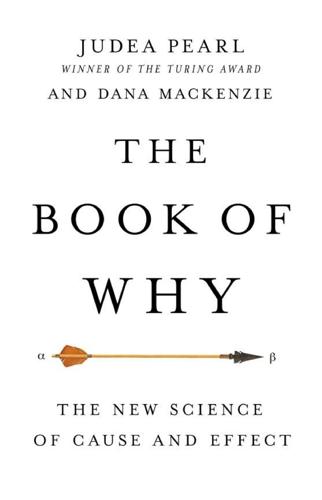
The Book of Why: The New Science of Cause and Effect
by
Judea Pearl
and
Dana Mackenzie
Published 1 Mar 2018
Deep neural networks have added many more layers to the complexity of the fitted function, but raw data still drives the fitting process. They continue to improve in accuracy as more data are fitted, but they do not benefit from the “super-evolutionary speedup.” If, for example, the programmers of a driverless car want it to react differently to new situations, they have to add those new reactions explicitly. The machine will not figure out for itself that a pedestrian with a bottle of whiskey in hand is likely to respond differently to a honking horn. This lack of flexibility and adaptability is inevitable in any system that works at the first level of the Ladder of Causation.

The Lonely Century: How Isolation Imperils Our Future
by
Noreena Hertz
Published 13 May 2020
, MIT News, 4 May 2020, http://news.mit.edu/2020/how-many-jobs-robots-replace-0504. 81 As economist Henry Siu put it in 2015, ‘The personal computer existed in the ’80s, but you don’t see any effect on office and administrative-support jobs until the 1990s, and then suddenly, in the last recession, it’s huge. So today you’ve got checkout screens and the promise of driverless cars, flying drones, and little warehouse robots. We know that these tasks can be done by machines rather than people. But we may not see the effect until the next recession, or the recession after that.’ Derek Thompson, ‘When Will Robots Take All the Jobs?’, The Atlantic, 31 October 2016, https://www.theatlantic.com/business/archive/2016/10/the-robot-paradox/505973/.
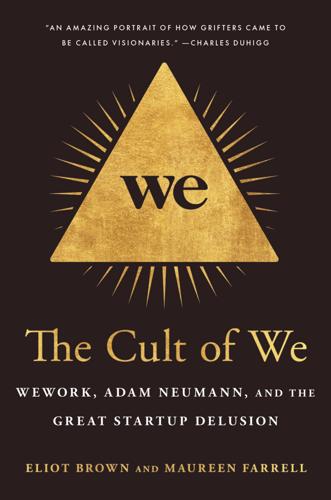
The Cult of We: WeWork, Adam Neumann, and the Great Startup Delusion
by
Eliot Brown
and
Maureen Farrell
Published 19 Jul 2021
Money went to startups like Plenty, an indoor farming company that had a thirty-minute meeting with Son and walked out with a $200 million commitment, double what it requested. Money flew to the delivery app DoorDash, to the online home-buying company Opendoor, to the real estate brokerage Compass. Son bet billions on driverless cars, even as concerns grew that self-driving technology was not anywhere close to prime time. He pumped $375 million into Zume Pizza, a company that pledged to have robots make pizzas and delivery trucks cook them en route; its pizza operations shut down a bit more than a year later. Son dreamed of a synergistic relationship among the startups in his herd of unicorns.
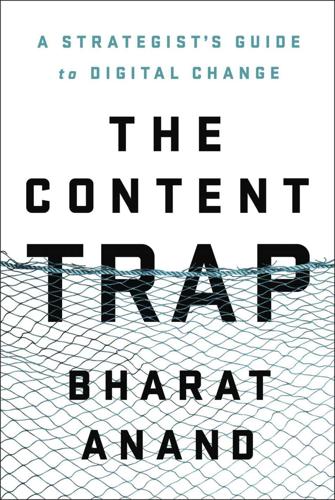
The Content Trap: A Strategist's Guide to Digital Change
by
Bharat Anand
Published 17 Oct 2016
Thrun had been a computer science professor, at Carnegie Mellon and then Stanford, for more than a decade. He specialized in artificial intelligence (AI) and in far-out projects that Google later called “moon shots.” Like many Stanford computer scientists, he was closely involved with Valley start-ups—in his case, Google. Thrun had advised Google since 2007, led its program to develop a driverless car, and started Google X, the lab that developed Google Glass. In 2010 Thrun was about to teach the AI course he offered every fall. But this time he also recorded his lectures and put them online. That would certainly benefit any of his Stanford students who missed a lecture or two. But his real motivation was to make his teaching available to anyone who was interested but would never set foot on Stanford’s campus.

Cities Under Siege: The New Military Urbanism
by
Stephen Graham
Published 30 Oct 2009
After a close contest, with six finishers, the Tartan team, an alliance of General Motors and Pittsburgh’s Carnegie Mellon University, was declared the victor – gaining the $2 million first prize in part because their vehicle had not only finished the course but also complied with California traffic rules. 9.9 DARPA’s ‘Urban Challenge’ competition in November 2007. Eleven fully robotized SUVs and other cars had to navigate a simulated urban course completely autonomously. 9.10 Estimates for the future introduction of fully autonomous military and civilian vehicles from the Urban Challenge presentations of Stanford University’s entry. Whilst driverless cars are unlikely to become available to consumers until 2030 at the earliest, the Urban Challenge robocars are already being displayed at car shows, billed as a way to ‘fortify road safety and eliminate driver error as the most common cause of crashes’.131 The already strong links between militarized robotic combat vehicles (Figure 9.10) and an increasingly militarized society where cars become increasingly automated and surveilled, will likely intensify.

How Everything Became War and the Military Became Everything: Tales From the Pentagon
by
Rosa Brooks
Published 8 Aug 2016
We assure ourselves that we humans have special qualities no machine can replicate: we have “judgment” and “intuition,” for instance. Maybe, but computers often seem to have better judgment. This has already been demonstrated in dozens of different domains, from aviation to anesthesiology. Computers turn out to be better than humans at distinguishing between genuine and faked expressions of pain; Google’s driverless cars fare better at avoiding accidents than cars controlled by humans.9 Given a choice between relying on a human to comply with international humanitarian law and relying on a well-designed, well-programmed robot, I’d take my chances with the killer robot any day. Opponents of autonomous weapons ask whether there’s a legal and ethical obligation to refrain from letting machines make decisions about who should live and who should die.

America Right or Wrong: An Anatomy of American Nationalism
by
Anatol Lieven
Published 3 May 2010
Antichrist, who has a French surname, was possessed by Satan, in the form of the Hindu god Shiva, while serving with the Peace Corps in India.113 These books are also utterly, shockingly ruthless in their treatment of the unsaved— in other words, the vast mass of humanity. In accordance with one strand in prophetic belief, the Rapture series begins with God's elect being taken up to heaven in an instant, and dwells lovingly on the immense casualty rates that results as pilotless planes and driverless cars crash all over the world—with most of the victims presumably going to hell.114 The moral tone of such attitudes has real consequences for how these believers think about the world today. Thus I remember the words of my born-again landlady during a stay in Washington in 1996-97. When challenged that the Bible cannot be literally God's word, for in this case sections of the Books of Exodus and Joshua in particular would make God guilty of ordering genocide, she replied, in honey-sweet tones, "But don't you see, if those people had been wiped out 3,000 years ago as God ordered, we wouldn't have all these problems in the Middle East today."

Connectography: Mapping the Future of Global Civilization
by
Parag Khanna
Published 18 Apr 2016
Don’t confuse physics and logistics.4 American firms would profit far more from worrying less about the “where” of the hardware than the lucrative value-added “what” of the design of complex products. Google’s Ara project epitomizes this trend by creating the equivalent of an app store for modular hardware components that people can design, create, sell, and ship to anyone anywhere so they can assemble a customized mobile phone. The same is happening in medical prosthetics and driverless cars: It matters far less where artificial limbs or composite car parts are printed than whose software and design lead the market. An Australian company producing medical equipment for use in surgeries in China found it easier to print the parts in China rather than manufacture them in Australia using titanium components.

More: The 10,000-Year Rise of the World Economy
by
Philip Coggan
Published 6 Feb 2020
This was simply not possible for most workers even 50 years ago. Indeed, the combination of the car, truck, train, plane and container ship means that the ordinary person can live further from work, travel further for their holiday, and buy goods from further away than ever before. Globalisation is literally dynamic. More change is on its way. Driverless cars and trucks will reduce the death toll from road transport. Electric cars will make our streets less polluted. Drones and pavement-travelling robots will deliver our goods. And a greater emphasis on home working will reduce the need for the daily commute. Our grandchildren may not understand the concept of a “rush hour” at all
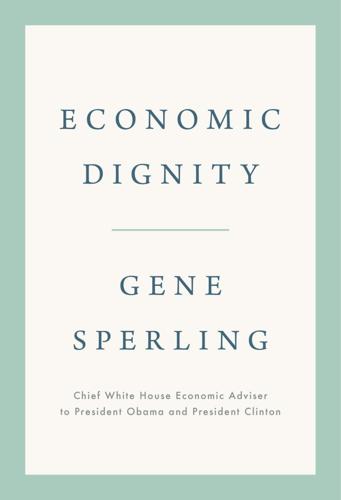
Economic Dignity
by
Gene Sperling
Published 14 Sep 2020
When we speak of the need for dignity of work, we should recognize at every turn that its denial is felt by varied groups across our nation. Yes, this should include the families in small, rural towns and manufacturing communities and the harder hit sections of Appalachia and the millions of mostly men whose jobs as truck drivers could be put at risk by automation and driverless cars.33 But such discussions of dignity gaps must always include the diverse segments of our country that face denials of economic dignity. Certainly, this should include the millions struggling in lower-wage service jobs, such as pre-gig-economy workers—often minority women who care for households and the elderly—and poor children whose chances to pursue potential are deeply diminished by the accident of birth.
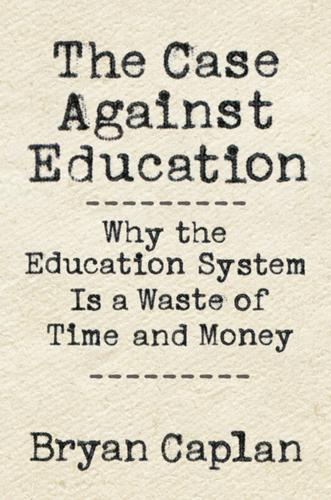
The Case Against Education: Why the Education System Is a Waste of Time and Money
by
Bryan Caplan
Published 16 Jan 2018
If we’re not getting good value for our educational investments, we shouldn’t call deep cuts “draconian.” We should call the status quo “profligate.” Rich societies can afford to waste trillions. But why settle for that? Rich societies face countless opportunities. The trillions we spend boring youths might cure cancer, buy driverless cars, or end world hunger. Collective complacency seems harmless, but it kills by omission. The Hidden Wonder of High Tuition and Student Debt High tuition and student debt naturally disturb education’s defenders: education is a great investment, so government should make it accessible for all.
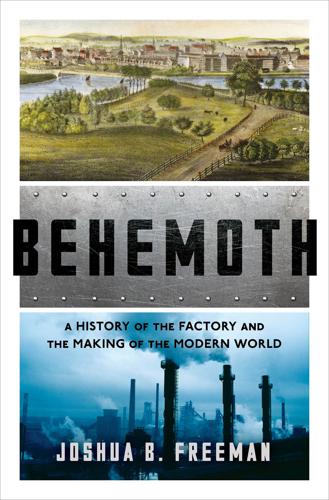
Behemoth: A History of the Factory and the Making of the Modern World
by
Joshua B. Freeman
Published 27 Feb 2018
Hawkins Ferry, The Legacy of Albert Kahn (Detroit, MI: Wayne State University Press, 1970), 25–26. 5.To expand the labor pool for Willow Run, Ford opened up jobs to women, who eventually made up 35 percent of the workforce. However, in a departure from its policy at Highland Park and the Rouge, the company all but spurned African Americans. Willow Run workers eventually achieved productivity far above the airplane industry norm. The latest use of the Willow Run factory grounds has been as a test site for driverless cars. Sarah Jo Peterson, Planning the Home Front: Building Bombers and Communities at Willow Run (Chicago: University of Chicago Press, 2013); Allan Nevins and Frank Ernest Hill, Ford: Expansion and Challenge, 1915–1933 (New York: Charles Scribner’s Sons: 1957), 242–47; Nelson Lichtenstein, The Most Dangerous Man in Detroit: Walter Reuther and the Fate of American Labor (New York: Basic Books, 1995), 160–74; Gail Radford, Modern Housing for America: Policy Struggles in the New Deal Era (Chicago: University of Chicago Press, 1996), 121–32; New York Times, June 6, 2016. 6.Not all the workers at other airplane manufacturers were housed in single plants; Republic and Grumman built auxiliary factories near their main plants to bring work nearer to where workers lived, reducing problems with commuting and housing.
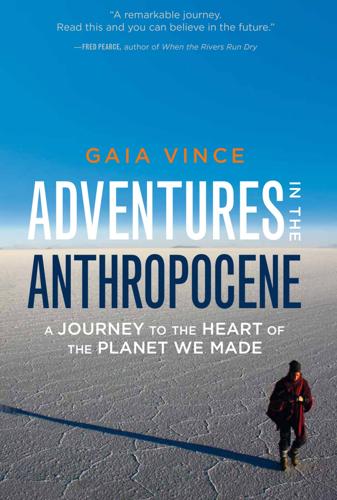
Adventures in the Anthropocene: A Journey to the Heart of the Planet We Made
by
Gaia Vince
Published 19 Oct 2014
As I tour a nearly finished school, I surprise another innovation into action: Dutch-owned Phillips is trying out its new sound- and motion-sensitive lights, which default to off unless the switch hears or feels someone approach. Other innovations include a planned pneumatic municipal waste-collection system, produced by Swedish Envac, which will eliminate the need for refuse trucks, and driverless cars are being trialled by General Motors. Buildings will have smart controls, automatically raising and lowering window blinds to regulate light and temperature, for example. In 2012, the first sixty families moved into the city’s residential buildings, all of which are designed to a minimum green buildings standard, including water-saving sanitary fittings, insulated walls and double-glazed windows, as well as a south-facing orientation to optimise passive heat.
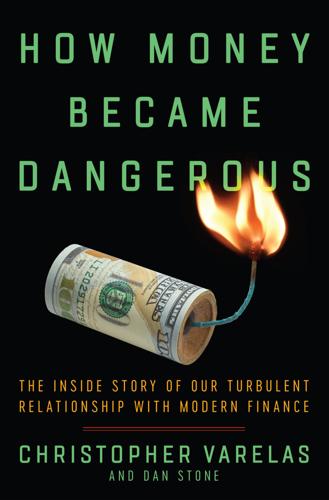
How Money Became Dangerous
by
Christopher Varelas
Published 15 Oct 2019
It’s not uncommon in several cities to see a knee-high robot, basically a fancy cooler on wheels, navigating through pedestrians en route to deliver lunch to some hungry office worker, who not only doesn’t need to offer a gratuity, but can skip the small talk and pleasantries too. There is something wonderful about the swiftness and convenience of these technological developments, but there is also something perilous, as we become increasingly disconnected from money and commerce. As several companies work to perfect the driverless car, it’ll soon be possible to get from home to the office and back with essentially no human contact. We can protect ourselves from anything and anybody that might disrupt, challenge, or unsettle us. But what will protect us when the next big bubble bursts? In the case of Equinix, it was their integrity and the trust they had built with their employees, partners, and customers.

Coders: The Making of a New Tribe and the Remaking of the World
by
Clive Thompson
Published 26 Mar 2019
“human-level performance,” as they noted: Steven Levy, “Inside Facebook’s AI Machine,” Wired, February 23, 2017, accessed August 19, 2018, https://www.wired.com/2017/02/inside-facebooks-ai-machine/; Yaniv Taigman, Ming Yang, Marc’Aurelio Ranzato, and Lior Wolf, “DeepFace: Closing the Gap to Human-Level Performance in Face Verification,” Conference on Computer Vision and Pattern Recognition (CVPR), June 24, 2014, accessed August 19, 2018, https://research.fb.com/publications/deepface-closing-the-gap-to-human-level-performance-in-face-verification. to navigate roads: Andrew J. Hawkins, “Inside Waymo’s Strategy to Grow the Best Brains for Self-driving Cars,” The Verge, May 9, 2018, accessed August 19, 2018, https://www.theverge.com/2018/5/9/17307156/google-waymo-driverless-cars-deep-learning-neural-net-interview. where new rides will emerge: Nikolay Laptev, Slawek Smyl, and Santhosh Shanmugam, “Engineering Extreme Event Forecasting at Uber with Recurrent Neural Networks,” Uber Engineering, June 9, 2017, accessed August 19, 2018, https://eng.uber.com/neural-networks.

Hope Dies Last: Visionary People Across the World, Fighting to Find Us a Future
by
Alan Weisman
Published 21 Apr 2025
Its program managers were free to take wild risks, to dream up inventions that might truly change the game if only they existed, and get funding to try to build them. Thus was born ARPANET, which became the internet and also GUI, the graphical user interface that lets anyone use it by pointing at pictures. DARPA also spawned GPS, without which we’d literally be lost; the computer mouse; weather satellites; voice recognition; infrared night vision; driverless cars; pilotless planes; stealth technology; Siri; drones; and the use of mRNA to teach cells to repel viruses, leading to Moderna’s COVID-19 vaccine. Other DARPA projects have proved less successful: cyborg surveillance insects; plant-powered robots that could recharge by foraging; self-repairing, living construction materials; mechanical beasts of burden to lighten soldiers’ loads; and brain-computer interfaces to translate thoughts into action, from driving vehicles to launching weapons.

Superintelligence: Paths, Dangers, Strategies
by
Nick Bostrom
Published 3 Jun 2014
See Slagle (1963), Evans (1964, 1968), and Bobrow (1968). 16. Nilsson (1984). 17. Weizenbaum (1966). 18. Winograd (1972). 19. Cope (1996); Weizenbaum (1976); Moravec (1980); Thrun et al. (2006); Buehler et al. (2009); Koza et al. (2003). The Nevada Department of Motor Vehicles issued the first license for a driverless car in May 2012. 20. The STANDUP system (Ritchie et al. 2007). 21. Schwartz (1987). Schwartz is here characterizing a skeptical view that he thought was represented by the writings of Hubert Dreyfus. 22. One vocal critic during this period was Hubert Dreyfus. Other prominent skeptics from this era include John Lucas, Roger Penrose, and John Searle.

The Rise and Fall of Nations: Forces of Change in the Post-Crisis World
by
Ruchir Sharma
Published 5 Jun 2016
“Mahatma,” 236 Garotinho, Anthony, 78 Gates, Bill, 104, 119, 124 GDP (gross domestic product): analysis of, 407 and civil wars, 142 and credit markets, 300, 301n, 302 and current account, 273, 296 and debt, 149, 216, 291, 300, 317, 320, 328 global, 2–3, 19, 243 and government spending, 135–39, 164 and inflation, 235, 238 and investment, 202–3, 204, 205–6, 217, 231–32 and leadership, 86–87 and manufacturing, 204–6, 214–15 per capita, 345–46, 347 and population growth, 30 rising, 8 and wealth gap, 107–10 Geographic Sweet Spot (Rule 5), 166–200, 402–3; see also location geopolitics, 172–75 Germany, 93, 138, 192, 208 billionaires in, 116, 121, 122, 388 currency in, 294 economic strength of, 286, 387–88, 391, 400 fall of Berlin Wall in, 215 Hartz reforms in, 215, 387 hype about, 335 and immigration, 45, 50, 53, 388 industrialization in, 144, 215 leadership in, 387, 388 and location, 388 per capita income in, 32 population growth rates in, 26, 45 retirement in, 37, 39, 45 slump in (1860s), 6 state bank in, 245, 388 workforce in, 19, 32, 37, 41, 55–56, 388 Ghana, 12, 87, 354 Giang Ho, 336 Gini coefficient, 99–100 global cities, 197–200 global economy: competition in, 17, 57, 68, 173–74, 193, 295 cycles in, 2, 3, 10, 172 protection measures, 172–73 global financial crisis (2007–2009): and debt, 300, 302–3, 327–28 effects of, vii, viii, xi–xii, 59, 69–70, 102, 253, 274–75, 279, 324–25, 328 and emerging markets, 146–48, 280 and global trade, 2, 172–75 and government spending, 146–47, 164 and new regulations, 276 onset of, 338 preceding events (BC), 1, 5, 13, 101, 102, 132, 177, 276, 358, 359 reality in years following (AC), 1, 5–6, 71, 134, 137, 173, 400 recovery from, 17, 23–24, 60, 93–94, 150 and state banks, 151–52, 276 as systemic crisis, 23 unexpectedness of, 5, 11, 337–38 globalization: and asset prices, 257–58 deglobalization, 274–77, 296, 394, 399 trends in, 1, 8, 199, 211, 295 and wages, 101 gold standard, end of, 252 Goldstone, Jack, 92 “golf course capitalism,” 331, 351 Good Billionaires/Bad Billionaires (Rule 3), 95–131 bad billionaires defined, 100, 105–6, 111, 121–22 billionaire lists, 100, 103–5, 111–12, 116–17, 120–21 and corrupt societies, 127–29 good billionaires defined, 104–5, 111 quality: good vs. bad, 110–15, 121–24 rise of billionaire rule, 129–31 see also wealth Goodhart’s Law, 13, 18 governments: key tasks of, 135 meddling, see Perils of the State too-small, 141–43 government spending, 135–41, 145–51, 164 Great Depression (1930s), 172, 173, 254, 258, 299, 325 Great Recession (2007–2009), see global financial crisis Greece, 5, 20 backsliding, 288, 346 corruption in, 137, 164 currency crisis in, 286, 293 debt crisis in, 51, 127, 137–38, 163–64, 300, 301, 327 economic cycle in, 88, 286 government collapse (2011), 80 tourism in, 288 Gref, German, 60, 67 Guericke, Konstantin, 49 guns versus butter, 158 Haiti, 346 Hanushek, Eric, 16 Harari, Yuval, 199 Henry I, king of England, 264 Hessler, Peter, 42 Hong Kong, 171, 176, 253, 254, 346 Huang, Yukon, 196 Humala, Ollanta, 76 Human Development Index (HDI), 10 Hungary, 151, 176, 320 Hussein, Jaffer, 246 Hussein, Saddam, 89 hype: applying the rules to, 351–55 of commodity economies, 340–42, 343 constant vigilance in, 344–47 on convergence myth, 338–41, 352 cover stories, 334–38, 347, 349–52 and disaster scenarios, 343–44 of emerging nations, 4, 8, 9, 333–34, 338–40 focus on one growth factor, 11, 14 indifference vs., 332, 333, 347–51 and media negativity, 349–50 of need for structural reform, 62–63 time differentiation in, 330, 335 Hype Watch (Rule 10), 329–55 Iceland, 88 immigration: anti-immigrant forces, 27, 44, 49, 53 and capital flight, 52–53 economic, 2, 48, 170 highly skilled, 48–54 and social services, 50 student visas, 49 and workforce, 28, 44–54 incremental capital output ratio (ICOR), 149 India, 157, 174, 283 bureaucracy in, 133, 162, 209 corruption in, 105–6, 112, 129, 164 economic cycle in, 8, 10, 62, 63, 94, 358, 375 GDP of, 4–5, 12, 175 and geopolitics, 172–73, 175 government spending in, 149, 150, 164 HDI ranking, 10 hype about, 4, 10, 333, 334, 336, 338, 345, 358, 370 and immigration, 50, 52 inflation in, 4, 236–38, 250–52, 374 infrastructure in, 374 international business in, 18, 375, 394 investment in, 205, 208–9, 231, 250, 374 leadership in, 70, 79, 81, 94, 350–51, 373–75 location of, 185, 374–75 manufacturing in, 208–10, 213 nationalism in, 81–82 population centers in, 195–97 population growth rates in, 26–27, 30, 31 prices in, 234–38 and regional alliances, 180–81, 375 service jobs in, 212–13, 218, 221 social unrest in, 4, 31, 70, 73, 74, 236 stagnation in, 6, 75 state banks in, 151–52, 153–54, 374 state intervention in, 135–36, 196 tax evasion in, 128–29 war with Pakistan, 97, 375 wealth gap in, 102, 105, 112, 116, 120, 129 workforce in, 32, 42–43, 44, 209 Indonesia, 116, 120, 326 and budget deficit, 148, 158, 163 closed economy of, 174, 178 commodities economy of, 227, 342, 376 currency of, 292, 293, 321 debt in, 320–23, 324, 325, 327 economic growth in, 82, 349 energy subsidies in, 157–58 financial deepening in, 327 GDP of, 175, 205 and hype, 330–31, 349 and international trade, 179–80, 293 leadership in, 59–60, 82, 93, 143 population growth rates in, 30 and regional alliances, 377 social unrest in, 70, 321 state banks in, 151, 320–23 industrialization, 98 and investment, 205 and population growth, 195 state assistance in, 144, 145–46 see also manufacturing Industrial Revolution, 6, 35, 255 inflation, 234–61 containment of, 21, 65 and currencies, 264–65, 292 and deflation, 5, 252–57 and economic growth, 238–40, 326, 365 and GDP, 235, 238 and government collapse, 242, 247 hyperinflation, 69, 97, 155, 239 and investment, 233, 238, 240 persistence of, 252 and prices, 237, 240–42, 257–61 stagflation, 64, 65, 240, 395 war on, 240–46 infrastructure, 10 and export trade, 207–8 inadequate, 141–43 investment in, 21, 135, 158, 175, 232–33 interest rates, 229, 235, 239, 240, 244, 260, 306, 335 International Monetary Fund (IMF): bailouts from, 5, 65, 68, 272, 280, 354, 372 on capital flight, 280 and debt, 299 on economic growth factors, 12, 152 forecasting record of, 336–38 on global debt crisis, 259, 324 global recession defined by, 2 and hype, 335–37 on inflation, 241 reforms required by, 68, 248, 372 WEO database of, 407 on women’s opportunities, 43 Internet, 1, 8, 221 censorship of, 308 “crowdfunding” sites on, 313 and global trade, 176, 197, 199 hype in, 334 information flow on, 1 service jobs for, 210, 211–13 shopping via, 257–58 investment: in commodities, 223–29 as economic indicator, 15, 202–3, 205–6, 233 in education, 16–18 by entrepreneurs, 158, 209, 226 and GDP, 202–3, 204, 205–6, 217, 231–32 good vs. bad, 203 ideal level of, 205–6 and inflation, 233, 238, 240 in infrastructure, 21, 135, 158, 175, 232–33 in manufacturing, 203–6, 232 and price shifts, 344 in real estate, 222–23, 229–31 shift from private to public, 149 speculation, 229–31, 313–14, 382 in technology, 218–21, 229, 233, 255 weak, 231–33 Iran, 174, 190 birth rate in, 26 economic cycle in, 87, 88, 346, 348 hype about, 346, 348 as Shiite theocracy, 170 trade with, 170–71 workforce in, 42 Iraq: economic cycle in, 87, 88, 89 hype about, 346, 348 leadership in, 89 refugees from, 2, 44 wars in, 167, 346 Ireland, 29, 288, 300, 346 Islam, Shiite-Sunni divide, 170 Israel, 175, 218–19 Italy, 83, 136, 192, 204 birth rate in, 26 debt in, 310, 385 internal devaluation in, 287 leadership in, 70, 81 wealth gap in, 102, 116–17, 121, 122 workforce in, 32, 39, 44 Jaitley, Arun, 106 Jamaica, 5, 66, 339 Japan, 26, 141, 190, 194 agriculture in, 384 bank crises in, 316, 319 billionaires in, 110, 116, 121 currency in, 294, 385 debt in, 300, 307, 316, 317, 318–19, 320, 384, 385 deflation in, 253–54, 256, 260 economic cycle in, 8, 57, 83, 93, 94, 175, 238, 308, 310, 317, 335 economic reform in, 384 and global trade, 176, 178, 184, 187, 294 hype about, 329–30, 334, 335, 348, 351 and immigration, 47, 50, 52, 384 industrialization in, 144, 178 insularity of, 46 investment in, 221, 238, 253, 318, 385 manufacturing in, 203, 212–13 and per capita GDP, 346 population decline in, 46, 383 reconstruction period in, 29 and regional alliances, 179, 183, 384 slump (1990s), 6, 258, 329, 335 technology in, 295 tourism in, 384–85 workforce in, 32, 37, 41, 43, 44, 55–56, 384, 385 “zombie companies” in, 318–19 Jim Yong Kim, 48 jobs: availability of, 32, 37, 55 in government or state-owned companies, 155–56 manufacturing as source of, 15 new, 57 replaced by machines, 16, 24, 101 and service sector, 202, 209–13, 221 Jobs, Steve, 49 Johnson, Simon, 176 Jonathan, Goodluck, 226, 352, 398 Jordan, 88, 206 Jordà, Òscar, 259 Jospin, Lionel, 34 Juncker, Jean-Claude, 80 Kahneman, Daniel, 56 Katz, Lawrence, 55 Kaunda, Kenneth, 96 Kenya, 31, 181–82, 190, 238, 354–55, 398–99 Kenyatta, Uhuru, 355, 399 Keynes, John Maynard, 149–50 Khan, Genghis, 8, 187 Khodorkovsky, Mikhail, 350 Kim Dae-jung, 66–67, 71 Kim Il-sung, 96 Kim Jong-il, 74, 86, 94 Kirchner, Nestor, 9, 64, 74, 76, 98 Kissinger, Henry A., 79 Kiss of Debt (Rule 9), 297–328 Zielinski play, 297–98, 299, 323 see also debt Kohler, Hans-Peter, 35 Koizumi, Junichiro, 335, 351 Kudrin, Alexei, 60, 67, 74 Kuznets, Simon, 101, 299 Lagarde, Christine, 58 Laos, 180 Latin America, 364–70 economic cycles in, 93, 291, 310, 342 infrastructure in, 186 and location, 177 regional alliances, 179, 182–83, 366 wealth gap in, 95–96, 97, 125–26 see also specific nations Lavagna, Roberto, 74 leadership: aging, 3, 59, 71–72, 75, 114 arrogance of, 59, 60, 61, 62, 71, 72 autocrats vs. democrats, 21, 63, 82, 85–91, 132, 333, 365 charismatic, 61, 68, 69 in circle of life, 60–62, 364–65 corruption of, 3, 12, 60, 61, 67, 91, 97, 105–6, 114, 127–29, 226, 320, 379 and elections, 364–65 fresh, 63, 64–70, 75, 76–77, 86, 94, 388 populist, 59, 77–80, 96–99, 363–64 and regional alliances, 179 stale, 21, 59, 61, 63, 70–77, 86, 92, 94, 249, 376, 392–93 technocrats, 63, 80–85, 237 tenure of, 73–75, 90 Li, Robin, 113 Libya, 4, 74, 92, 167, 168, 185 life expectancy, 10, 19, 25, 26, 28, 44 and retirement, 37, 38–40 Li Keqiang, 84, 150, 312 location, 166–200 and economic growth, 175–78, 199–200 and global trade, 171–75, 176–89, 199–200 population centers, 189–97 regional alliances, 173–75, 178–84, 199 service cities, 197–200 and shipping routes, 185–86, 402–3 long term, myth of, 399–401 López Michelsen, Alfonso, 188 Lucas, Robert, 280 Lucas paradox, 280 Lula da Silva, Luiz Inácio, 66, 69, 71, 74, 79, 284 Ma, Jack, 113, 114 Macri, Mauricio, 83, 365–66 Maduro, Nicolás, 158 Ma Huateng, 113 Maktoum, Sheikh Mohammed bin Rashid Al, ruling family of, 166–67 Malaysia, 190, 342 banking crisis in (1990s), 316 debt in, 299, 300, 306, 315, 325 economic cycle in, 29, 327, 378–79 and global trade, 174, 178, 180 hype about, 330, 331, 345, 348 immigration to, 48, 51 investment in, 206, 231 leadership in, 60, 76, 379 manufacturing in, 205 state banks in, 151, 323–24 wealth in, 107, 118 Malta, 342, 348 Malthus, Thomas, 27, 343 Manuel, Trevor, 341 manufacturing: and economic growth, 15–16, 216, 227, 341 for export, 207–8 and GDP, 204–6, 214–15 and innovation, 15, 204 international, 213–15, 216 investment in, 203–6, 232 and productivity, 15, 204–5, 207 stabilizing effect of, 215–17 virtuous cycle of, 206–10, 215, 221, 228 Mao Zedong, 84 Marcos, Ferdinand, 7, 79, 334 Marino, Roger, 49 markets: cycles of, viii–x, 74–75 and leadership, 79–81 predictive power of, 13–14, 75 Marx, Karl, 92 Mauro, Paolo, 336 Mboweni, Tito, 245 Meirelles, Henrique, 69, 245 Menem, Carlos, 82 Mercosur trade bloc, 182–83, 366 Merkel, Angela, 45, 387, 388 Mexico, 368–70 breakdown in government functions, 201–2 corruption in, 141 currency crisis (1994) in, 5, 65, 148, 273, 281, 285, 298, 324 debt of, 291, 298, 324–25 economic cycle in, 98, 348, 400 government spending in, 140, 141, 148 and immigration, 53–54 inflation in, 242, 246, 370 infrastructure in, 232, 369 investment in, 203, 205, 220, 232, 368, 369 leadership in, 81, 94, 98, 368–69 location of, 168, 169, 177, 193, 199–200, 370 manufacturing in, 369–70 and oil, 130, 368, 369 population centers in, 193–94, 199 population growth rates in, 26, 30, 369 and regional alliances, 183, 199, 370 social unrest in, 70, 77, 98 technology in, 219–20 wealth gap in, 115, 120, 364 workforce in, 40, 43 middle class: anger of, 3, 5, 72–73, 76–77 growing, 204 jobs for, 213 and wealth inequality, 102 Middle East: Arab Spring, 4, 31, 76, 91–92, 167, 242 energy subsidies in, 156, 157 investment in, 169–70 political unrest in, 167, 168, 169, 170, 396 restrictions on women in, 42 see also specific nations middle-income trap (hype), 344–45 Mikitani, Hiroshi, 110 Modi, Narenda, 79, 94, 210, 350–51, 370, 373–75 Mohamad, Mahathir, 60, 231, 280, 330 money flows, 2, 5, 268–70, 275, 277, 279–90, 292, 295–96 Monti, Mario, 81 Morales, Evo, 76 Morocco, 168, 185, 190, 199 Moynihan, Daniel Patrick, 234–35 Mozambique, 225, 354 Mubarak, Gamal, 133 Mubarak, Hosni, 76, 92 Mugabe, Robert, 86, 88–89, 96–97, 373 Musk, Elon, 123–24 Myanmar, 187, 333, 334 Nakasone, Yasuhiro, 46 Nanda, Ramana, 220 natural resources, 223–29 Nehru, Vikram, 81, 82 Netherlands, 41–42, 50, 176, 224–25, 255, 256, 299 news media, see hype New Zealand, 244 Nguyen Tan Dung, 90–91 Nicaragua, 98 Niger, 66, 339 Nigeria: commodities economy of, 4, 174, 223, 225–27, 228, 293, 394, 398 corruption in, 226–27, 398 economic cycle in, 88, 348, 398 GDP in, 12, 87, 227 government spending in, 141–42 hype about, 348, 398 inflation in, 242 leadership in, 352–53, 365, 398 and regional alliance, 182 slipping backward, 202, 205, 232, 398 workforce in, 19, 29, 31, 185 North America Free Trade Agreement (NAFTA), 183 North Korea, 74, 86, 96, 136, 174 Norway, 90, 225, 300, 346, 348 Nyerere, Julius, 96 Obasanjo, Olusegun, 398 OECD (Organization for Economic Cooperation and Development), 40, 44, 48–49 oil: and bad billionaires, 100, 111 and corruption, 226 curse of, 12, 169, 224, 227 and “Dutch disease,” 224–25 exporters of, 155, 174, 341, 394 extraction of, 124–25 investment in, 223, 224, 225, 228 offshore, 130 price of, 4, 29, 60, 62, 64, 65, 89, 111, 114, 154–55, 227–29, 257, 268, 282, 293, 333, 342, 348, 362, 393, 394, 398 shale, 228–29 Okonjo-Iweala, Ngozi, 227 Oman, 342 Omidyar, Pierre, 49 OPEC, 64, 65, 240, 333 Ortega, Daniel, 98 Osborne, Michael, 54 Osnos, Evan, 145 Ostry, Jonathan, 125–26 Ozden, Caglar, 51 Pacific Alliance, 183–84, 199 Pakistan, 142, 180, 370–73 infrastructure in, 187, 372 leadership in, 77, 94, 96, 372 service jobs in, 212 war with India, 97, 375 workforce in, 31, 42, 370–71, 373 Palaiologos, Yannis, 164 Paldam, Martin, 241 Palestine, 175 Papademos, Lucas, 80 Paraguay, 182, 183, 242 Park Chung-hee, 85 Park Geun-hye, 47, 383 pattern recognition, 7–11 Peña Nieto, Enrique, 94, 115, 368–69 People Matter (Rule 1), 23–57; see also workforce per capita income, 10, 339–40, 348 Perils of the State (Rule 4), 132–65 and bad billionaires, 127–29 devaluing the currency, 290–96, 381 energy subsidies, 156–58 and leaders, see leadership meddling in private companies, 158–62, 246, 250–51 and population growth, 33, 35–36 privatization, 161–62, 177 sensible role for state, 162–65 state banks, 134, 151–54, 243–44 state companies as political tools, 154–56, 165 Perón, Juan, 333 Persson, Stefan, 174, 179 Peru, 52, 188, 190, 291 commodities economy of, 174, 228, 368 investment in, 228 leadership in, 98 and Pacific Alliance, 183–84 workforce in, 43 pessimism, prevailing fashion of, 9, 275, 360, 399 Philippines, 180, 193, 194, 198 economic recovery in, 327, 350, 375–76, 378 economic slowdown in, 346 hype about, 333, 334, 348 investment in, 232, 375–76 leadership in, 79, 97, 376 population growth in, 31 service jobs in, 212–13, 221 social unrest in, 70, 77 wealth redistribution in, 97 workforce in, 19, 31 Piketty, Thomas, 104 Piñera, Sebastián, 34–35, 95–96, 98, 102, 126 Pinochet, Augusto, 82, 98, 99 Pires, Pedro, 353 Poland, 139, 190, 339 billionaires in, 109, 120, 391 currency of, 288–90 debt in, 391 investment in, 205, 215, 391 leadership in, 74–75, 365 location of, 168, 176, 177, 198–200 political shift in, 391 population growth rate in, 30, 39 private economy in, 159, 160, 161 workforce in, 39, 391, 392 population growth: baby bonuses, 33–36 decline in, 19–20, 24–32, 44, 56, 392, 394, 399 and economic growth, 29–32, 57 forecasts of, 25, 27, 28, 32 measurement of, 21 and replacement fertility rate, 26, 33, 37, 47 and workforce growth, 18–19, 39, 57 populism, 59, 60, 77–80, 81–82, 96–99, 100, 247, 363–64, 389 Portugal, 29, 30, 39, 288 Price of Onions (Rule 7), 234–61; see also inflation; prices prices, 234–61 asset, 257–61 of commodities, 111, 114, 174, 228, 263, 278, 341–42, 354, 365, 386; see also oil consumer, 235, 256, 257–61 and currency, 294 and deflation, 256 falling, 4, 5, 253–54 of food, 234, 235, 236, 241–42, 365 to foreign buyers, 258 “Mapping the World’s Prices,” 265 of money, 304 public anger about, 237, 241–42 stabilizing, 261 of stocks, 313 validity of data about, 13 wage-price spiral, 240 Pritchett, Lant, 336, 347 production: chain of, 27 as growth factor, 15–16 productivity: elusive x factor in, 20 and government spending, 148–49 and ICOR, 149 and immigration, 51 in manufacturing, 15, 204–5, 207 measurement of, 17, 18–21 and population trends, 39, 57 and technology, 220–21 Putin, Vladimir, 18, 42, 392–94 and billionaires, 114, 115, 350 and economic reforms, 58–59, 60, 61, 67–69, 78, 284 hype about, 342, 350, 393, 394 and populism, 59 rise to power, 61, 66, 67 and social unrest, 73–74 and stale leadership, 60, 71–72, 76, 114, 159–60, 392 and state intervention, 159–60, 350 Qaddafi, Muammar el-, 74 Rahman, Sheikh Mujibur, 96 Rajan, Raghuram, 251 Rajapaksa, Mahinda, 180, 373 Rao, Jaithirth, 209–10 Razak, Najib, 379 Reagan, Ronald, 64–65, 66, 70 Real Effective Exchange Rate (REER), 265, 267, 272 real estate: bad billionaires in, 100, 105, 107, 108, 110–11, 364, 369 and debt, 310–13 investment binges in, 222–23, 228, 229–31, 382, 387 prices of, 108, 257–61, 309, 312, 382, 389 and state banks, 154 recessions: 1930s (Great Depression), 172, 173, 254, 258 1970s, 2, 64, 65 1980s, 2, 64, 305 1990s, 2, 6, 13, 64, 66, 68, 83, 138, 148, 161 2007–2009, see global financial crisis in Asia (1997-1998), see Asia China as possible source of, 2–3 cycles of, 2, 14, 64–66, 87–88 debt as cause of, 260, 298–99, 301, 303–4, 308–10, 317–19 dot-com bust, see dot-com bubble forecasting of, 14, 337–38, 400 official documentation of, 14 U.S. origins of, 2, 132, 303–4, 305–6, 308–9, 327–28, 362 Regional Comprehensive Economic Partnership, 173 rent-seeking industries, 110–11, 122, 123, 124 Renzi, Matteo, 81, 94 Rhodes-Kropf, Matthew, 220 Rickards, James, 168 Robinson, James, 176 robots, 27, 36, 54–57, 214 Rockefeller, John D., 124 Rodrik, Dani, 207 Romania, 87, 162, 238, 348, 391–92 Rothschild, Baron de, 349 Rousseff, Dilma, 80, 152–53, 155, 366, 368 Roy, Nilanjana, 236 Rubin, Robert, 341 Russia, 193, 326, 344 aging population in, 72 authoritarianism in, 3, 60 author’s speech in, 58–59 banking crisis (1990s), 61 billionaires in, 103, 107, 114–15, 116, 119, 120, 364, 393 birth rate in, 26 brain drain from, 52 capital flight from, 52, 281, 282, 367 commodities economy in, 4, 205, 225, 341, 367, 376, 393, 397 currency of, 263, 265, 268, 281, 282, 289, 291, 393, 394 debt in, 59, 291, 327, 394 economic growth in, 17, 60, 63, 66, 69, 159, 340, 358 economic slowdown in, 346, 392 education in, 17 financial deepening in, 327 GDP of, 4, 175, 394 government spending in, 139, 149, 394 hype about, 4, 338, 347, 348, 350 inflation in, 241, 242, 246 international business in, 18, 394 international sanctions against, 282 investment in, 205, 208, 232, 394–95, 397 leadership in, 349, 392–94; see also Putin, Vladimir oil in, 29, 60, 62, 72, 114, 155, 159, 265, 282, 341, 342, 393, 394 oligarchs in, 107, 114–15, 160, 268 per capita income in, 61, 68 political cronyism in, 4, 159, 160 reforms in, 58, 59, 60, 61, 66, 67, 68, 78 social unrest in, 4, 73–74 state banks in, 151–52, 159, 282 stock exchange in, 161 tech companies in, 17, 159–60 workforce in, 30, 42, 155, 393 Rwanda, 181, 182, 199 Rybolovlev, Dmitry, 107 Sakurauchi, Yoshio, 329–30 Samuelson, Paul, 13 Santos, Manuel, 188, 189 Sassen, Saskia, 197 Saudi Arabia, 29, 42, 170, 190 currency of, 396 energy subsidies in, 156, 157 GDP in, 87 government spending in, 139, 396 leadership in, 87, 396 and oil prices, 227–28, 279, 333, 394 roller-coaster economy of, 227–28 savings, 16, 277–79 Scandinavia, 35, 42 Schlumpeter, Joseph, 360 Schularick, Moritz, 259 service businesses, 204, 210–13 service cities, 197–200 Sharif, Nawaz, 94, 372 Sharma, Rahul, 170–71 Shinawatra, Thaksin, 79, 97 Shinawatra, Yingluck, 78–79, 217 Sierra Leone, 225 Silk Road, 8, 187–88, 399 Singapore, 32, 33, 175, 182, 238, 346, 348 Singh, Manmohan, 62, 73, 74–75, 133, 187, 234–37, 250 Sirisena, Maithripala, 181 Sisi, Abdel Fattah el-, 76, 157 social upheavals: Arab Spring, 4, 31, 76, 91–92, 167, 242 “middle-class rage,” 72–73 as revolts against stale leadership, 21, 61, 70, 72, 73–74, 77, 92 spread of, 3, 91–92 South Africa: commodities economy in, 223, 225, 263, 376, 397 corruption in, 164 currency in, 397 debt of, 291 decline in development of, 3, 6, 205, 346, 397 economic growth in, 10, 38, 90, 340 HDI ranking, 10 immigration to, 48 investment in, 232, 397 leadership in, 76, 90, 352–53, 397 life expectancy in, 10 social unrest in, 4, 73, 74 South Asia, 370–75, 400 commodities economies in, 371 political instability in, 180, 373 regional alliances, 179, 180 restrictions on women in, 42 Southeast Asia, 375–80 economic cycle in, 310, 324, 326, 327, 349, 375–76, 400 and global trade, 176, 178, 179–80 and hype, 330, 331 South Korea, 190, 197–98 and China, 382 debt in, 216, 321 economic growth in, 10, 66–67, 87, 175, 216, 238, 308 government spending in, 140, 146 HDI ranking, 10 homogeneity in, 46–47 hype about, 333, 334, 339 inflation in, 237, 246 and international business, 179, 382–83 investment in, 205, 206, 218, 221, 225, 238, 253 leadership in, 66–67, 82, 85, 93, 349 literacy in, 17 manufacturing in, 205, 212–13, 214–15, 216, 225, 382–83 per capita income in, 215, 316 productivity in, 20 robots in, 56 technology in, 218, 221, 295, 382 wealth in, 107–8, 109, 116, 117–18, 120, 121–22, 383 workforce in, 40, 43, 44, 47, 56, 140, 383 Soviet Union: after 1991, see Russia central plan of, 81, 85 fall of, 29, 67, 107, 109, 151, 198, 208, 242 Spain, 29, 32, 192 current account in, 288 debt in, 327–28, 389–90 internal devaluation in, 287 manufacturing in, 387 Spence, Michael, 341 Spence Commission, 341–42 Sri Lanka, 180–81, 187, 212, 365, 370–71, 373 stagflation, 64, 65, 240, 395 stagnation, 6, 83, 88, 91, 105, 172, 192 state banks, 134, 151–54 state capitalism, 133–35, 155 stock markets: best time to buy in, 349 and crisis of 2008, 146–47 mania/crash, 258–61, 313–14, 318 signals from, 13, 74–75, 133, 134, 258, 313 state-run companies in, 135 “structural reform,” 62–63, 163 Studwell, Joe, 17, 143–44 Sudan, 142, 185 Suharto, 59–60, 82, 93, 293, 320–21, 330 Summers, Lawrence, 104, 336, 347 supply and demand, 256–57 supply networks, 235, 238, 239–40, 243, 253, 292, 365 supply side, 24 Surowiecki, James, 13 Sweden, 42, 50, 136, 138 billionaires in, 108, 116, 121, 123 debt in, 300 economic cycle in, 17, 90, 256 financial crisis (1990s), 317 and inflation, 245 Switzerland, 41, 50, 121, 138–39, 198, 294 Syria: and Arab Spring, 92, 167 civil war in, 4, 92, 168, 224 economic cycle in, 87, 88 leadership in, 89 refugees from, 2, 44, 48 Taiwan, 144, 151, 190 banking crises in (1995, 1997), 316, 317 and China, 382–83 debt in, 291, 307, 317–18 economic growth in, 87, 175, 238, 308, 348 government spending in, 140, 146 hype about, 333, 334, 345, 346, 348 and international business, 382–83 investment in, 205, 218 leadership in, 82, 86, 93 literacy in, 17 per capita income in, 316 and regional alliances, 179, 383 and technology, 221, 295 wealth in, 107–8, 118, 120, 122 working-age population in, 383 Tanzania, 96, 181–82 taxes: corporate, 63, 138 cutting, 67 evading, 128, 137, 142, 164 failure to collect, 141–43 and government spending, 136–37 import tariffs, 172 inheritance, 124 and public services, 140 Taylor, Alan M., 259, 304, 310 technology: automation, 214 cycle of, 8, 124, 218–21 driverless cars, 54 and immigration, 51–52 investment in, 218–21, 229, 233, 255 and jobs, 101, 211, 212 and leisure time, 199 and productivity, 20, 51, 119, 220–21 robot workers, 27, 36, 54–57, 214 and service businesses, 210, 211–13 3-D printing, 8, 214 Tetlock, Philip, 400 Thailand, 47–48, 189–90 capital flight from, 272, 292 commodities economy in, 342, 379 credit binge in, 199, 297, 298–302, 306, 315, 328, 380 currency of, 217, 267, 271–73, 273, 285–86, 292 economic contraction in, 286, 349, 379 economic growth in, 79, 217, 256, 348, 380 economic recovery of, 288, 302, 325, 327 and hype, 330, 349 infrastructure in, 207–8, 230 and international trade, 174, 178, 179–80, 216 investment in, 206, 217, 225, 230–31 leadership in, 78–79, 97, 379–80 manufacturing in, 216–17, 225, 227, 379 military coup in (2014), 379–80 population growth rates in, 30, 47 social unrest in, 78–79, 189, 190, 217 state banks in, 151, 321, 323–24 Thatcher, Margaret, 64–65, 68, 94 Thiel, Peter, 104, 119, 125 thrift, 16, 277–79 Time, 331, 334–35, 347, 349, 350, 352 tourism, 2, 37, 199, 211, 288, 384–85 trade balance, 269 Transatlantic Trade and Investment Partnership, 173, 179 Trans-Pacific Partnership, 173, 178, 361, 377, 378, 383, 384, 386 Trudeau, Justin, 386 Trump, Donald, 53, 364 Tsai Ing-wen, 383 Tunisia, 91–92, 224 Turkey, 190, 326 currency of, 273–74, 280, 283, 291, 292, 293, 396 debt of, 291, 306, 327, 328 economic growth in, 66, 69, 72 financial deepening in, 327 government spending in, 139, 247–48 hype about, 345, 348 immigration to, 48 inflation in, 241, 242, 246, 247–50, 326 leadership in, 60, 66, 71–72, 74, 349, 395 and location, 395–96 per capita income in, 68, 331, 348 population growth in, 31 populist nationalism in, 60, 72, 247 reforms in, 67–68, 72, 248, 249, 331 social unrest in, 4, 61, 72, 73, 74 wealth in, 114, 116, 120 Tusk, Donald, 74–75 Uganda, 87, 181, 354–55 United Arab Emirates, 167, 170 United Kingdom, see Britain United Nations (UN), 10, 47 on population growth, 19, 25, 27, 33, 44–45 United States, 194–95, 360–64 billionaires in, 107, 108, 114, 116, 118–19, 121, 123–25, 364 birth rate in, 26 checks and balances in, 364 credit markets in, 13, 298, 303–4, 305–6, 316 currency of, 266, 271, 272, 362–63 current account deficit in, 278, 362–63 debt in, 363 economic growth in, 3, 288, 337–38, 340 economic recovery in, 24, 64–65, 102, 360 economic strength of, 266, 400 financial speculation in, 102 and geopolitics, 172–73 and global trade, 184, 185, 402–3 government spending in, 138, 139 and hype, 361–62 and immigration, 45, 49–50, 52, 53, 360 industrialization in, 144, 215 inflation in, 240–41, 258 infrastructure in, 207, 208 life expectancy in, 39, 40 and location, 176–77, 200 long boom of, 255–56 manufacturing in, 204, 213, 214, 215, 361 oil and gas in, 228–29, 362 per capita income in, 32, 66, 339, 346 polarization in, 62–63, 132, 363–64 productivity in, 20, 51–52, 220–21, 257, 303 recessions originating in, 2, 132, 303–4, 305–6, 308–9, 327–28, 362 and regional alliances, 173–75, 178, 183, 188, 199, 361, 383, 384, 386 “second term curse” in, 70–71 technology in, 20, 218, 221, 294, 303, 361–62 Treasury bonds, 280 Washington Consensus, 132–33 and wealth gap, 101, 102, 364 workforce in, 19, 32, 37, 41–42, 43–44, 360 Uribe, Álvaro, 77, 183, 350 Uruguay, 300 Velasco, Juan, 98 Venezuela, 4, 158 economic cycle in, 87, 346, 365 leadership in, 64, 69, 76, 77, 98, 365 oil in, 333, 334 and regional alliances, 182, 366 Vietnam, 42, 202 billionaires in, 118 Communist Party in, 377–78 currency in, 295 fiscal deficit in, 377 and global trade, 174, 176–78, 180, 295 hype about, 345 inflation in, 378 investment in, 378 leadership in, 90–91 location of, 168, 177–78, 185, 378 manufacturing in, 213, 378 per capita income in, 178, 378 population centers in, 190, 191, 199 Viravaidya, Mechai, 47 Volcker, Paul, 241, 245, 335 wage-price spiral, 240 Walton family, 119 Wang Jianlin, 114 wealth: balance in, 103 billionaire lists, 100, 103, 104, 116, 117, 120–21 and capital flight, 52–53, 107, 279–81, 292 creation of, 99, 103, 115 crony capitalism, 105–6, 112, 130, 332 of entrepreneurs, 118–19, 122 in family empires/inherited, 104, 116–21 measures of, 101 redistribution of, 95, 96–98, 99, 101, 126 of robber barons, 124 scale of, 107–10 and state meddling, 127–29 wealth gap, 95–96, 99–102, 364 and corruption, 127–29 and easy money, 101–2, 108 and economic declines, 125–27 rise of, 129–31 welfare states, 64, 65, 93, 97, 126, 138, 140–41 Wen Jiabao, 307, 308, 311–12 Widodo, Joko, 143, 157, 163, 376–77 Wiesel, Elie, 331–32 wildebeest, survival of, viii, ix, xi women: and birth rates, 18, 25–26, 28, 33–36, 43, 44, 47, 392 economic restrictions on, 42 education of, 26, 41 working, 28, 34, 35, 36, 40–44, 47 workforce: aging, 392 and available jobs, 32, 37, 55 and baby bonuses, 33–36 and economic growth, 24, 26, 52 global, 55–56 growth rate in, 28–32 highly skilled, 48–54 hours worked by, 18 and immigration, 28, 44–54 manual labor, 213 new people in, 28, 36, 57 participation rate in, 36–37 and pension funds, 279 and population declines, 24–32, 35, 38, 43, 44, 56 and productivity data, 18–19, 39 replaced by machines, 16, 24 and retirement, 36–40 robots in, 54–57 skilled, 48–54 wages, 101, 184, 185, 204, 214, 243, 257 women in, 28, 34, 35, 36, 40–44, 47 World Bank: on convergence, 339, 341 data set of, 407 on economic growth factors, 12, 18, 342, 346 forecasting record of, 336, 338 on inflation, 242 on infrastructure, 186, 187 on middle-income trap, 345 on new business, 48 on service sector, 210–11 Spence Commission, 341–42 on wealth gap, 100 on workforce, 42, 51 world economy, 358–401 absence of optimism in, 359 combined scores of, 358–59 crisis (2008), see global financial crisis disruptions of, 358–59 potential growth rate of, 359 world maps, 356–57, 402–3 see also specific nations World Trade Organization, 177 Wu Jinglian, 314 Xiao Gang, 311 Xi Jinping, 120, 156, 187, 208 Yellen, Janet, 101 Yeltsin, Boris, 67, 242 Yemen, 92 Yudhoyono, Susilo Bambang (SBY), 93, 157 Zambia, 96, 354 Zambrano, Lorenzo, 219–20 Zeihan, Peer, 184 Zielinski, Robert, The Kiss of Debt, 297–98, 299, 323 Zimbabwe, 86, 88–89, 96–97, 373 Zoellick, Robert, 242 “zombie companies,” 318–19 Zong Qinghou, 113 Zuckerberg, Mark, 104, 119, 124 Zuma, Jacob, 352, 397 ALSO BY RUCHIR SHARMA Breakout Nations: In Pursuit of the Next Economic Miracles ABOUT THE AUTHOR Ruchir Sharma is head of emerging markets and chief global strategist at Morgan Stanley Investment Management, with more than $20 billion of assets under management.
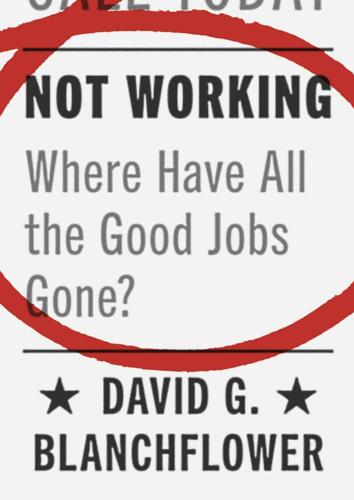
Not Working: Where Have All the Good Jobs Gone?
by
David G. Blanchflower
Published 12 Apr 2021
The problem with coal that is distinctive is that it is geographically concentrated. When coal jobs go, house prices plummet, and people can’t just move out because they can’t sell. Wales voting for Brexit is an obvious example. The same isn’t true for taxi drivers, who will potentially be replaced by driverless cars as the concentration of economic activity in small towns isn’t the same. They are not all located in a narrow Welsh valley like the Rhondda. Wakefield, once a major coal town where 10,000 Poles live, is home to various Polish beauty parlors and hairdressers, estate agents, off licenses, dentists and doctors, and a string of Polish delis.

Dawn of the Code War: America's Battle Against Russia, China, and the Rising Global Cyber Threat
by
John P. Carlin
and
Garrett M. Graff
Published 15 Oct 2018
More broadly, understanding how vulnerable our data is—and how we need to begin rethinking the procedures and protections behind our lives as they move online—will be key to securing cyberspace in the future. This is especially true as we shift more of our mechanical lives into the cloud—with driverless cars, medical devices, and home appliances moving online. The threat is quickly increasing. According to the Identity Theft Resource Center, an average of three major data breaches—of a US company or a government agency—occurred each day in 2016, a 40 percent increase over the year before. In the summer of 2015, the US government hosted a 90-day “cyber sprint” to push agencies and departments to boost their security profile.
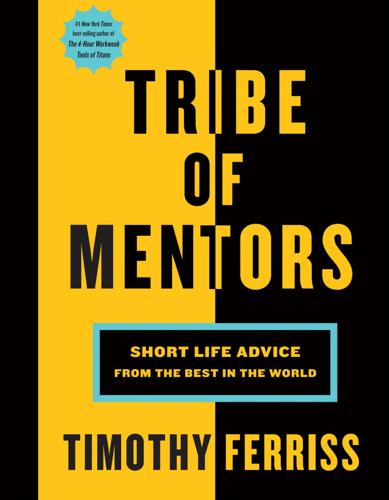
Tribe of Mentors: Short Life Advice From the Best in the World
by
Timothy Ferriss
Published 14 Jun 2017
Hats off to them. But that worked for Uber because the laws were set locally, not nationally. That won’t be the case for most innovations in sectors like health care; if you launch a drug or medical device without getting approval, you’ll be stopped in your tracks. That will be the case with driverless cars on the roads and drones in the sky. It will be true with Smart Cities innovations. The list goes on. The bottom line is—like it or not—innovators in the Third Wave need to engage with policymakers to drive real innovation. In summary, the playbook that worked in the Second Wave, when the focus was on building software and services and driving viral adoption, generally won’t work in the Third Wave, as the Internet starts impacting some of the most fundamental aspects of our lives.

Valley of Genius: The Uncensored History of Silicon Valley (As Told by the Hackers, Founders, and Freaks Who Made It Boom)
by
Adam Fisher
Published 9 Jul 2018
He wanted to make Google-branded condoms that we would give out to high schools. There were a lot of ideas that were floated and most of them never became full-fledged projects. But if Larry and Sergey suggested something you pretty much had to take it at face value for a while. Marissa Mayer: Some things we actually did go out and build—like driverless cars. We brainstormed that. Biz Stone: It was just strange, it was really weird, but it was awesome, too. Ev Williams: So I was not happy at Google, which today I totally blame myself for. It was eight hundred people when I got there. I considered it a big company, but it was not a big company. It had just grown really fast and everything was broken and immature and chaotic, and I let myself think that was wrong when, in fact, it was exactly as it should have been.

This Is How They Tell Me the World Ends: The Cyberweapons Arms Race
by
Nicole Perlroth
Published 9 Feb 2021
Louis suburbs, where he parked himself day and night in front of multiple computer monitors beside his pet hedgehog, Hacker. You had to watch your step to avoid the mangled car parts strewn over the floor. At the time Charlie was working for Uber, doing security on what the company hoped would one day be its driverless car. But he spent most of his free time these days trying to one-up his latest Jeep hack. When I landed in St. Louis and picked up my rental car, his exploit was still fresh in my mind. “Do not, under any circumstance, give me a Jeep,” I told the Budget salesman. When I recounted this to Charlie, he asked where I was staying.

The Innovators: How a Group of Inventors, Hackers, Geniuses and Geeks Created the Digital Revolution
by
Walter Isaacson
Published 6 Oct 2014
It encouraged students to have a “healthy disregard for the impossible.” The institute inculcated in him a desire, which he would indulge at Google, to launch projects that others considered to be on the borderline between audacious and insane. In particular, both at Michigan and later, he pushed futuristic ideas for personal transportation systems and driverless cars.122 When it came time to go to graduate school, Page was rejected by MIT but accepted by Stanford. That was fortuitous; for someone interested in the intersection of technology and business, Stanford was the place to be. Ever since the Stanford grad Cyril Elwell had founded Federal Telegraph in 1909, tech entrepreneurship was not merely tolerated but expected there, an attitude that was reinforced when the engineering dean Fred Terman built an industrial park on university land in the early 1950s.
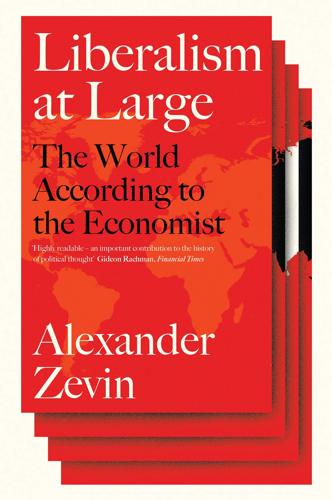
Liberalism at Large: The World According to the Economist
by
Alex Zevin
Published 12 Nov 2019
‘Mind-stretching journalism’ was the order of the day, built on life-cycle issues and served up with lashings of new technology. The Economist peered into the future of autism, clones, drones, longevity, millennials, assisted suicide, viral resistance, microchips, robots, artificial intelligence, driverless cars, gene editing and quantum mechanics. ‘We don’t want to be the grandpa at the disco’, she told the Guardian in 2016, which pointed to the eight social media staffers she had hired, as well as the Twitter-storm of articles designed to convert millions of social media followers into paying subscribers, and with more resources devoted to Economist Radio, TV and now Film.141 Months after her elevation, the Economist itself changed hands, when Pearson decided to sell its 50 per cent stake in the company shortly after it offloaded the Financial Times in a deal with Japan’s financial news giant Nikkei.

Empire of Pain: The Secret History of the Sackler Dynasty
by
Patrick Radden Keefe
Published 12 Apr 2021
The company was pleading guilty to conspiracy to defraud the United States and to violate the Food, Drug, and Cosmetic Act, as well as to two counts of conspiracy to violate the federal Anti-kickback Statute, Rosen announced. No executives would face individual charges. In fact, no individual executives were mentioned at all: it was as if the corporation had acted autonomously, like a driverless car. (In depositions related to Purdue’s bankruptcy which were held after the DOJ settlement, two former CEOs, John Stewart and Mark Timney, both declined to answer questions, invoking their Fifth Amendment right not to incriminate themselves.) Rosen touted the total value of the federal penalties against Purdue as “more than $8 billion.”
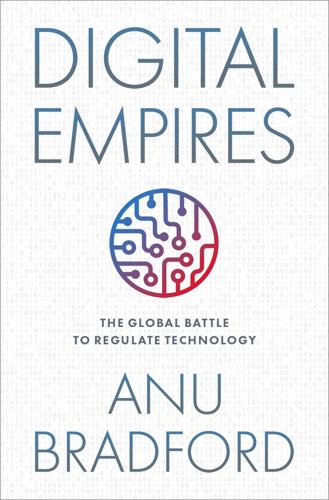
Digital Empires: The Global Battle to Regulate Technology
by
Anu Bradford
Published 25 Sep 2023
YouTube has not been accessible to Chinese internet users since 2009.13 The Chinese government has also banned several other Google products, including Gmail, Google Maps, and Google Scholar.14 Even though many of the company’s flagship products are banned in China, some less prominent Google products are available. For example, Google’s file management app and translation app can still be downloaded in China.15 In March 2021, Google’s Android was reported to be the most popular operating system among Chinese smartphone users.16 Google’s parent company Alphabet and its subsidiaries, such as Alphabet’s driverless-car company Waymo, also continue to invest in Chinese partnerships and projects.17 Google backed the Chinese e-commerce giant JD.com with a $550 million investment in the company in 2018,18 and in 2017, Google announced that it would open a new AI research center in China.19 These continuing investments suggest that Google recognizes the importance of the Chinese market yet remains limited in its ability to fully take advantage of operating in the country.

Artificial Intelligence: A Modern Approach
by
Stuart Russell
and
Peter Norvig
Published 14 Jul 2019
Frey and Osborne (2017) survey 702 different occupations, and estimate that 47% of them are at risk of being automated, meaning that at least some of the tasks in the occupation can be performed by machine. For example, almost 3% of the workforce in the U.S. are vehicle drivers, and in some districts, as much as 15% of the male workforce are drivers. As we saw in Chapter 26, the task of driving is likely to be eliminated by driverless cars/trucks/buses/taxis. It is important to distinguish between occupations and the tasks within those occupations. McKinsey estimates that only 5% of occupations are fully automatable, but that 60% of occupations can have about 30% of their tasks automated. For example, future truck drivers will spend less time holding the steering wheel and more time making sure that the goods are picked up and delivered properly; serving as customer service representatives and salespeople at either end of the journey; and perhaps managing convoys of, say, three robotic trucks.